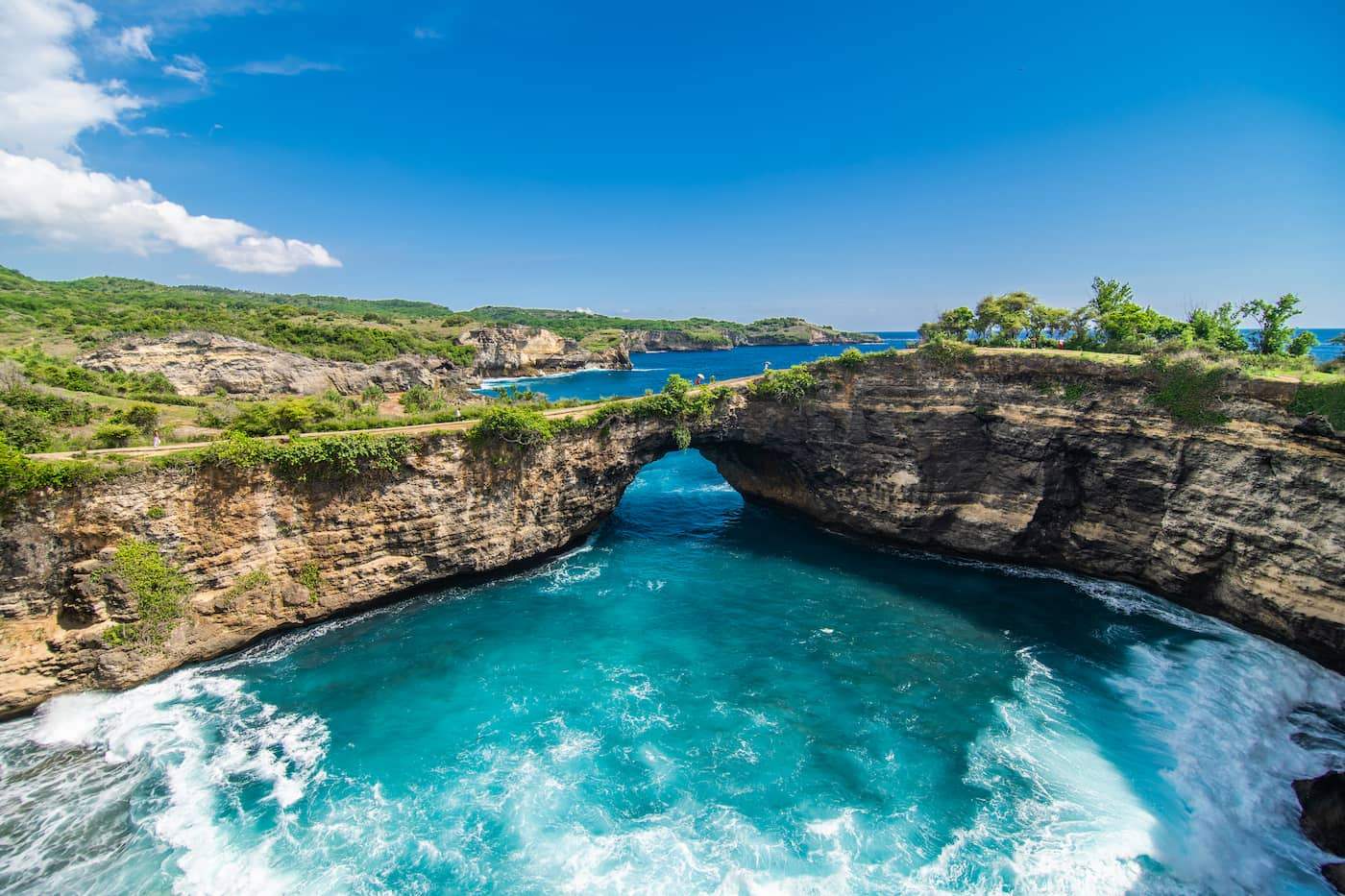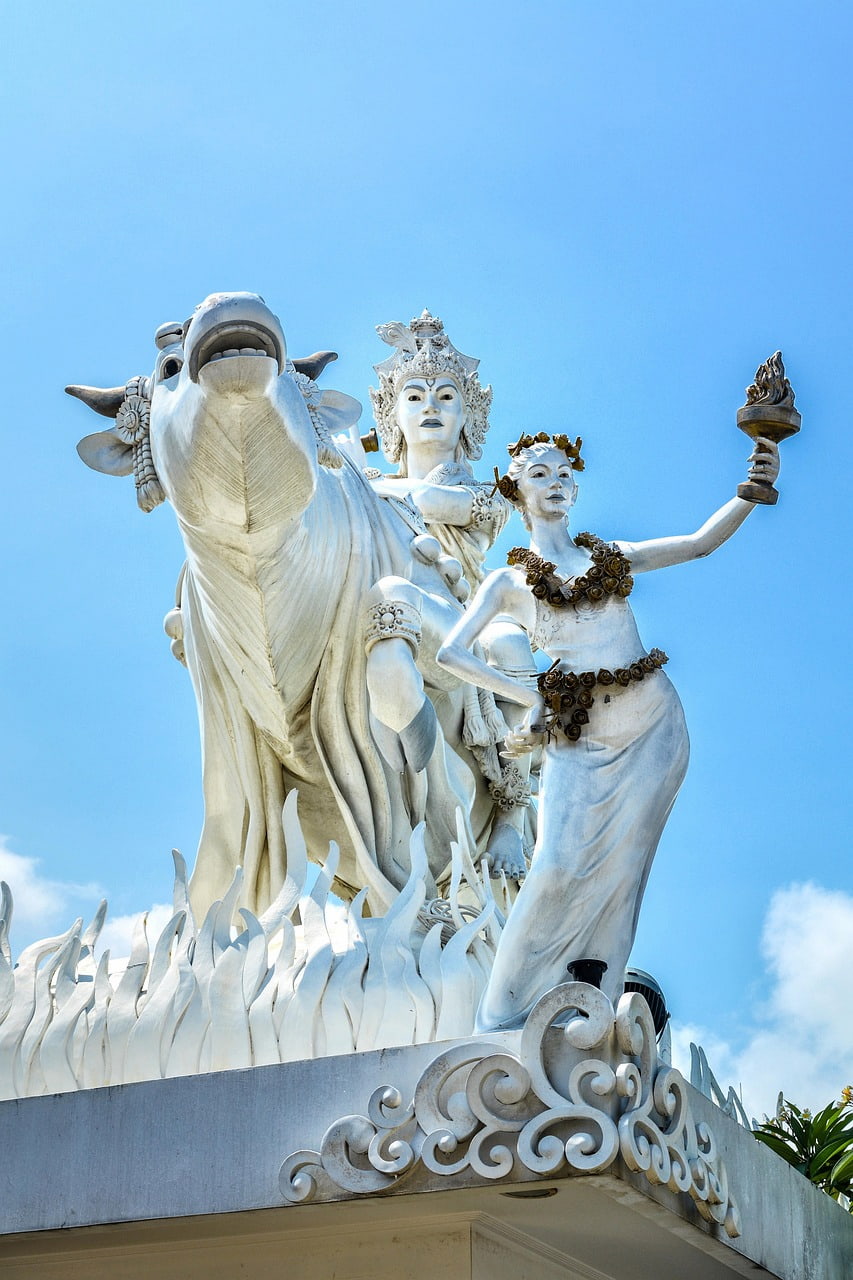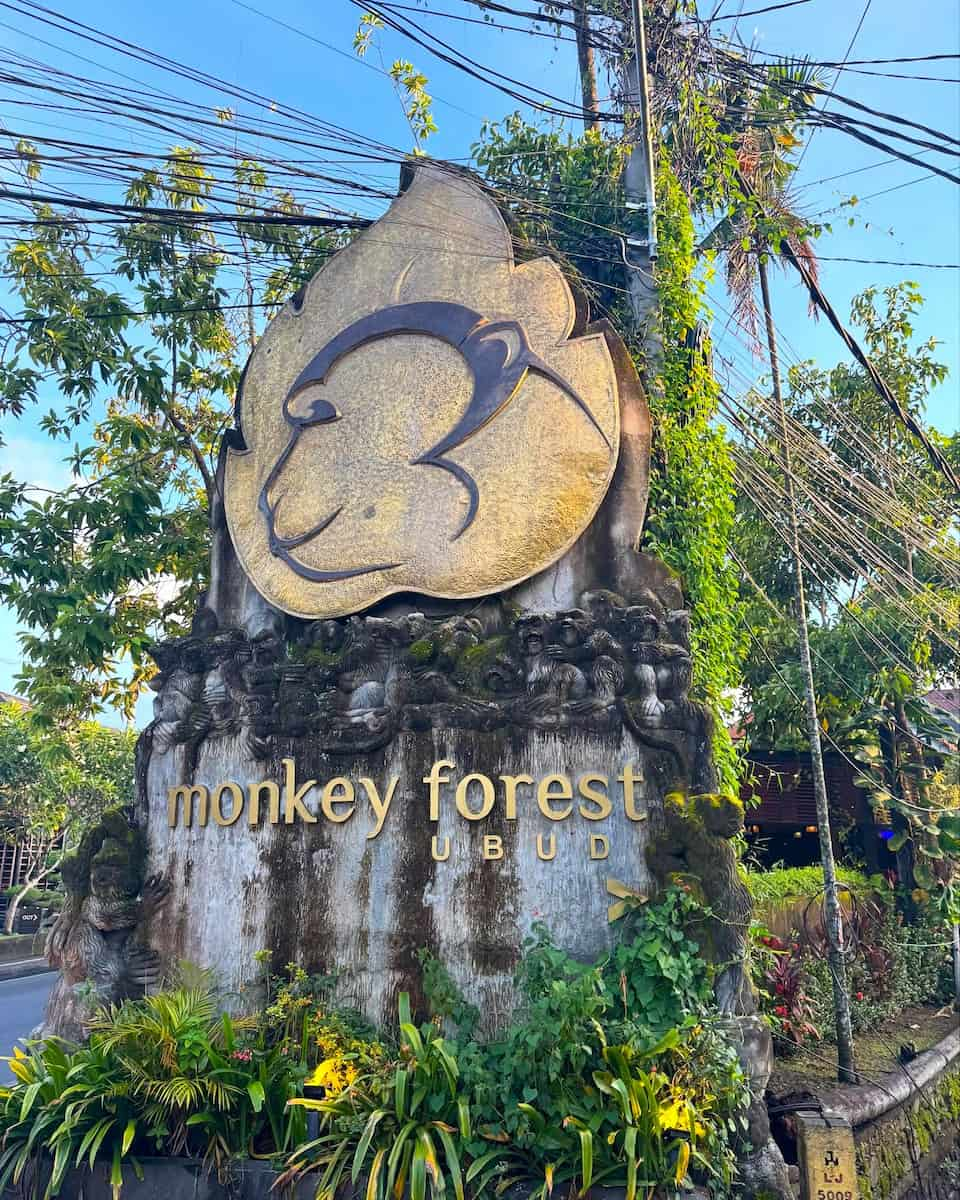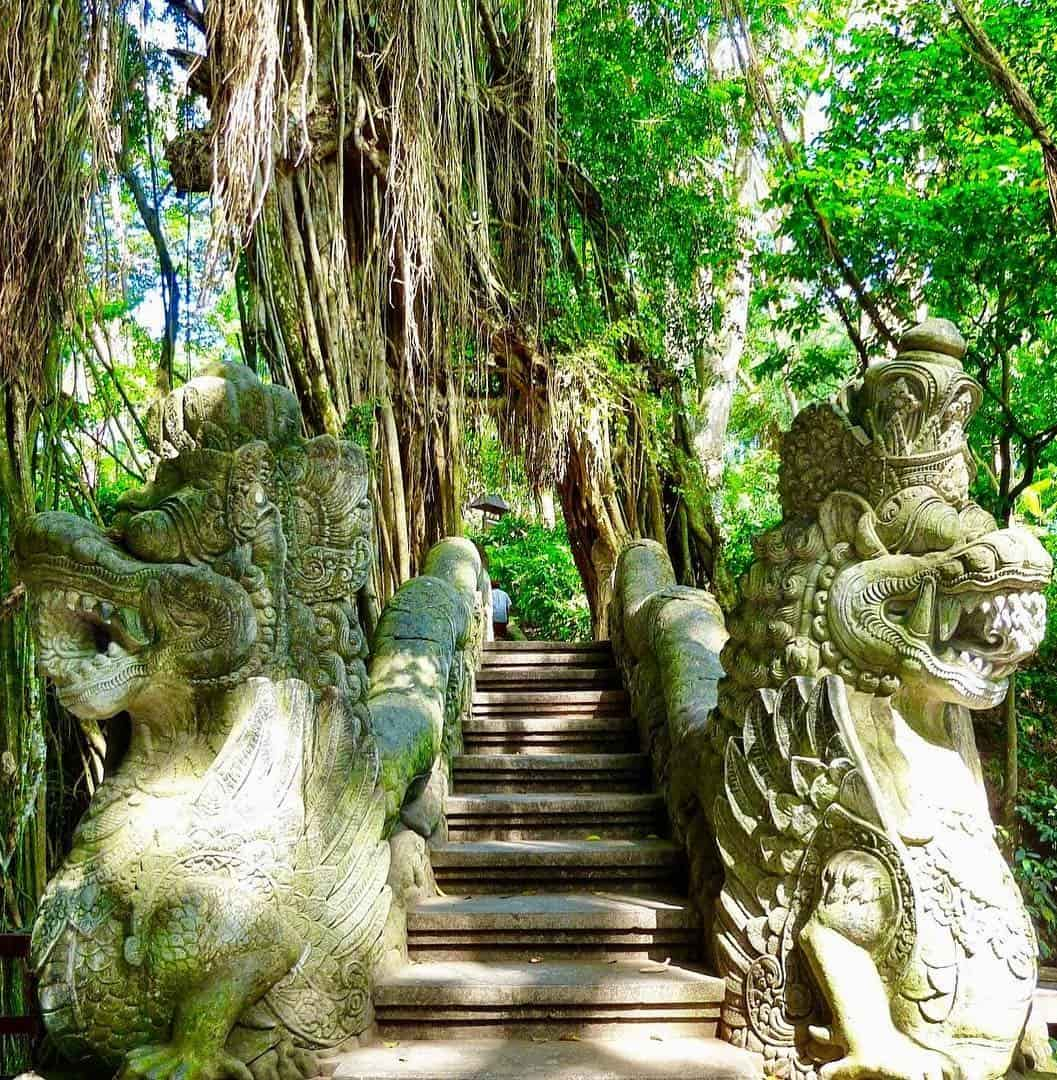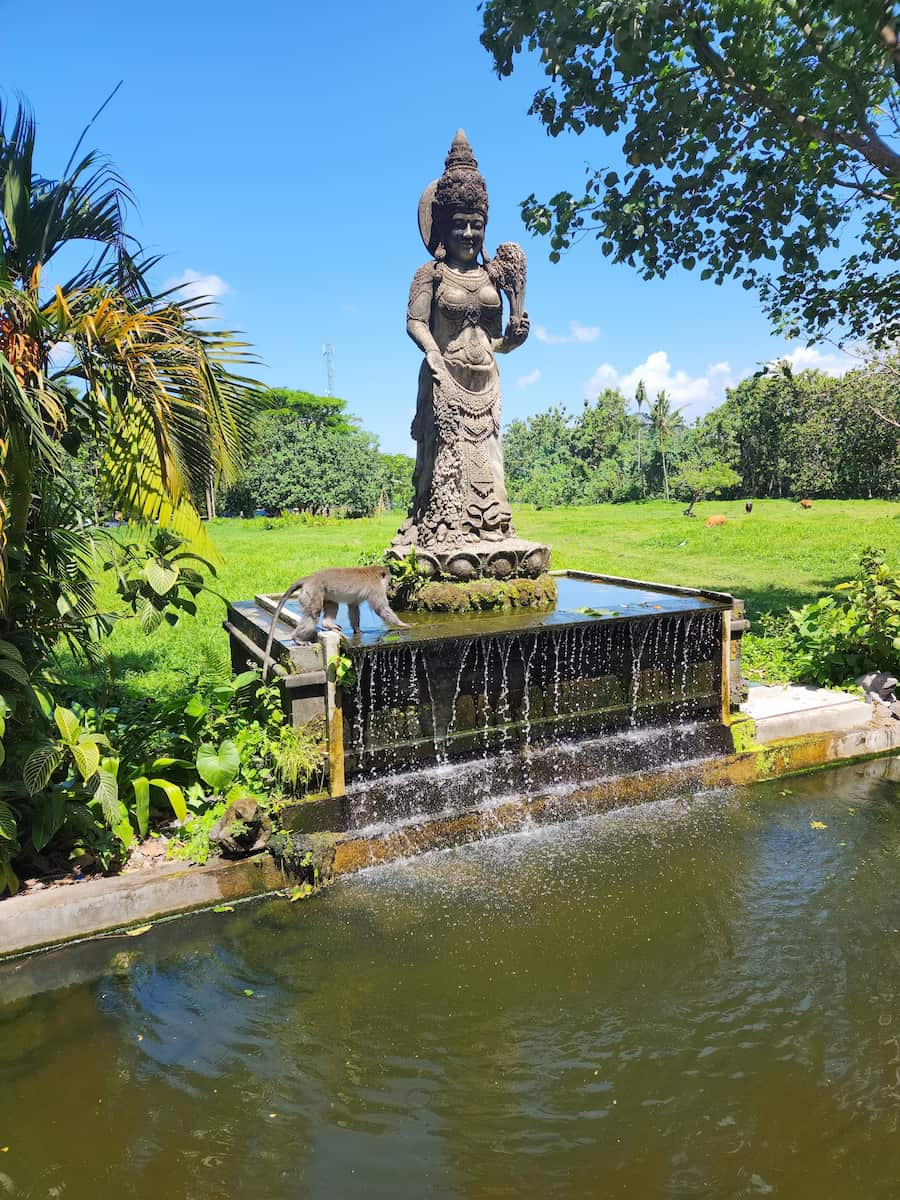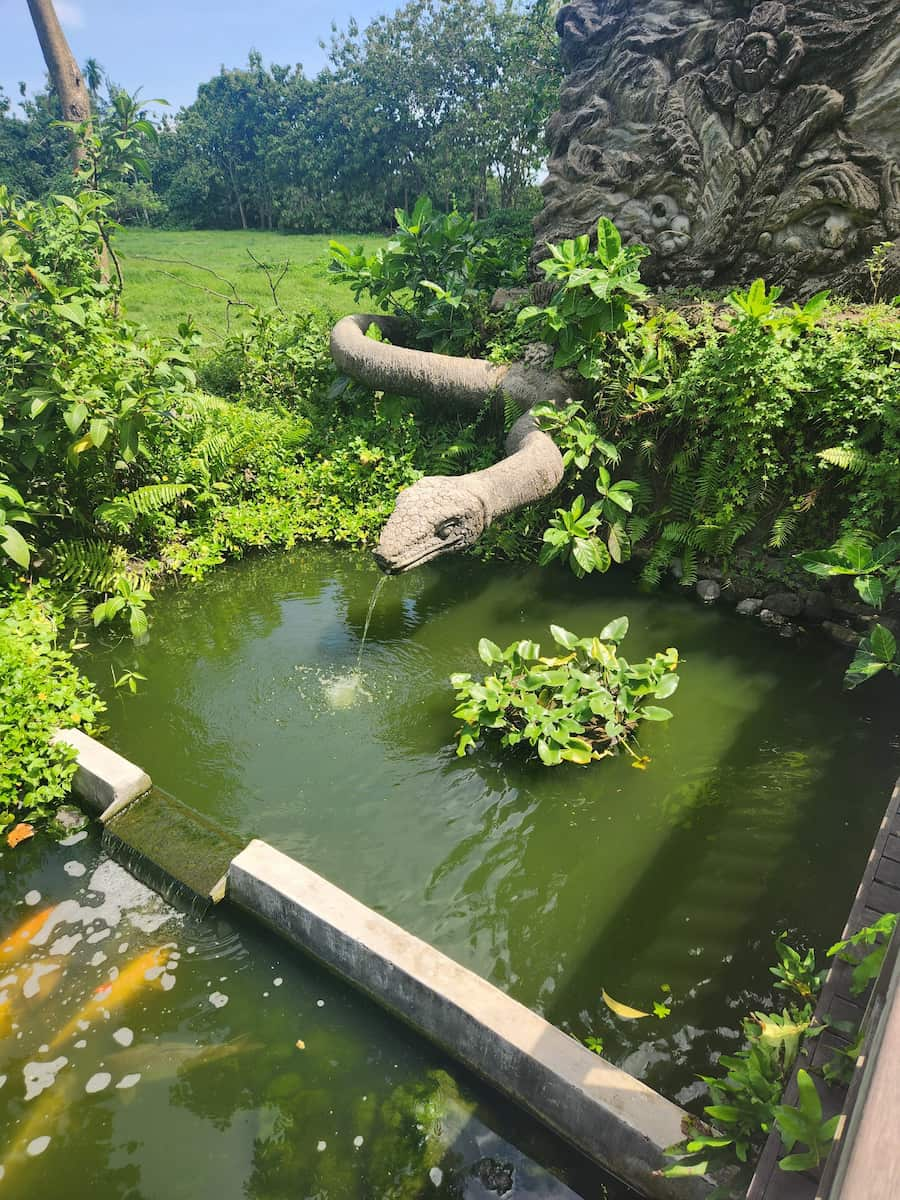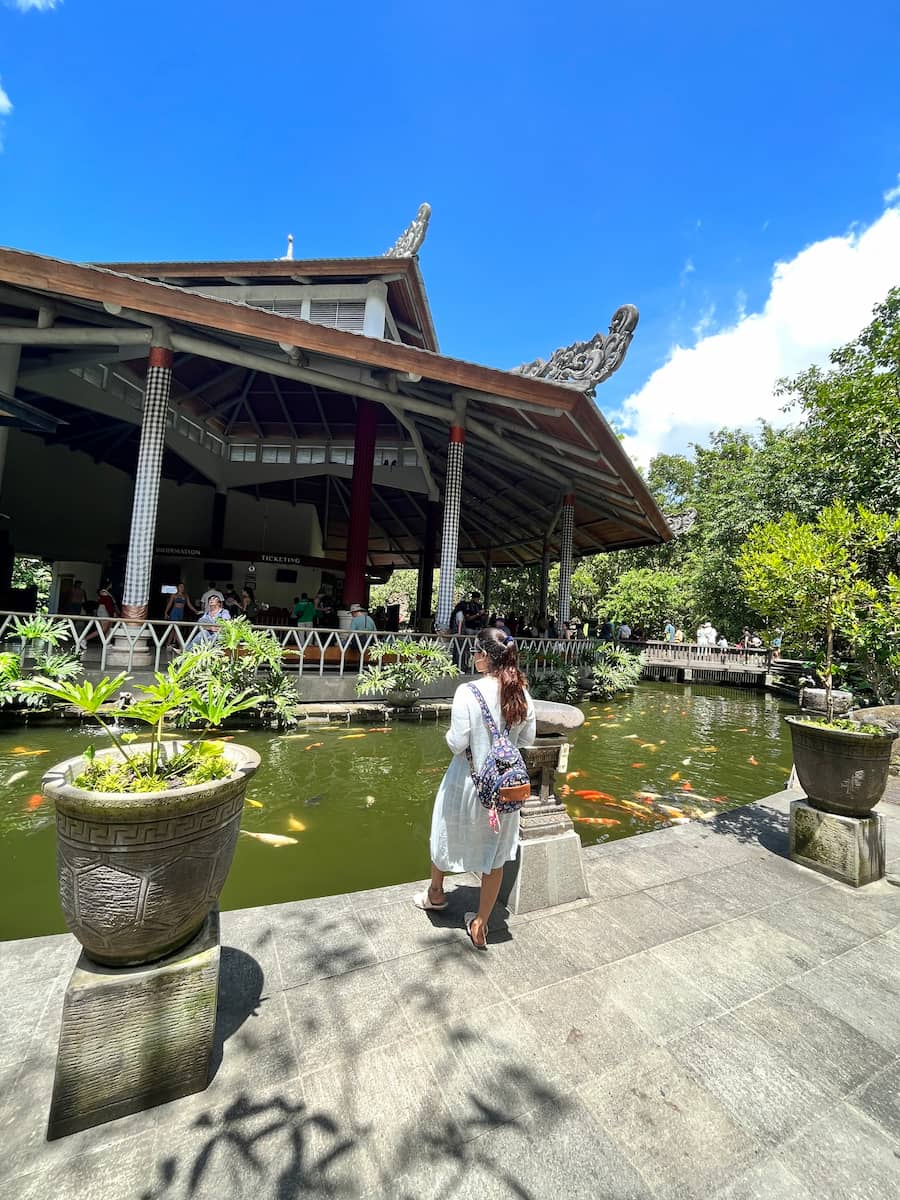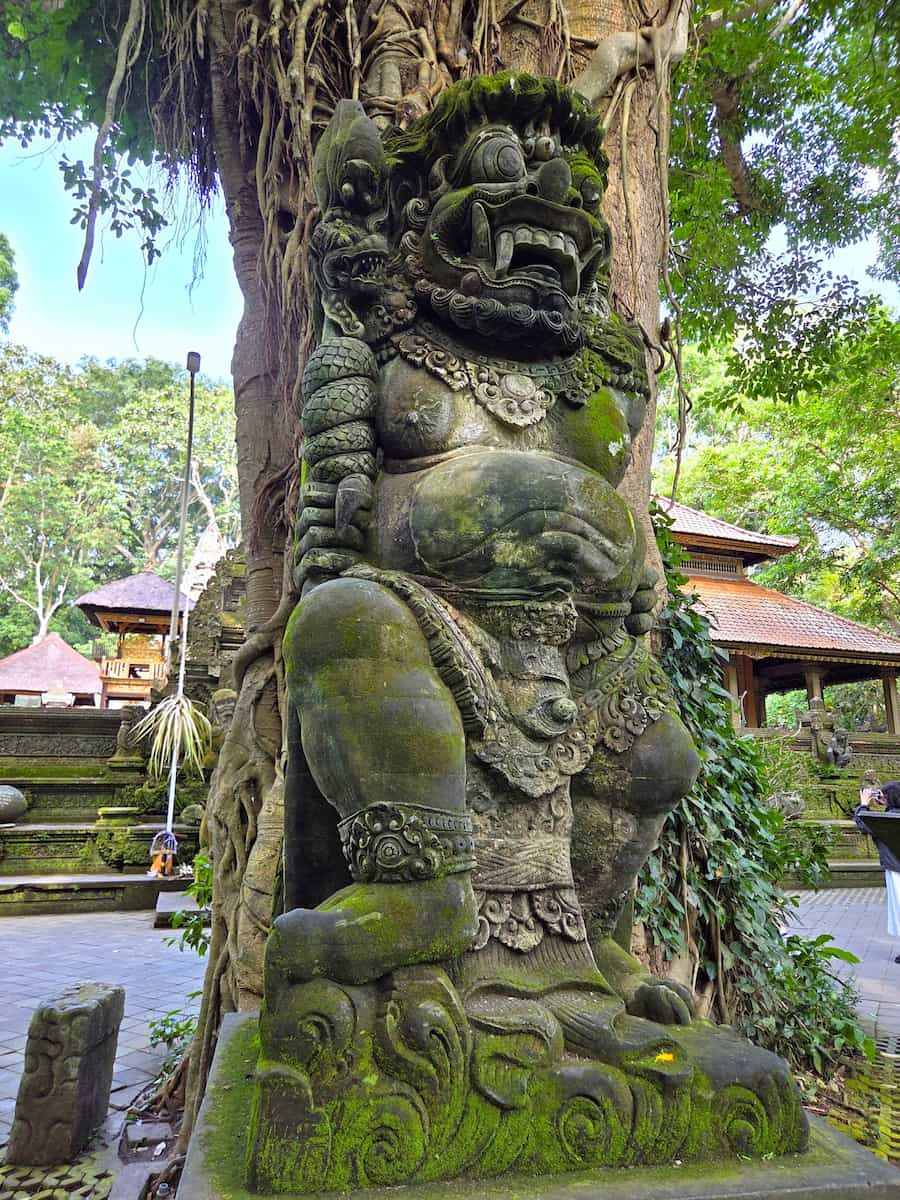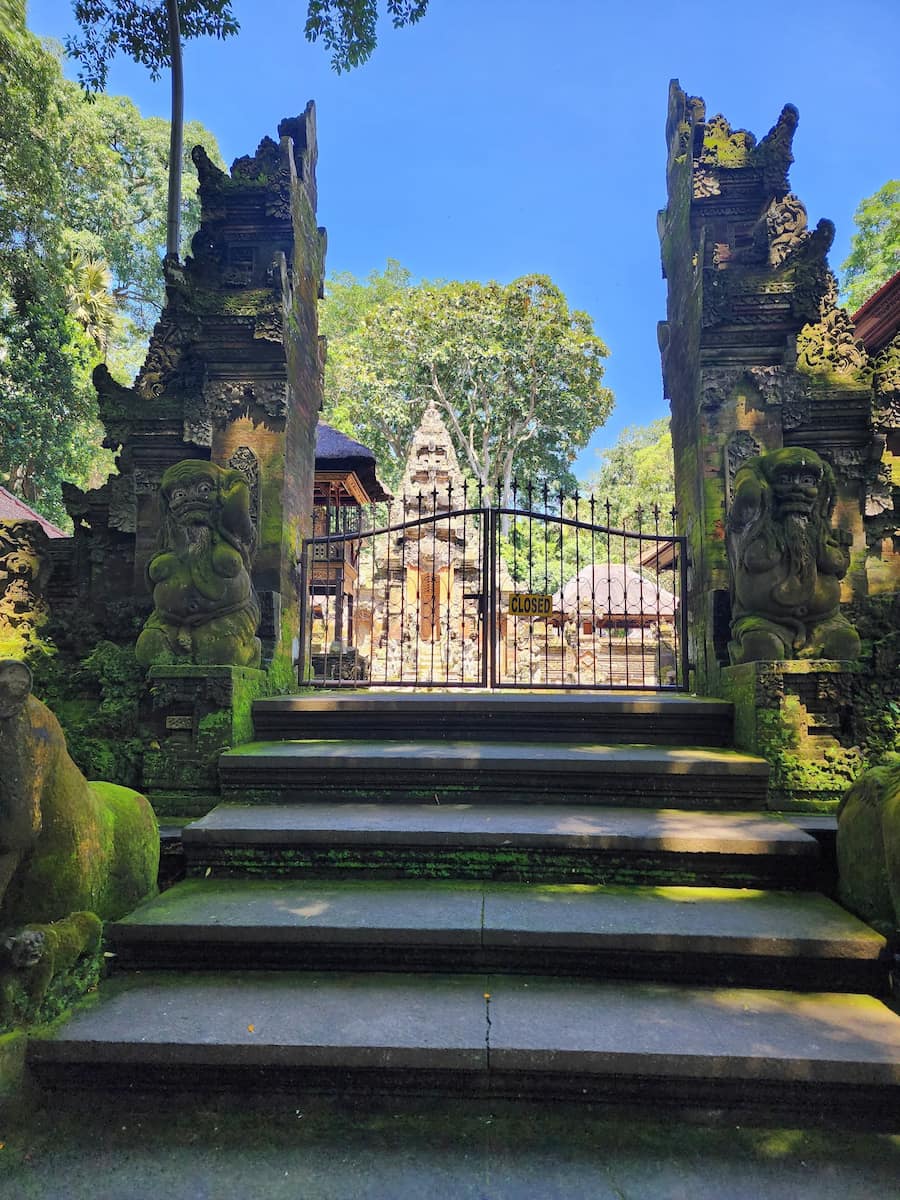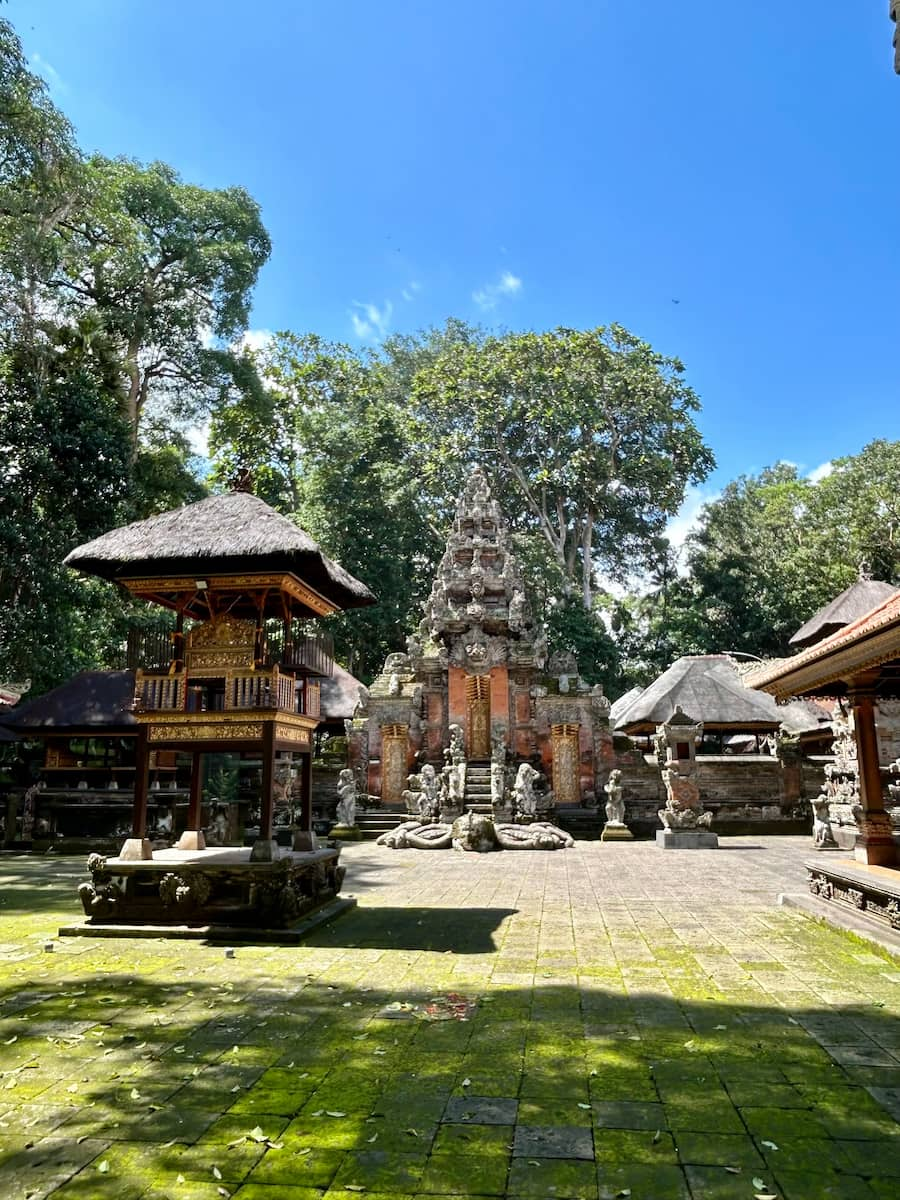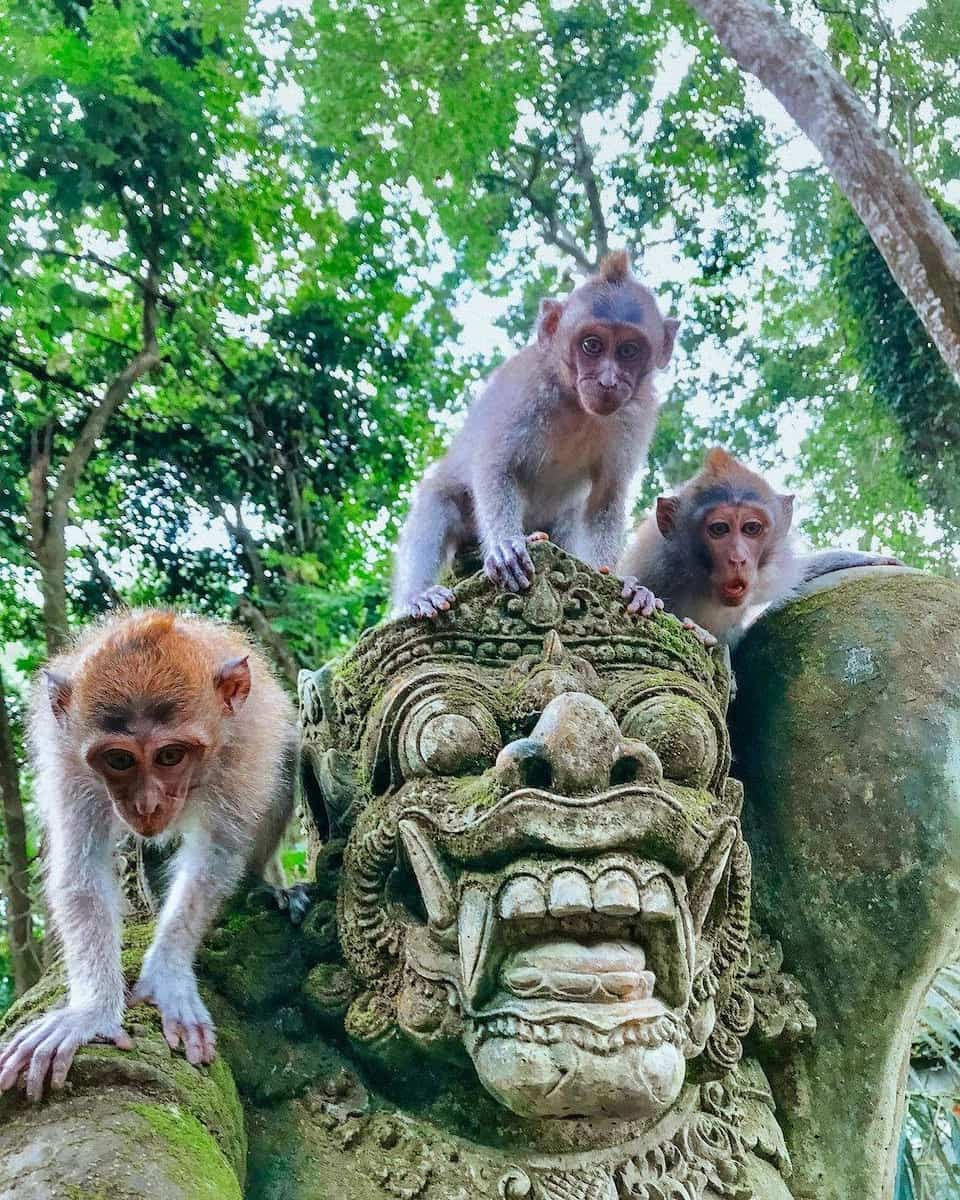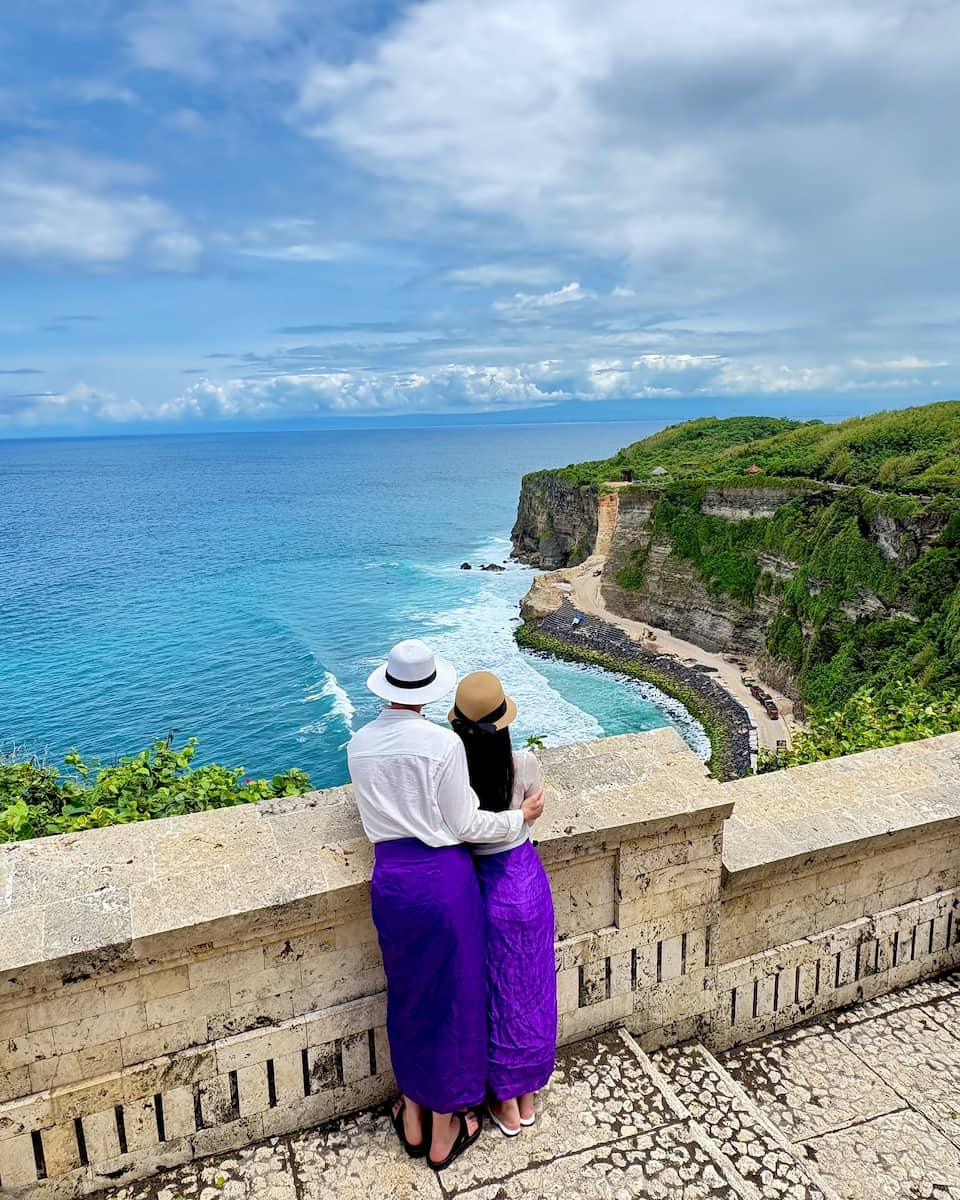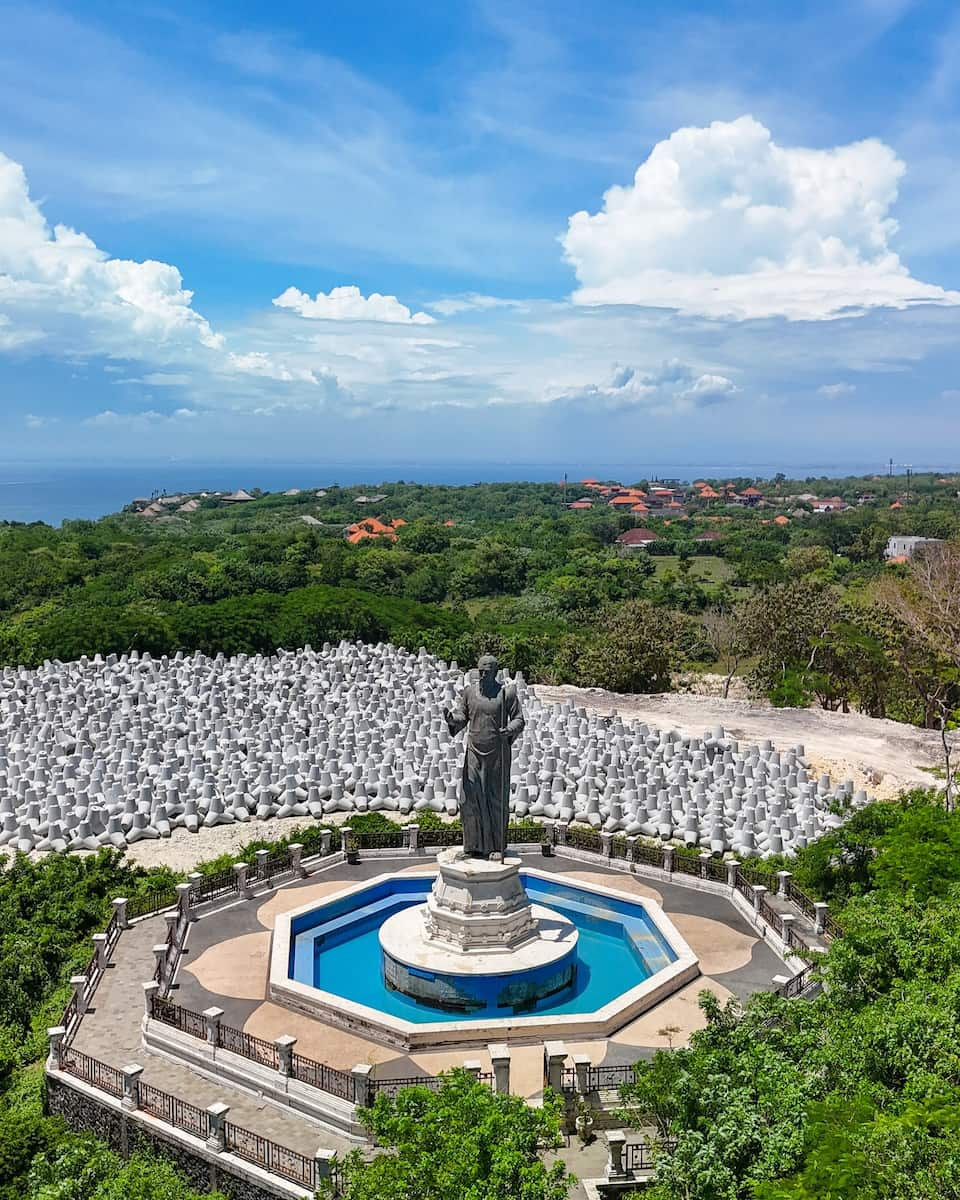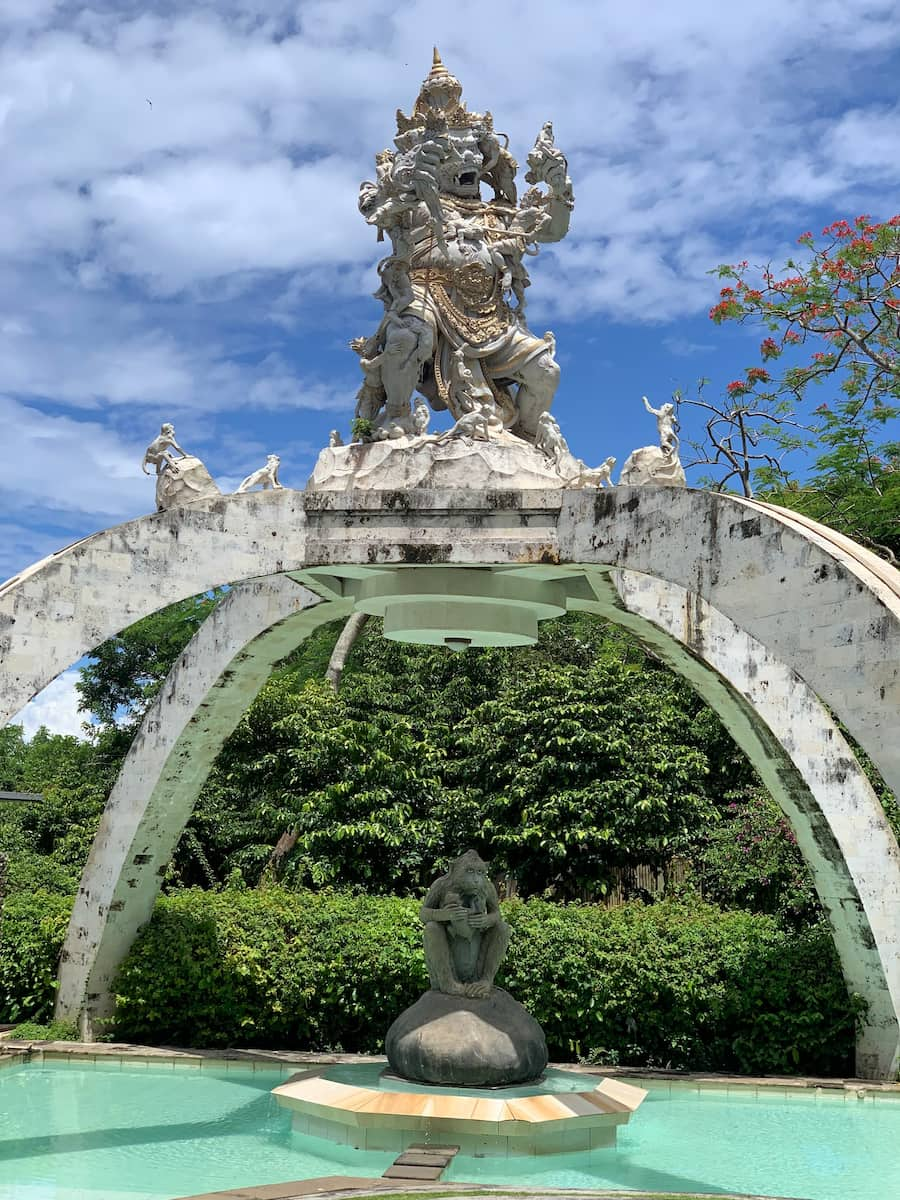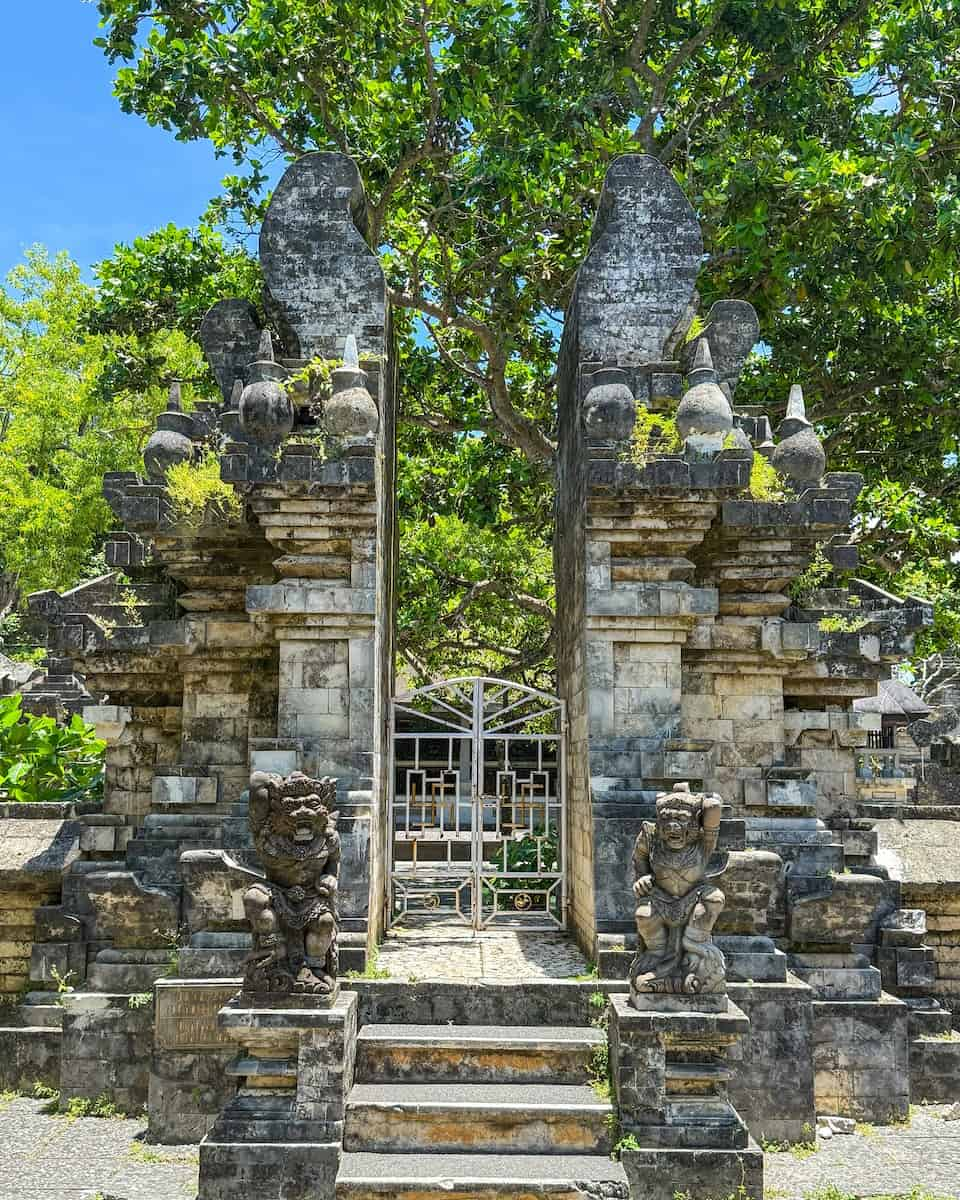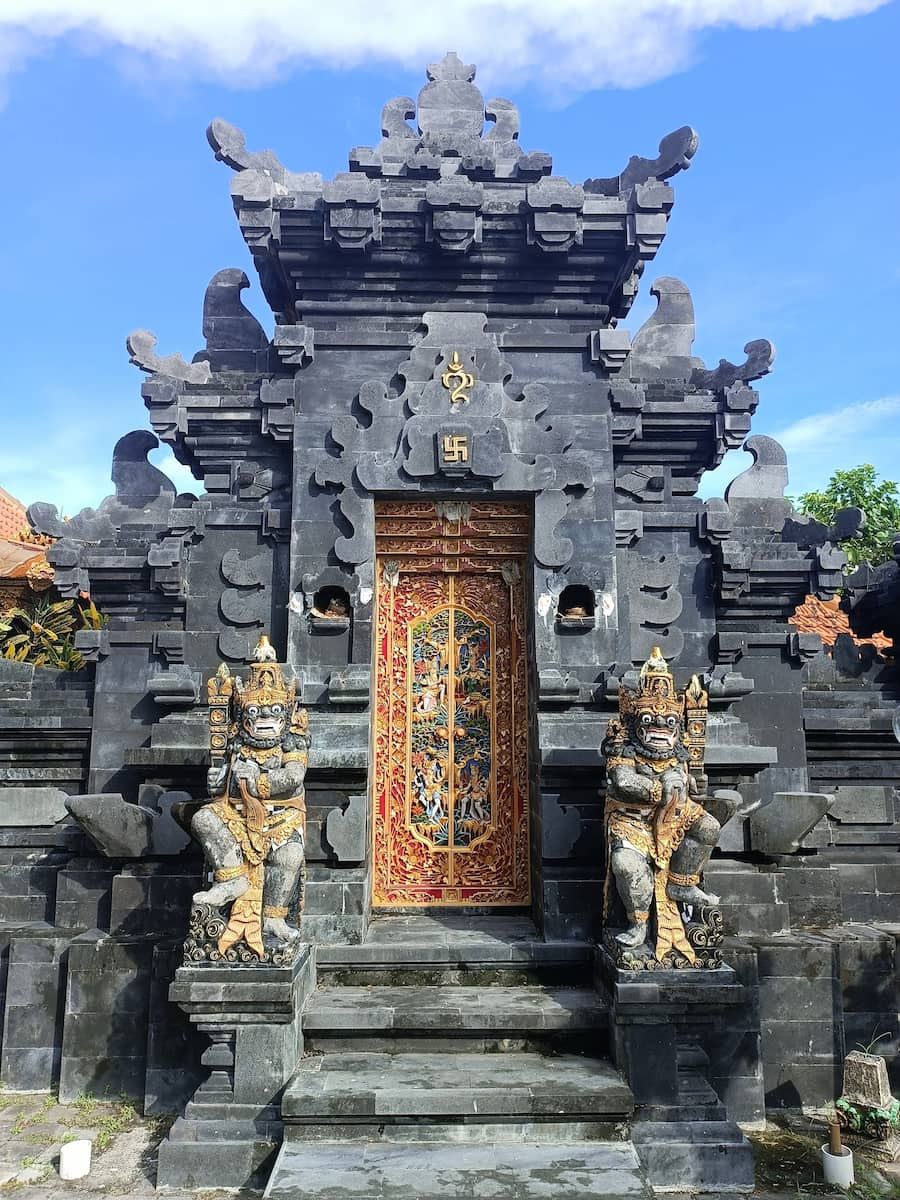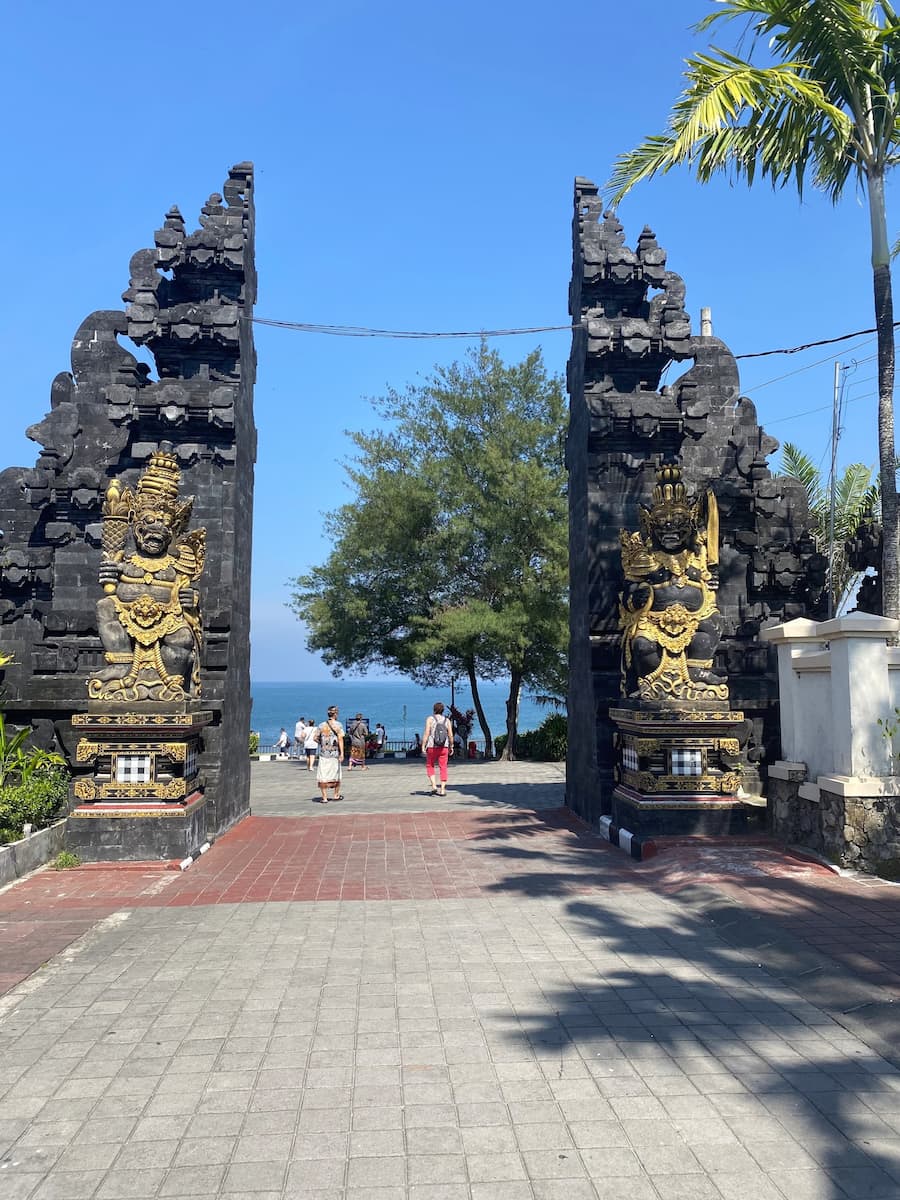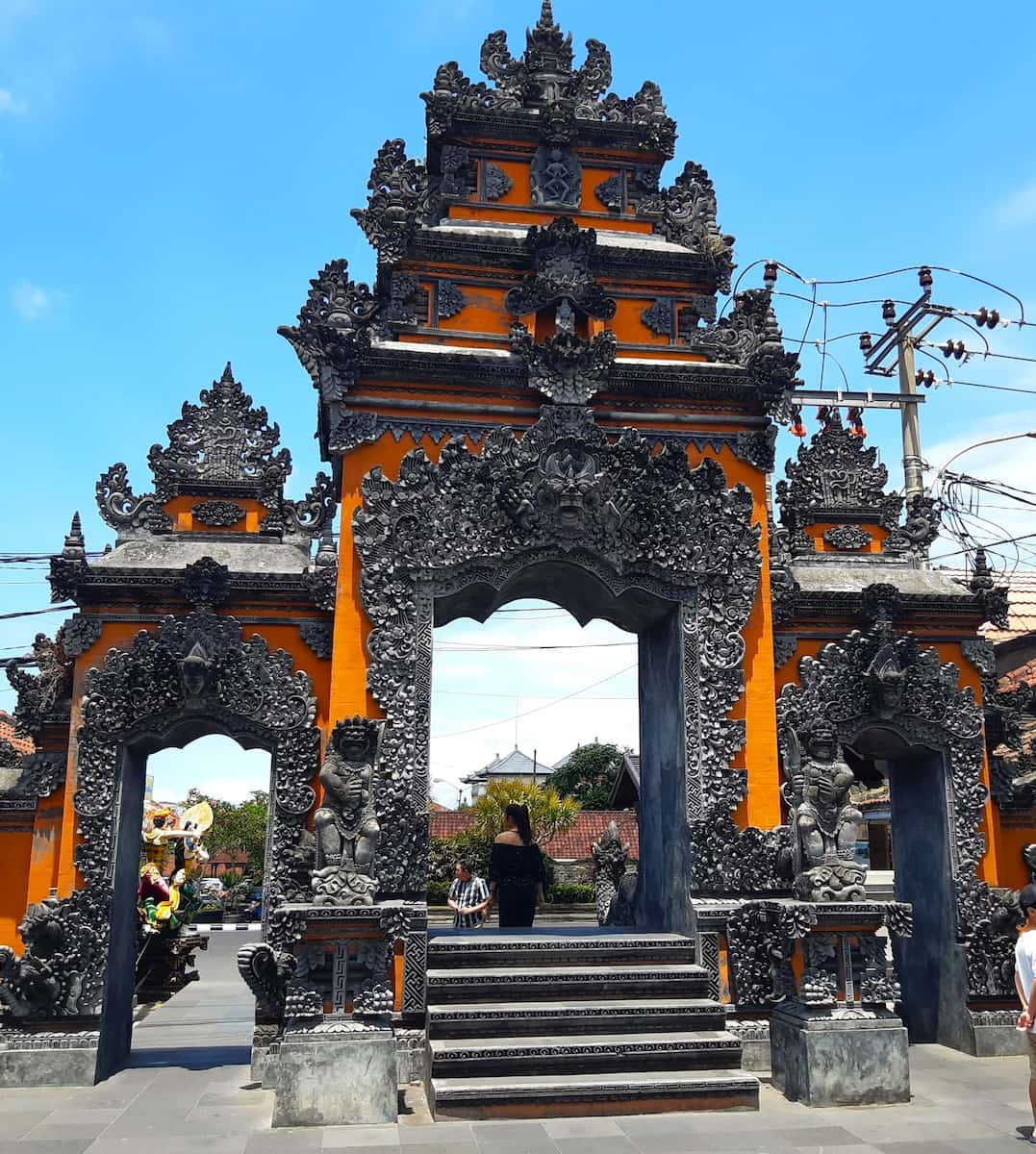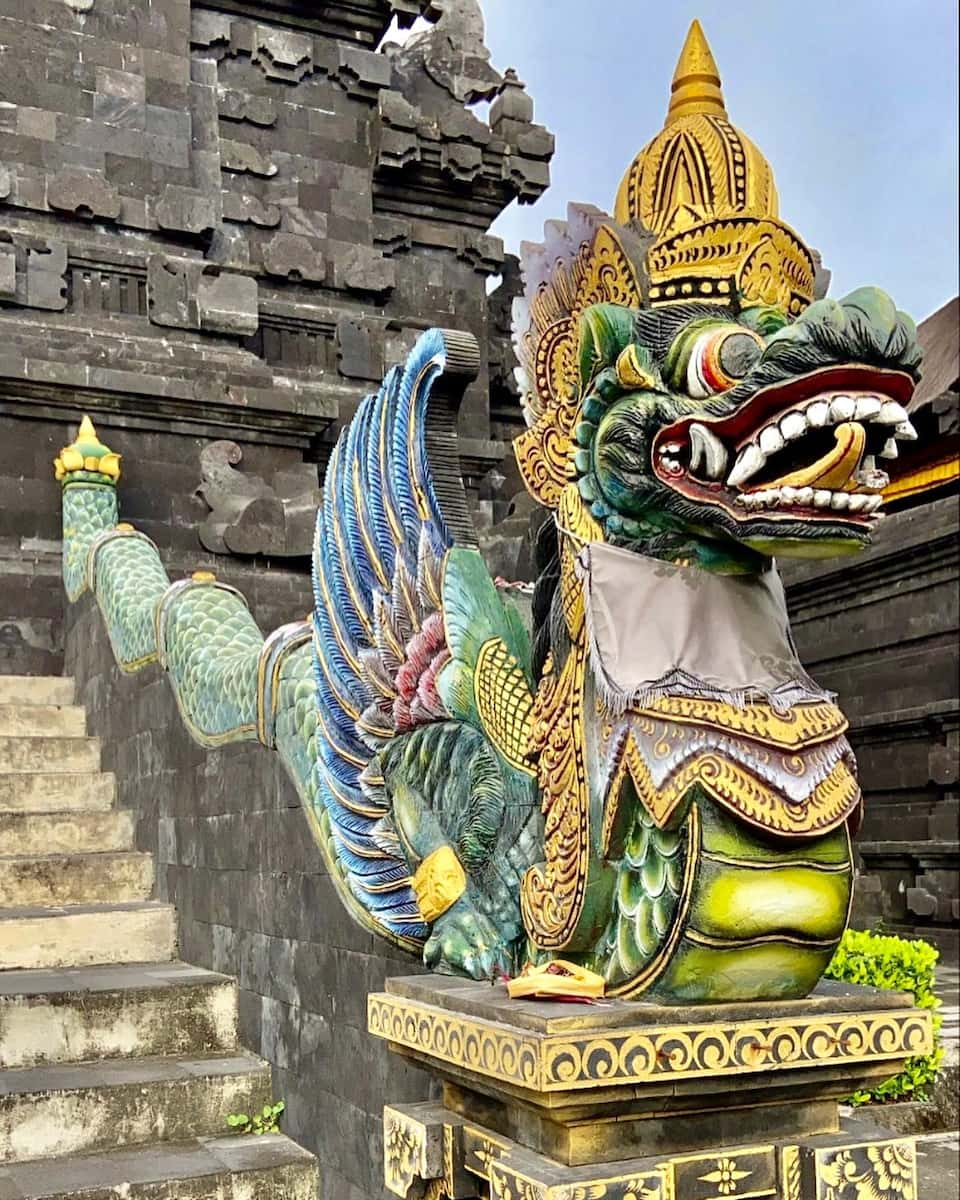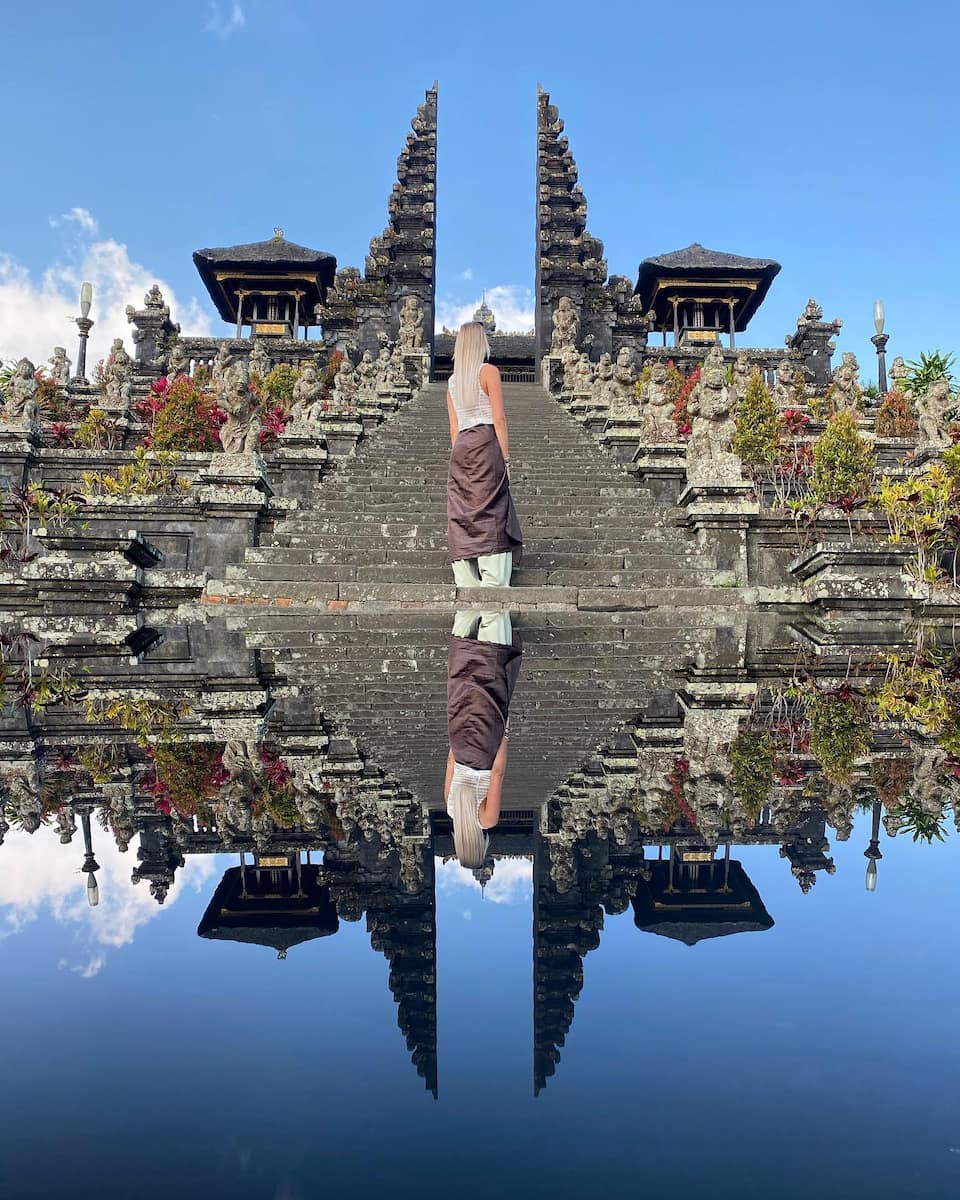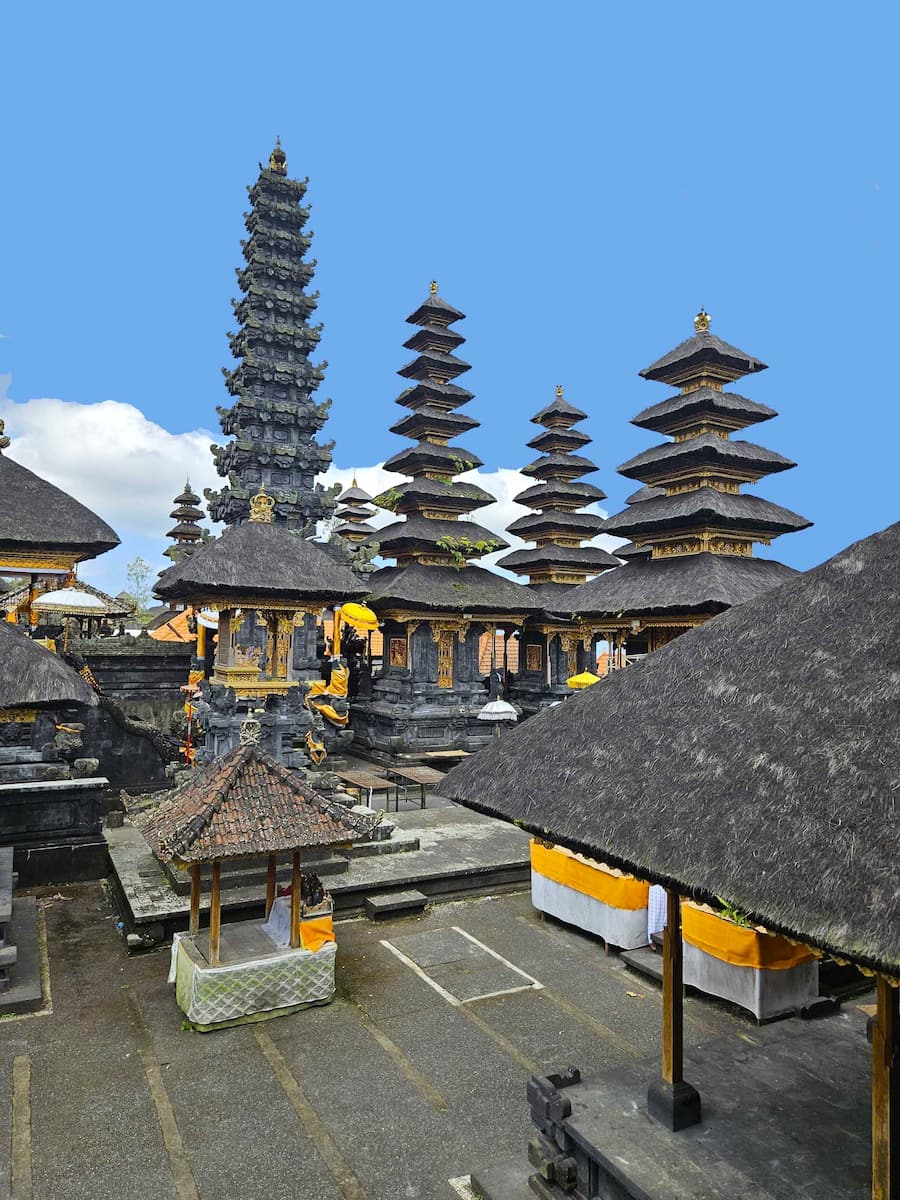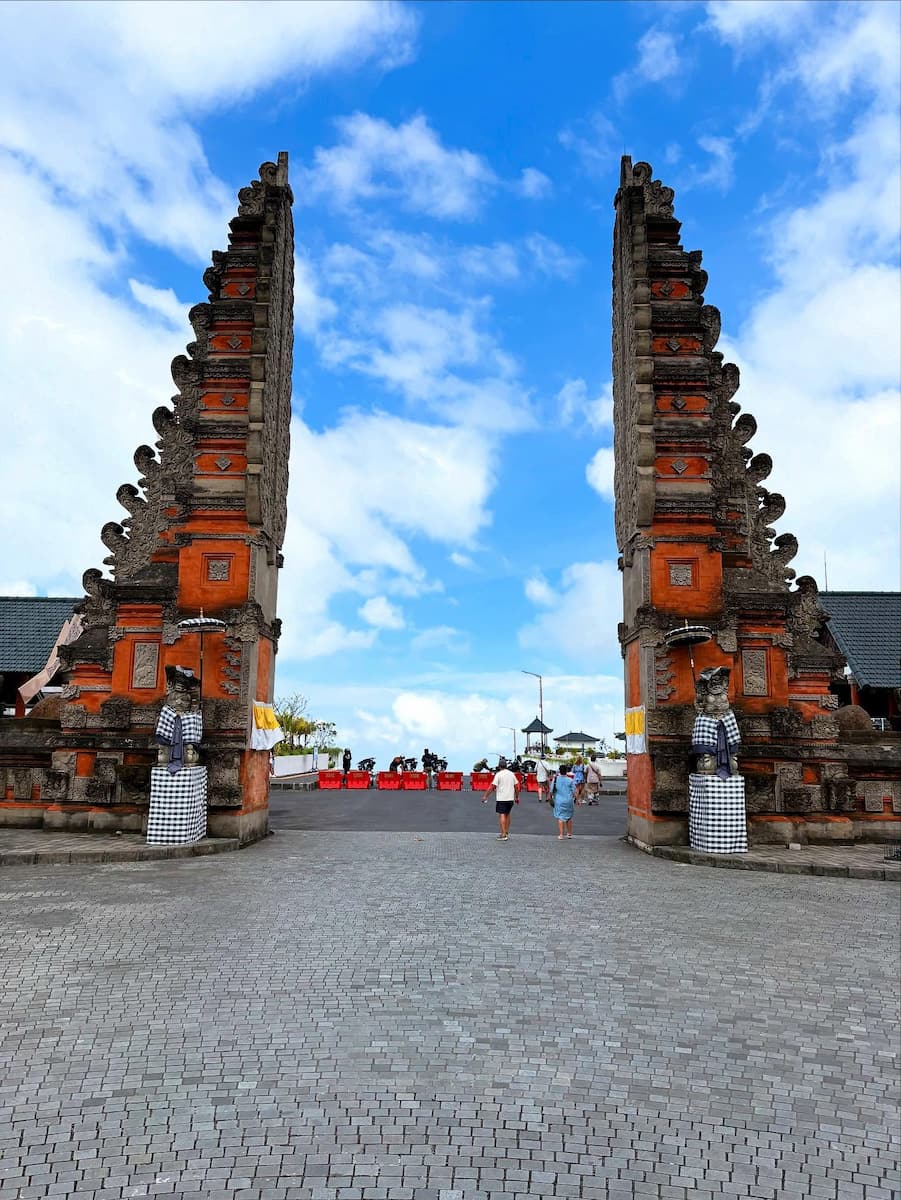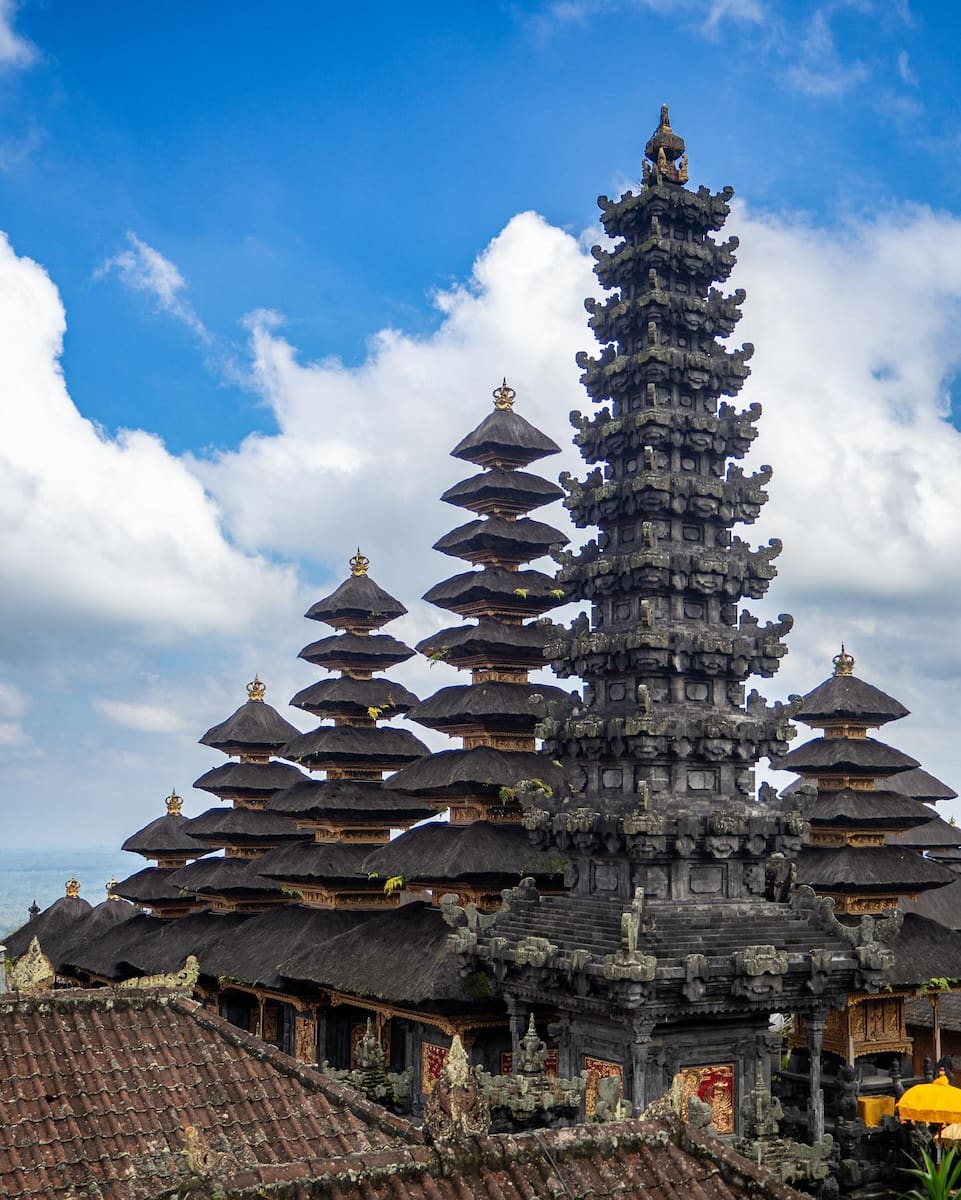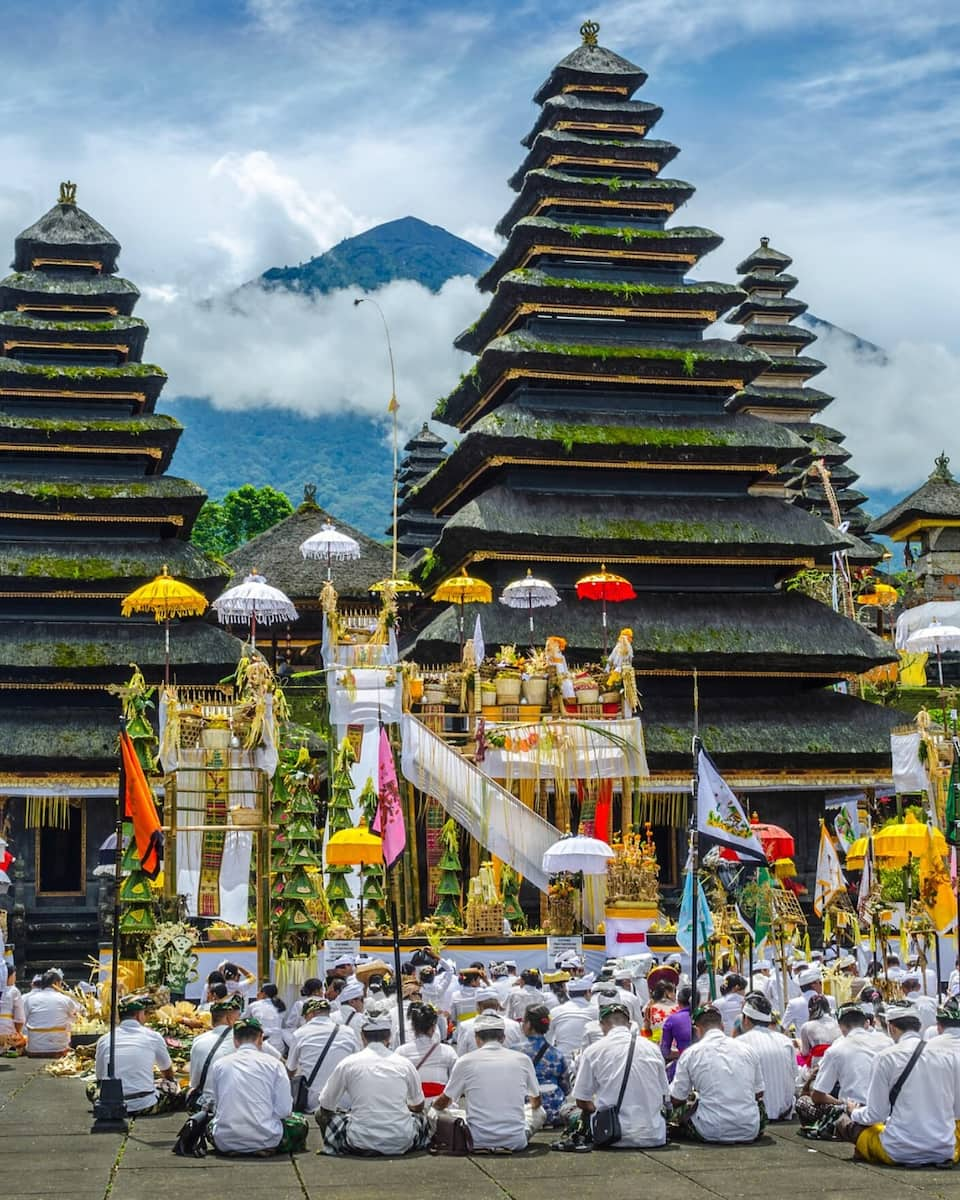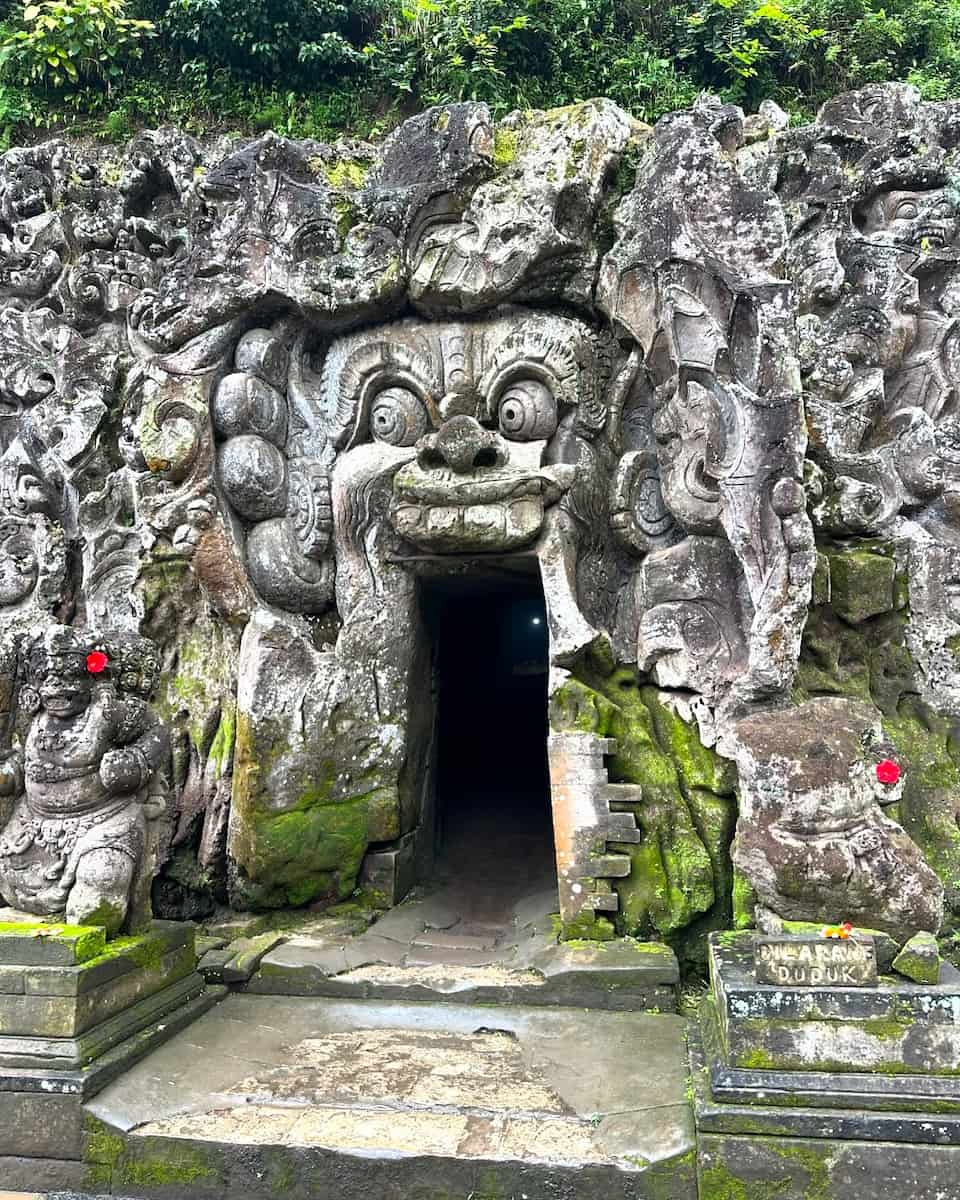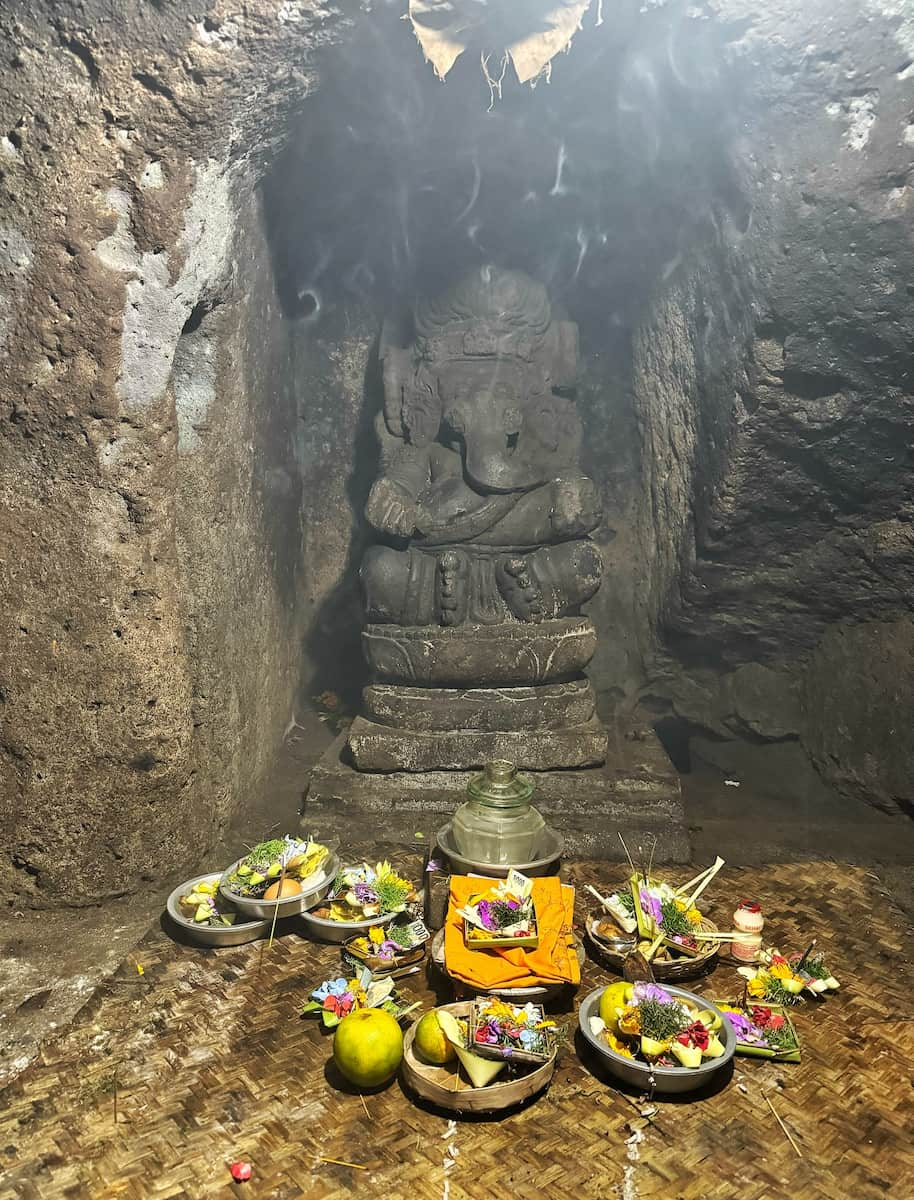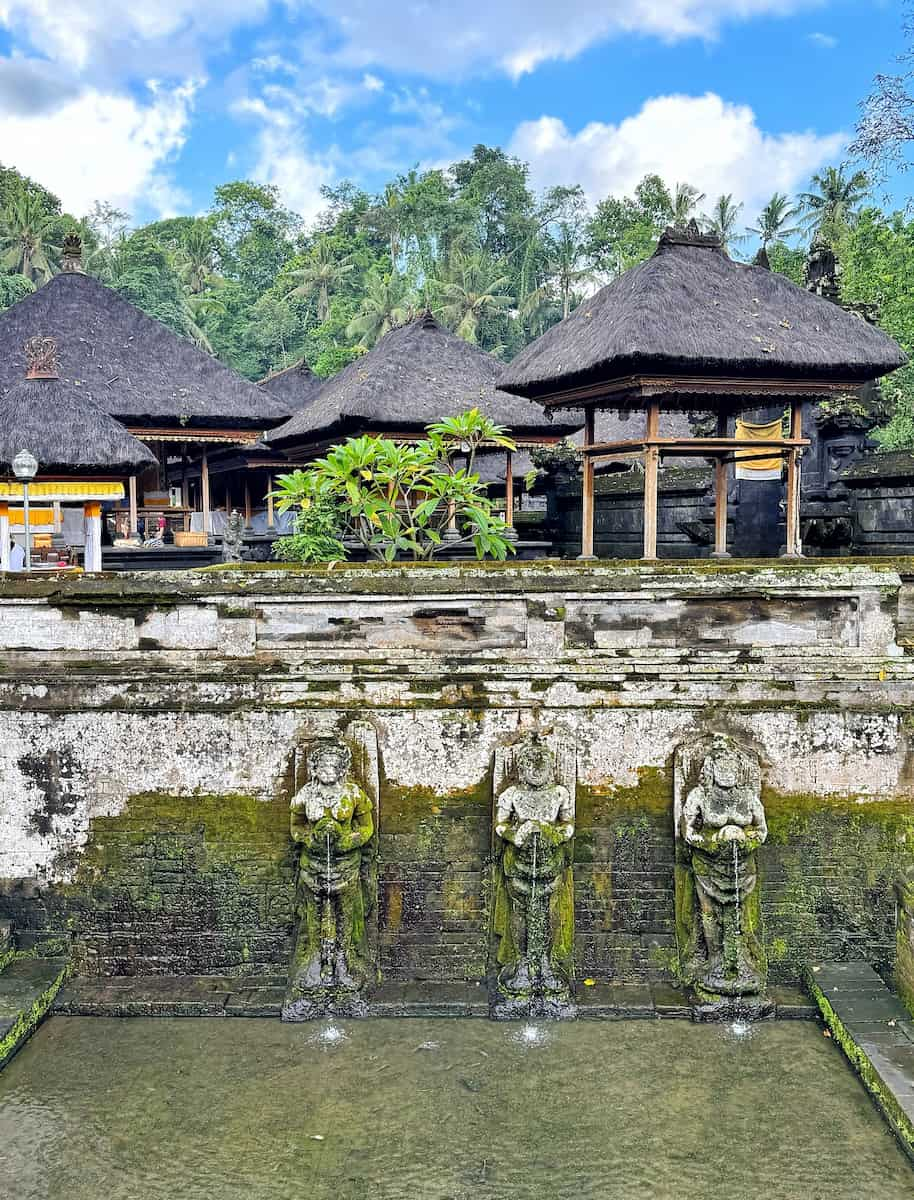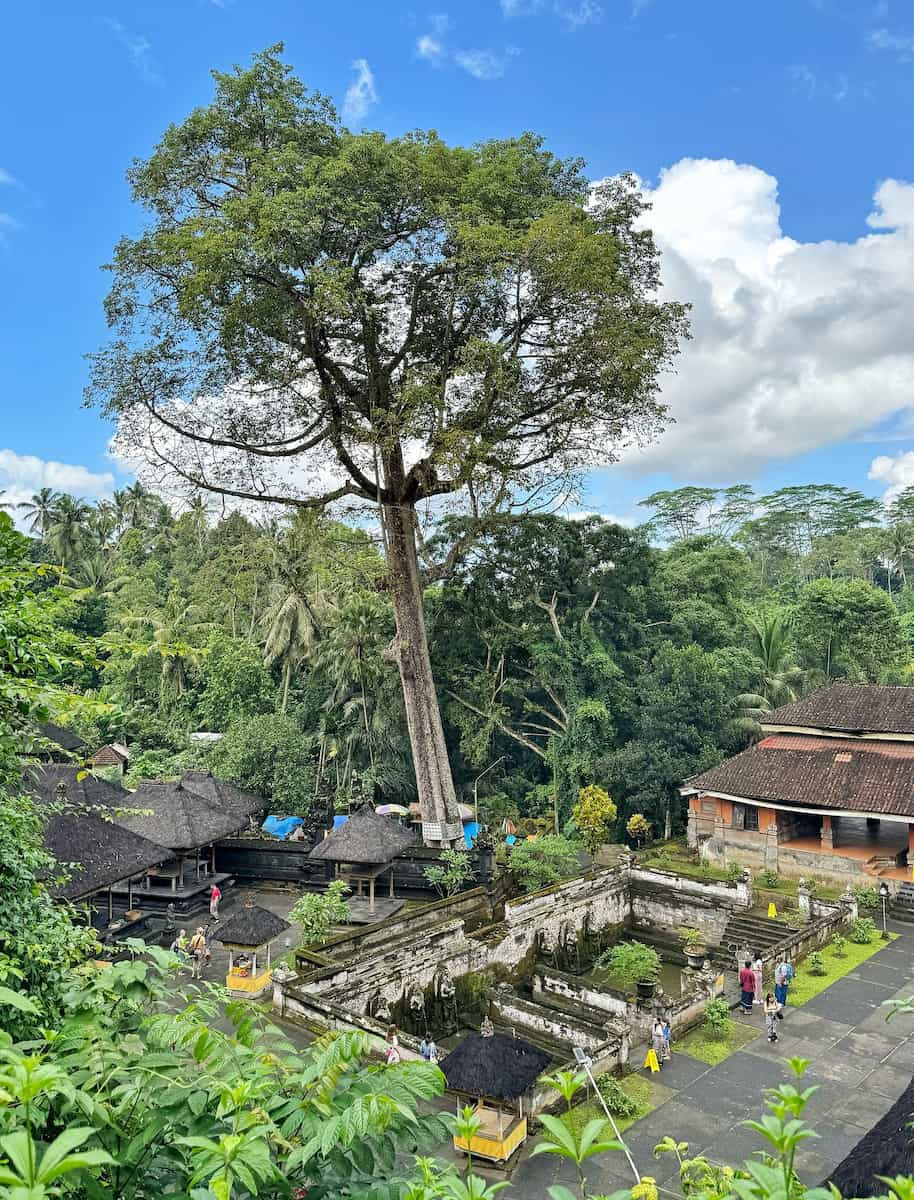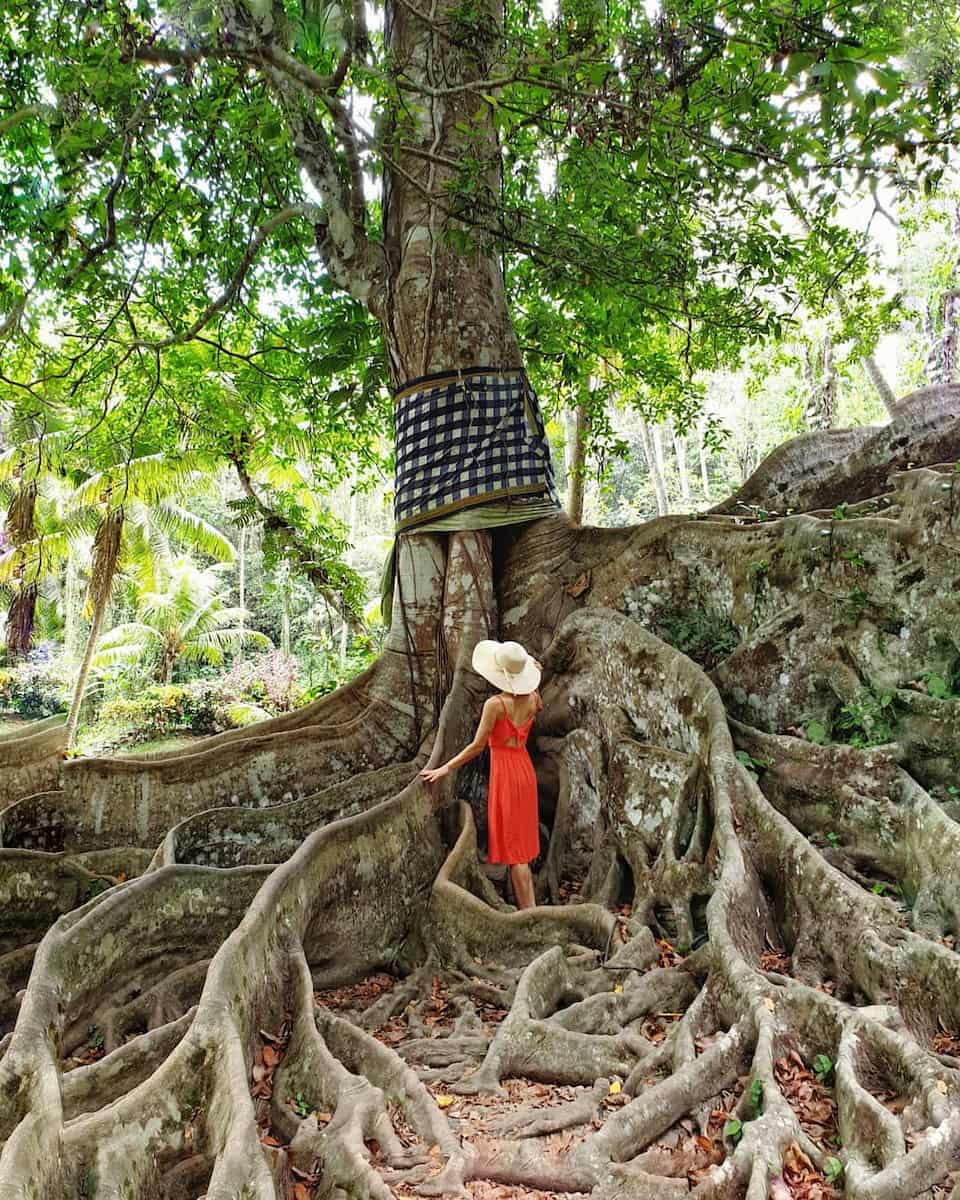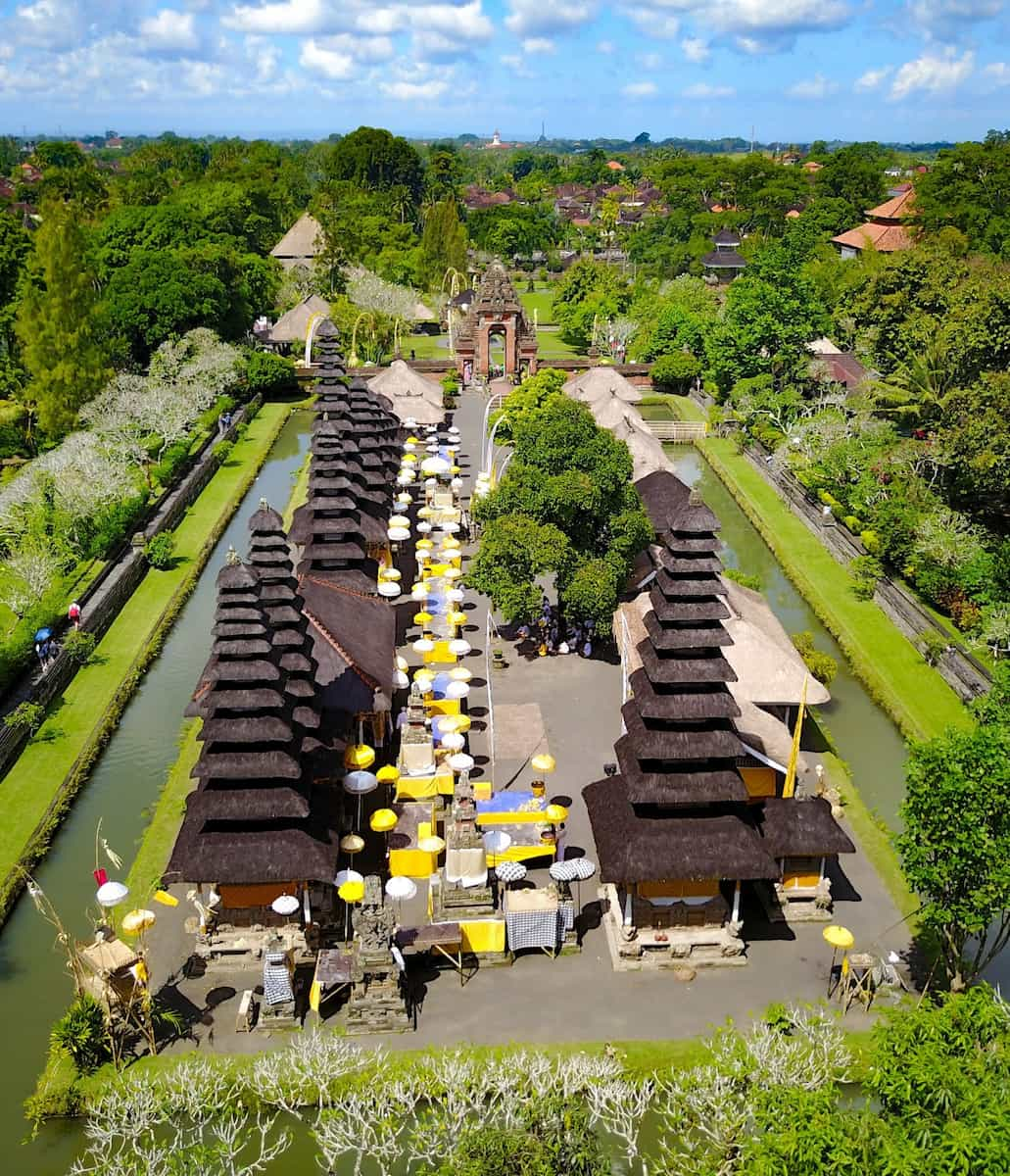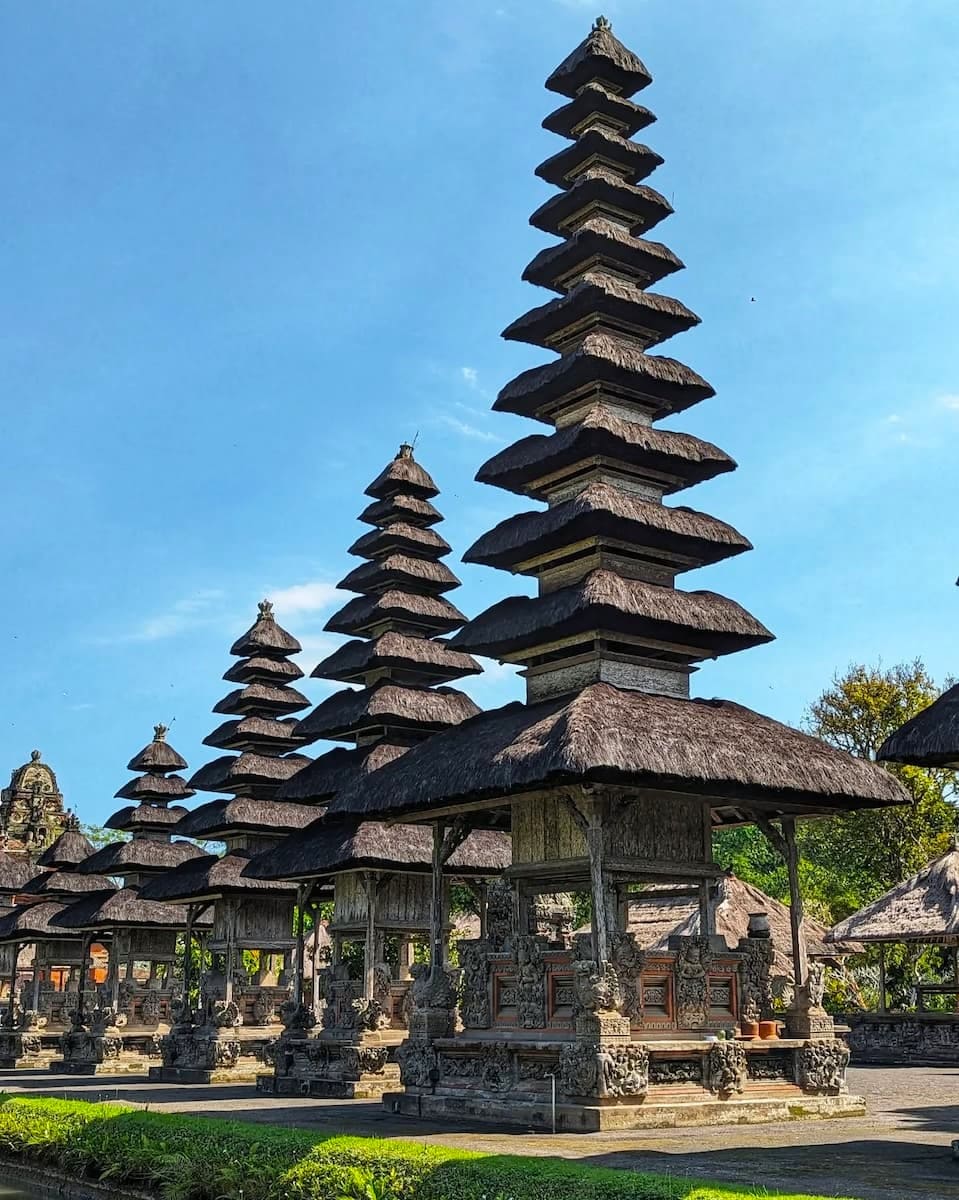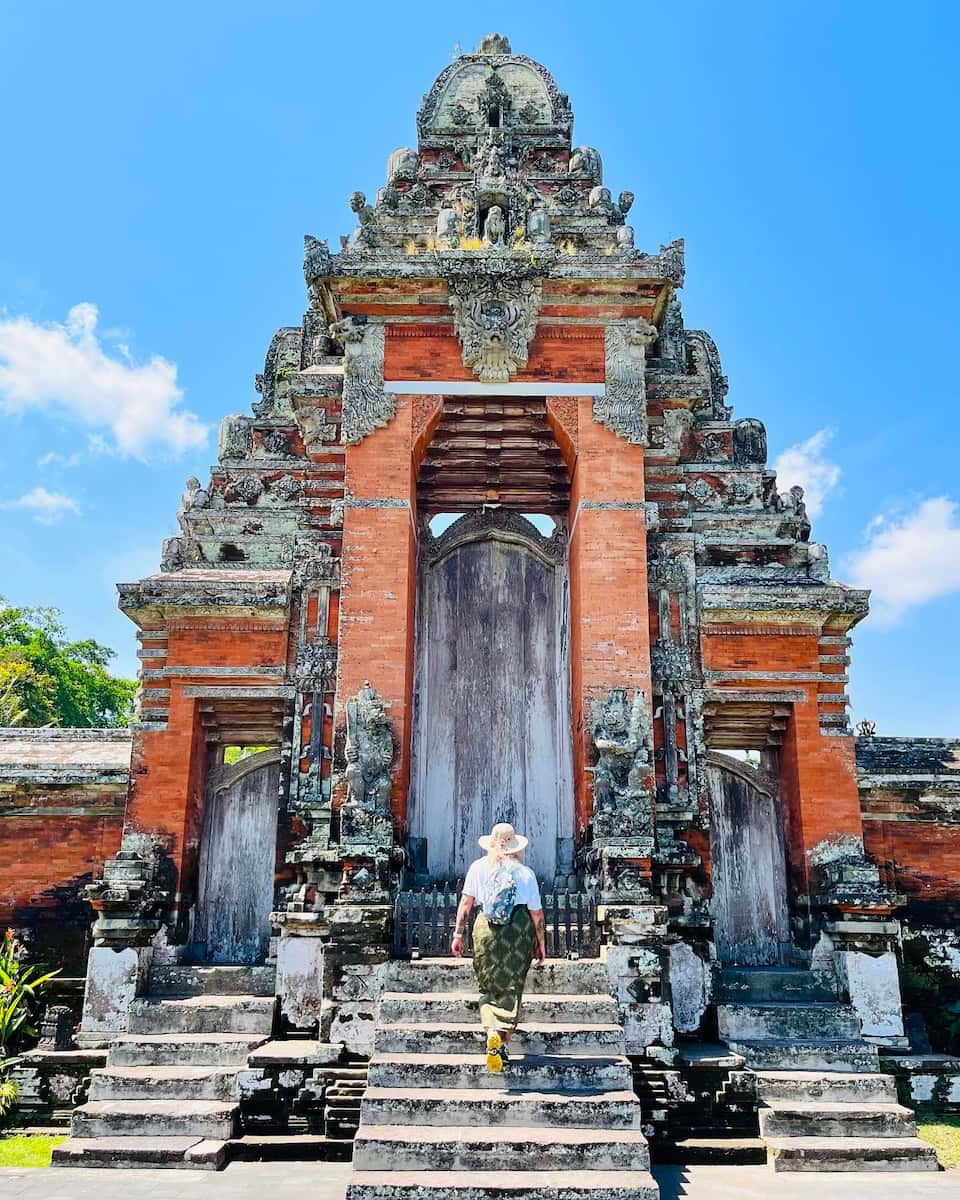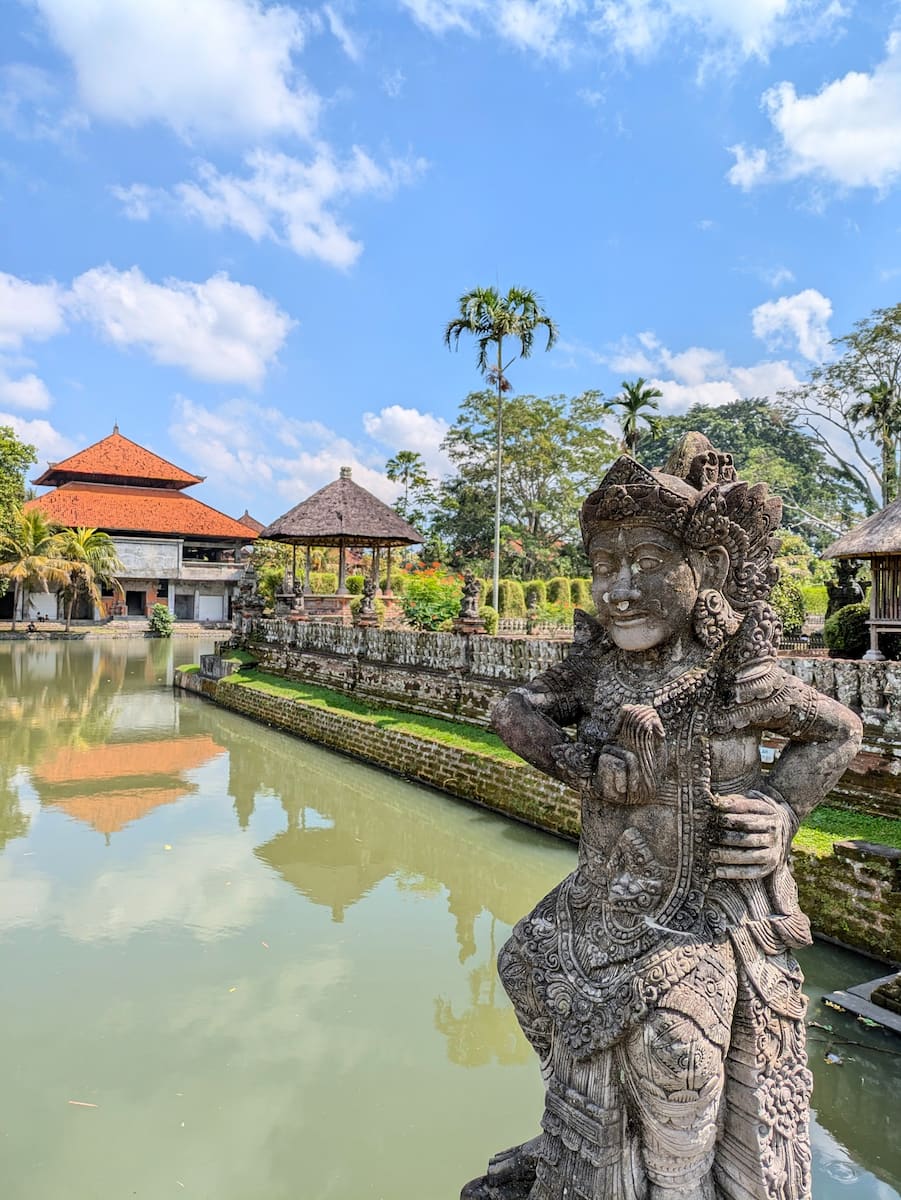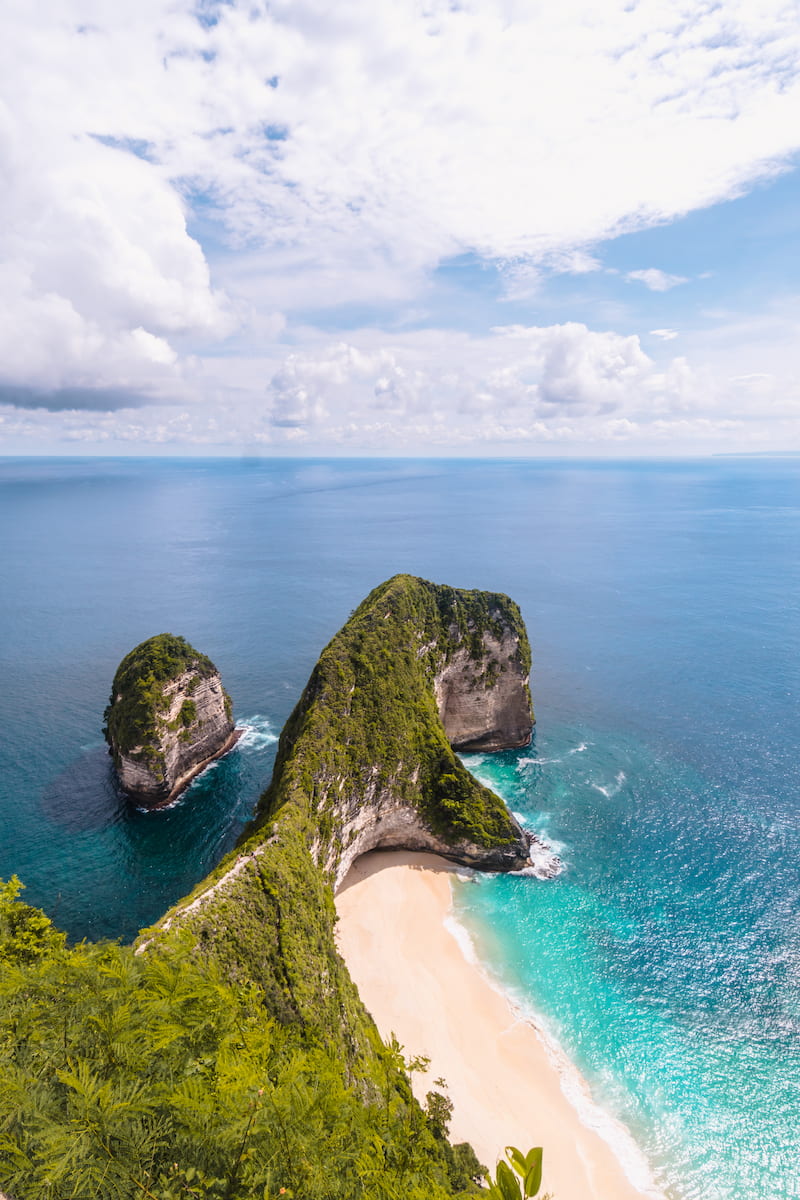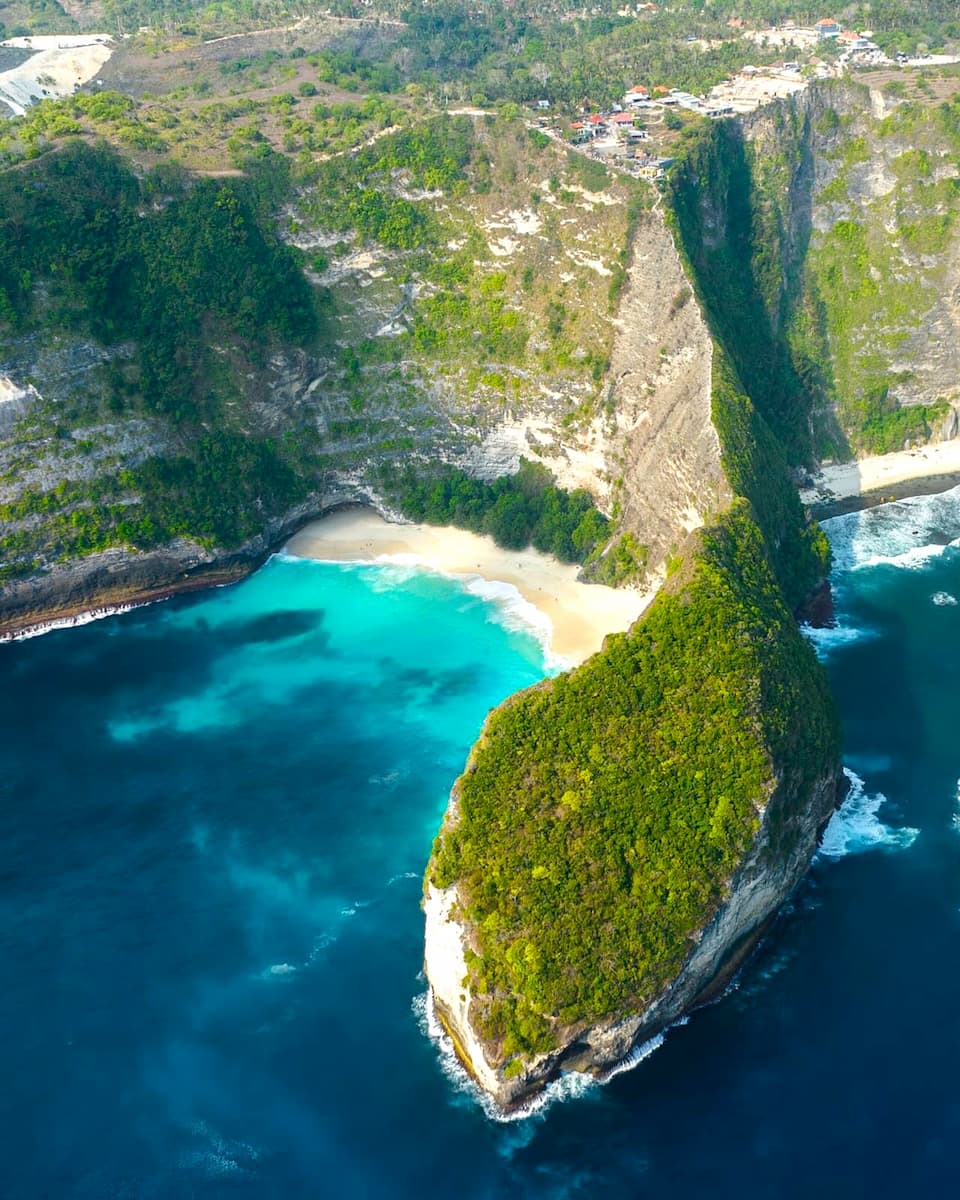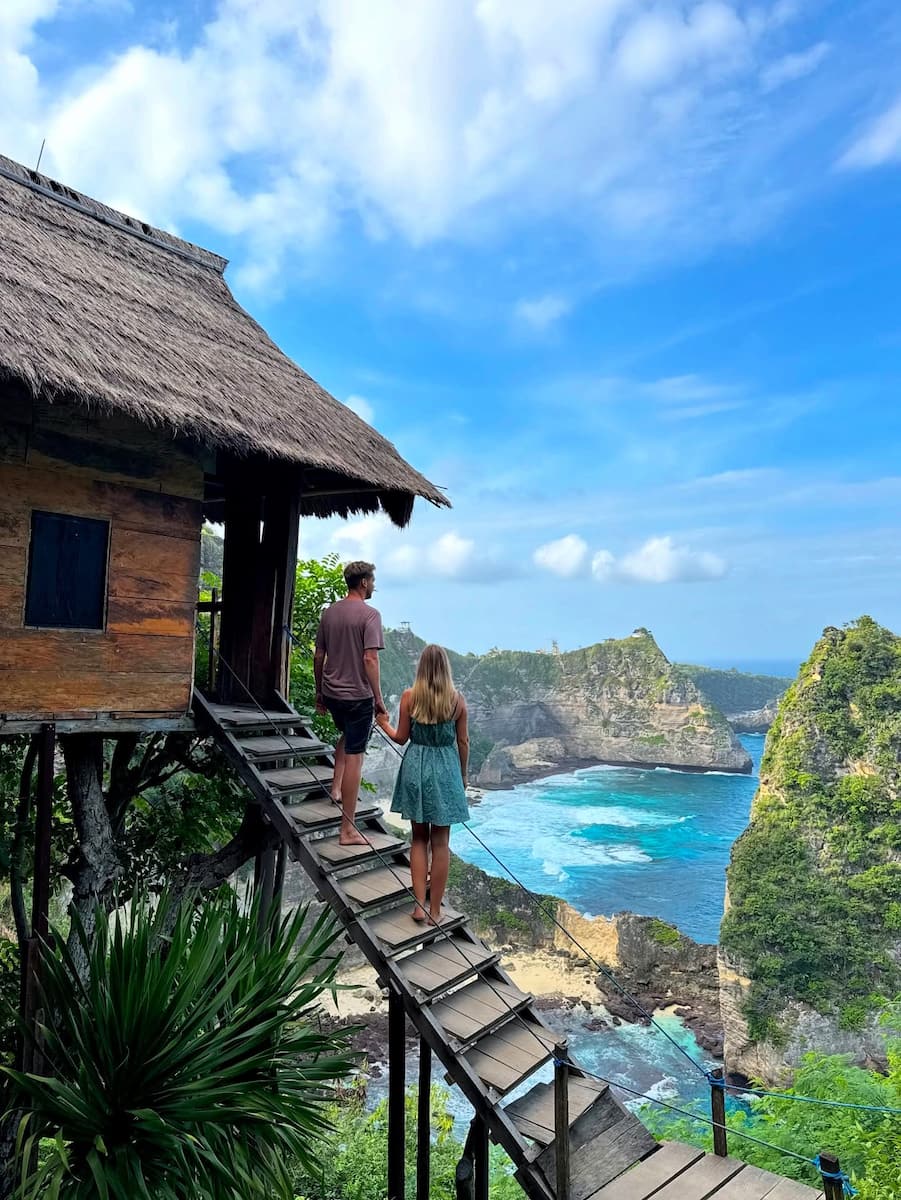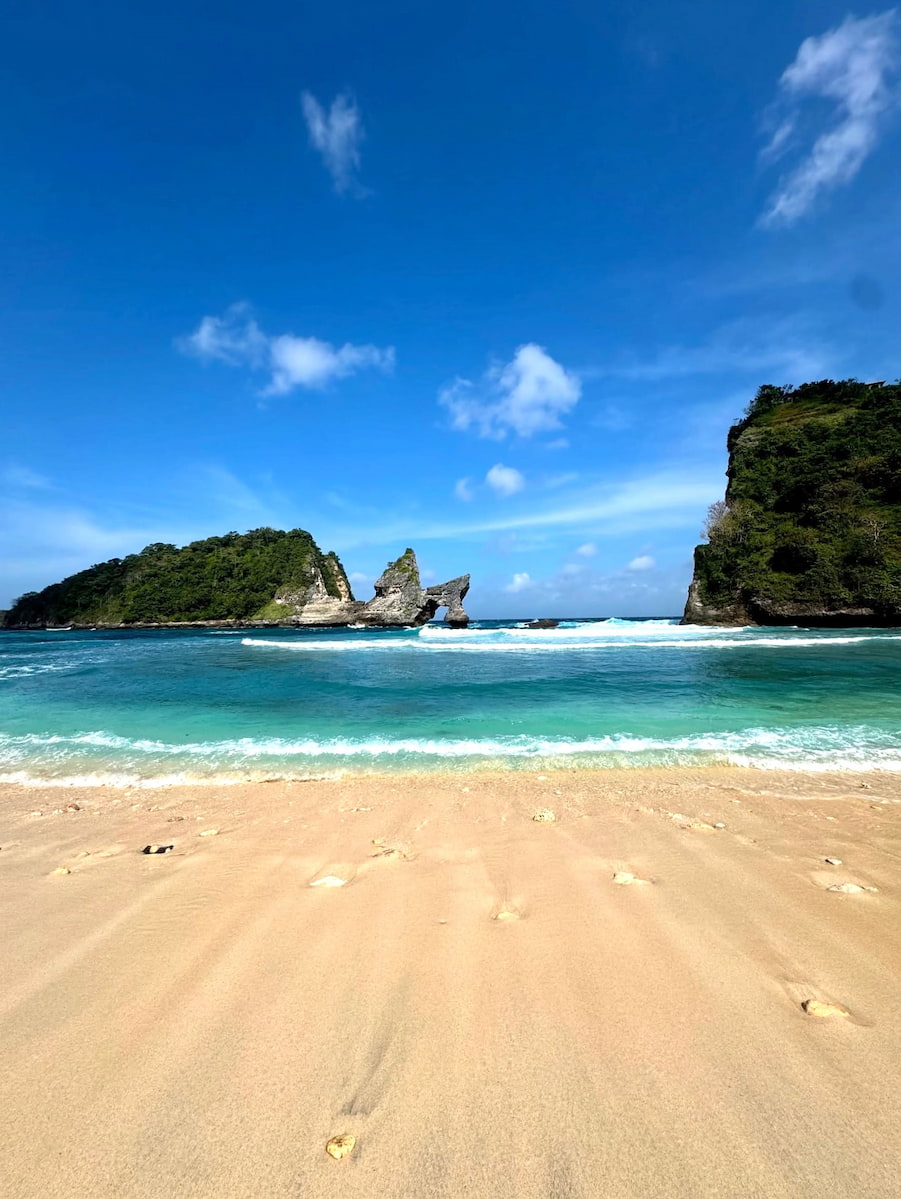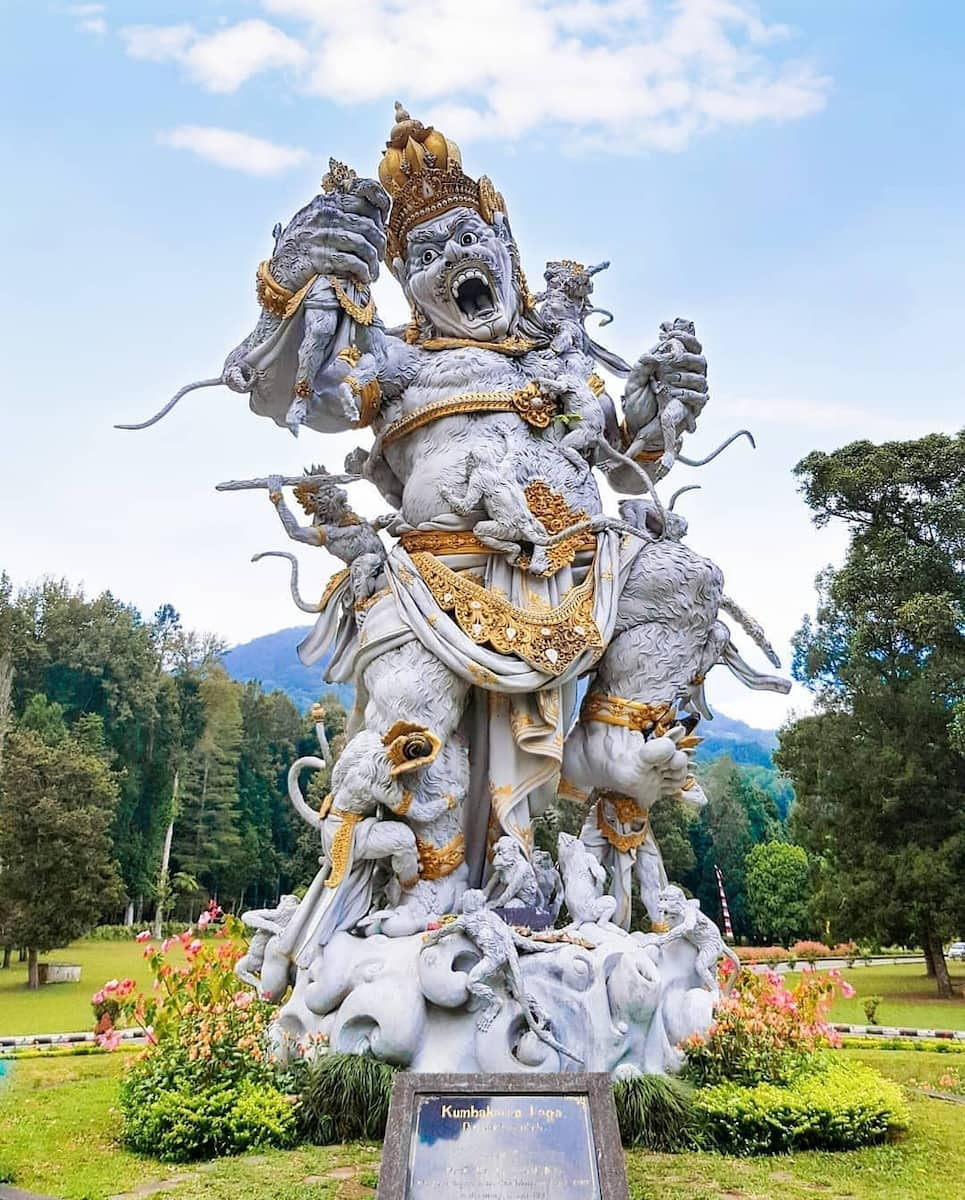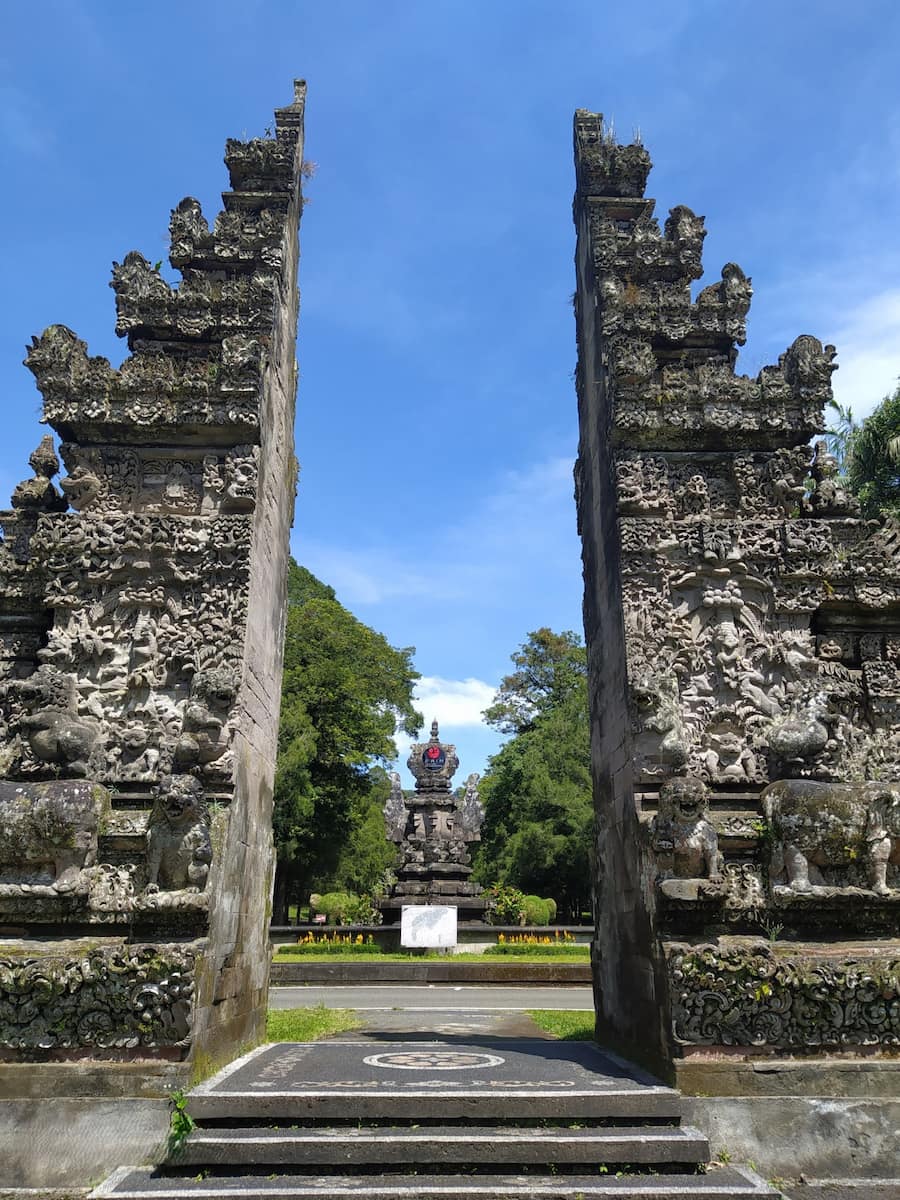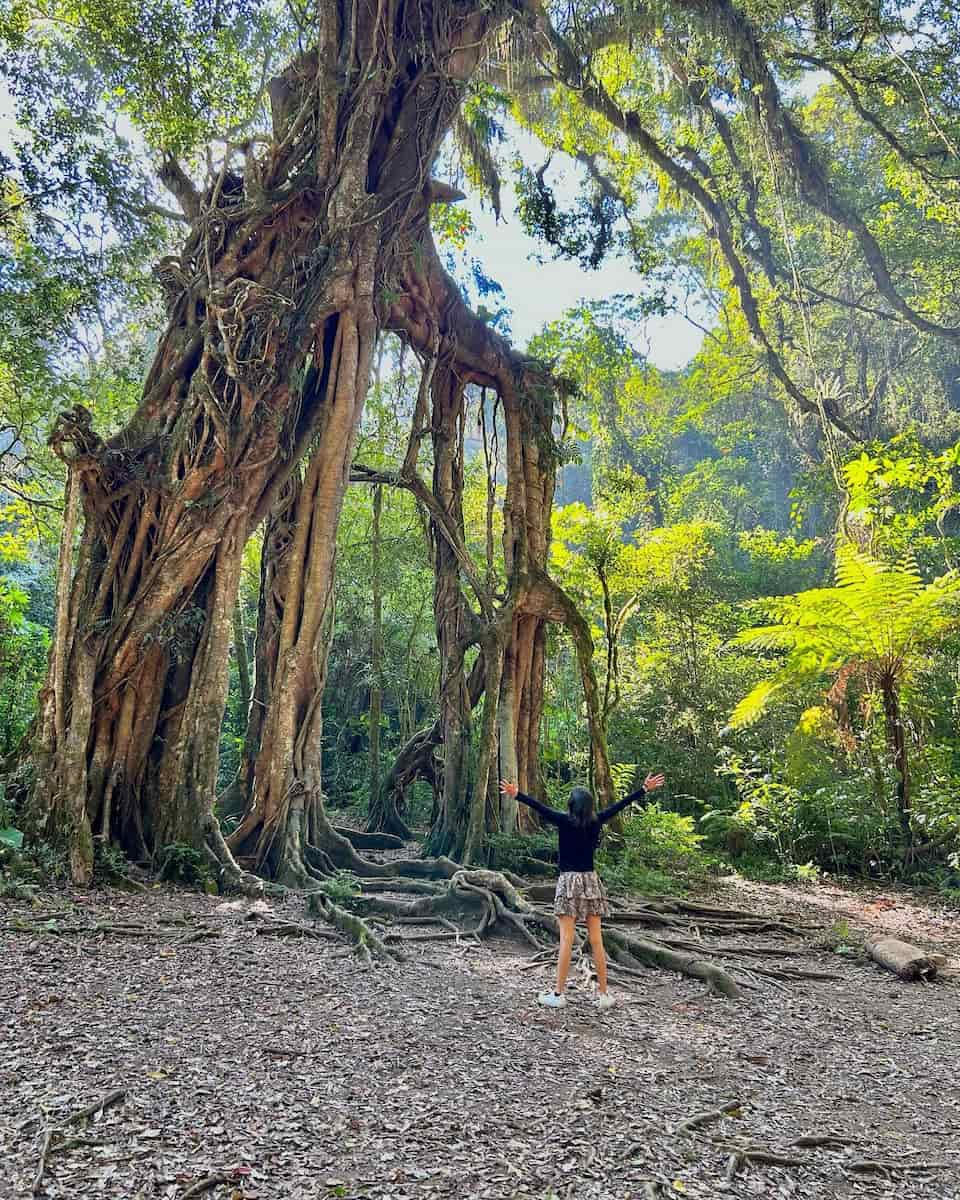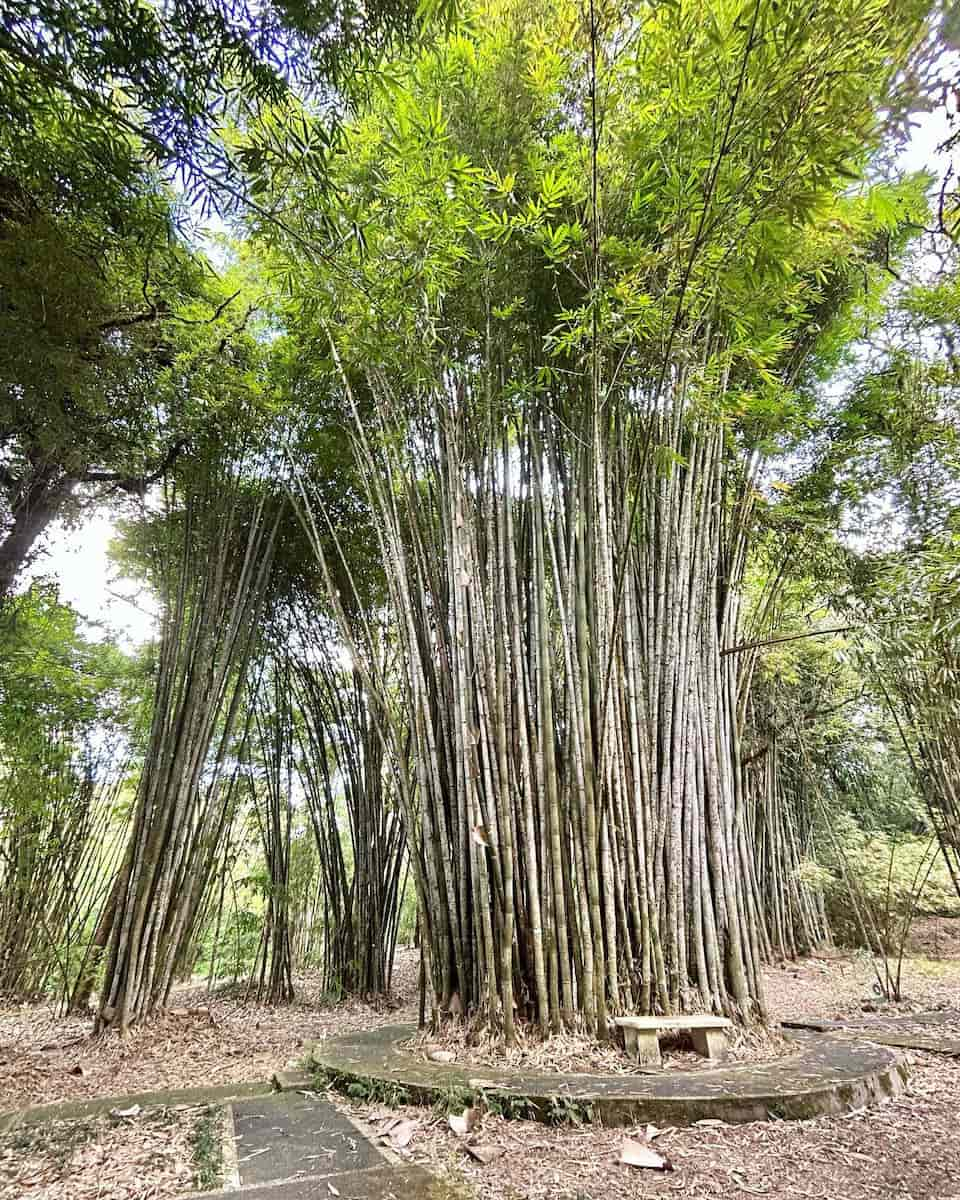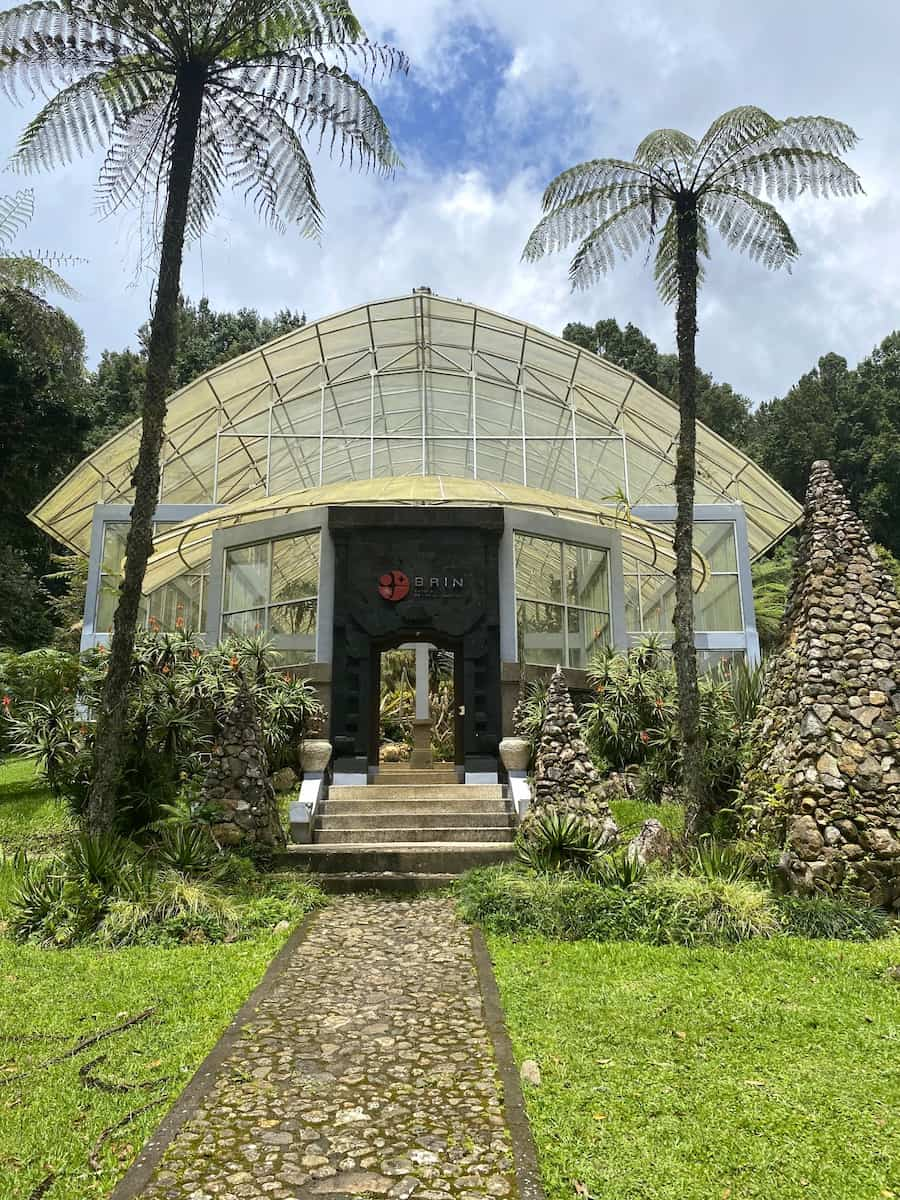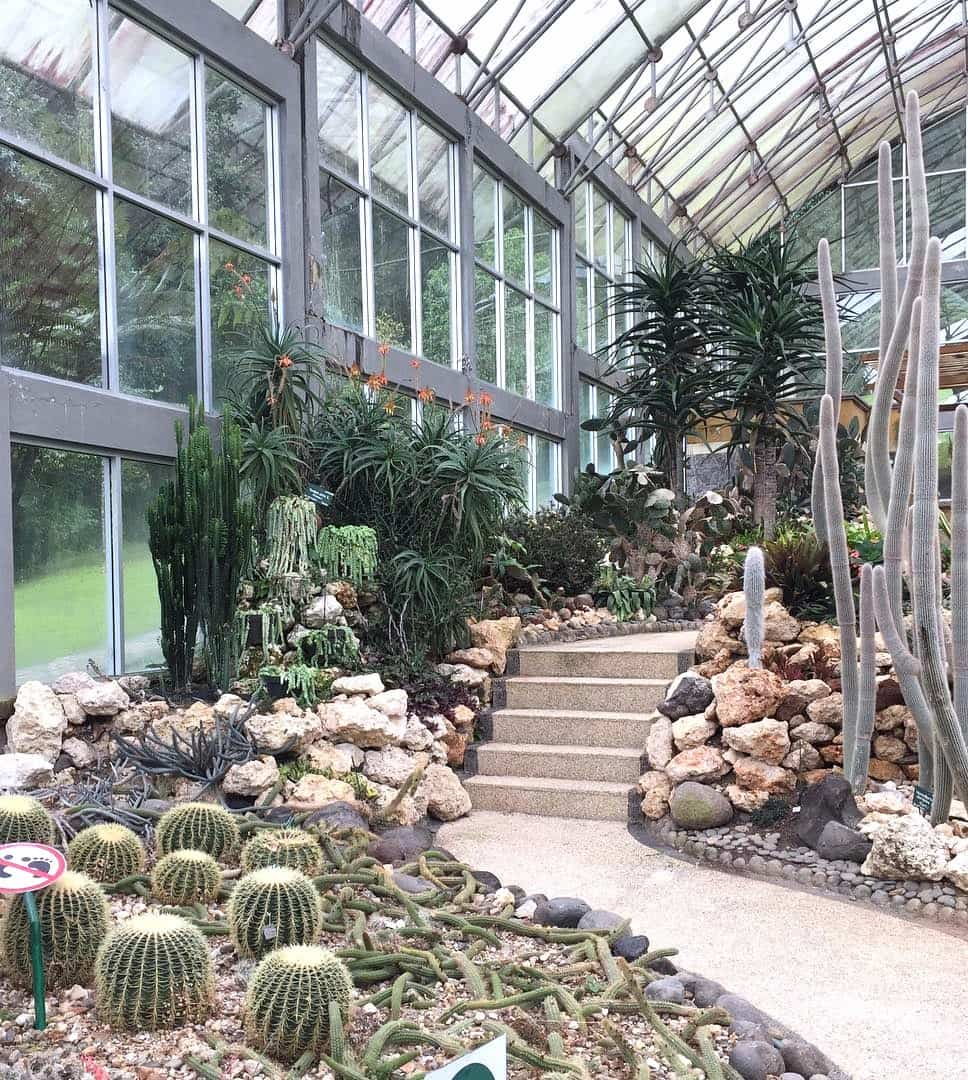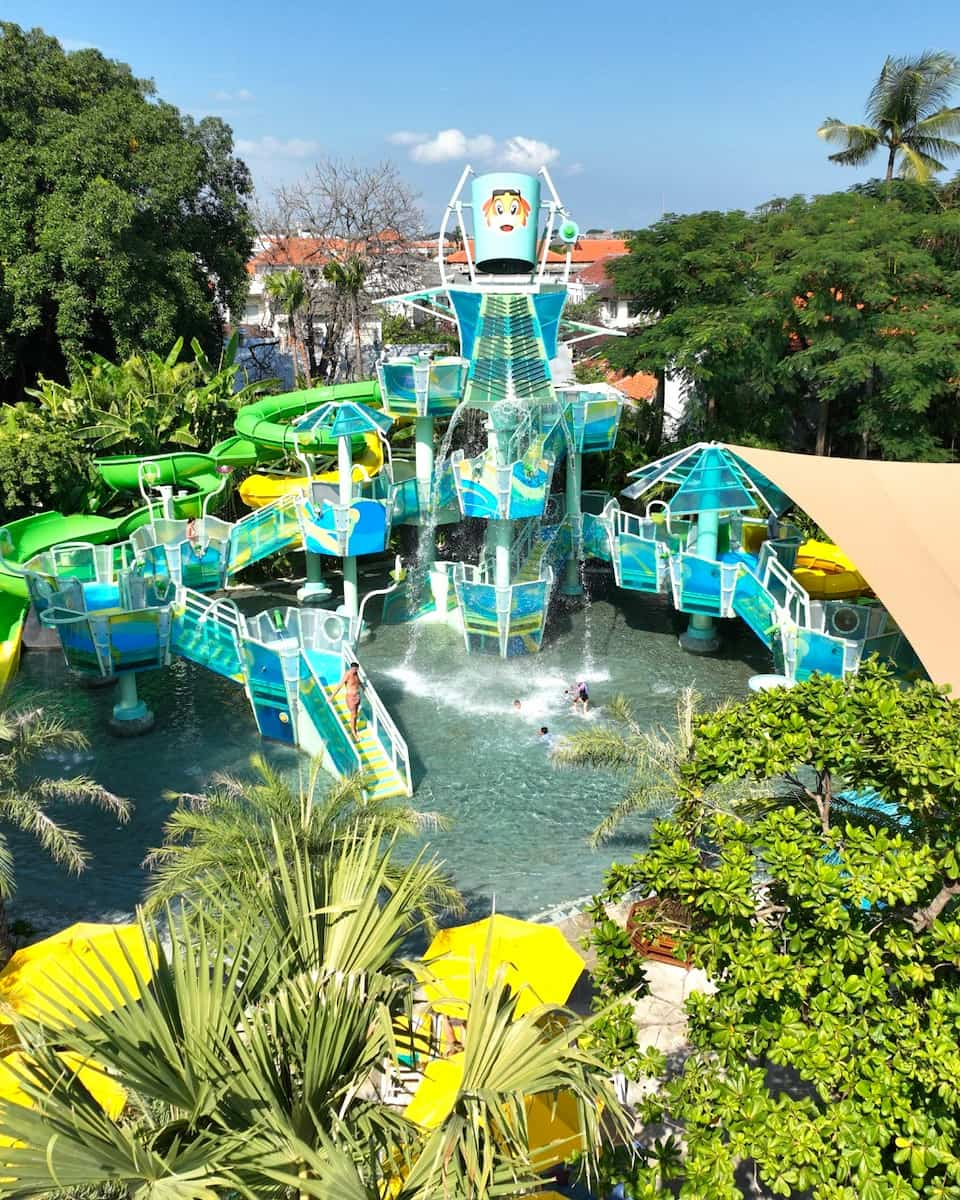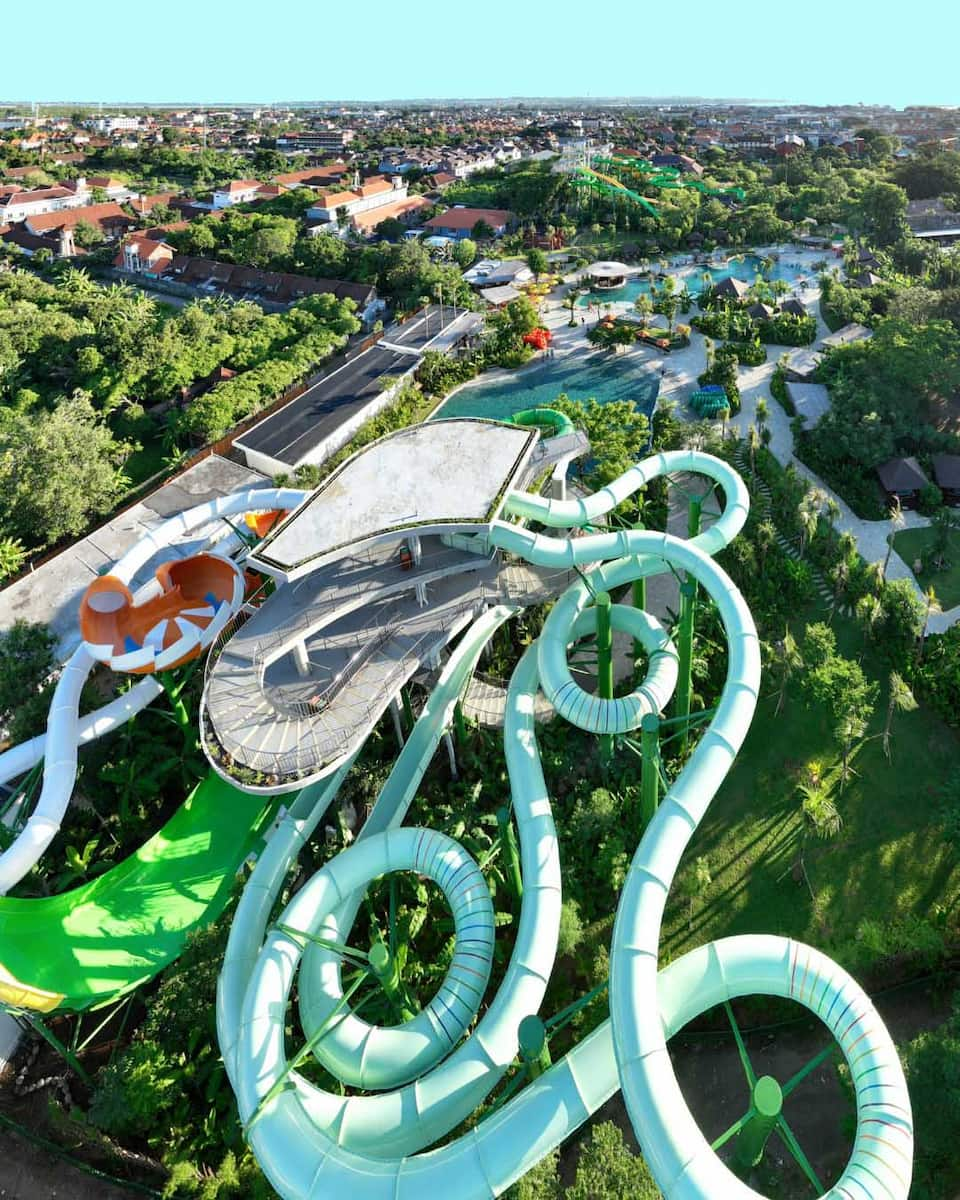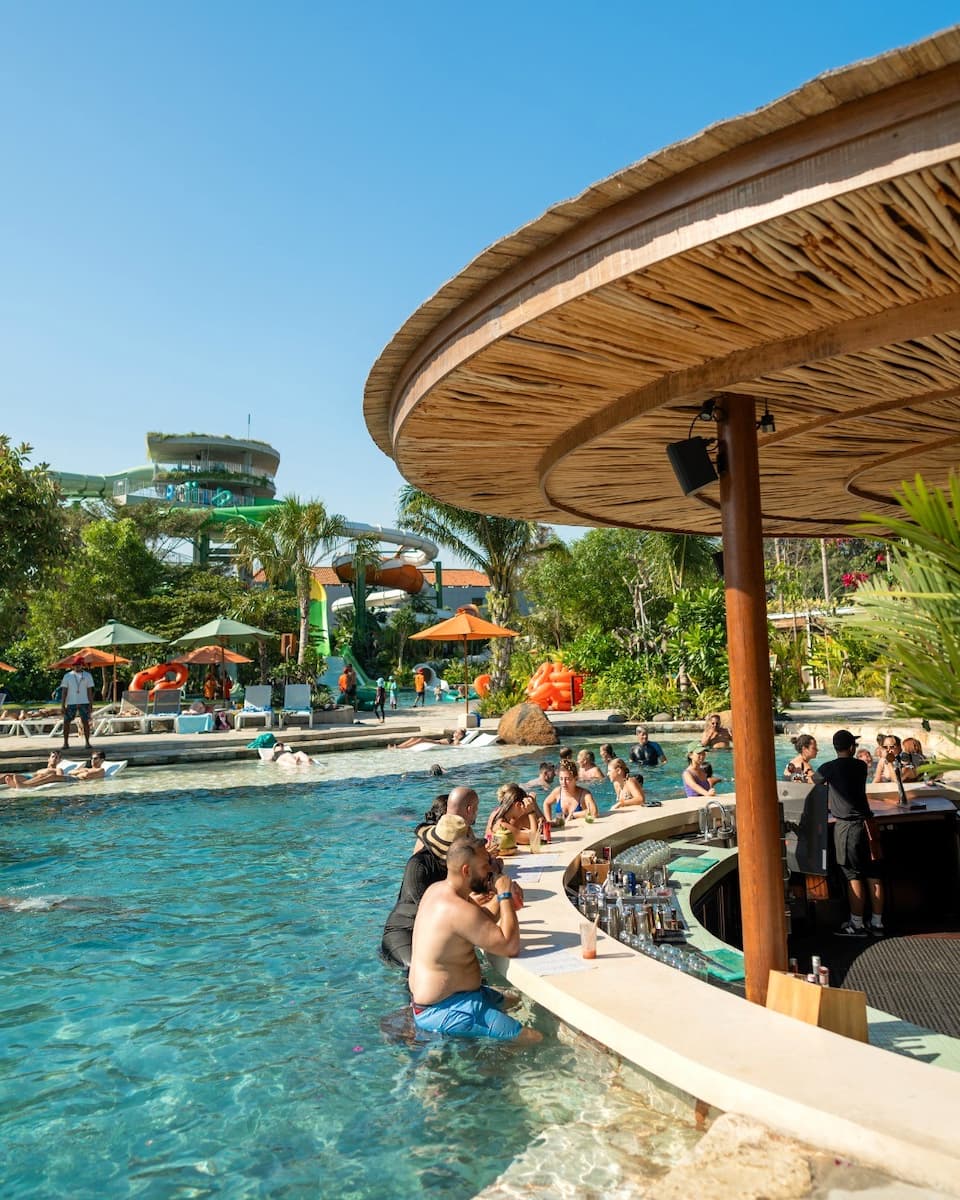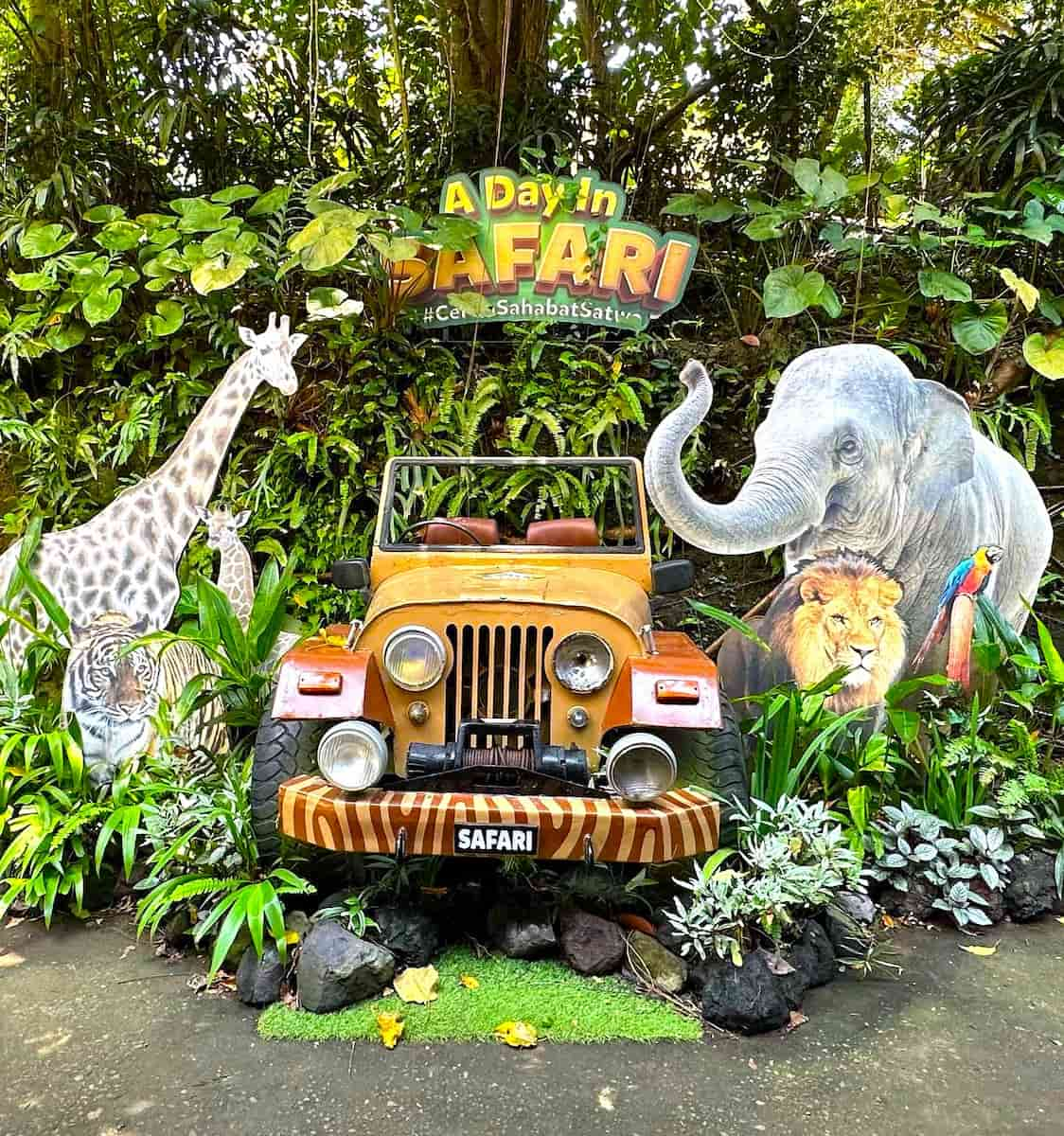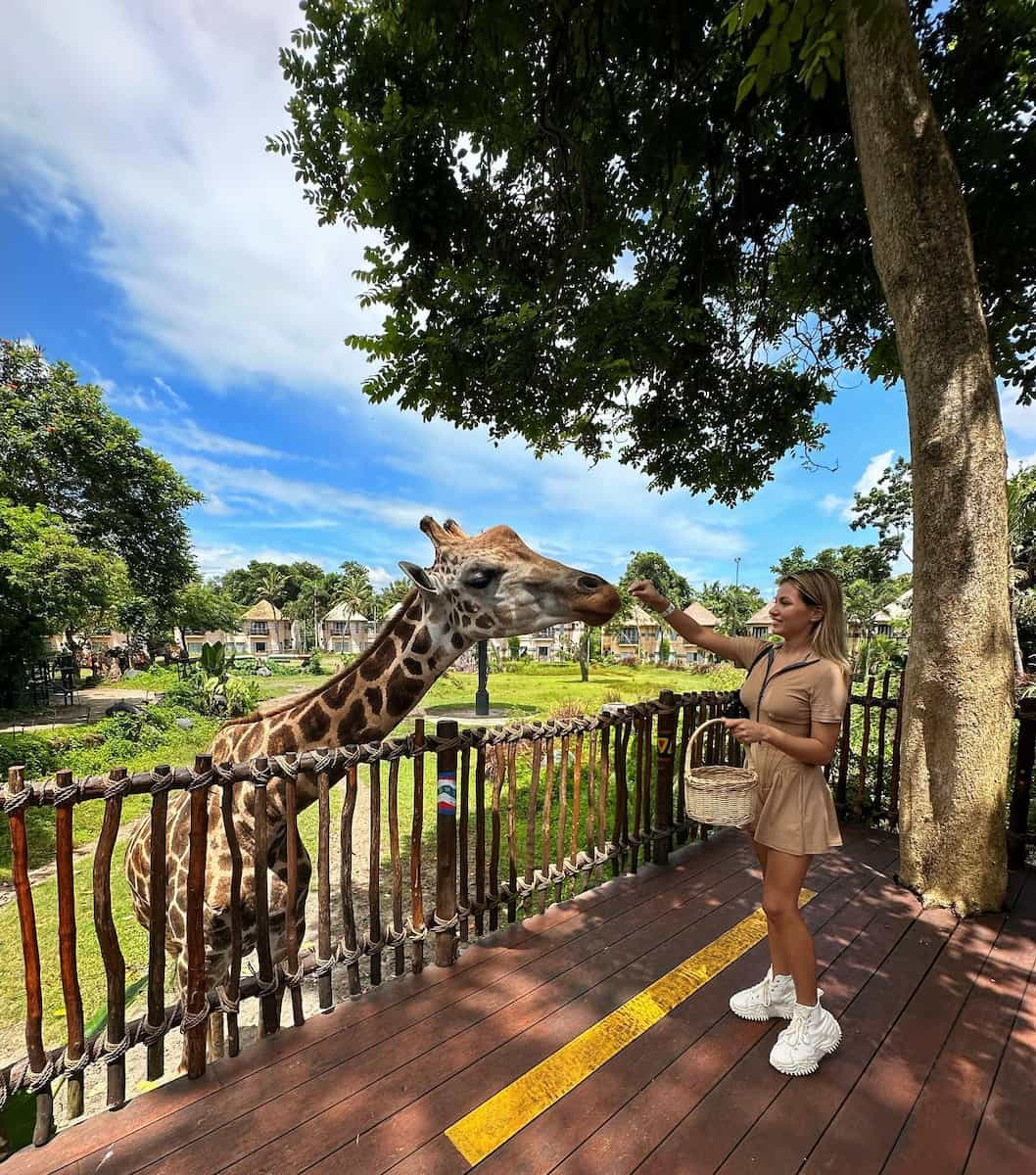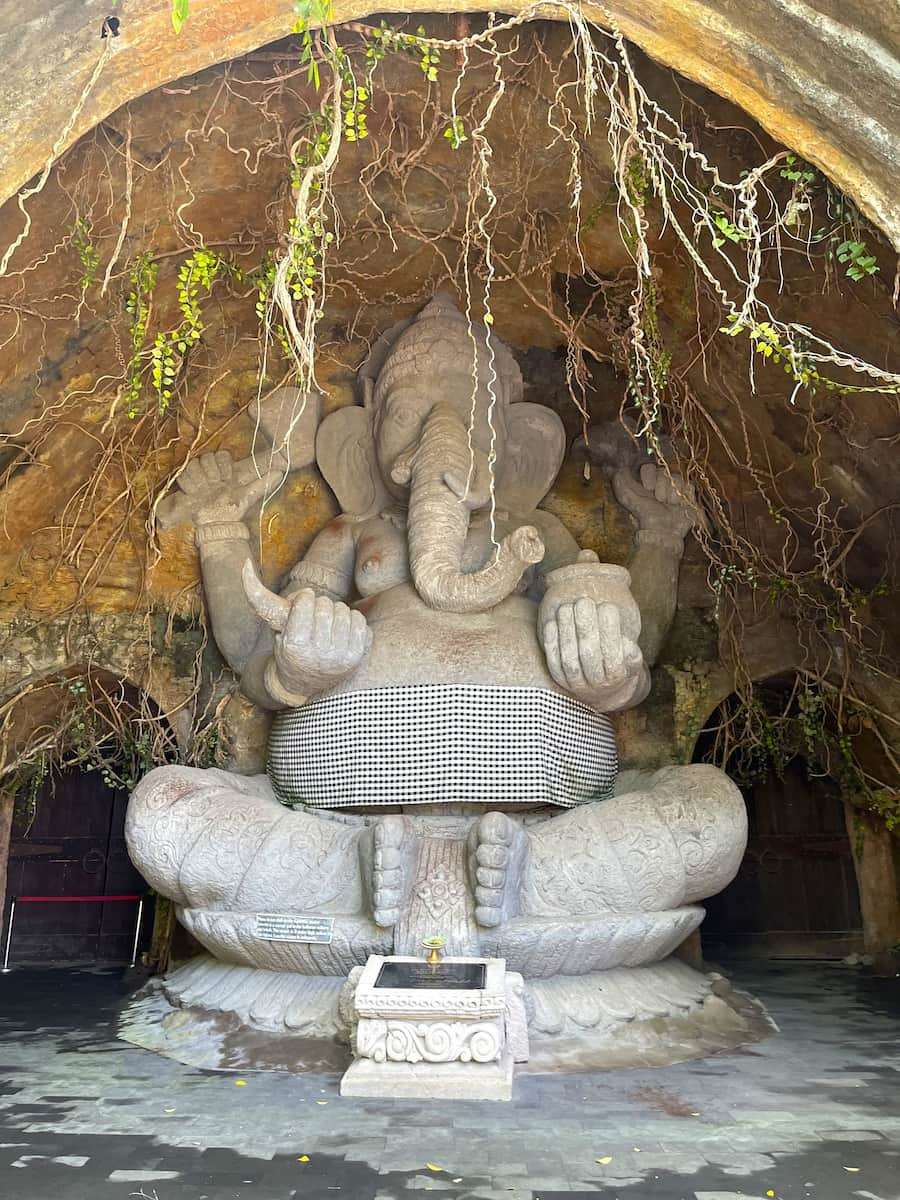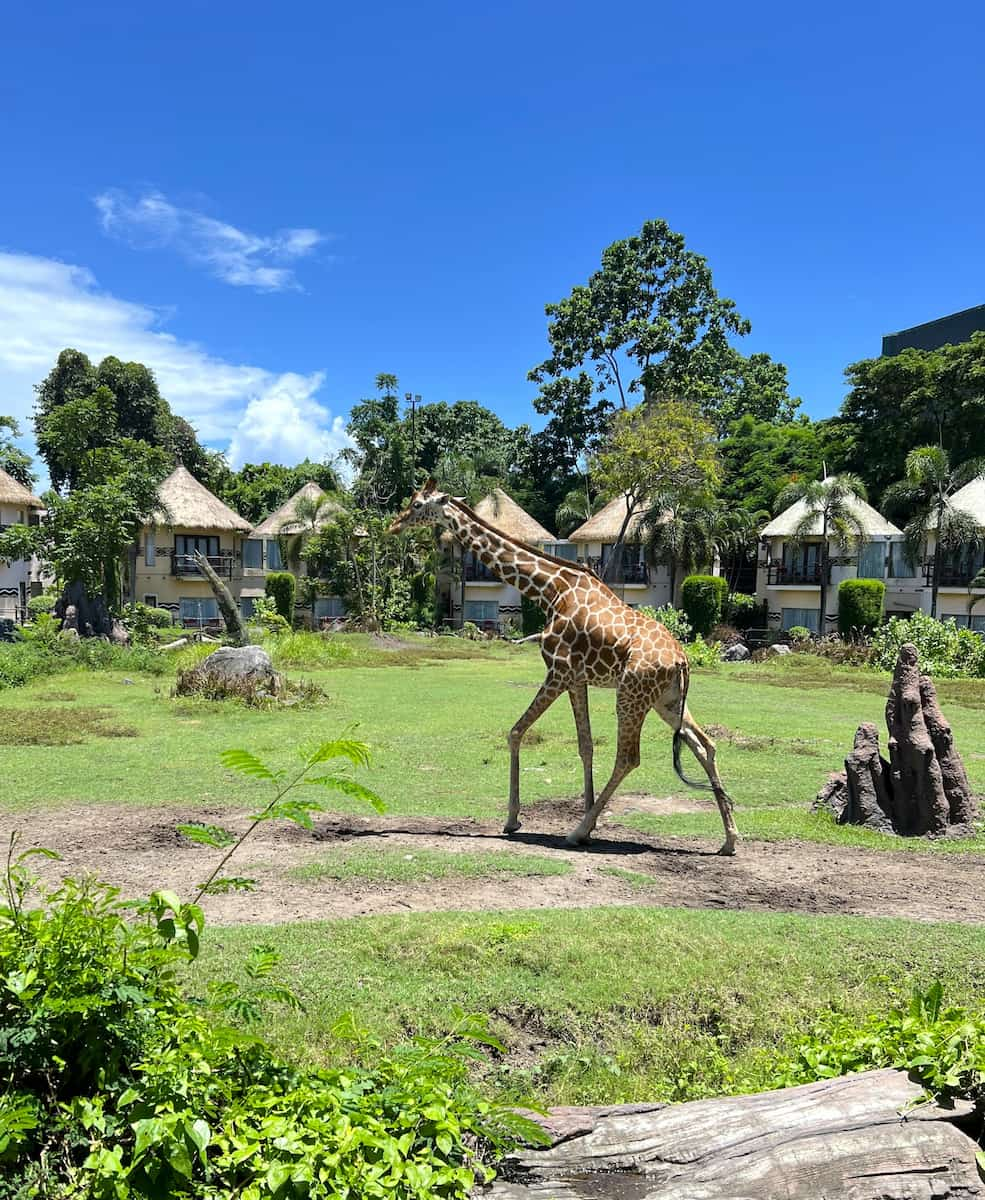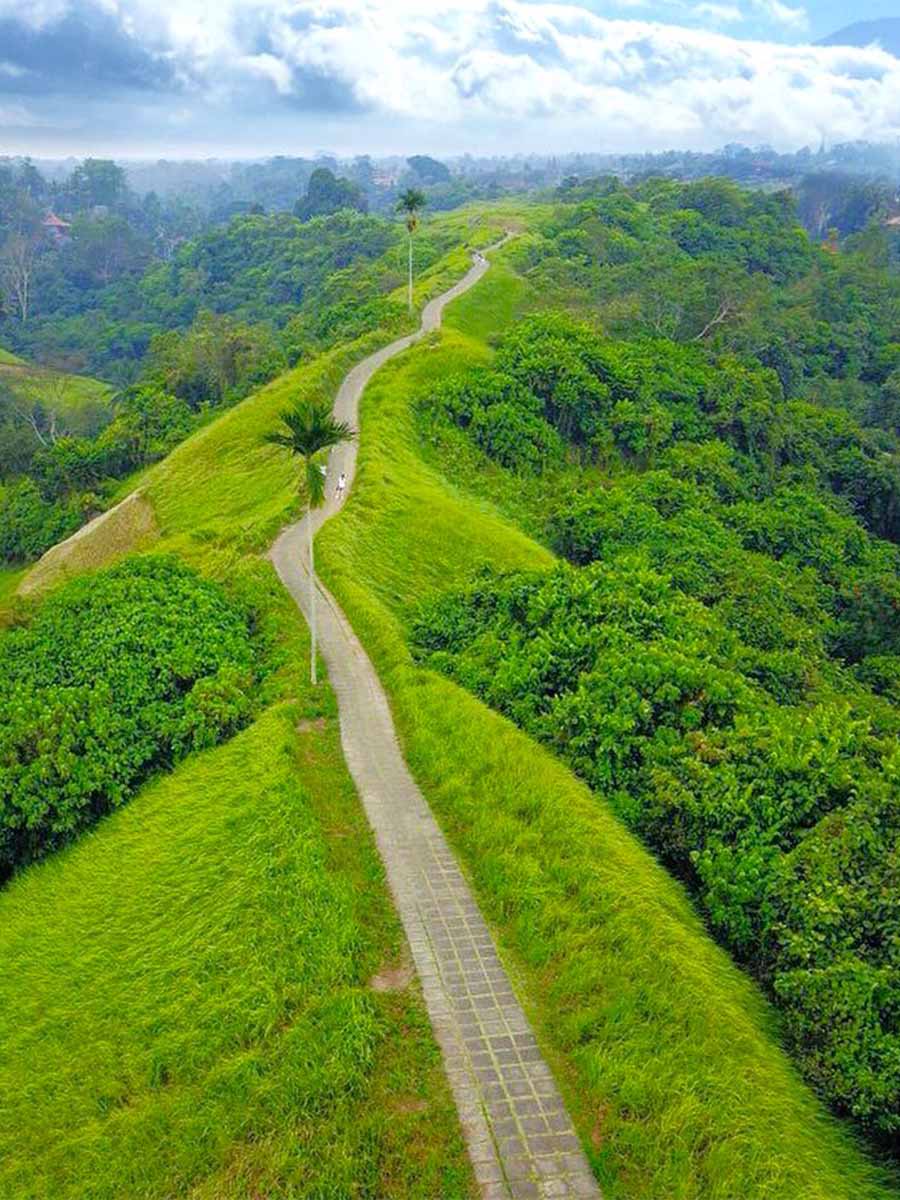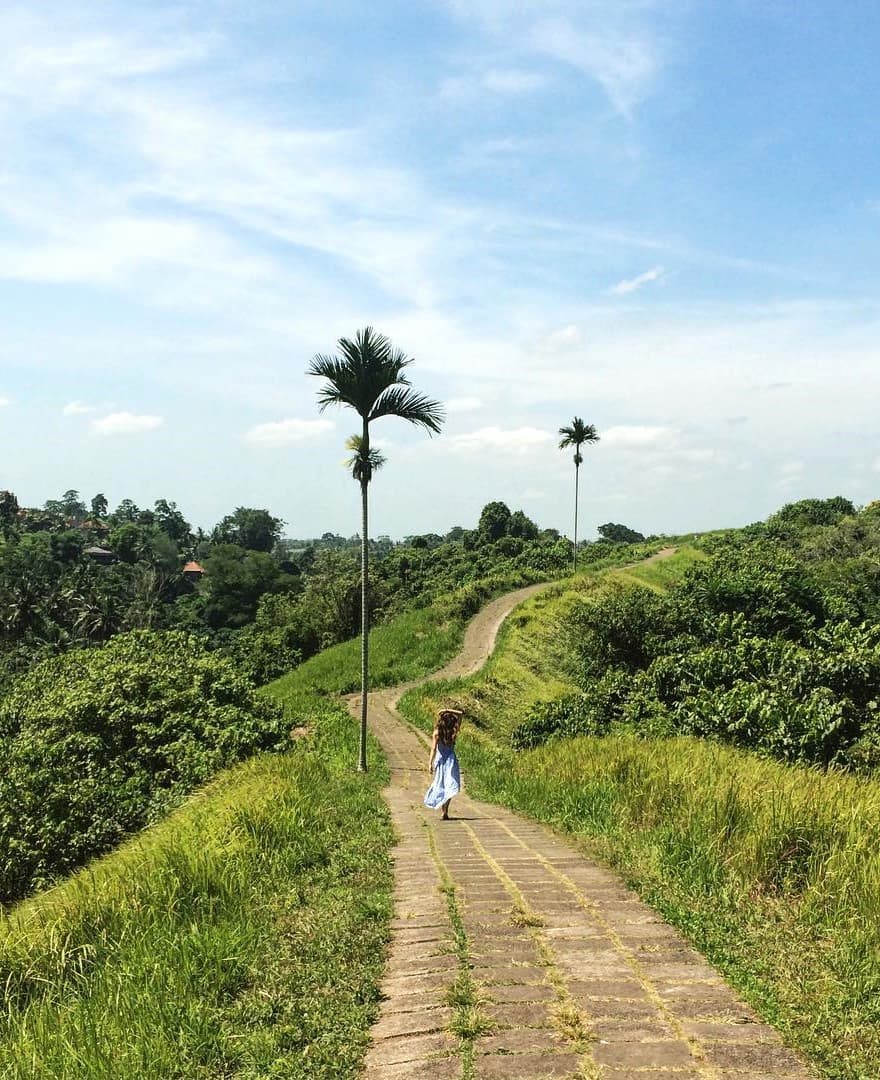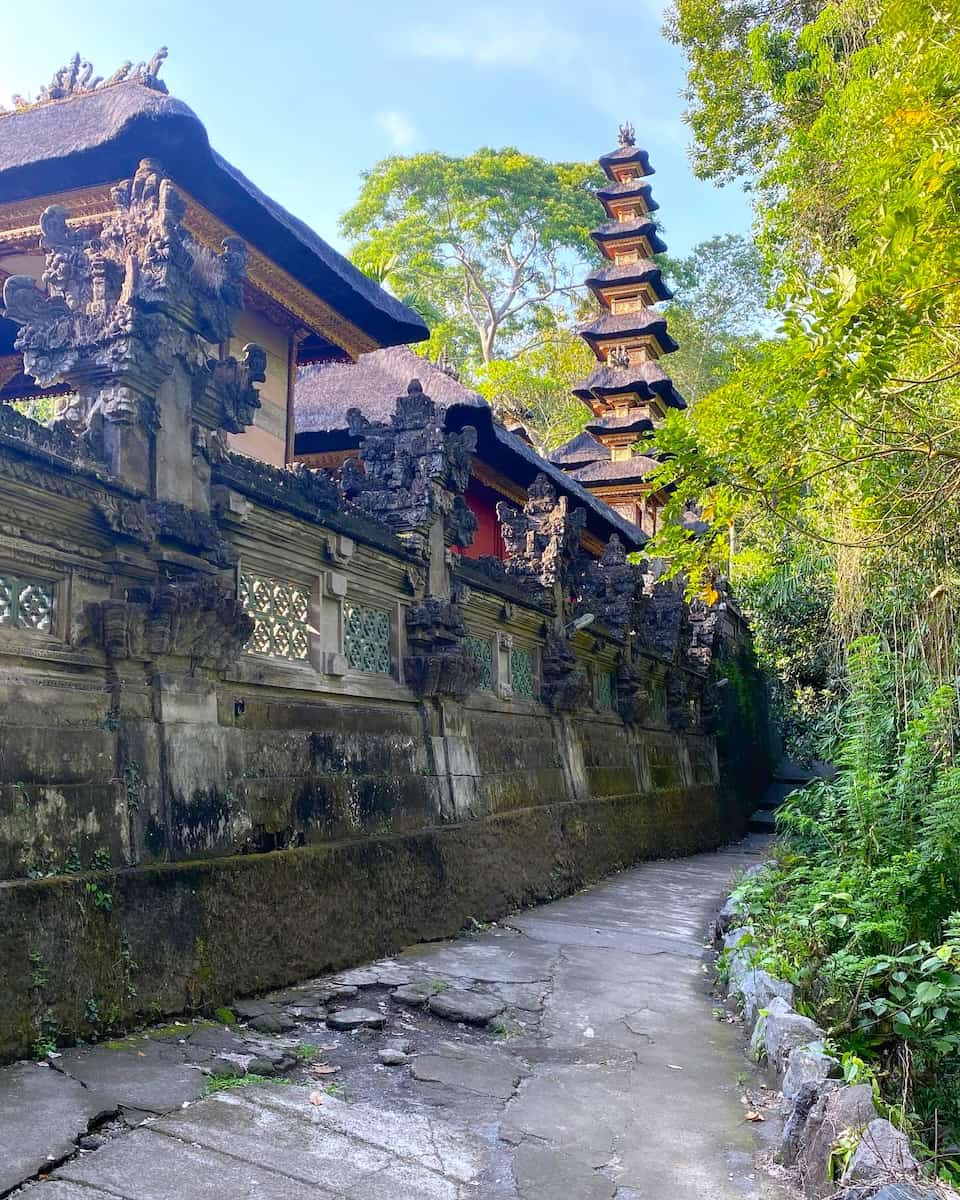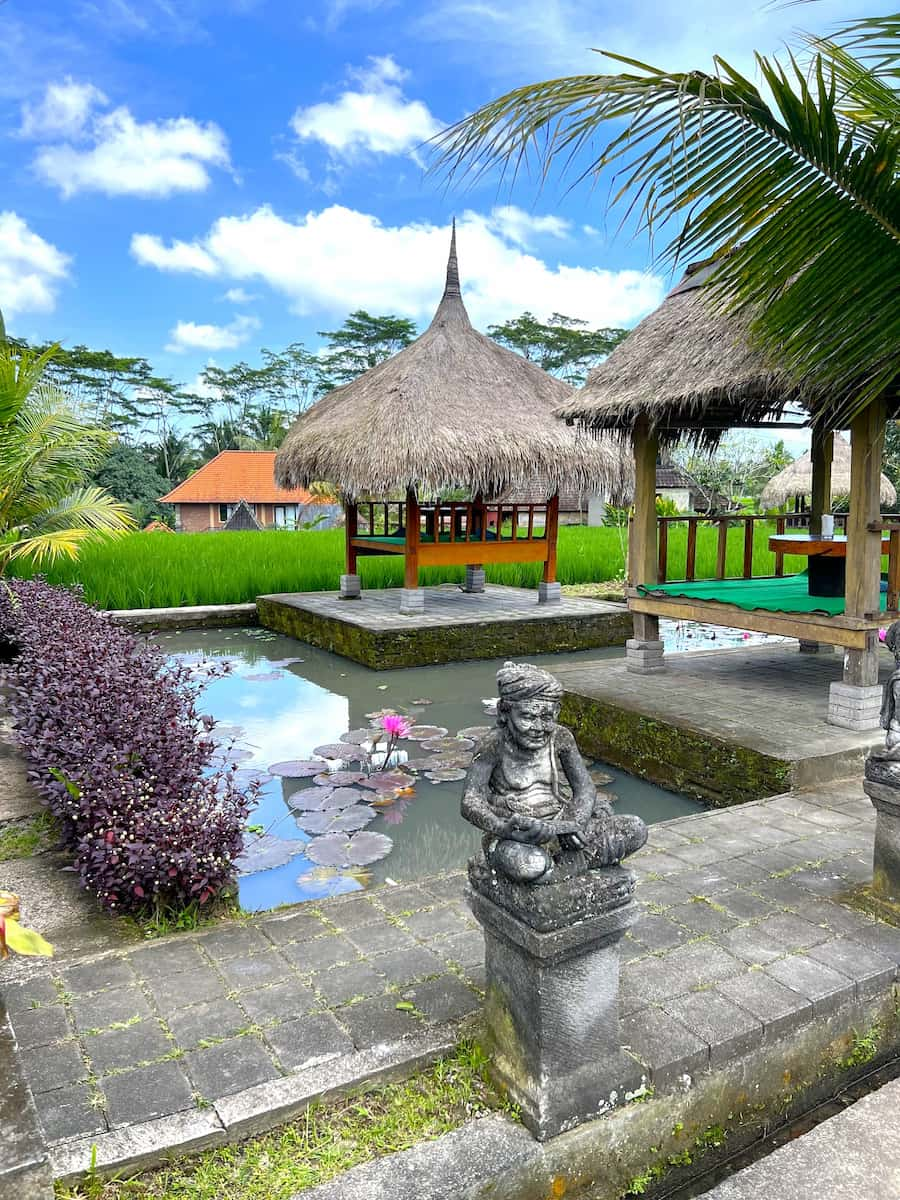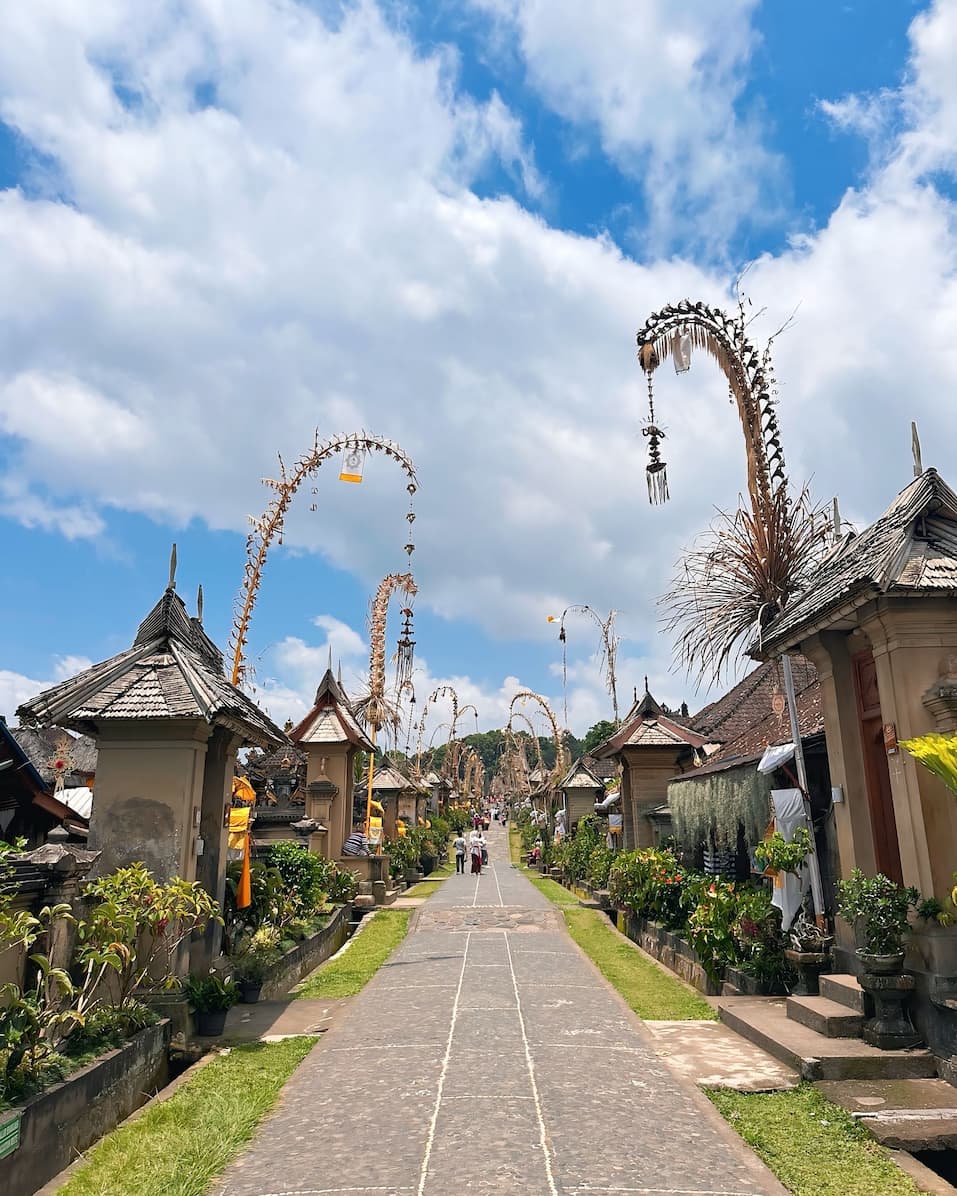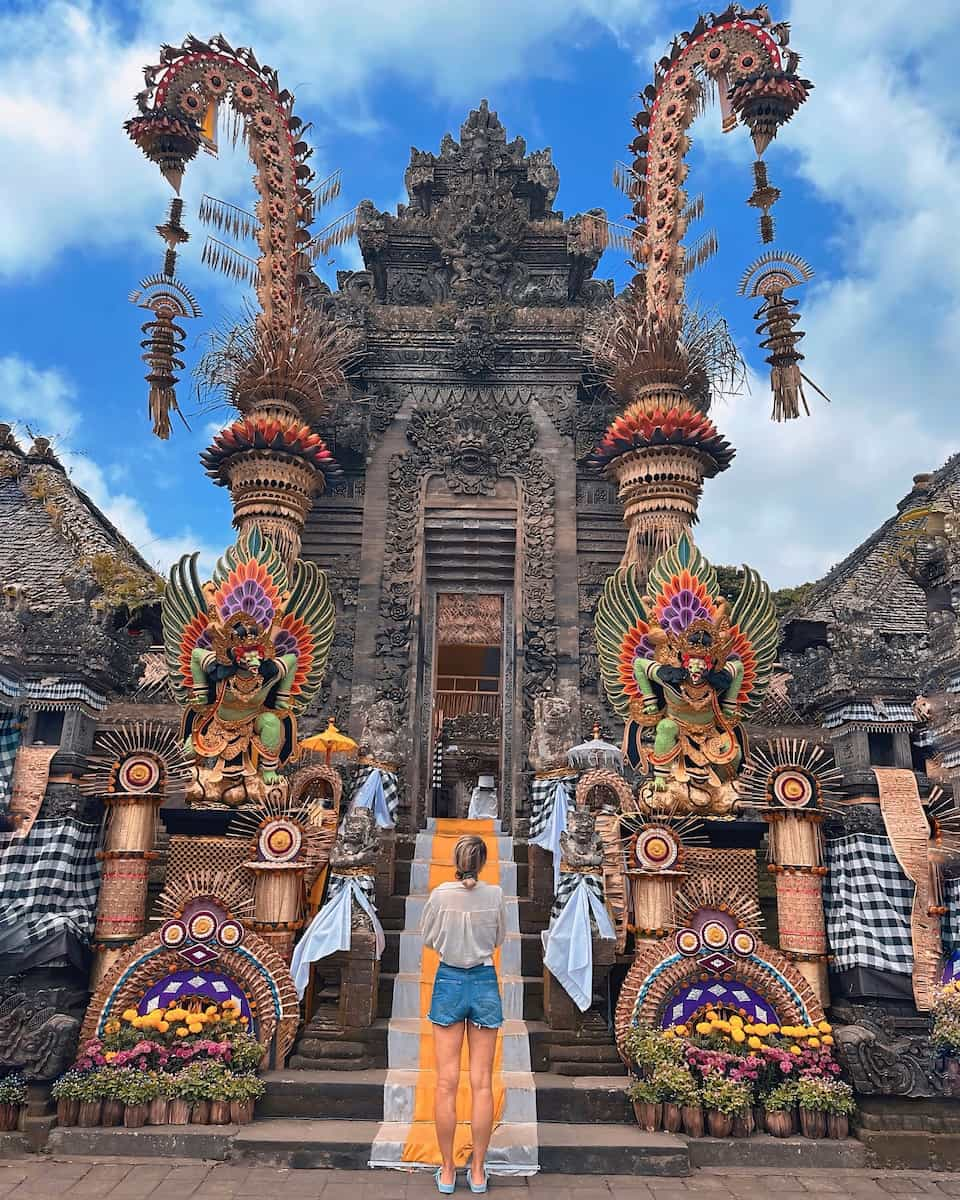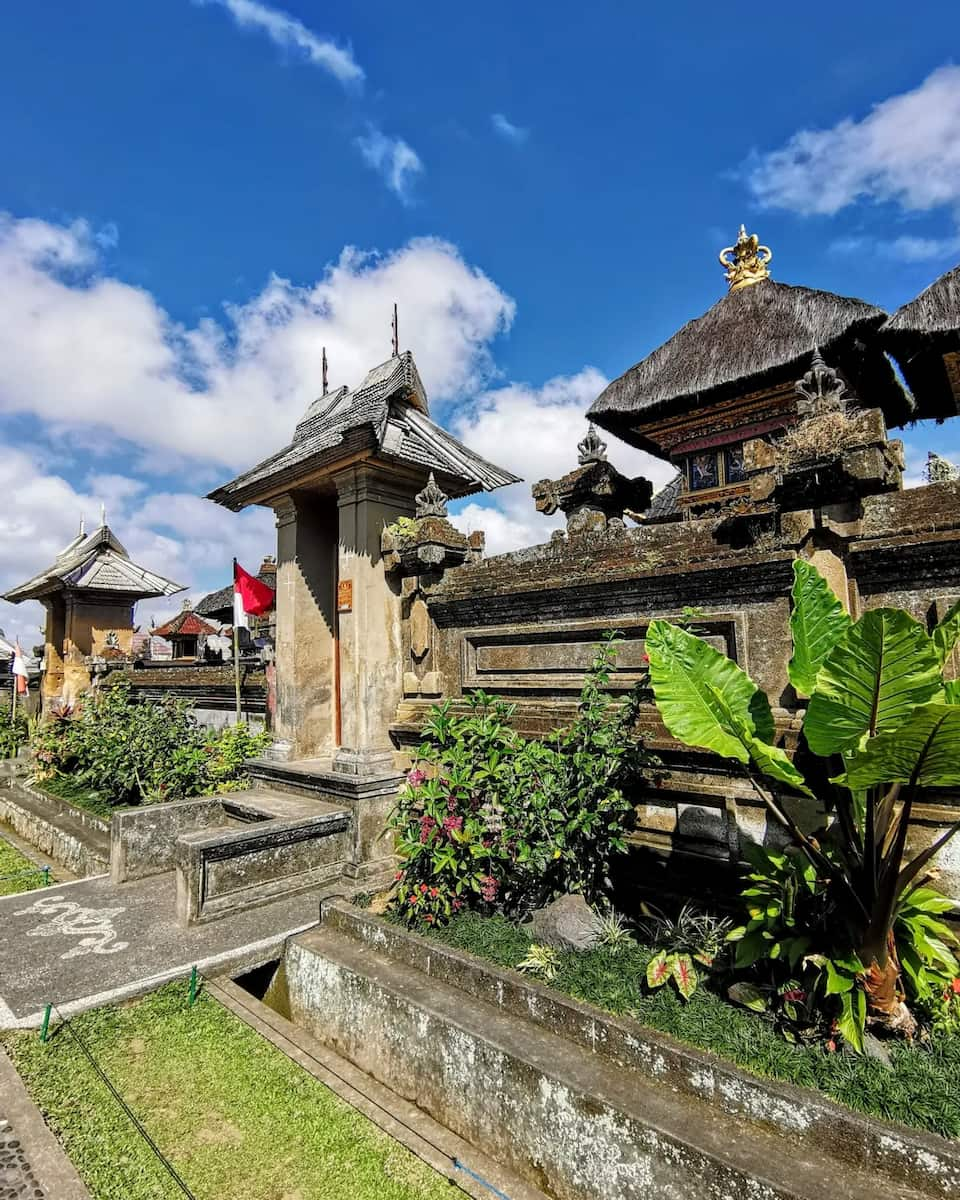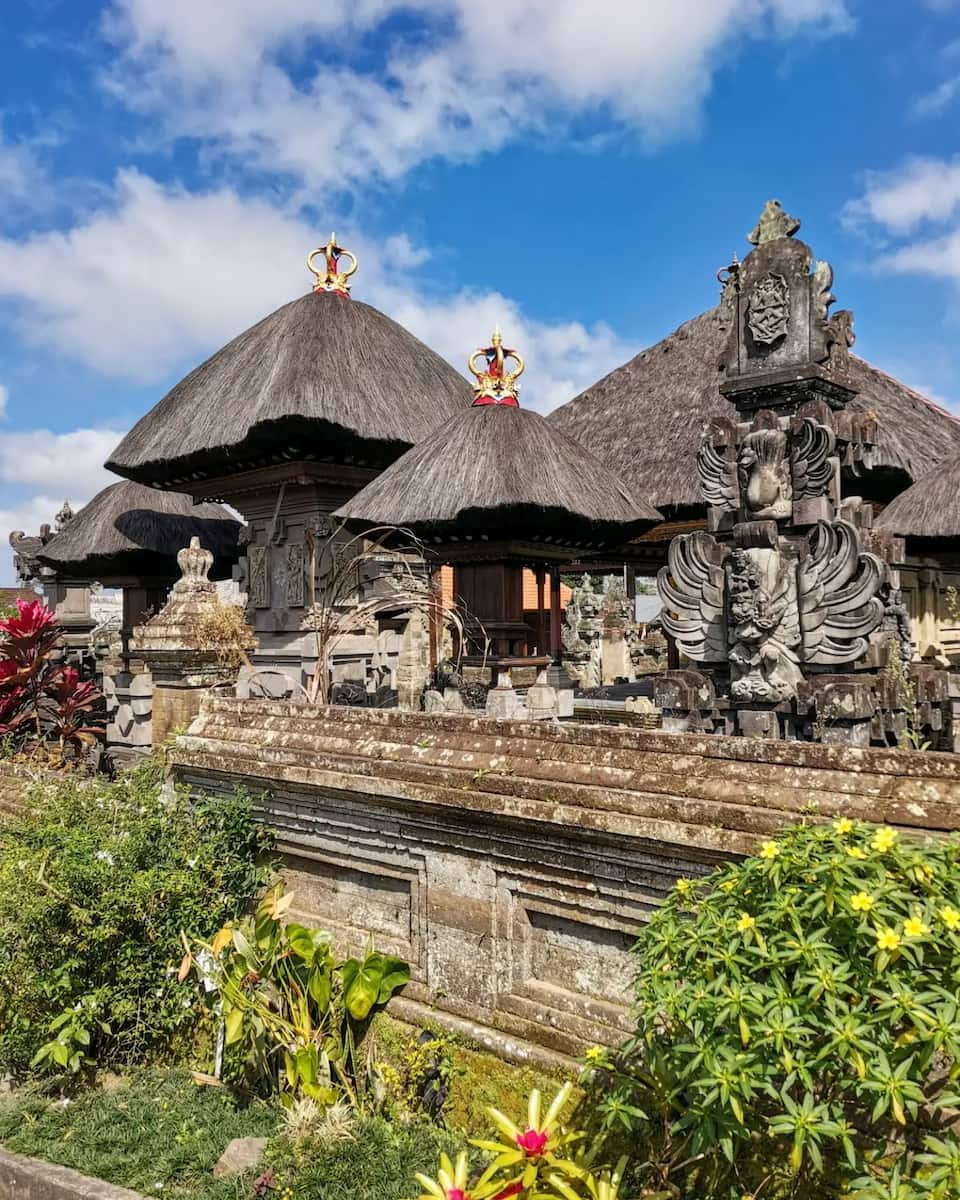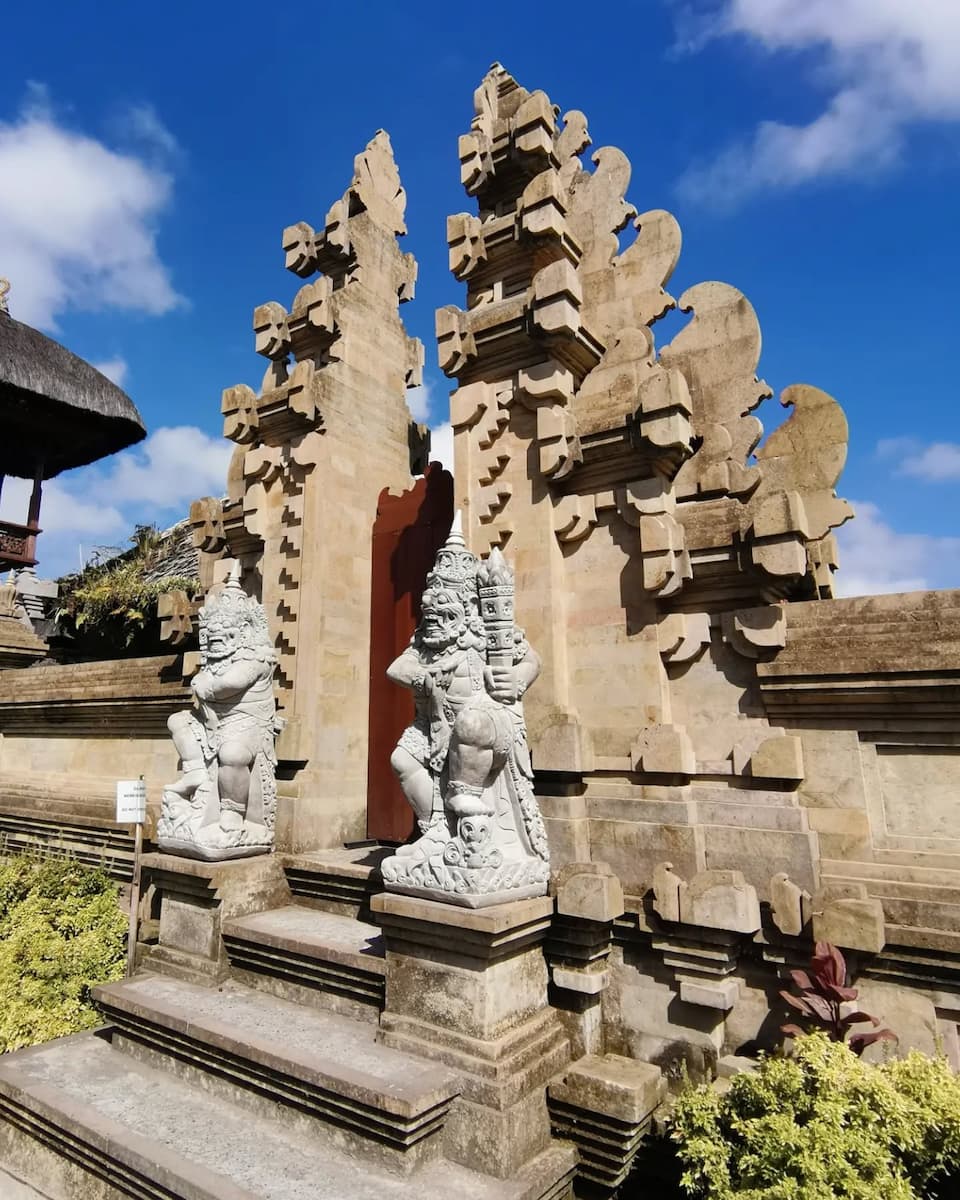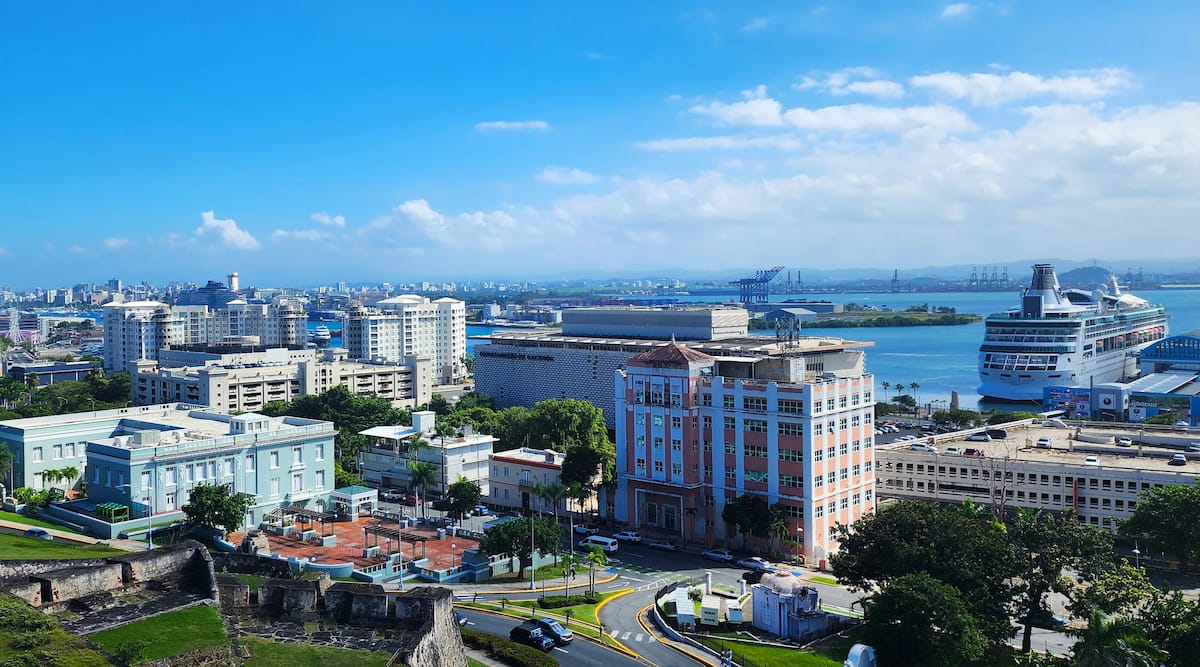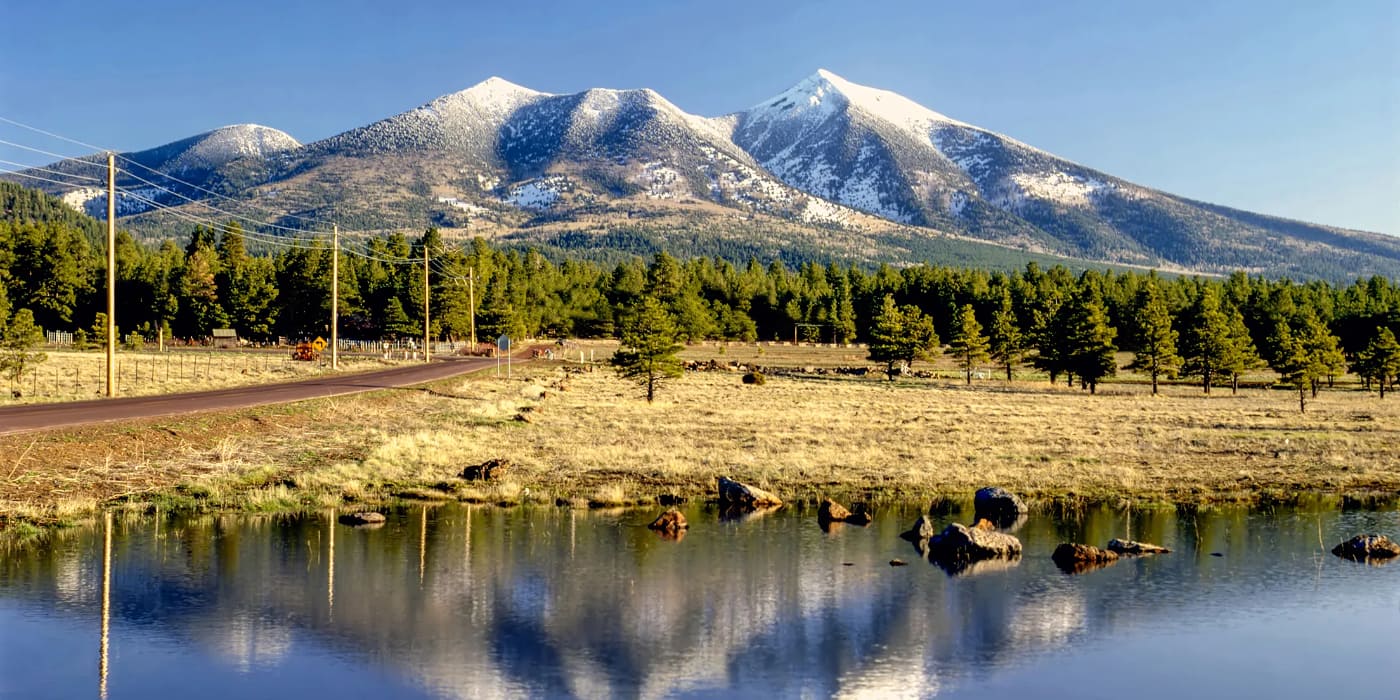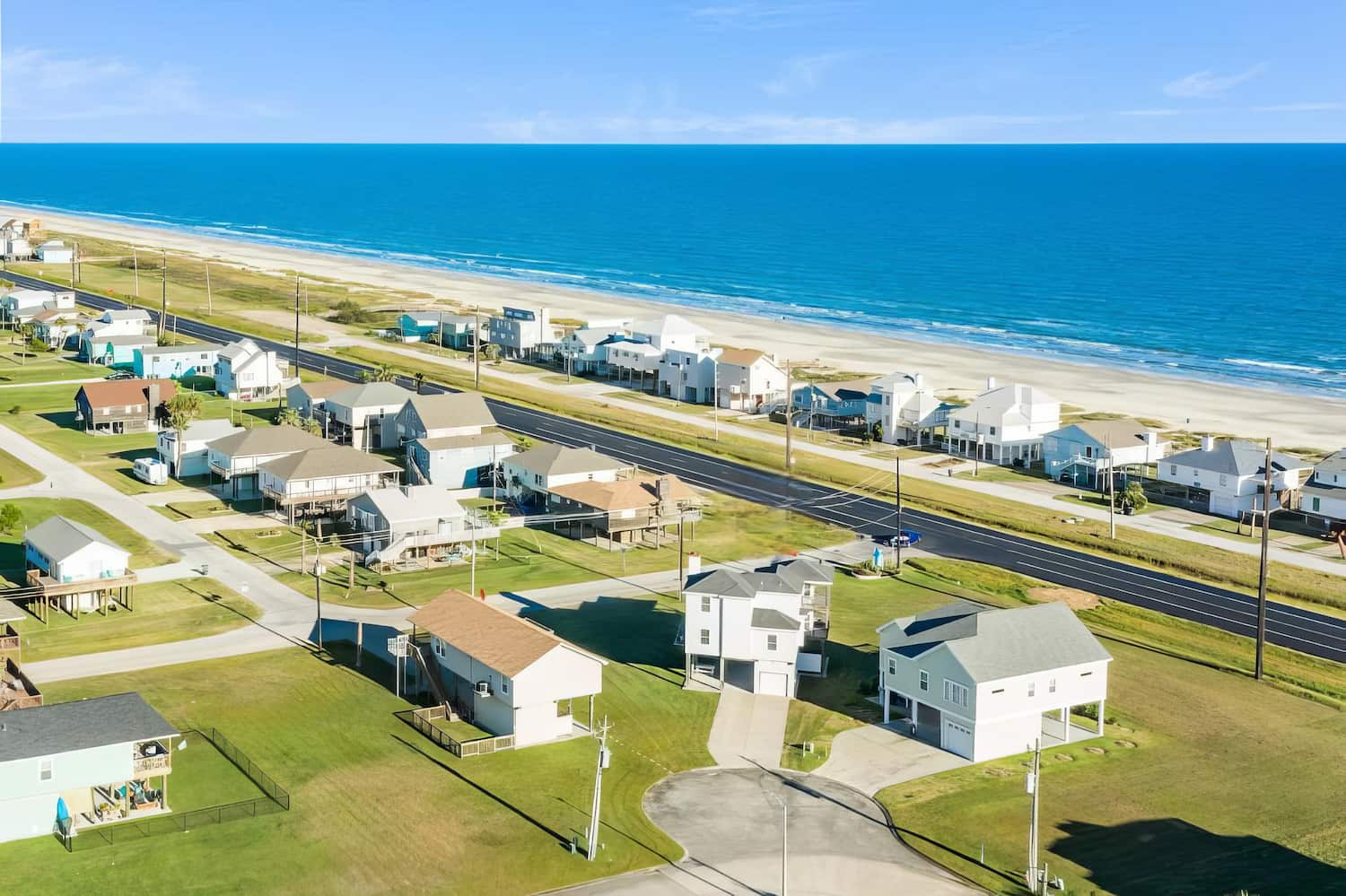Dreaming of Bali? You’re in the right place. In this travel guide, I’ll share everything you need to know before your visit — no fluff, just real tips from someone who’s wandered the island’s jungles, sipped coconut water in tiny warungs, and watched the sun rise over emerald-green rice terraces. You’ll find the best places to visit, can’t-miss activities, my favorite eats, and plenty of practical advice to help you plan the Bali trip you’ve always imagined.
Bali isn’t just a destination — it’s a mood. Picture yourself exploring ancient temples shrouded in morning mist, hiking to hidden waterfalls, or relaxing in a cliffside café as the sky turns gold. Whether you’re chasing adventure, culture, or pure relaxation, this guide will help you uncover the island’s unique atmosphere and flavors. Let’s explore Bali together — one unforgettable spot at a time.
🏠 Where to Stay in Bali
- 💎 Luxury Hotel: Purana Suite Ubud
- ✨ 5-Star: Amnaya Resort Nusa Dua
- 🏨 4-Star: Kuta Seaview Boutique Resort
- 🛏 3-Star: Grandmas Plus Hotel Seminyak
- 💸 Cheap: Suka Beach Inn
- 🏢 Apartament: Baliem Coliving
- 👨👩👧👦 For Families: The Sebali Penida Resort
- 🏩 For Couples: Radha Home Stay
💁 Best Guided Tours
- Private Sightseeing Tour: Ubud and Waterfall from €100 (⭐️5.0/5)
- Unique Day Trip to Nusa Penida by Boat from €100 (⭐️4.9/5)
- Amazing Day Trip to Nusa Penida: Land Tour & Snorkeling from €67 (⭐️4.8/5)
- Bali Instagram Tour: The Most Famous Spots from €54 (⭐️4.9/5)
- Quad Biking Bali with Transport and Lunch from €47 (⭐️4.9/5)
The Best 33 Things to Do in Bali
1. Monkey Forest Ubud
Wild Encounters. When I first stepped into the Monkey Forest Ubud — locally known as Mandala Suci Wenara Wana — the air was thick with the sounds of rustling leaves and chattering macaques. This sanctuary, right in the heart of Ubud, is home to over a thousand Balinese long-tailed monkeys, split into different family groups that roam freely among the ancient trees and mossy statues. The forest itself is a lush, green oasis, covering about 10 hectares and sheltering more than 180 species of trees.
Sacred Spaces. The Monkey Forest isn’t just about monkeys. It’s also a deeply spiritual place, with three ancient temples: Pura Dalem Agung Padangtegal, Pura Beji, and Pura Prajapati, each dating back centuries. Locals come here to pray and make offerings, and you’ll often see ceremonies in progress. The temples are off-limits to tourists unless you’re dressed for prayer, but even from the outside, the intricate stone carvings and the scent of incense create a sense of reverence. I always remind myself to dress modestly and keep noise to a minimum — this is a living, breathing part of Balinese culture.
Practical Details.Getting to the Monkey Forest is easy if you’re staying in Ubud. It’s just a 15-minute walk from Ubud Palace, or you can hop on a scooter, take a taxi, or even cycle in from nearby areas. If you’re coming from further afield, like Seminyak or Canggu, hiring a driver for the day is a good option. The sanctuary is open daily from 8:30 AM to 6:00 PM, but tickets are only sold until 5:30 PM. I recommend arriving early to avoid crowds and catch the monkeys at their most active.
| Ticket Type | Mon–Fri (IDR) | Sat–Sun (IDR) | USD (approx) | EUR (approx) |
|---|---|---|---|---|
| International Adult | 100,000 | 120,000 | $6.25–$7.50 | €5.75–€7 |
| International Child (3–12) | 80,000 | 100,000 | $5–$6.25 | €4.60–€5.75 |
⭐️ Best Activities
- Full-Day Guided Tour: Rice Terraces, Waterfall & More – Join a local guide for a 10-hour adventure through lush rice fields, refreshing waterfalls, and vibrant local markets. Enjoy hotel pick-up, all entrance fees included, and stories about the region’s rich traditions. Lunch is not included, but you’ll have plenty of tasty options along the way. Cancel or reschedule for free up to 24 hours before your tour.
2. Pura Luhur Uluwatu Temple
Cliffside Wonder. Standing on the edge of the cliffs at Pura Luhur Uluwatu Temple, I felt the wind whip in from the Indian Ocean, carrying the scent of salt and frangipani. This sacred site is perched 70 meters above the crashing waves, making it one of the most dramatic temple settings in all of Bali. The sweeping views are breathtaking — on a clear day, you can see the endless blue horizon and watch surfers catching waves far below. The temple itself, with its traditional Balinese architecture and ancient stone gates, is believed to protect the island from negative spirits and is one of Bali’s nine directional temples.
Ceremonies and Kecak Dance. Uluwatu isn’t just about the scenery — it’s alive with culture and spirituality. I watched as locals in colorful sarongs brought offerings to the shrines, the air thick with incense and the sound of gamelan music. The real highlight, though, comes at sunset. The famous Kecak dance performance begins as the sky turns gold and orange, with dozens of performers chanting and moving in rhythm around a blazing fire. The energy is electric, and the backdrop of the sun dipping into the ocean makes it unforgettable. If you want a good seat, arrive early — tickets for the dance often sell out.
Practical Details. Getting to Uluwatu Temple is straightforward from most parts of southern Bali. I usually recommend hiring a driver, as public transport is limited. The journey from Kuta or Seminyak takes about 1–1.5 hours, depending on traffic. The temple is open daily from 7:00 AM to 7:00 PM, but the busiest time is just before sunset. Sarongs and sashes are provided free at the entrance, and wearing them is required for everyone. The grounds are large and involve lots of stairs, so comfortable shoes are a must.
| Ticket Type | Price (IDR) | USD (approx) | EUR (approx) |
|---|---|---|---|
| Adult (International) | 50,000 | $3.25 | €3 |
| Child (International) | 30,000 | $2.00 | €1.85 |
| Kecak Dance (all ages) | 150,000 | $9.75 | €9 |
⭐️ Best Activities
- Uluwatu Sunset, Kecak Dance & Dinner in Jimbaran – Experience a magical sunset, a dramatic fire dance, and a delicious seafood feast on the bay. A classic evening of local flavor, culture, and unforgettable views.
3. Tegallalang Rice Terraces
First Impressions. When I arrived at Tegallalang Rice Terraces, I was greeted by a patchwork of green, layered rice fields that seemed to ripple down the hillside. The air felt cool and fresh, filled with the scent of wet earth and the gentle hum of insects. Local farmers in wide-brimmed hats moved quietly among the paddies, their reflections shimmering in the water. The landscape is not only beautiful but alive, with the sounds of birds and the distant splash of irrigation channels.
Exploring the Rice Fields. Walking the narrow paths between the terraces, I discovered more than just scenery. There are multiple entry points, but I recommend starting at the Abian Desa side for fewer crowds and easier parking. The trails can be steep and a bit slippery, especially after rain, so sturdy footwear is a must. Along the way, you’ll pass small shrines, bamboo bridges, and even farmers selling fresh coconuts. For thrill-seekers, the Swing and sky bike offer a unique way to see the terraces from above.
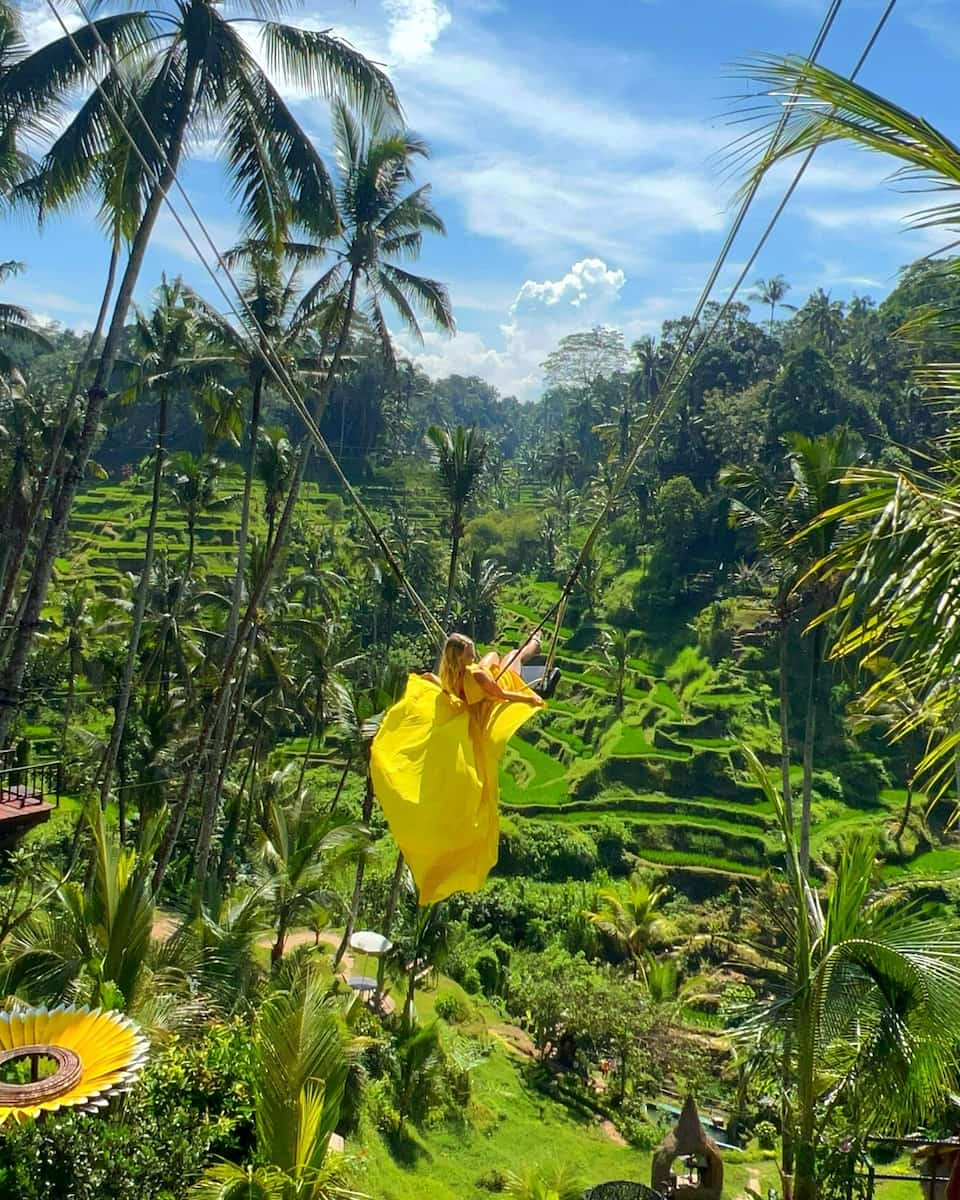
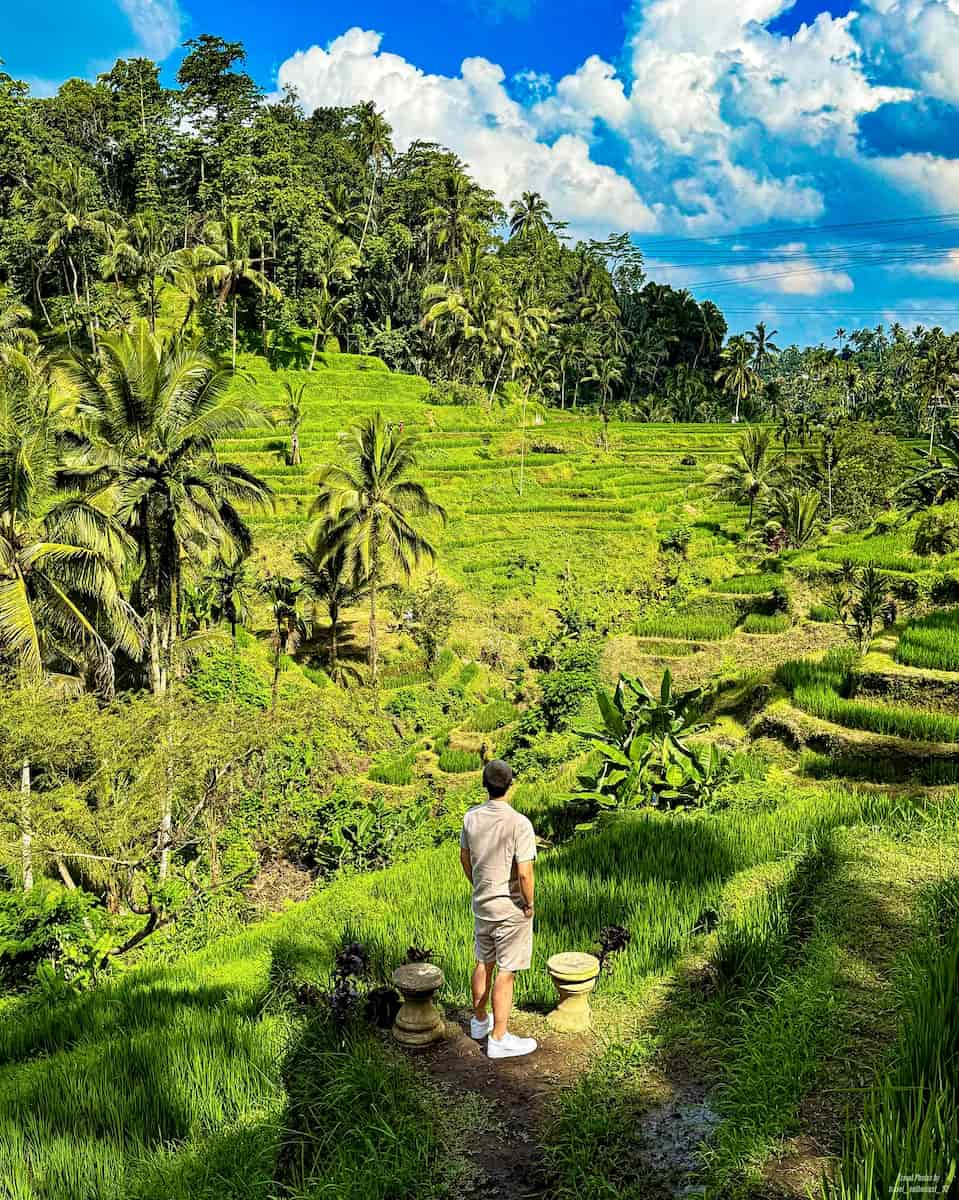
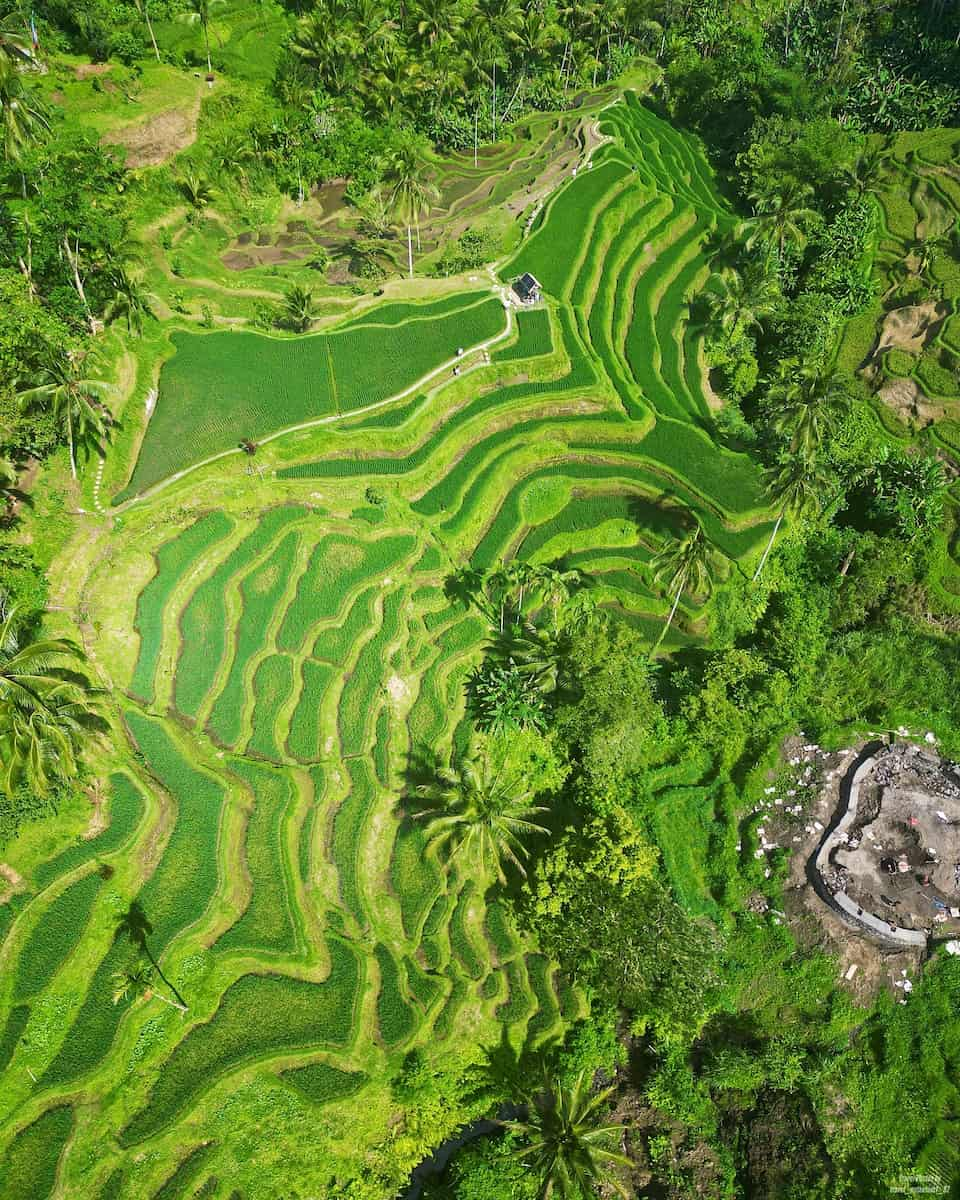
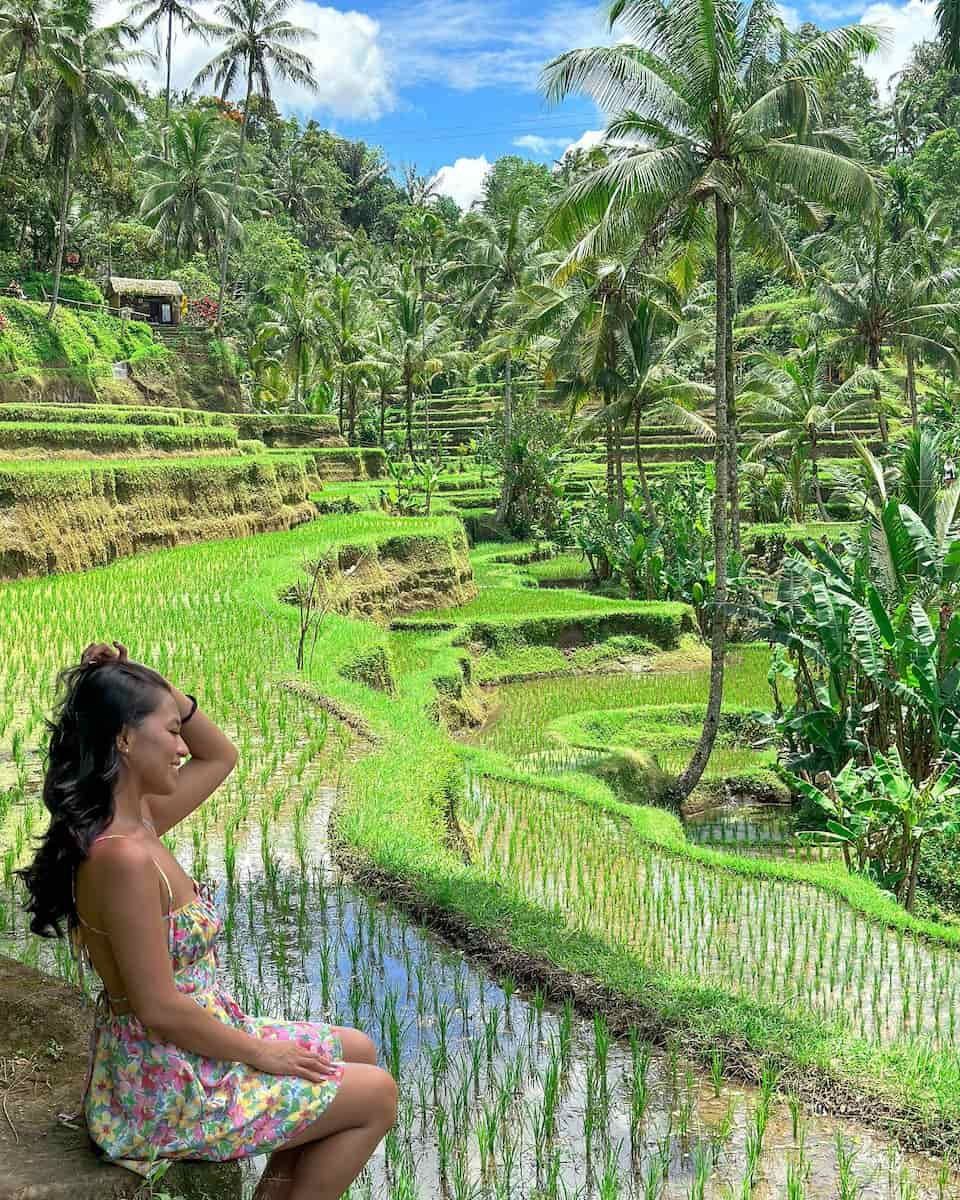
Top Activities:
- Take panoramic photos from the main viewpoint
- Try the famous Bali Swing for a rush of adrenaline
- Walk the side paths for peaceful, hidden views
- Watch local farmers at work and learn about rice planting
- Enjoy a fresh coconut or local snack from a roadside stall
| Activity | Price (IDR) | USD (approx) | EUR (approx) |
|---|---|---|---|
| Entrance Fee | 25,000 | $1.50 | €1.50 |
| Single Swing | 200,000 | $13 | €12 |
| Tandem Swing | 400,000 | $26 | €24 |
| Sky Bike | 450,000 | $29 | €27 |
| Zipline | 350,000 | $23 | €21 |
⭐️ Best Activities
- eBikes Tour to Tegallalang Rice Terrace – Glide through the countryside on an e-bike, visit a local home, and enjoy a tasty lunch overlooking green fields. Perfect for those who want a gentle ride, local insights, and plenty of photo stops.
4. Tanah Lot Temple
Arrival and Setting. When I reached Tanah Lot, the sound of waves crashing against the rocks filled the air, and the scent of saltwater mixed with incense from nearby offerings. This iconic landmark sits dramatically on a rocky outcrop along Bali’s west coast, about 20 kilometers from Denpasar and easily reached by car or taxi. The approach leads you through a lively market filled with local vendors selling everything from batik sarongs to wood carvings and Balinese snacks. The walk from the parking area to the main viewpoint takes about 10–15 minutes, and the path can be uneven near the shoreline, so comfortable shoes are a must.
Exploring the Grounds. Tanah Lot is not just a visual spectacle — it’s a spiritual site deeply woven into Balinese culture. The temple itself is reserved for worshippers, but the surrounding area is open to all. I wandered past intricately carved stone gates, shrines decorated with fresh flowers, and statues of Hindu deities. The temple’s silhouette against the sea is especially striking during high tide, when it appears to float above the water. At low tide, visitors can walk across the rocks to the base, feeling the cool spray of the ocean and getting a closer look at the temple’s foundations.
Unique Features and Activities. A few highlights make Tanah Lot stand out among Bali’s highlights:
- Holy Snake Cave: Near the temple, you’ll find a small cave where sacred black-and-white sea snakes live. Locals believe these snakes, known as Naga Basuki, protect the temple from harm. Visitors are sometimes invited to see the snakes up close for good luck.
- Spring of Holy Water: At the base of the rock, a freshwater spring emerges. Many Balinese come here to collect the water, believing it has purifying properties.
- Batu Bolong Temple: Just a short walk away, this smaller temple sits on a natural rock arch over the sea, offering peaceful views and a quieter atmosphere.
Entrance Fees and Costs. It’s important to plan your budget before visiting. Here’s a handy table with current prices:
| Visitor Type | Age Group | Entrance Fee (IDR) | USD (approx) | EUR (approx) |
|---|---|---|---|---|
| International Adult | Over 10 years | 75,000 | $4.85 | €4.50 |
| International Child | 5–10 years | 40,000 | $2.60 | €2.40 |
| Domestic Adult | Over 10 years | 30,000 | $1.95 | €1.80 |
| Domestic Child | 5–10 years | 20,000 | $1.30 | €1.20 |
| Kecak Dance Ticket | All ages | 100,000 | $6.50 | €6 |
⭐️ Best Activities
- Hidden Canyon, Balitofia Park & Flamingo Club Tour – Discover hidden canyons, splash in water parks, and chill at a stylish club. This day out is packed with adventure, laughs, and plenty of photo moments!
5. Tegenungan Waterfall
Arrival and Setting. Tegenungan Waterfall sits in the lush village of Kemenuh, Gianyar, about a 30-minute drive from Ubud. The journey winds through scenic countryside, past rice paddies and small Balinese villages. Once I arrived, I found a large parking area (IDR 5,000 for cars), with the entrance fee collected at a booth nearby. The path to the waterfall is well-marked and involves descending a series of stone steps, flanked by souvenir shops and small cafes. The sound of rushing water grows louder with each step, building anticipation for the view below.
The Main Attraction. At the base, Tegenungan reveals itself in full force — a 15-meter cascade pouring into a wide natural pool surrounded by dense jungle. The air is cool and misty, and the roar of the falls drowns out any city noise. I was struck by how clear the water looked during dry months, though after rainfall it can turn brown and fast-moving. Many visitors, myself included, can’t resist wading or swimming in the pool. The rocks are slippery, so I moved slowly and kept my belongings in a dry bag. There are designated swimming areas for safety, and lockers are available for rent near the entrance.
| Fee Type | Price (IDR) | USD (approx) | EUR (approx) |
|---|---|---|---|
| Adult Entrance | 20,000 | $1.30 | €1.20 |
| Child Entrance | 10,000 | $0.65 | €0.60 |
| Parking (car) | 5,000 | $0.33 | €0.30 |
| Locker Rental | 10,000 | $0.65 | €0.60 |
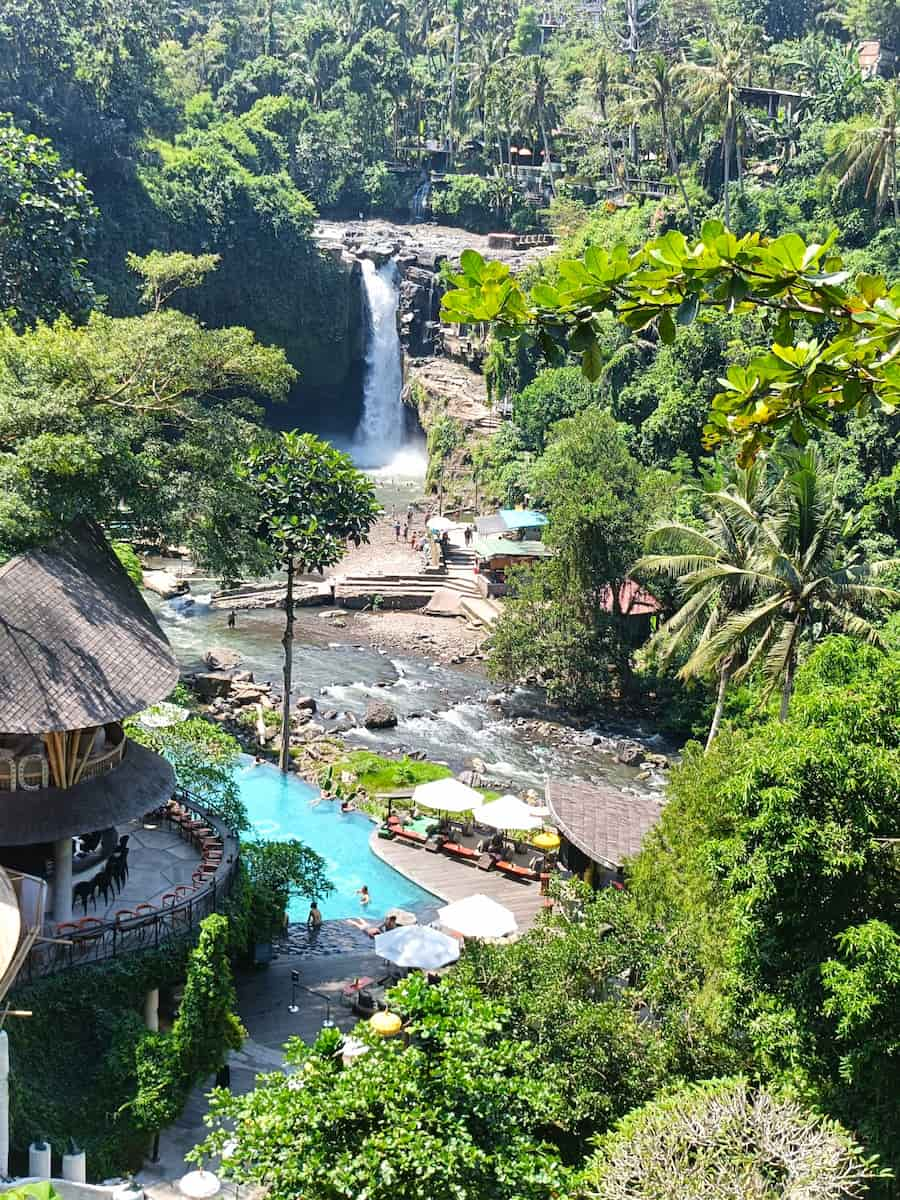
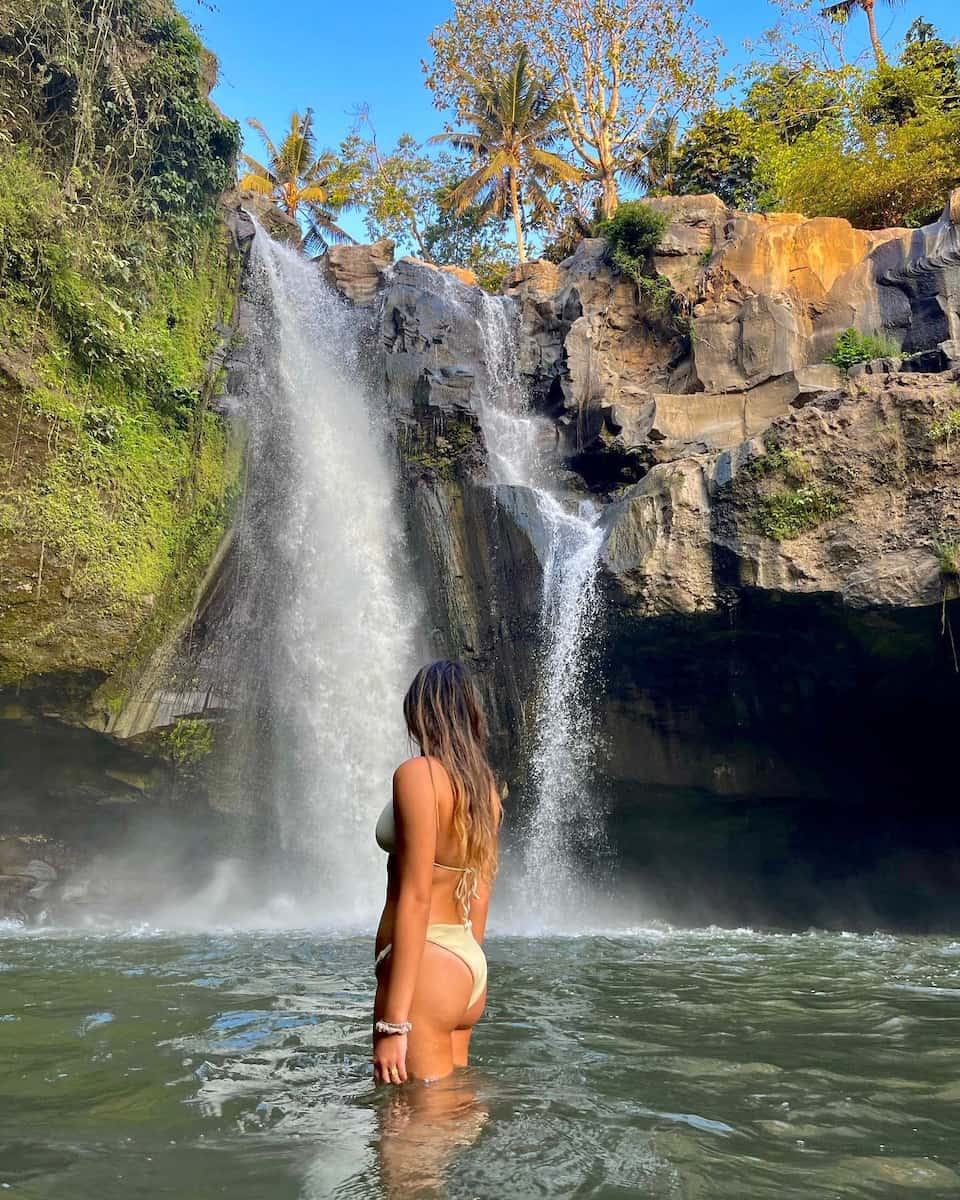
What to Bring:
- Sturdy shoes or sandals (the steps and rocks can be slippery)
- Change of clothes and towel
- Waterproof bag for electronics
- Small cash for entrance, parking, and snacks
Mistakes to Avoid. Tegenungan is sometimes used for local ceremonies. I always respect any offerings or spiritual activities I see — stepping around them and keeping noise to a minimum. Swimming is allowed, but cliff jumping is not recommended due to shallow water and hidden rocks. Many travelers forget to bring cash, but cards are rarely accepted for entrance or snacks.
⭐️ Best Activities
- Private Tour: Ubud Highlights, Waterfall & Rice Fields – Enjoy a full-day journey with a friendly local guide, exploring lush rice terraces, dramatic waterfalls, and vibrant art villages. Door-to-door hotel pickup, custom stops, and plenty of time for photos make this a perfect introduction for first-timers or anyone wanting a relaxed, flexible day out.
6. Pura Besakih (Mother Temple)
Setting and Arrival. Reaching Pura Besakih, often called the Mother Temple, is an adventure in itself. The drive from Ubud or Denpasar takes you through winding roads and lush countryside, with glimpses of Mount Agung’s peak rising above the clouds. The temple complex sits on the mountain’s southwestern slope, making it one of the most scenic spots in eastern Bali. Upon arrival, I parked in the main lot (IDR 10,000 for cars, IDR 5,000 for scooters) and followed the path lined with local vendors selling sarongs, snacks, and souvenirs. The air felt cooler and fresher up here, a welcome change from Bali’s lower regions.
Exploring the Complex. Pura Besakih is not just a single structure but a vast network of 23 temples spread across parallel ridges. The main temple, Pura Penataran Agung, stands out with its towering meru (multi-tiered shrines), intricate stone carvings, and the grand split gateway known as kori agung. My guide explained that each section serves a unique purpose, honoring different Hindu deities and ancestors. Walking the complex involves plenty of stairs and long paths, so comfortable shoes are essential. The entrance fee (IDR 150,000 for international visitors, about $10/€9) includes a sarong and sash, a local guide, and a one-time electric vehicle transfer up the hill.
| Category | Fee (IDR) | USD (approx) | EUR (approx) |
|---|---|---|---|
| International Visitor | 150,000 | $10 | €9 |
| Local Visitor | 80,000 | $5.25 | €4.80 |
| Car Parking | 10,000 | $0.65 | €0.60 |
| Scooter Parking | 5,000 | $0.33 | €0.30 |
What to Do:
- Explore Pura Penataran Agung, the main sanctuary with its eleven-tiered meru
- Visit smaller temples like Pura Batu Madeg and Pura Kiduling Kreteg
- Photograph the panoramic views of the valley and Mount Agung
- Watch or participate in a ceremony if your timing is right
- Chat with your guide — they’re included in the ticket and full of stories
⭐️ Best Activities
- Besakih Mother Temple Full-Day Tour with Lunch – Journey through lush hills and quiet villages to the island’s most sacred site, known as the “Mother Temple.” Enjoy stops at Kerta Gosa, Jambul Hill, and a waterfall, with a tasty Indonesian lunch included. Friendly guides, flexible hotel pickup, and plenty of time for photos make this a rewarding and relaxed day out.
7. Pura Tirta Empul
Setting and Arrival. Pura Tirta Empul is nestled in the lush highlands of Tampaksiring, just north of Ubud. The entrance is marked by a grand split gate called candi bentar, decorated with stone carvings of mythological figures. I paid the entrance fee — IDR 75,000 for adults, IDR 50,000 for children (about $5/€4.50 and $3.30/€3) — and received a sarong, which everyone must wear inside. The temple grounds are peaceful, with koi ponds, tropical gardens, and the soft sound of water flowing from the sacred spring.
Architecture and Layout. The temple is a masterpiece of traditional design, divided into three main courtyards. The outer courtyard (Jaba Pura) is a transition zone, with a wantilan pavilion for gatherings and a tranquil koi pond. The central courtyard (Jaba Tengah) is the heart of the complex, home to two large purification pools fed by 30 holy water spouts. Each spout has a unique spiritual meaning, and the sequence of fountains guides visitors through the Melukat ritual. The inner sanctum (Jeroan) is the holiest area, housing shrines and the original spring. Only worshippers may enter this final section, but its atmosphere of devotion is felt throughout the grounds.
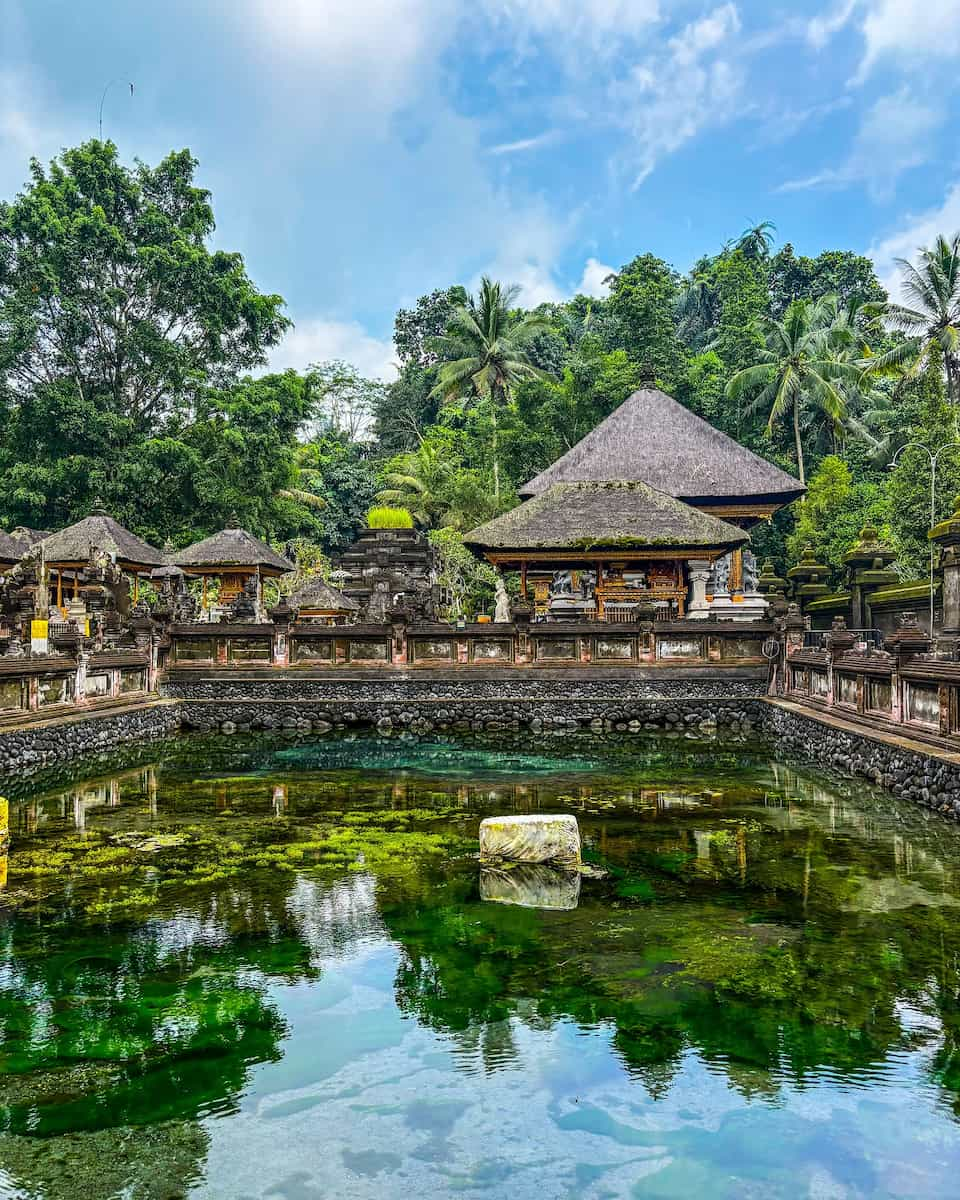
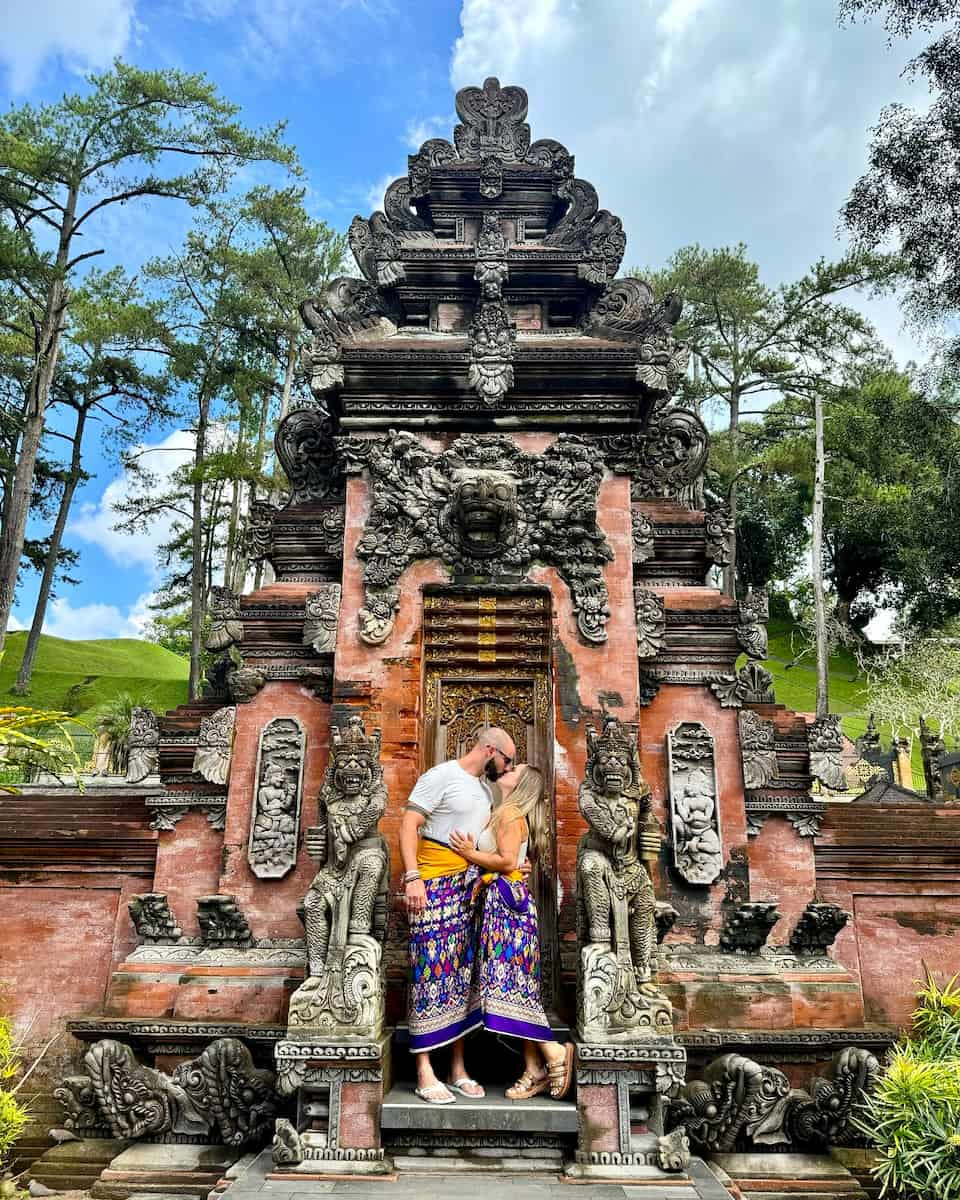
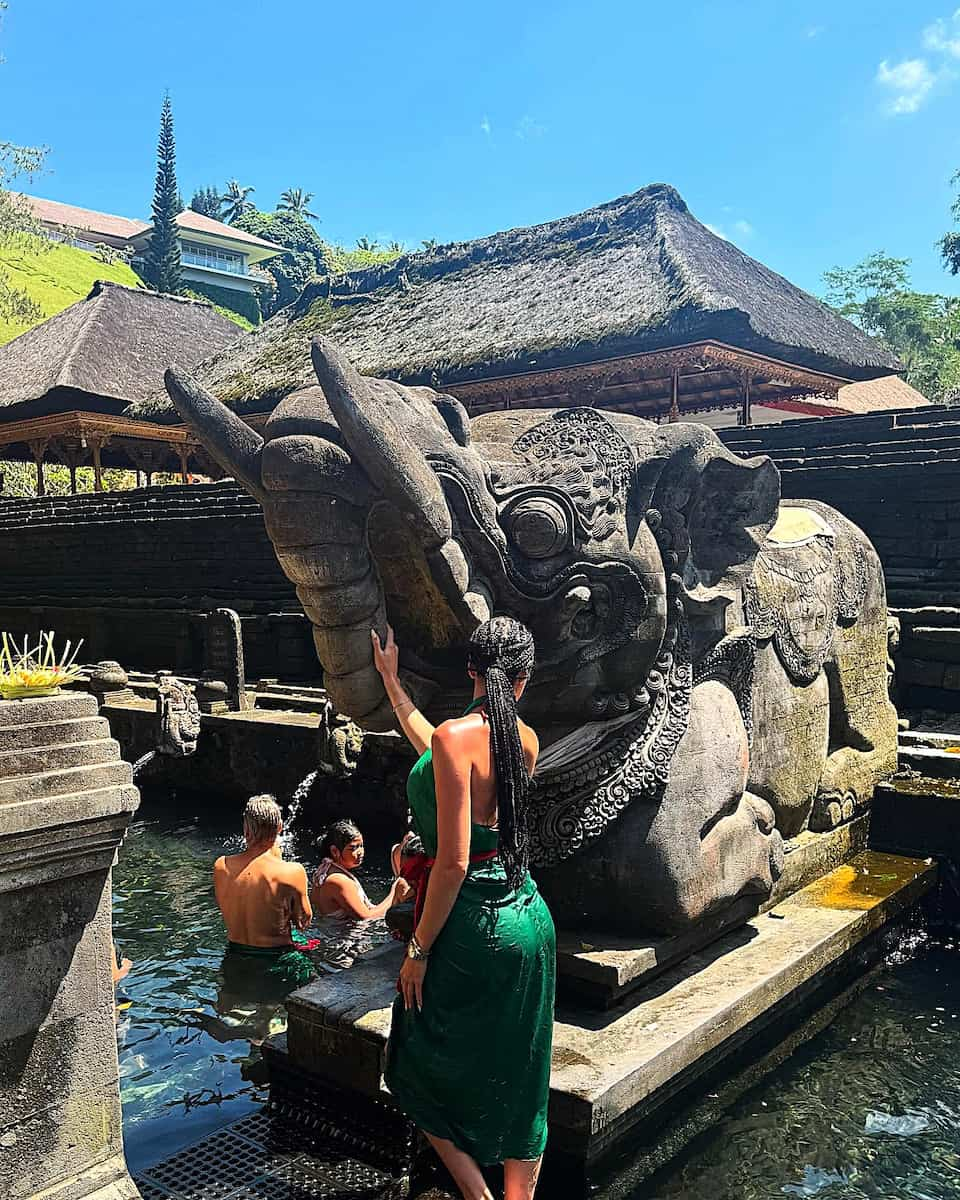
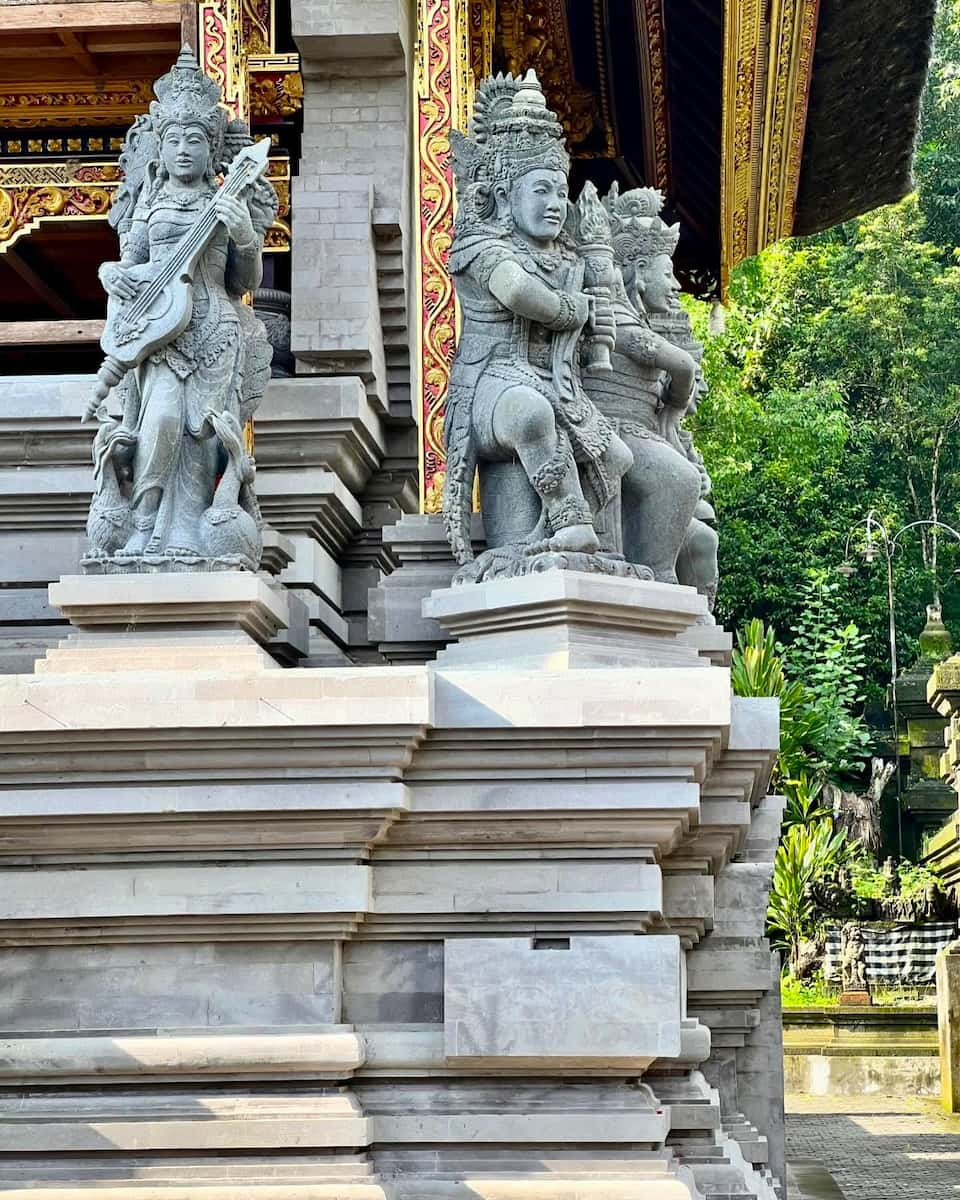
Spiritual Rituals and Meaning. Tirta Empul is famous for its Melukat purification ceremony. I joined locals and travelers in the central pools, moving from spout to spout, bowing my head under each stream. The water was crisp and cool, and the ritual felt both grounding and uplifting. Each fountain is believed to wash away a different kind of negativity — some for cleansing the soul (Tirta Sudamala), others for granting strength or removing bad luck (Tirta Penglukatan, Tirta Panegtegan). A couple of spouts are reserved for Hindu death rituals, so it’s important to follow the order and guidance from temple staff.
Ticket Table
| Ticket Type | Price (IDR) | USD (approx) | EUR (approx) |
|---|---|---|---|
| Adult | 75,000 | $5 | €4.50 |
| Child (5–12) | 50,000 | $3.30 | €3 |
| Under 5 | Free | Free | Free |
Cultural Significance and Legends. According to Balinese legend, the spring was created by the god Indra to save his warriors from poison during a battle with the demon king Mayadenawa. Indra struck the earth, and the holy water gushed forth, restoring life and symbolizing the victory of good over evil. The temple is dedicated to Vishnu, the Hindu god of water, and remains an active place of worship and ceremony. The sacred spring is also the source of the Pakerisan River, linking Tirta Empul to Bali’s UNESCO-recognized Subak irrigation system.
What to See and Do:
- Observe or join the Melukat purification ritual in the central pools.
- Admire the intricate stone carvings and traditional shrines.
- Stroll through the koi pond and gardens in the outer courtyard.
- Watch for ceremonies and offerings, especially during festivals.
- Visit the Bale Pepelik, a shrine dedicated to ancestral spirits.
⭐️ Best Activities
- Tirta Empul Holy Spring: Skip-the-Line Admission – Experience the magic of this ancient sanctuary, famous for its healing waters and purification rituals. Your ticket includes admission, a sarong, bottled water, and convenient hotel pickup options. Wander the tranquil courtyards, learn about local rituals, and soak up centuries of spiritual tradition. Recommended by 96% of travelers and wheelchair accessible, it’s a serene escape into the heart of local culture.
8. Tirta Gangga Water Palace
Royal Gardens and Setting. Tirta Gangga Water Palace sits in the hills of eastern Bali, near the village of Ababi and just a short drive from Karangasem. The complex is surrounded by lush gardens and offers sweeping views of Mount Agung in the distance. As I walked through the grand entrance, I was greeted by stone walkways that seemed to float across ponds filled with giant koi. The air was fresh and cool, and the sound of flowing water set a peaceful tone for the visit. The gardens are dotted with statues of mythological figures, fountains, and pavilions, making every corner a new discovery.
Pools, Fountains, and Stones. The highlight for many visitors is the chance to “walk on water” using the famous stepping stones that zigzag across the main koi pond. I loved watching the colorful fish gather near my feet, hoping for a handful of food (which you can buy at the entrance for about 5,000 IDR). The centerpiece of the palace is the towering 11-tiered fountain, surrounded by lush greenery and smaller pools. Each pool is fed by a sacred spring, and the water is believed to have purifying properties. The palace’s name itself means “water from the Ganges,” reflecting its spiritual significance for local people.
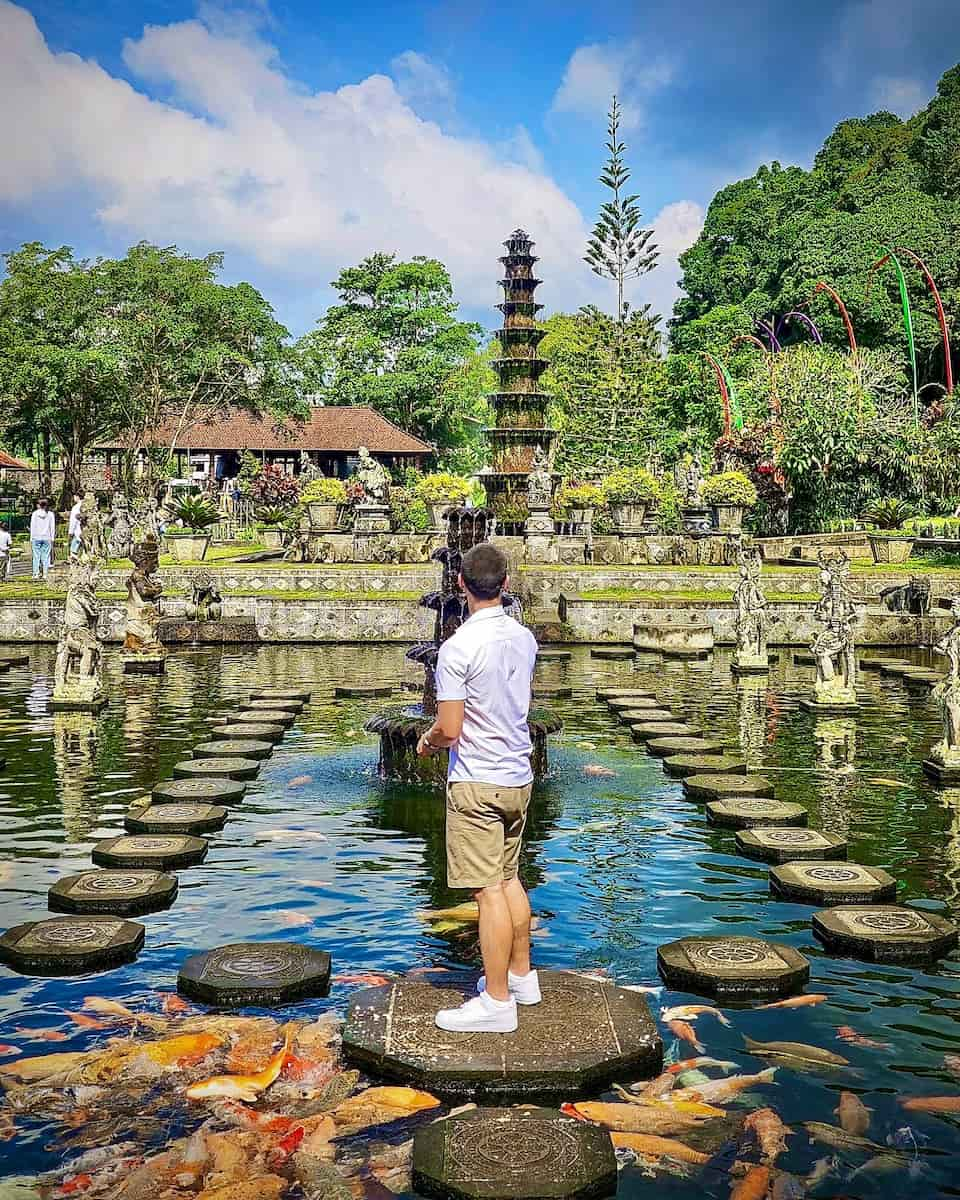
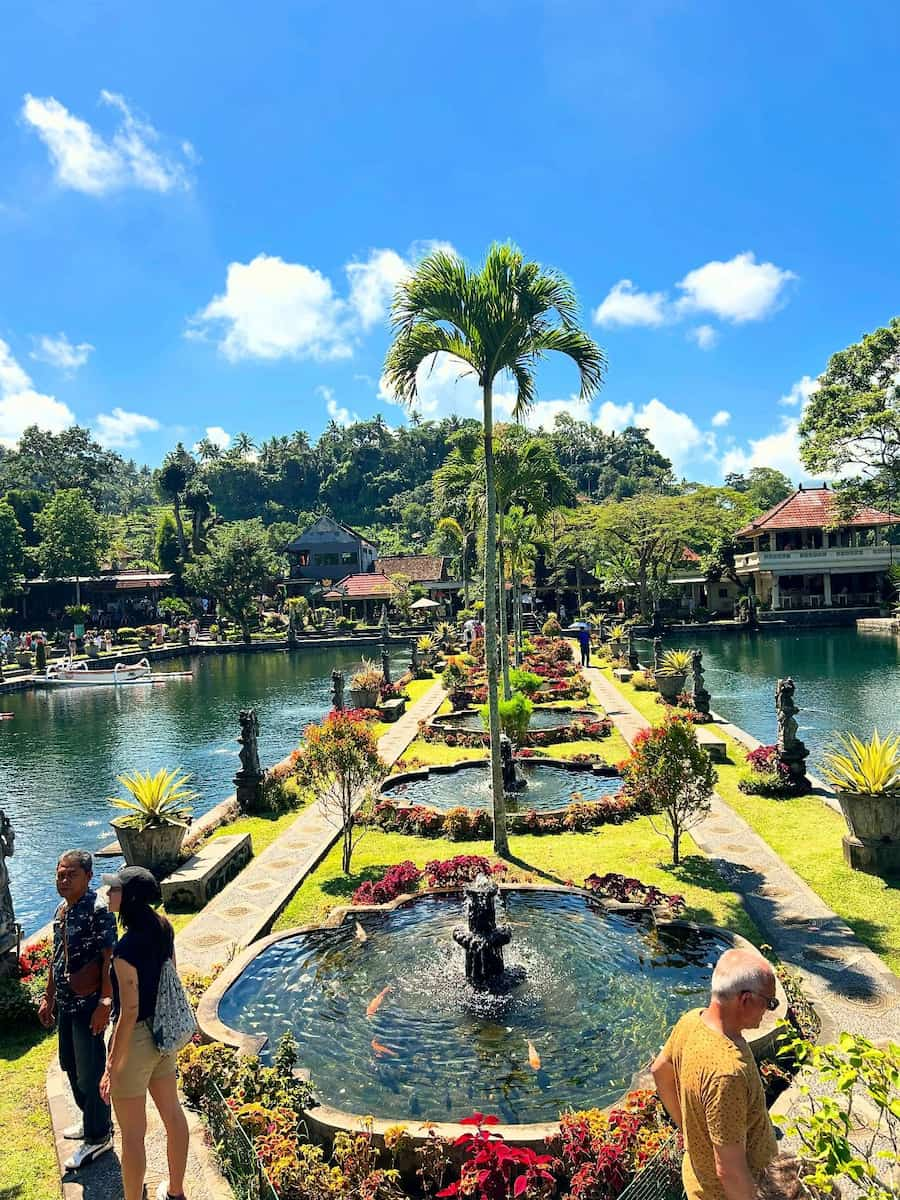
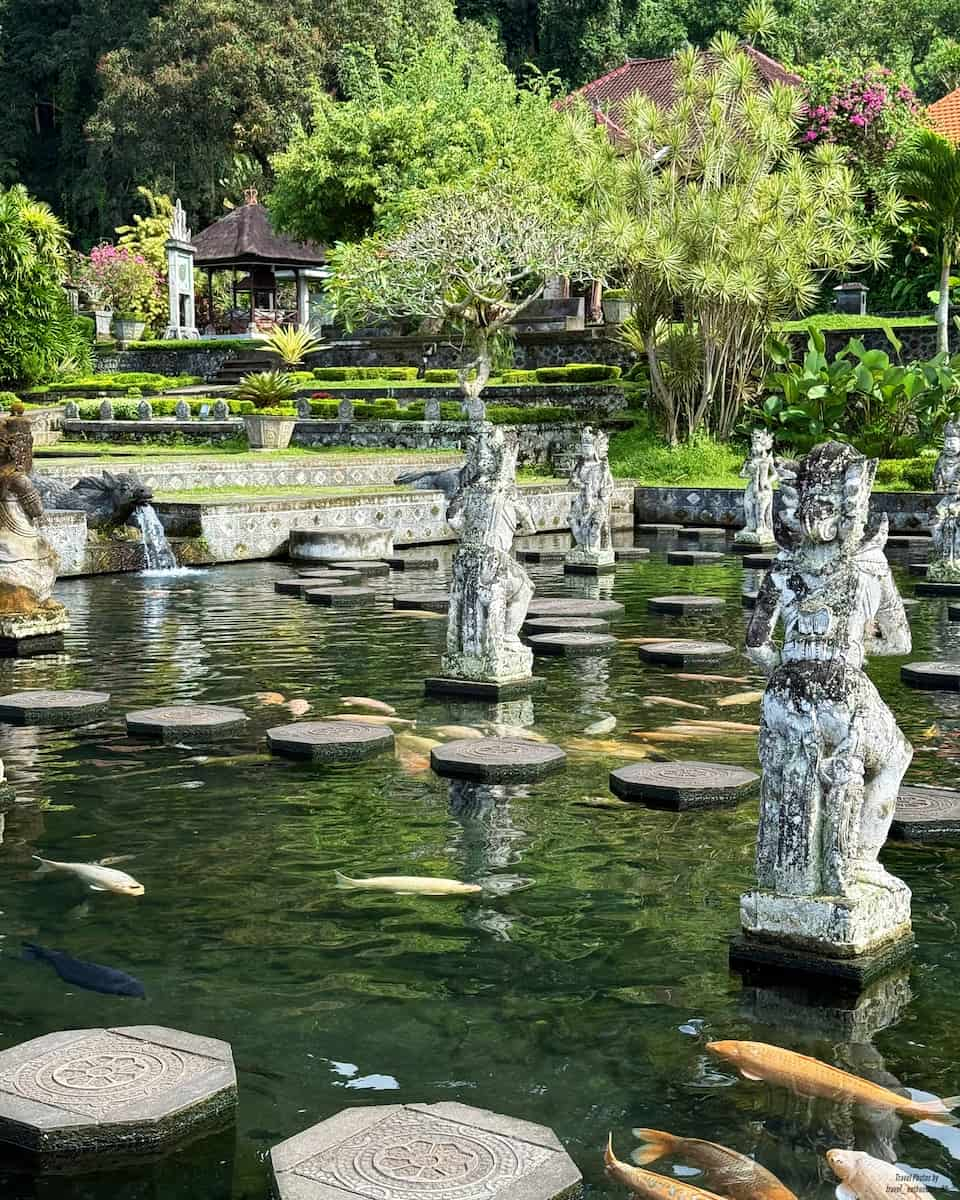
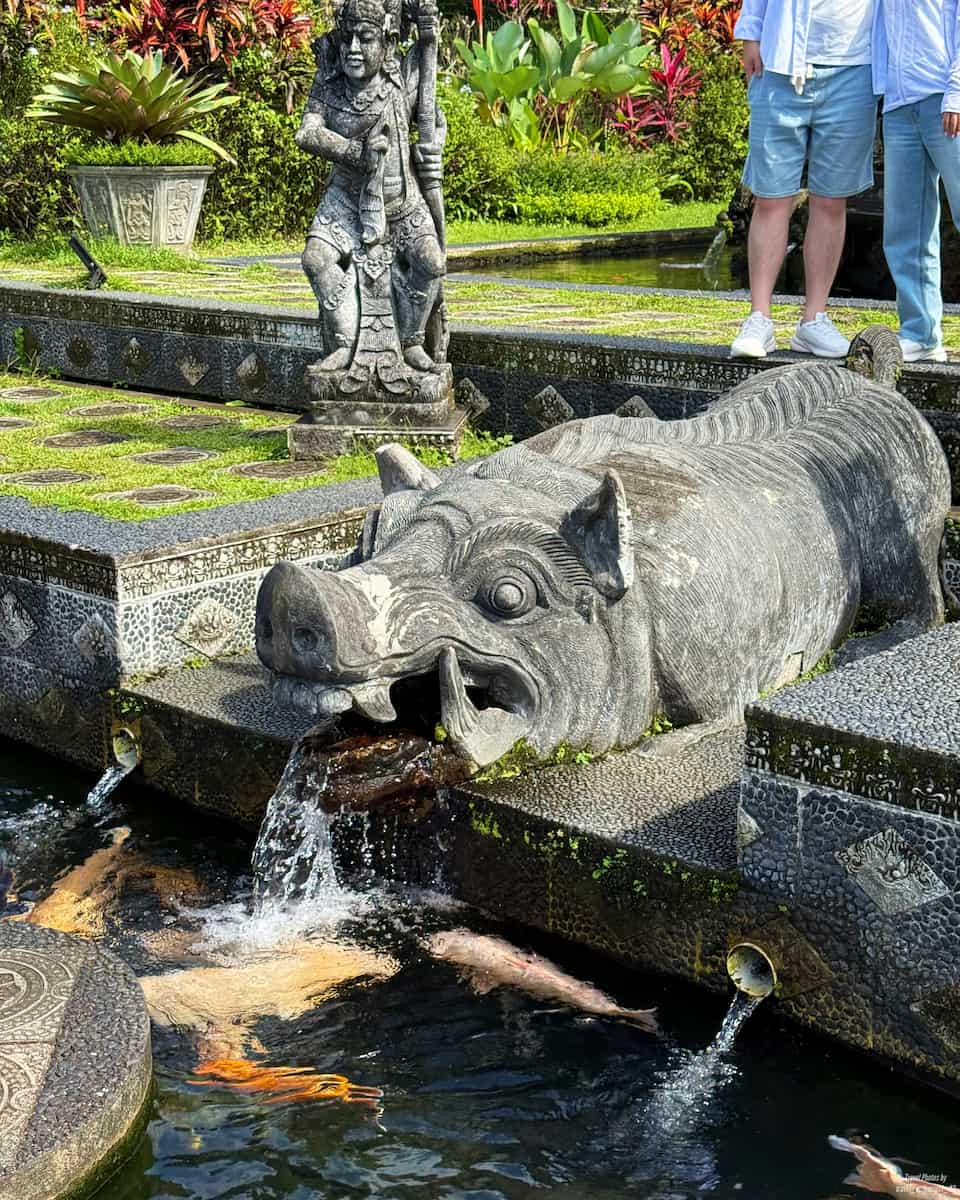
Swimming and Relaxation. One of my favorite experiences here was swimming in the royal pools. The water is chilly and incredibly clear, flowing straight from the spring. There are changing rooms and lockers available, and swimming costs an extra 20,000 IDR (about $1.40/€1.30) on top of the entrance fee. After a swim, I found a quiet spot by the water to relax and soak up the tranquil atmosphere. The gardens are perfect for a leisurely stroll, with plenty of shaded benches and grassy areas to rest.
| Ticket Type | Price (IDR) | USD (approx) | EUR (approx) |
|---|---|---|---|
| International Adult | 70,000–90,000 | $4.50–$6 | €4–€5.50 |
| International Child | 35,000–45,000 | $2.30–$3 | €2–€2.70 |
| Swimming Pool | 20,000 | $1.40 | €1.30 |
| Fish Food | 5,000 | $0.35 | €0.30 |
- Walk the stepping stones for iconic photos with the koi
- Swim in the spring-fed royal pool
- Feed the fish and watch them swarm near your feet
- Explore the gardens and hidden statues
- Enjoy lunch at Tirta Ayu Restaurant, which overlooks the main pond
⭐️ Best Activities
- Lempuyang & Tirta Gangga Water Palace Day Tour – Discover the legendary “Gates of Heaven” and wander through a royal water garden filled with koi ponds, fountains, and lush scenery. This day trip blends history, culture, and jaw-dropping photo moments in East Bali’s most enchanting landscapes.
9. Penataran Agung Lempuyang Temple
Journey and Location. Penataran Agung Lempuyang, known to many as the “Gates of Heaven,” sits high in the eastern part of Bali, near Karangasem. The drive winds through villages and forested hills, with Mount Agung often looming in the distance. I always suggest hiring a local driver or joining a tour, since the road is narrow and steep. Once at the base, visitors pay for a shuttle bus (IDR 50,000/$3.50/€3) to avoid a long uphill trek, and the entrance fee (IDR 100,000–150,000, or $7–$10/€6.50–€9) includes a sarong and the help of a local photographer for that iconic shot between the split gates.
Gates and Sacred Architecture. Standing between the famous split gates, I was awestruck by the view of Mount Agung framed perfectly in the background. The site is more than just a photo spot; it’s a collection of shrines, staircases, and pavilions spread across several levels. Each area is guarded by stone nagas and statues inspired by Hindu mythology. The main courtyard features tall meru towers and padmasana shrines, all surrounded by tropical forest and the soft sound of distant gamelan music.
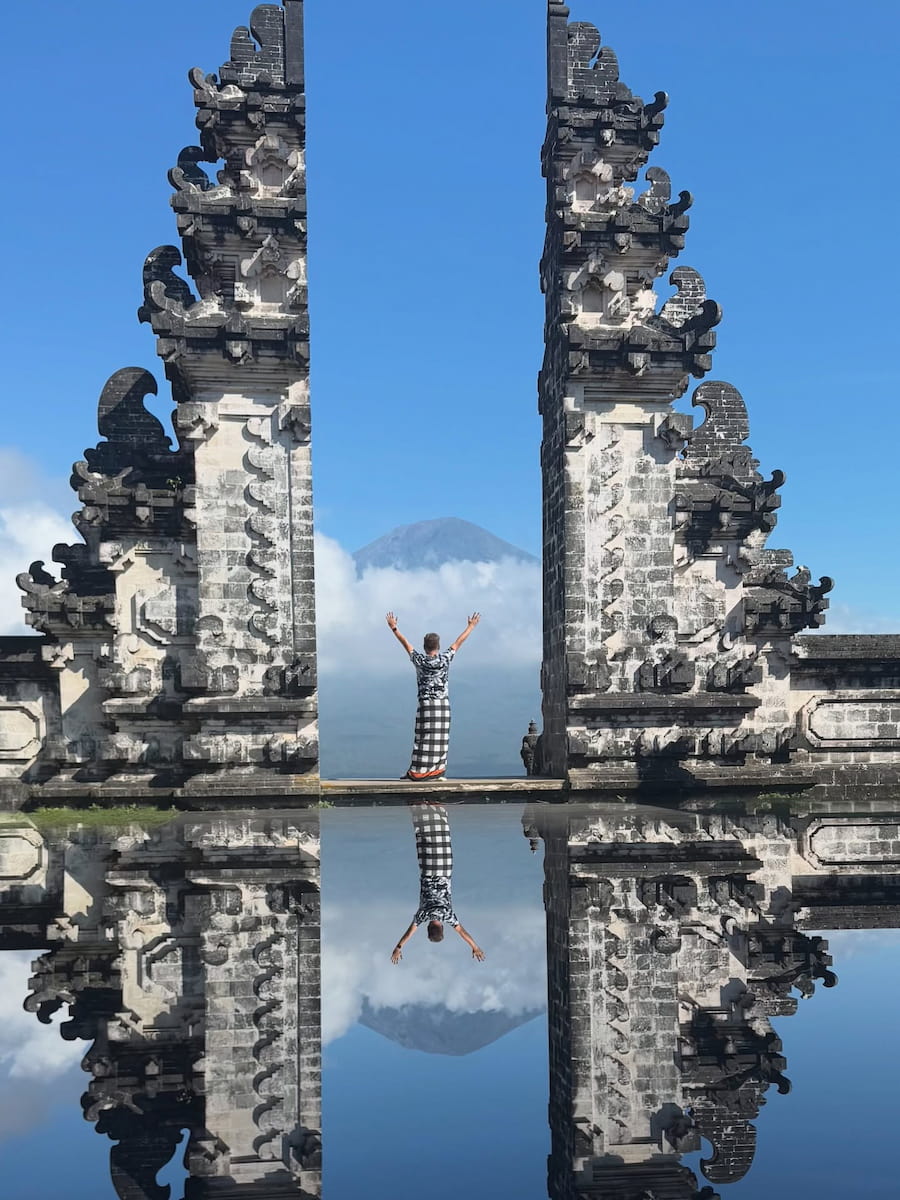
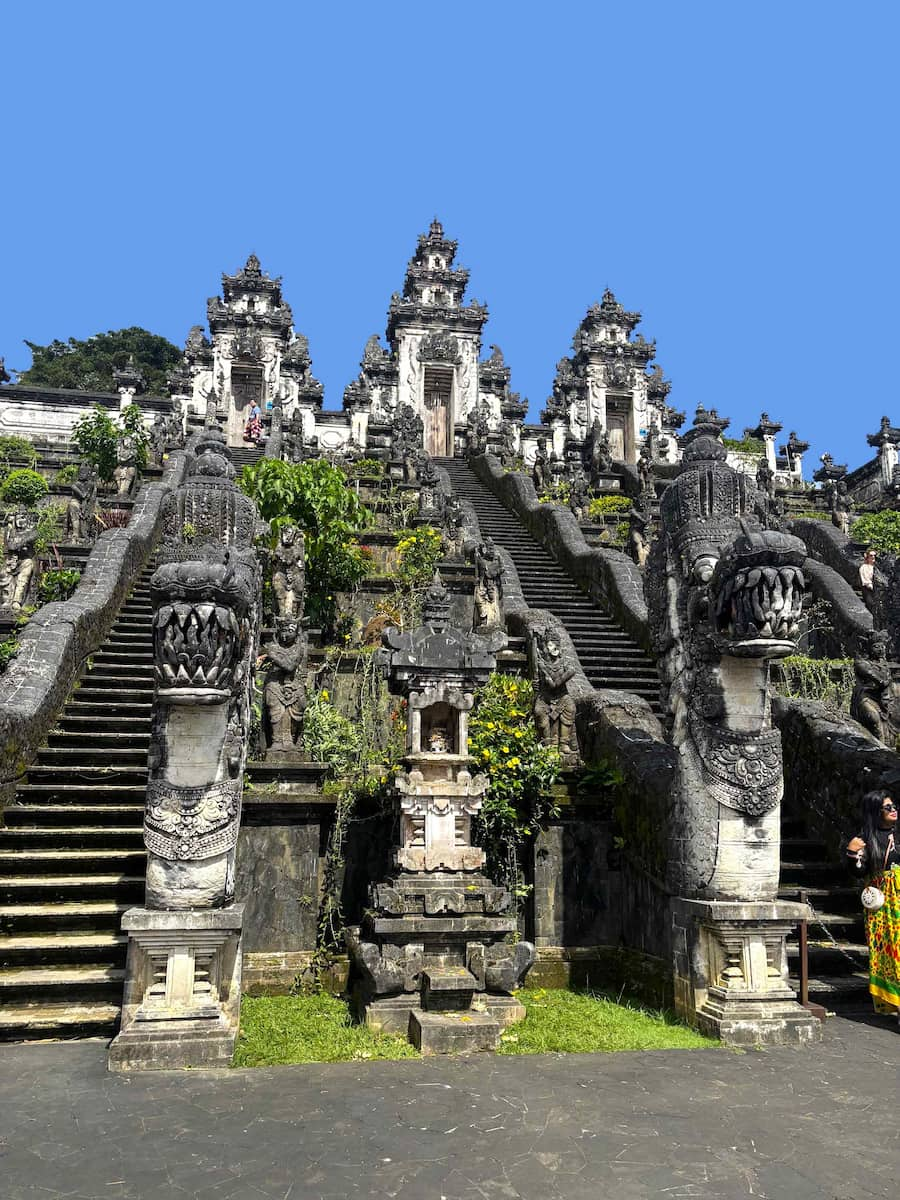
Spiritual Experience and Climb. Visiting Lempuyang is a journey of both body and spirit. The climb to the uppermost sanctuary involves more than 1,700 steps, winding through forest and past smaller shrines. Along the way, I passed worshippers carrying offerings and heard the gentle hum of prayers. The air grew cooler as I climbed, and the views became more spectacular with every step. For many, reaching the top is a moment of reflection and accomplishment.
What to See and Do:
- Take the famous photo at the Gates of Heaven with Mount Agung in the background
- Explore the lower shrines and admire intricate stone carvings
- Climb the steps to the upper sanctuaries for panoramic views
- Watch or join local ceremonies — Lempuyang is an active pilgrimage site
- Enjoy the peaceful gardens and surrounding forest
| Fee Type | Price (IDR) | USD (approx) | EUR (approx) |
|---|---|---|---|
| Entrance | 100,000–150,000 | $7–$10 | €6.50–€9 |
| Shuttle Bus | 50,000 | $3.50 | €3 |
| Sarong Rental | Included | Included | Included |
⭐️ Best Activities
- Tour: Lempuyang Gates of Heaven & Water Palace Day Trip – Capture stunning photos at the famous gates, stroll through royal water gardens, and enjoy a guided journey through lush countryside. Includes hotel pickup, a friendly local guide, and plenty of time for magical moments.
- Ticket online: Gates of Heaven & Besakih Mother Shrine Tour with Transfer – Snap magical shots at the iconic gates, wander through a royal water palace, and enjoy a buffet lunch with mountain views. Includes private guide, hotel transfer, and all entrance fees (if selected). Perfect for photo lovers and those seeking a full day of local culture.
10. Goa Gajah (Elephant Cave)
History and Spiritual Significance. Goa Gajah, or the Elephant Cave, is tucked into the green hills near Ubud in Bedulu village, Gianyar. This ancient site is a blend of Hindu and Buddhist influences. Inside the cave, I found a statue of Ganesha and symbols of Shiva, while outside, Buddhist carvings and stupas line the riverbank. Local legend says the cave was carved by the giant Kebo Iwa, but most believe it was a place for priests to meditate and seek wisdom.
Exploring the Complex. The entrance is hard to forget — a large demon’s face with a gaping mouth carved from stone. I descended a set of stone steps, passing souvenir stalls and jungle, until reaching the main courtyard. The cave is small, filled with the scent of incense and shadows from centuries of offerings. Inside, I saw:
- Three stone idols, each wrapped in bright cloths
- Alcoves where priests once meditated
- Blackened walls from years of ritual use
Gardens, Pools, and Surroundings. Beyond the cave, the grounds open to peaceful gardens, ancient bathing pools, and a wantilan (meeting hall) surrounded by mossy statues. The pools, discovered in the 1950s, have six statues of women holding water pitchers — these represent the seven holy rivers of India (one is missing due to earthquake damage). The water is considered sacred, and locals sometimes use it for purification. The northern part of the site has more Buddhist touches, while the south features Hindu relics. I enjoyed wandering the shaded paths and watching butterflies dance above the ponds.
Practical Information and Prices. Goa Gajah is open daily from 8:00 AM to 5:00 PM. The entrance fee is IDR 50,000 for adults and IDR 25,000 for children under 11 (about $3.30/€3 and $1.60/€1.50). Parking is IDR 5,000 for cars and IDR 2,000 for scooters. A sarong is included in the ticket, so no need to buy one outside. Most people spend about an hour here, but I recommend extra time for the gardens and nearby rice paddies.
| Fee Type | Price (IDR) | USD (approx) | EUR (approx) |
|---|---|---|---|
| Adult Entrance | 50,000 | $3.30 | €3 |
| Child Entrance | 25,000 | $1.60 | €1.50 |
| Car Parking | 5,000 | $0.33 | €0.30 |
| Scooter Parking | 2,000 | $0.13 | €0.12 |
- Tanah Lot, Uluwatu & Kecak Dance Private Full-Day Tour – Enjoy a private 10-hour adventure with hotel pickup, entry fees included, and a friendly guide. Visit dramatic cliffside shrines, stroll scenic coastal paths, and end your day with the legendary Kecak fire dance at sunset. Perfect for travelers who want to see iconic sights and soak up local stories — all in one seamless trip!
11. Taman Ayun Temple
Royal Heritage and Location. Taman Ayun, meaning “beautiful garden,” is found in Mengwi, about 30 minutes from Ubud or Denpasar. Once the royal sanctuary of the Mengwi Kingdom, this UNESCO World Heritage Site is surrounded by a wide moat and lush gardens, making it feel like a floating palace. I reached it easily by car, following clear signposts through the countryside. The tranquil setting and the sound of water flowing around the complex immediately set a peaceful mood — perfect for a break from Bali’s busy tourist hubs.
Architecture and Layout. The complex is a showcase of traditional design, blending Balinese and Javanese influences. As I entered, I crossed a bridge over the moat and was greeted by intricately carved gates. The meru towers, with their black thatched roofs, rise above the gardens and ponds, creating a dramatic skyline. Statues and carvings throughout the grounds tell stories from Hindu mythology, adding layers of meaning to every corner. The grounds are divided into three main courtyards, each separated by a split gate:
- Outer Courtyard (Jaba): Open and welcoming, with manicured lawns and tropical trees.
- Middle Courtyard: Features pavilions for ceremonies and gatherings.
- Inner Sanctuary: Home to towering meru (multi-tiered shrines), representing Mount Meru, the mythical center of the universe.
Gardens and Water Features. What makes Taman Ayun unique is its integration with water. The wide moat and lotus-filled ponds are not just beautiful — they’re part of Bali’s ancient Subak irrigation system, recognized by UNESCO for its sustainable design. I strolled along shaded paths, watched koi swim in the ponds, and enjoyed the scent of frangipani and lotus blossoms. The gardens are dotted with statues, fountains, and tropical flowers, making every step a new discovery.
Practical Info. Taman Ayun is open daily from 9:00 AM to 5:00 PM. Entrance is affordable and includes the use of a sarong and sash, which are required for all visitors.
| Visitor Type | Entrance Fee (IDR) | USD (approx) | EUR (approx) |
|---|---|---|---|
| International Adult | 30,000 | $2 | €1.80 |
| Domestic Adult | 20,000 | $1.30 | €1.20 |
| Car Parking | 5,000 | $0.33 | €0.30 |
| Scooter Parking | 2,000 | $0.13 | €0.12 |
- Cross the moat and explore the gardens
- Admire the multi-tiered meru towers and intricate carvings
- Relax by the lotus ponds and watch the koi
- Visit the side gallery for art and film on Mengwi history
- Take photos from the bridge for the best panoramic views
⭐️ Best Activities
- Half-Day Sunset Tour: Tanah Lot & Taman Ayun – Enjoy a relaxed afternoon exploring quiet royal gardens and dramatic ocean cliffs. Your guide shares stories as you stroll, and you’ll taste local coffee before catching a magical sunset. Includes private car, hotel pickup, and dinner near the coast. A favorite for photo lovers and anyone wanting a scenic, easy-going adventure.
12. GWK Cultural Park
Awe-Inspiring Landmarks. Garuda Wisnu Kencana (GWK) Cultural Park in Ungasan is impossible to miss. The main attraction is the colossal Garuda Wisnu Kencana statue — soaring 121 meters into the sky, it’s taller than the Statue of Liberty! The statue shows Lord Vishnu riding the mythical bird Garuda, and the craftsmanship is breathtaking. As I walked closer, the sheer scale and detail of the monument made me pause. You can explore the statue’s base, visit the museum inside, and, for an extra fee, take the elevator up for panoramic views of the Bukit Peninsula and beyond.
Cultural Performances and Activities. GWK is much more than a photo stop. Every day, the park hosts a range of traditional performances and modern events. I watched the Kecak fire dance at the amphitheater, a hypnotic show with chanting and dramatic storytelling. Other highlights include the Barong dance, Legong dance, and lively parades at Plaza Wisnu. These performances run from 11 AM to 6 PM and are included in your entry ticket. The schedule changes, so check the official calendar or ask at the entrance for the day’s lineup.
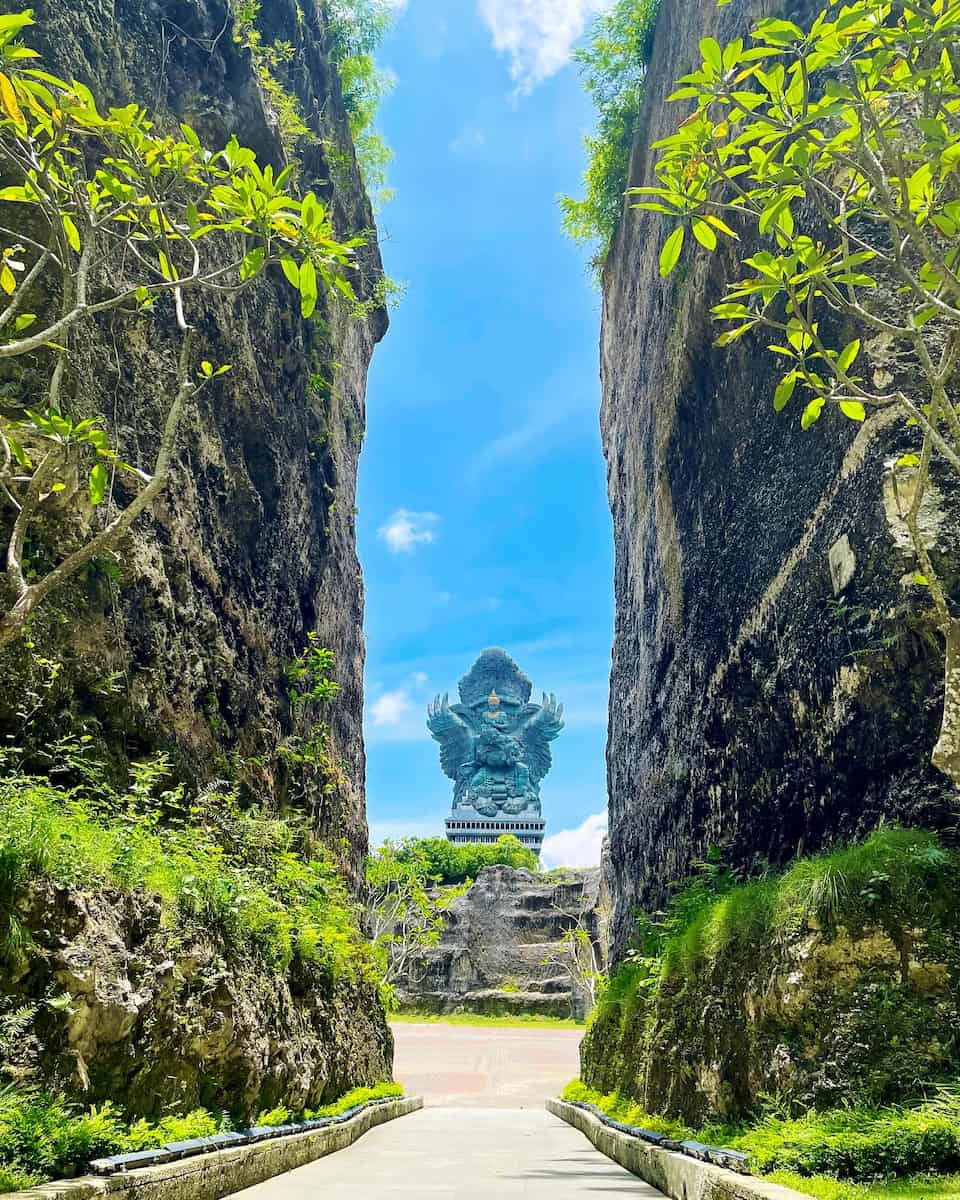
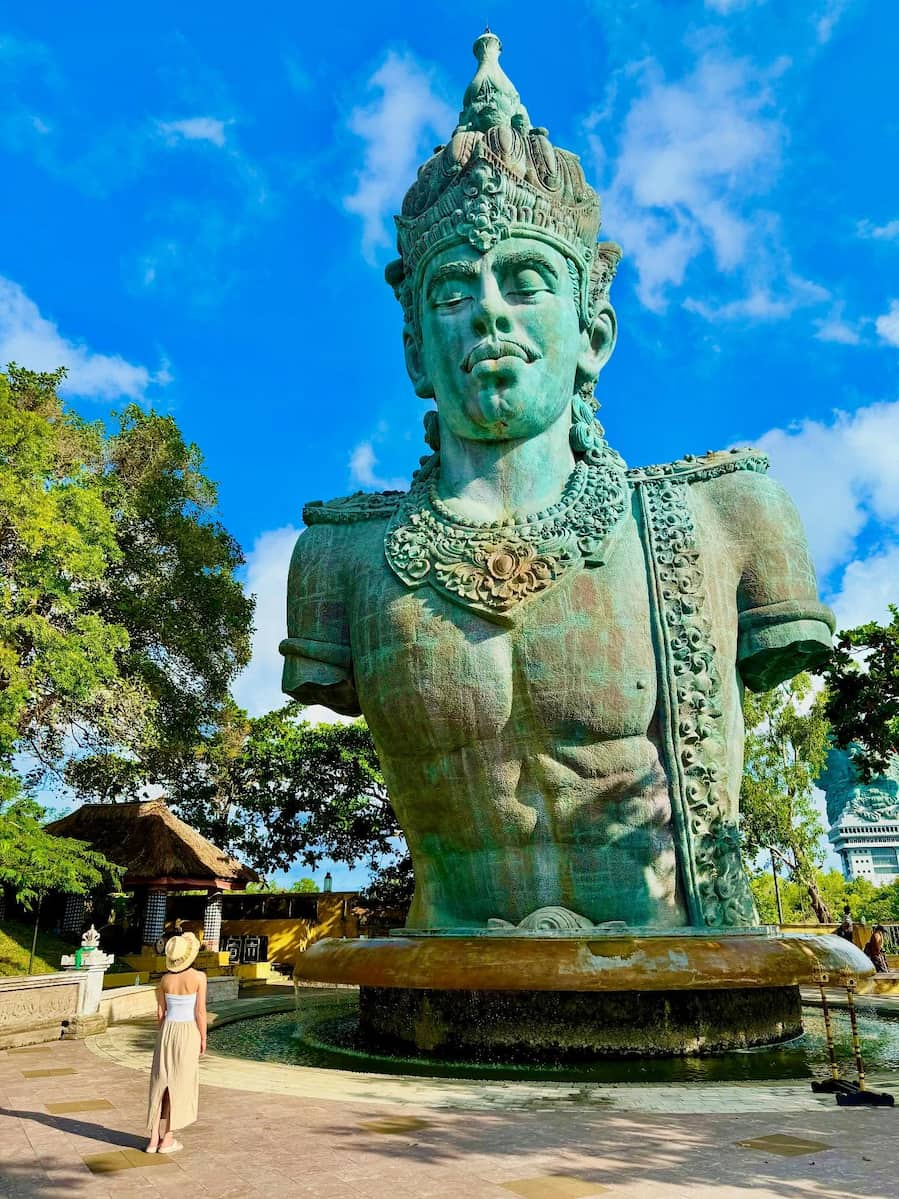
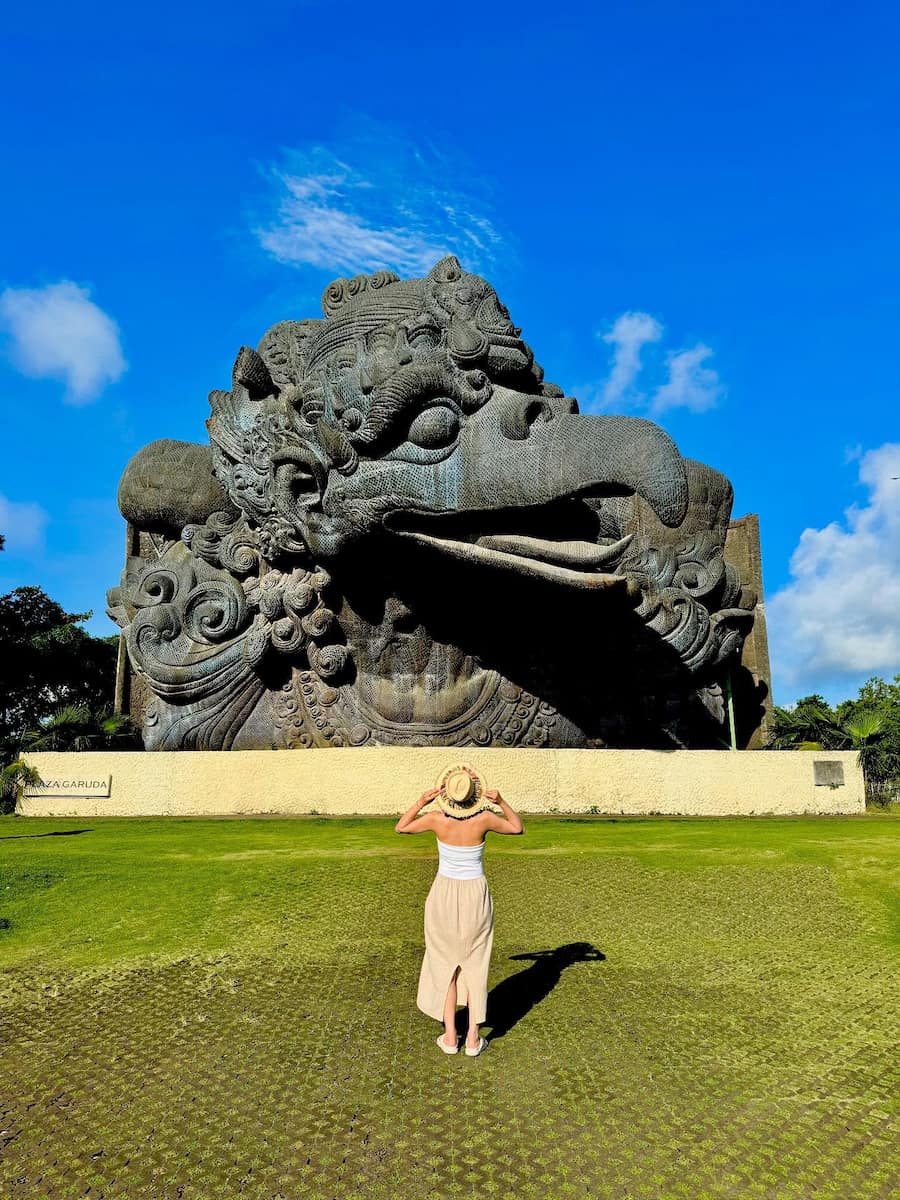
What You Can Do:
- Marvel at the Garuda Wisnu Kencana statue and take photos from different angles
- Catch daily Balinese dance shows and music performances
- Explore Lotus Pond, a massive outdoor plaza framed by limestone cliffs
- Try a Segway tour or stroll through Indraloka Garden for peaceful views
- Shop for souvenirs and Balinese crafts at the GWK Art Market
- Join a workshop in batik painting, wood carving, or traditional dance
Facilities, Dining, and Info. The park is well-equipped for visitors. There’s a free shuttle from the parking area to the entrance, and buggy services are available for a fee — handy if you’re traveling with kids or want to save energy. Food options range from local food stalls to the Jendela Restaurant, where I enjoyed traditional Indonesian dishes with a view of the statue. Restrooms, lockers, and plenty of shaded seating make it easy to spend several hours here.
| Ticket Type | Price (IDR) | USD (approx) | EUR (approx) |
|---|---|---|---|
| General Admission | 120,000–125,000 | $7.80–$8.15 | €7.20–€7.50 |
| Shuttle to Statue | 40,000 | $2.60 | €2.40 |
| Elevator to Viewing Deck | Extra fee | Varies | Varies |
⭐️ Best Activities
- Private Adventure: Bingin Waves & GWK Cultural Park – Start your day with a private lesson at Bingin, sip fresh coconut by the sea, then enjoy lunch and a guided stroll through GWK Park. Snap photos of the towering Vishnu statue, learn about local legends, and soak up a full day of fun, culture, and relaxation. Hotel pickup included for main areas.
13. Real Bali Swing
Adventures Above the Jungle. Real Bali Swing, just outside Ubud, is where I truly felt the thrill of flying above Bali’s lush landscape. The swings here are set high over deep jungle valleys, with views of cascading rivers and green rice terraces stretching into the distance. As I sat in the harness, the staff double-checked every strap and rope for safety, then with a gentle push, I soared out over the treetops. The rush of wind and the sight of palm trees far below made my heart pound — this is not just a ride, it’s a full-body adventure.
Variety and Instagrammable Spots. What makes Bali Swing stand out is the sheer variety of options. There are swings for every comfort level, from gentle single seats to extreme versions that send you 78 meters above the jungle floor. Couples can swing together, and families with kids can try the lower, slower swings. Besides the main attraction, there are giant bird nests, floating heart frames, and sky beds — each one designed for that perfect Instagram photo. I spent nearly as much time posing in the bird’s nest as I did swinging, and the photos turned out incredible.
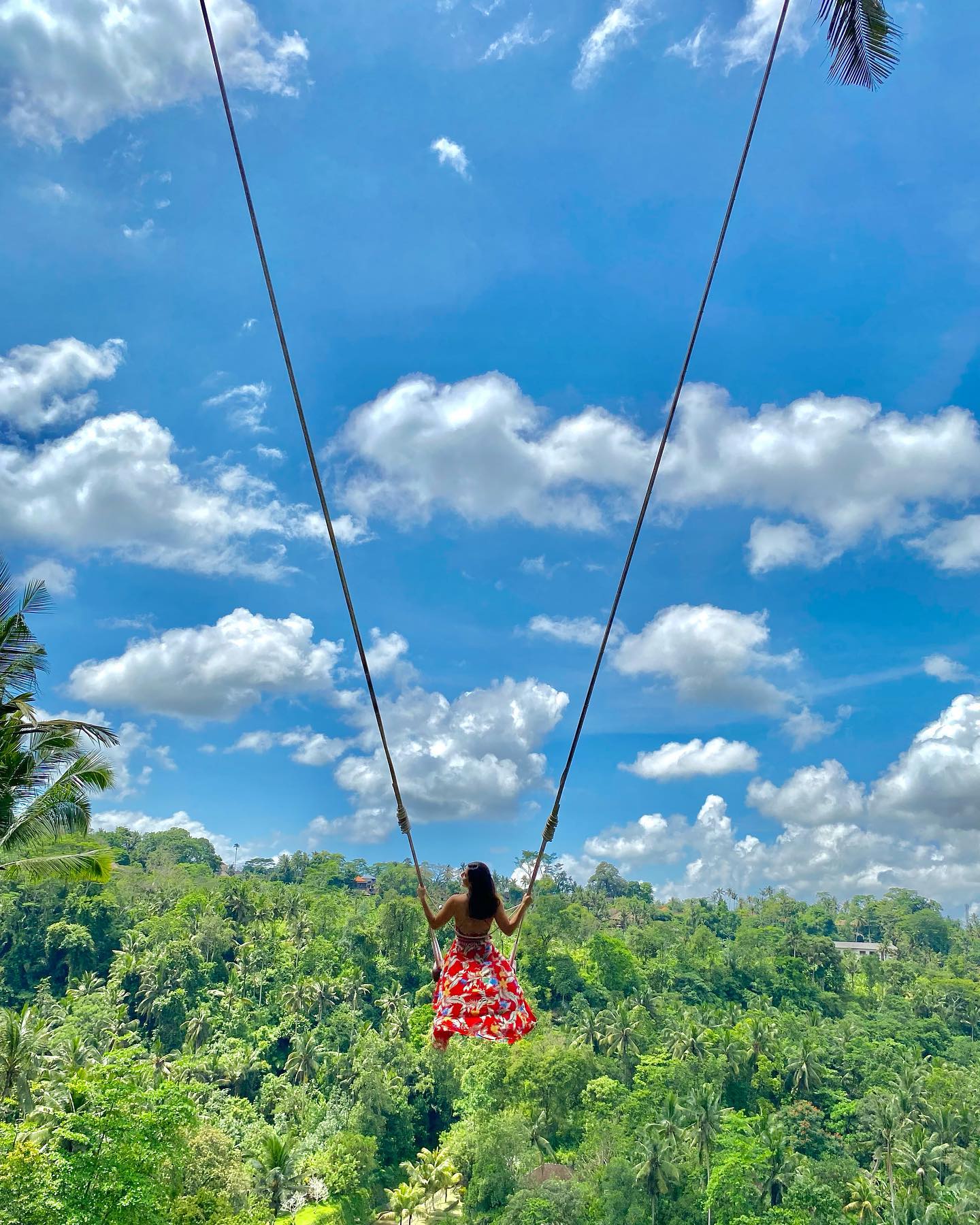
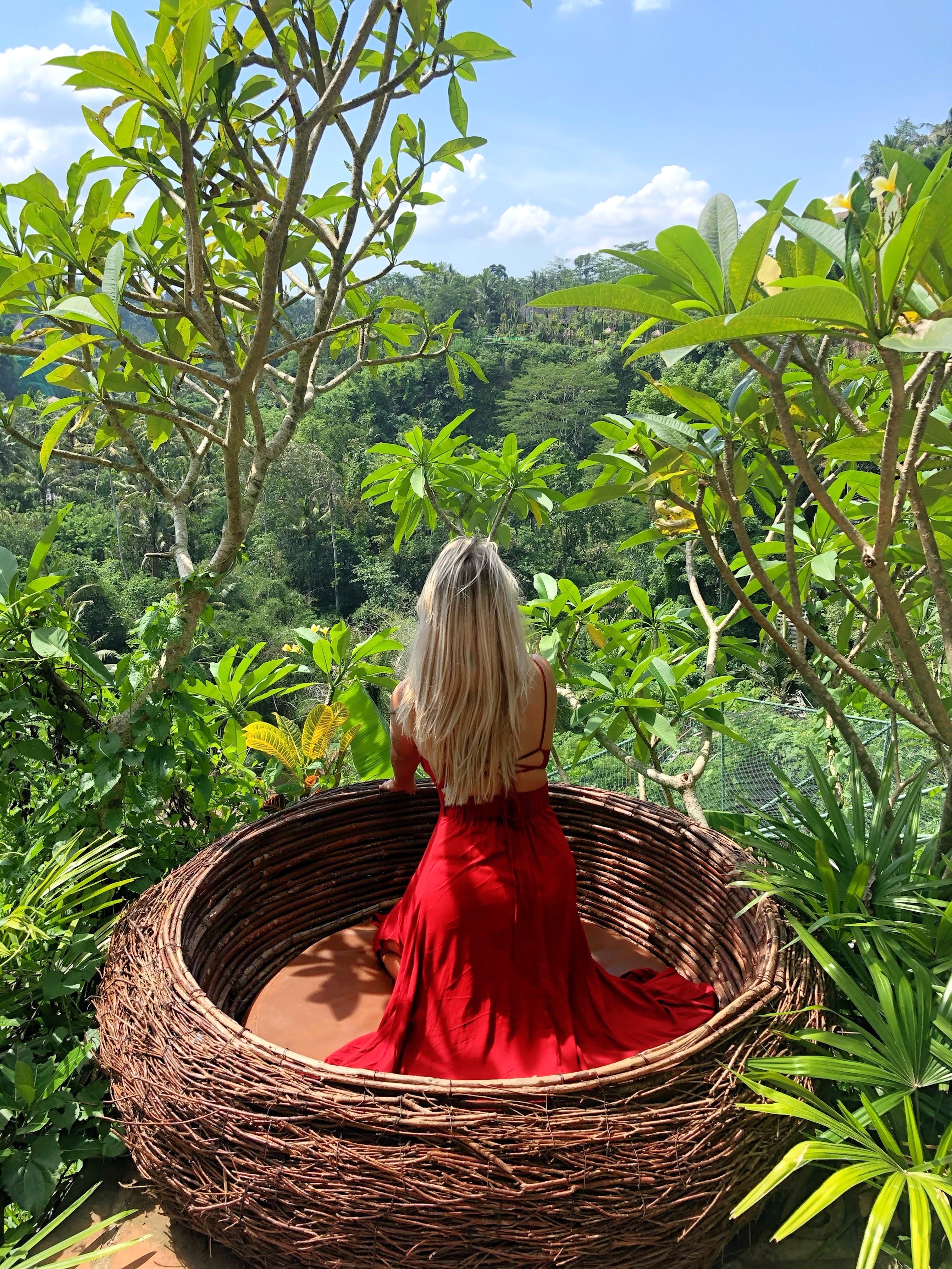
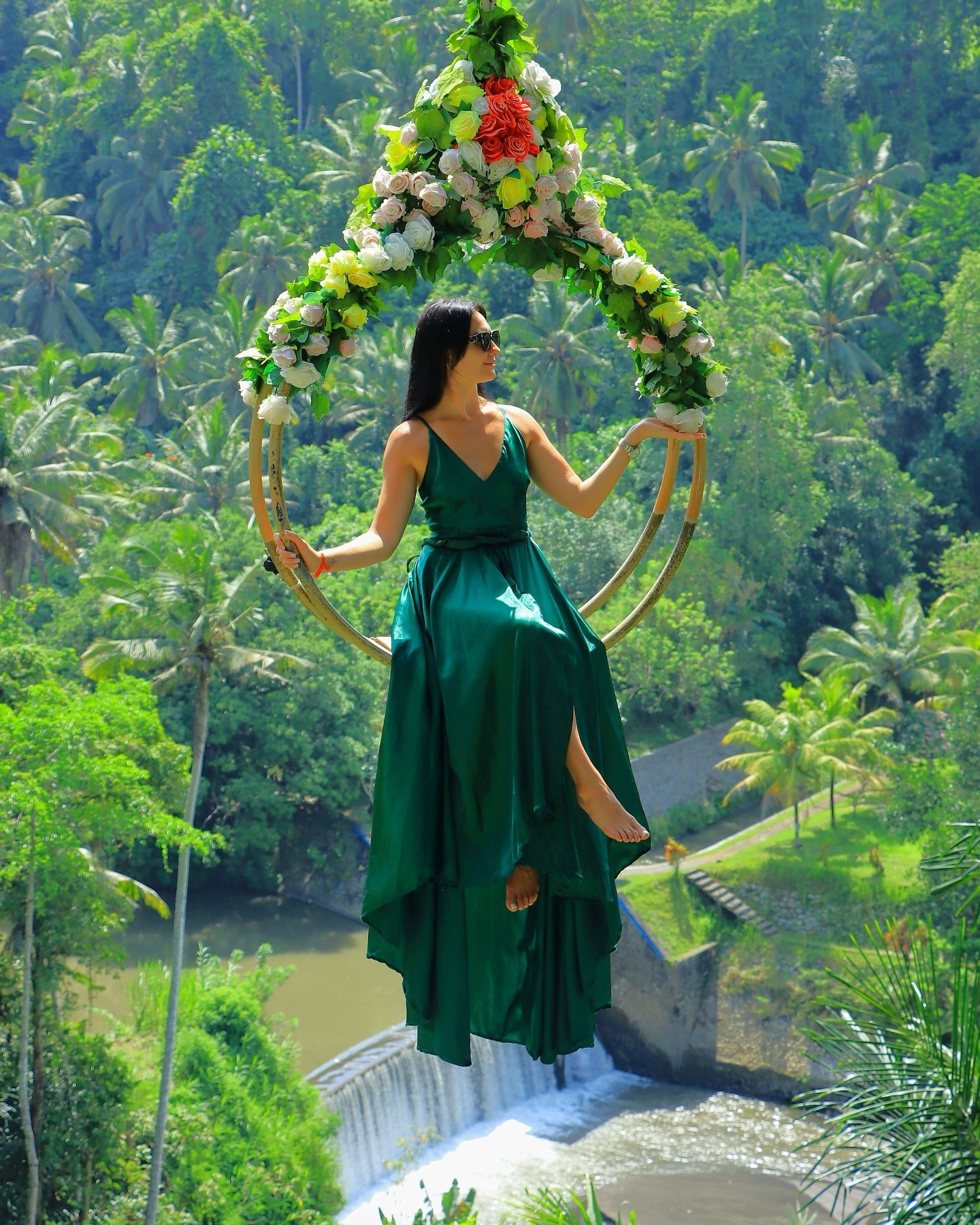
What’s Included:
- Multiple swing heights (single, couple, extreme)
- Bird nests and heart-shaped frames for photos
- Professional staff and secure harnesses
- Optional dress rental for dramatic photoshoots
- Welcome drink and lunch with some package
| Package Type | Price (IDR) | USD (approx) | EUR (approx) |
|---|---|---|---|
| Basic Swing Experience | 480,000 | $31 | €29 |
| Photographer Add-on | 150,000 | $9.70 | €9 |
| Dress Rental | 250,000 | $16 | €15 |
⭐️ Best Activities
- North Bali Insta Tour: Waterfalls, Gates & Hidden Hills – Journey through emerald landscapes, snap photos at Handara Gate and Wanagiri Hidden Hills, and cool off at Banyumala Twin Waterfalls. This private tour includes lunch, comfy transport, and a guide who doubles as your personal photographer — perfect for travelers who want a day packed with scenery, stories, and Insta-worthy moments.
14. Ubud Palace
Royal Heritage and Location. Ubud Palace, or Puri Saren Agung, sits right in the heart of Ubud, directly across from the bustling Ubud Art Market. This spot isn’t just a historic landmark — it’s still home to the Ubud royal family and a living center for culture and tradition. As I walked through the ornate entrance gate (Candi Bentar), I was greeted by lush gardens, lotus ponds, and the sound of gamelan music drifting from the pavilions. The palace’s location makes it the perfect starting point for exploring Ubud’s artistic and cultural scene.
Traditional Design and Courtyards. The palace complex is a showcase of traditional architecture, with red brick, volcanic stone, and thatched roofs giving it an authentic charm. Each courtyard and pavilion is decorated with intricate carvings and statues inspired by Hindu mythology and Balinese folklore. I admired the palatial pavilions (bale), each serving a different purpose — from royal meetings to ceremonies. The gardens are dotted with lotus ponds and shaded by ancient trees, creating a peaceful escape from the busy streets outside.
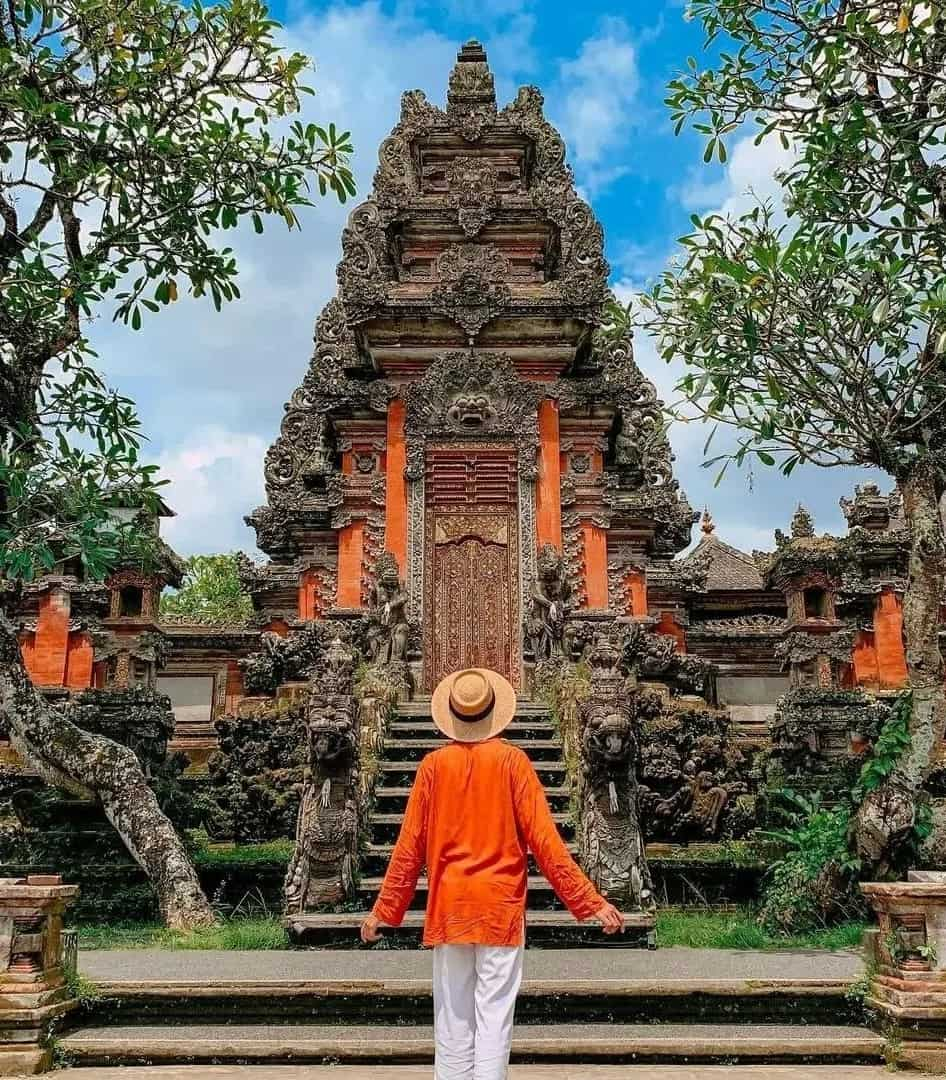
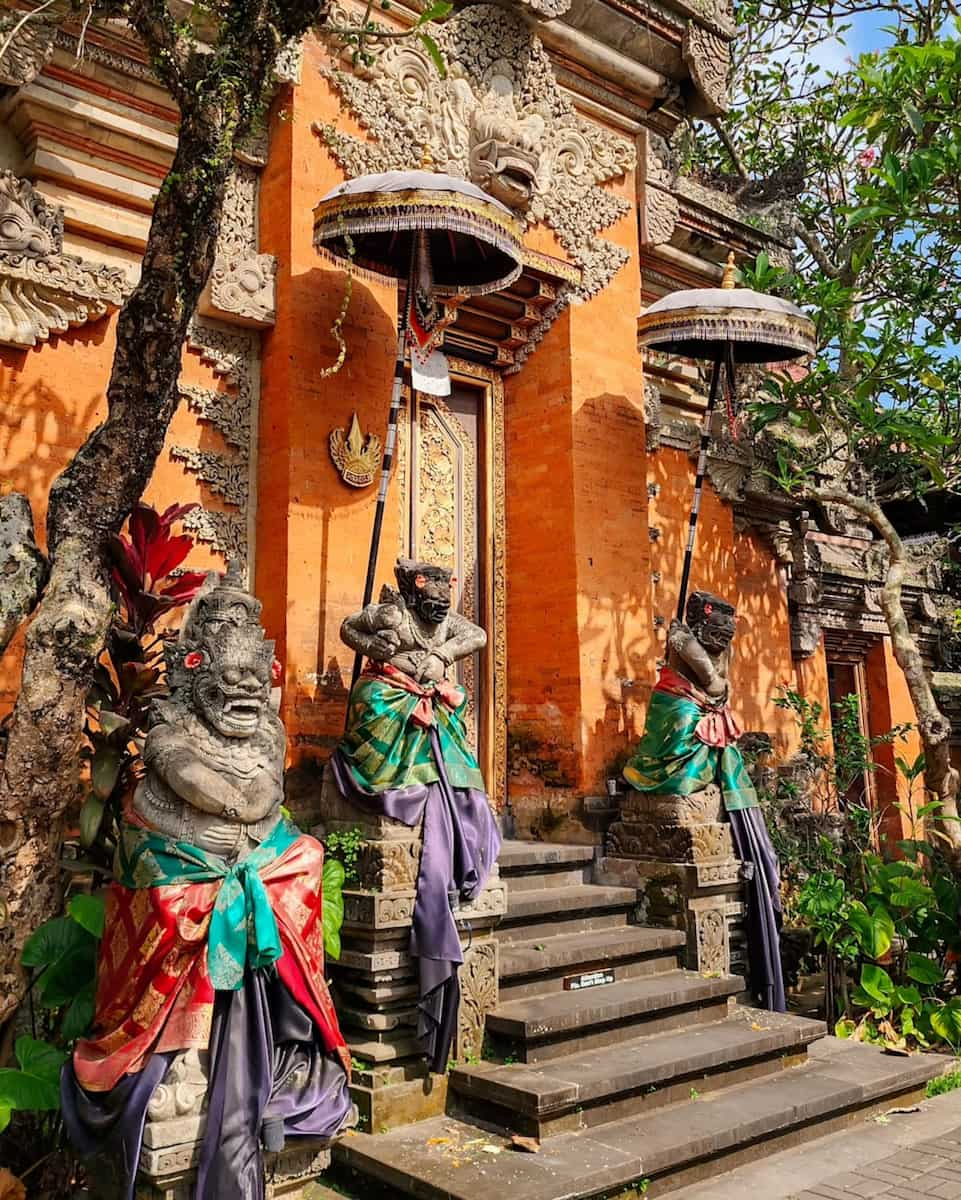
Activities List:
- Wander through the beautifully carved courtyards and gardens
- Admire the traditional musical instruments and statues on display
- Visit in the evening for the famous Ubud dance performances
- Combine your visit with a stroll through the nearby Ubud Art Market
- Look for cultural activities like dance rehearsals or music practice in the open pavilion
Performances and Community Spirit. One of the highlights of my visit was the evening dance show, held daily in the palace’s main courtyard. The performances start at 7:30 PM and feature different styles each night, from Legong to Barong and Ramayana Ballet. The stage is set against a backdrop of traditional doors and guardian statues, with a live gamelan orchestra providing the soundtrack. Sitting under the stars, I felt transported into the world of ancient legends, just as the royal family and guests once did.
| Experience | Price (IDR) | USD (approx) | EUR (approx) |
|---|---|---|---|
| General Entry (public) | Free | Free | Free |
| Dance Performance Ticket | 100,000 | $6.50 | €6 |
⭐️ Best Activities
- John Hardy Workshop Tour & Ubud Palace Visit – Watch master artisans craft jewelry in a stunning open-air studio, stroll the lush bamboo boutique, and explore a royal residence. Includes hotel pickup from main south and central areas, and is a favorite for design lovers and anyone curious about local creativity.
15. Nusa Dua Beach Hotel & Spa
Luxury and Location. Nusa Dua Beach Hotel & Spa sits on Bali’s southern peninsula, just a short drive from Ngurah Rai International Airport. The property is famous for its lush tropical gardens, grand entrance, and authentic design that echoes a royal palace. As I wandered the grounds, I noticed the attention to detail — carved stone gates, lotus ponds, and traditional pavilions. The hotel’s beachfront location means you’re steps away from soft sand and calm, clear water, perfect for swimming or relaxing under the shade of palm trees.
Facilities and Activities. This resort is packed with amenities for every type of traveler. There are three outdoor pools, including one with a swim-up bar, and a private stretch of sand lined with loungers. I found plenty to do without ever leaving the property: a sports center, fitness classes, tennis and squash courts, and a full-service spa offering Balinese massages and body treatments. For families, there’s a kids’ club, playground, and daily supervised activities, making it easy for parents to unwind while children are entertained.
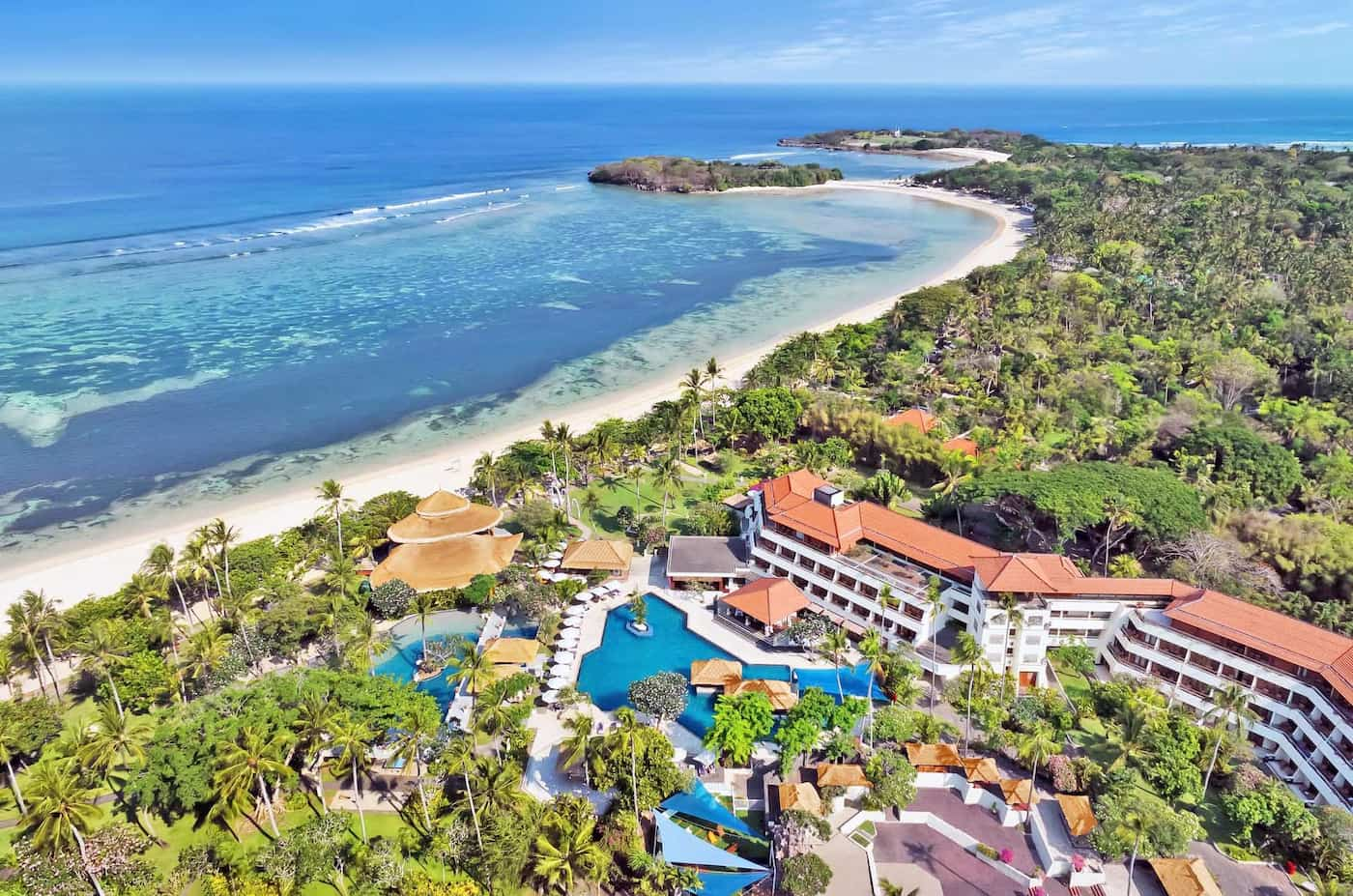
Dining and Culinary Experiences. Dining at Nusa Dua Beach Hotel & Spa is a journey in itself. There are five restaurants and four bars, each with a unique atmosphere and menu. I sampled Indonesian specialties at Raja’s, Mediterranean dishes at Tamarind, and Asian flavors at Maguro. The breakfast buffet at Wedang Jahe, surrounded by a lotus pond, was a daily highlight. For a treat, I tried the poolside Cabana, where Latin American-inspired dishes and homemade cocktails are served with views of the ocean.
What’s Included :
- Three outdoor pools and a private, sandy shoreline
- Five restaurants and four bars with diverse menus
- Full-service spa with hydrotherapy, steam rooms, and sauna
- Kids’ club, playground, and game room for families
- Fitness center, tennis, and squash courts
- Free Wi-Fi, daily activities, and cultural workshops
| Experience/Service | Price (IDR) | USD (approx) | EUR (approx) |
|---|---|---|---|
| Breakfast Buffet | 405,000 | $26 | €24 |
| Spa Treatments | Varies | Varies | Varies |
| Kids’ Club | Free | Free | Free |
| Airport Shuttle | 406,000 | $26 | €24 |
| Room Rates (per night) | 2,000,000+ | $124+ | €115+ |
16. Kelingking Beach (Nusa Penida)
Iconic Views and Location. Kelingking Beach on Nusa Penida is one of Indonesia’s most photographed spots, famous for its T-Rex-shaped cliff that towers over turquoise water and white sand. The viewpoint, perched high above the coastline, offers a breathtaking panorama that draws travelers from all over the world. As I stood at the edge, I could see manta rays gliding in the sea below and endless blue stretching to the horizon. The spot is especially popular with photographers and Instagrammers — over 650,000 photos have been shared with the #kelingkingbeach tag.
Hike Down and Adventure. For those craving adventure, the steep hike down to the sand is both challenging and rewarding. The descent takes 30–60 minutes, with bamboo handrails and rugged steps carved into the cliff. I quickly learned that sturdy shoes, a hat, and plenty of water are essential — flip-flops are a recipe for slips and sore feet. The path can be crowded, especially midday, so I recommend starting early. Once at the bottom, the beach feels wild and secluded, with massive waves crashing onto the shore.
What to See:
- Snap panoramic photos from the cliff-top viewpoint and bamboo platforms
- Hike down the steep stairs to the sand for a closer look at the T-Rex formation
- Relax on the powdery white sand and listen to the roar of the ocean
- Watch for manta rays from the viewpoint above
- Visit nearby warungs (small restaurants) for refreshments after the climb
Safety and Swimming Warnings. While the water looks inviting, swimming is strictly discouraged due to unpredictable currents and powerful waves. In recent years, several accidents have occurred, and local authorities have placed clear signs and safety officers to warn visitors. Even paddling in the shallows can be risky, so I kept my distance from the surf and focused on enjoying the scenery. Lifeguards are not present, and rescue is difficult on this remote stretch.
| Expense Type | Price (IDR) | USD (approx) | EUR (approx) |
|---|---|---|---|
| Island Entry Fee | 25,000 | $1.60 | €1.50 |
| Parking | 10,000 | $0.65 | €0.60 |
| Snacks/Water (warung) | 20,000+ | $1.30+ | €1.20+ |
- Private One-Day Adventure: West Coast Wonders & Snorkeling – Set off early with hotel pickup, fast boat tickets, and a private driver waiting for you on arrival. Explore dramatic cliffs at Broken Beach, snap photos at Kelingking, dip into the natural infinity pool at Angel’s Billabong, and relax at Crystal Bay. Lunch is included, and guides are praised for being friendly and helpful. Expect bumpy roads and crowds, but the views are unforgettable.
16. FINNS Beach Club
Legendary Energy and Design. FINNS Beach Club in Canggu is more than just a spot to relax — it’s a full-on experience, famous for its bamboo architecture and 170 meters of prime oceanfront on Berawa. Walking through the bamboo-lined entrance, I was greeted by a blend of world-class style and laid-back island vibes. The open-air design lets the sea breeze cool you off, and every corner is designed for comfort, from plush daybeds to shaded cabanas. You can feel the buzz as soon as you arrive, with music pulsing from live DJs and the sound of waves just steps away.
Pools, Bars, and Amenities. There’s no shortage of ways to chill or party here. FINNS boasts three pools, including a huge infinity pool facing the ocean, plus swim-up bars where you can order a cocktail without leaving the water. With 11 bars, five restaurants, and seven kitchens, the choices are endless — think sushi, pizza, Indonesian classics, and more. I loved the VIP area for its extra perks: welcome drinks, cold towels, sunglass cleaning, and even a gelato stick on the house. The service is top-notch, with friendly staff ready to bring food or drinks right to your lounger.
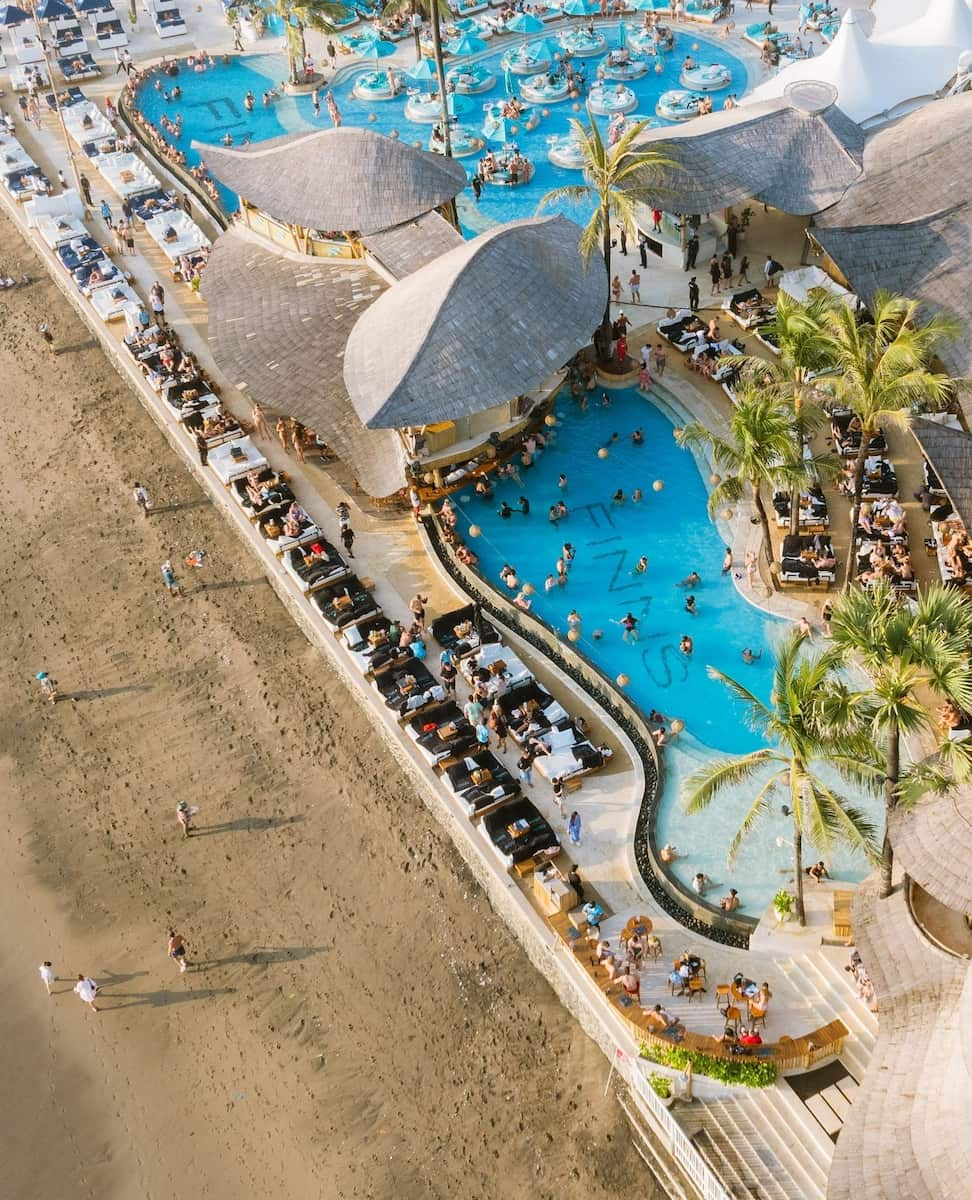

What Makes It Stand Out:
- Three pools (including an oceanfront infinity pool)
- 11 bars and five restaurants with global menus
- Daybeds, VIP cabanas, and beanbag zones for every mood
- Live DJs, pool parties, and sunset events every day
- Retail shops, photo booths, free Wi-Fi, and lockers for convenience
| Experience/Service | Price (IDR) | USD (approx) | EUR (approx) |
|---|---|---|---|
| Daybed Minimum Spend | 650,000+ | $40+ | €37+ |
| Cocktail | 225,000–300,000 | $15–$20 | €13–€18 |
| Bottle Service | 6,000,000+ | $400+ | €370+ |
| Locker Rental | 50,000 | $3.20 | €3 |
| Towel Rental | 50,000 | $3.20 | €3 |
⭐️ Best Activities
- Rooftops & Clubs of Canggu Nightlife Tour – Dive into Canggu’s vibrant after-dark scene! This guided evening adventure takes you to the coolest sky-high bars and buzzing clubs, with creative cocktails, live DJs, and panoramic sunset views. Perfect for party lovers and anyone looking to experience the energy and style of Canggu after dark.
17. Bali Botanical Garden
Mountain Escape and Location. Bali Botanical Garden, also known as Kebun Raya Bedugul, is the largest of its kind in Indonesia, covering 157 hectares in the cool mountains of Bedugul. Located at 1,300 meters above sea level, the garden offers a refreshing break from the island’s heat and is surrounded by misty hills and views of Lake Bratan. The entrance is on Jl. Kebun Raya, Candikuning Village, Tabanan, making it a great stop if you’re exploring northern Bali or heading to Ulun Danu Beratan.
Nature, Science, and Conservation. Walking through the garden, I was amazed by the diversity — over 2,000 species of plants, including rare orchids, begonias, ferns, and carnivorous pitcher plants. The orchid collection alone boasts around 300 species, and the begonia garden is one of the most complete in the world, with nearly 100 types and several endangered varieties. There are also 87 species of bamboo, including rare climbing bamboo, and a special section for medicinal plants used in traditional healing. The garden is not just for leisure; it’s a center for botanical research, with a herbarium, seed bank, and conservation programs.
Activities and Family Fun. The garden is perfect for families, nature lovers, and anyone needing a peaceful retreat. I enjoyed the Bali Treetop Adventure Park, which features flying fox ziplines, Tarzan swings, and rope circuits for all ages. There are also walking trails, picnic areas, and a dinosaur-themed shadehouse for kids. Guided tours and educational programs are available, and birdwatchers can spot native species flitting among the trees. The scenery is especially stunning in the dry season, but the highland climate keeps it pleasant year-round.
What You Can See:
- Wander through the orchid, begonia, and fern collections
- Try the Treetop Adventure Park’s ziplines and rope courses
- Visit the glasshouses and see rare carnivorous plants
- Explore the bamboo forest and medicinal plant garden
- Enjoy panoramic views of Lake Bratan from the northern lookout
| Expense Type | Price (IDR) | USD (approx) | EUR (approx) |
|---|---|---|---|
| Adult Entrance (Weekday) | 20,000 | $1.35 | €1.25 |
| Adult Entrance (Weekend) | 30,000 | $2 | €1.80 |
| Car Parking | 20,000 | $1.35 | €1.25 |
| Treetop Adventure Park | Varies | Varies | Varies |
| Buggy/Electric Bike Rental | 55,000+ | $3.70+ | €3.45+ |
- Full-Day North Bali Instagrammable Places Tour – Snap photos at lush rice fields, waterfalls, and scenic hills on this 8–10 hour adventure. Includes hotel pickup, a friendly English-speaking driver, entrance tickets, and lunch. Travelers love the flexible stops and relaxed pace — perfect for those who want a day packed with scenery and stories, with all the details handled for you.
18. Kuta Beach
Coastline and Lively Energy. Kuta’s 2.5-kilometre stretch of cream-colored sand is legendary, connecting Legian to the north and Tuban to the south, just minutes from Ngurah Rai International Airport. This part of Bali pulses with activity — vendors walk the sand selling sarongs and fresh fruit, while families, couples, and solo travelers relax under umbrellas or play in the gentle waves. The area is lined with shops, bars, restaurants, and entertainment venues, making it a one-stop destination for both relaxation and adventure.
Water Sports. Kuta is known worldwide as a surf hotspot, especially for beginners. The waves are consistent and the sandy bottom is forgiving, making it easy to learn with the help of local surf schools. If you want more excitement, try jet skiing, parasailing, or a banana boat ride. Surfboard rentals and lessons are available everywhere, and you’ll spot both first-timers and seasoned surfers catching waves from sunrise to sunset. Swimming is possible, but always stick to marked safe zones and avoid the busiest surf spots.
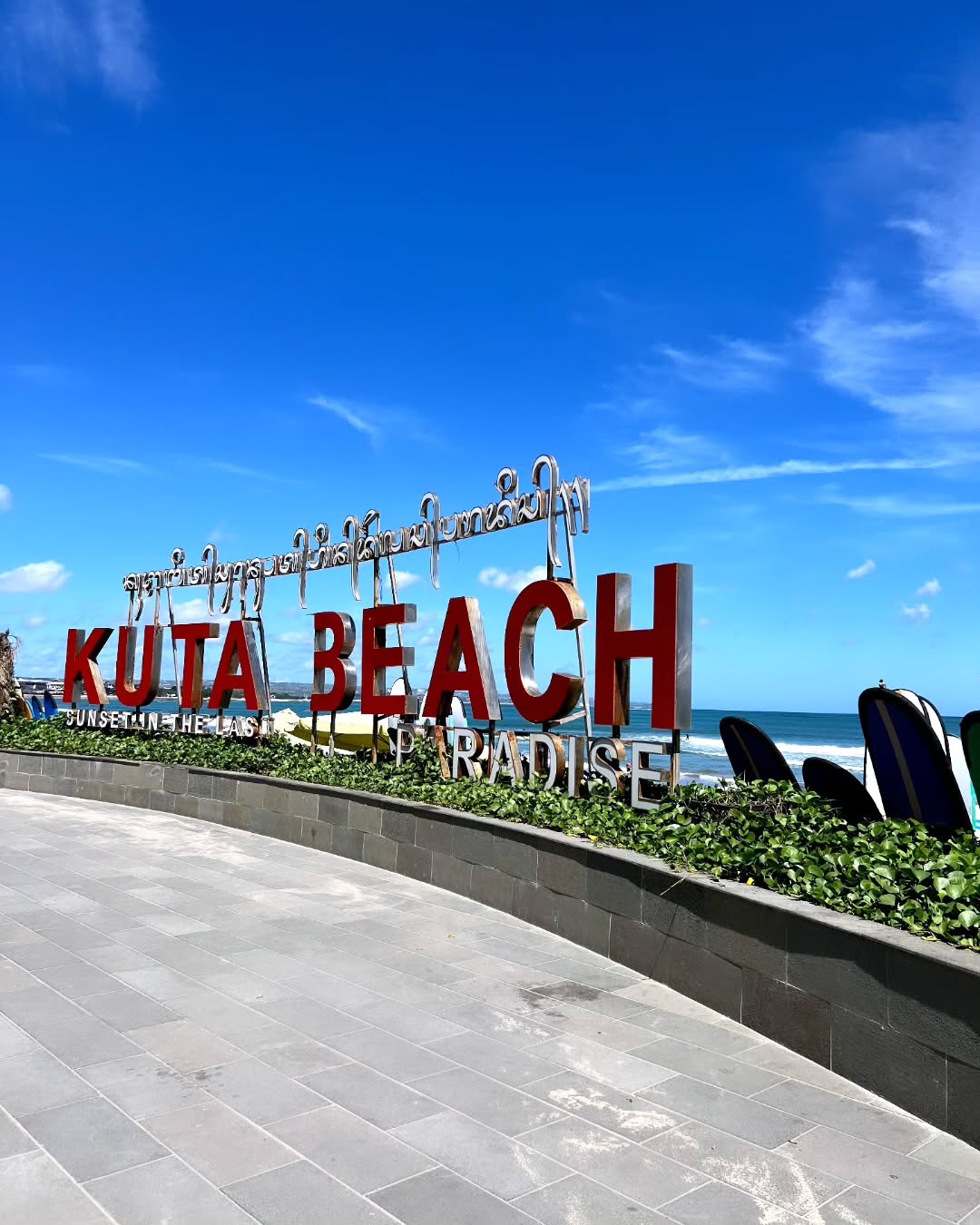
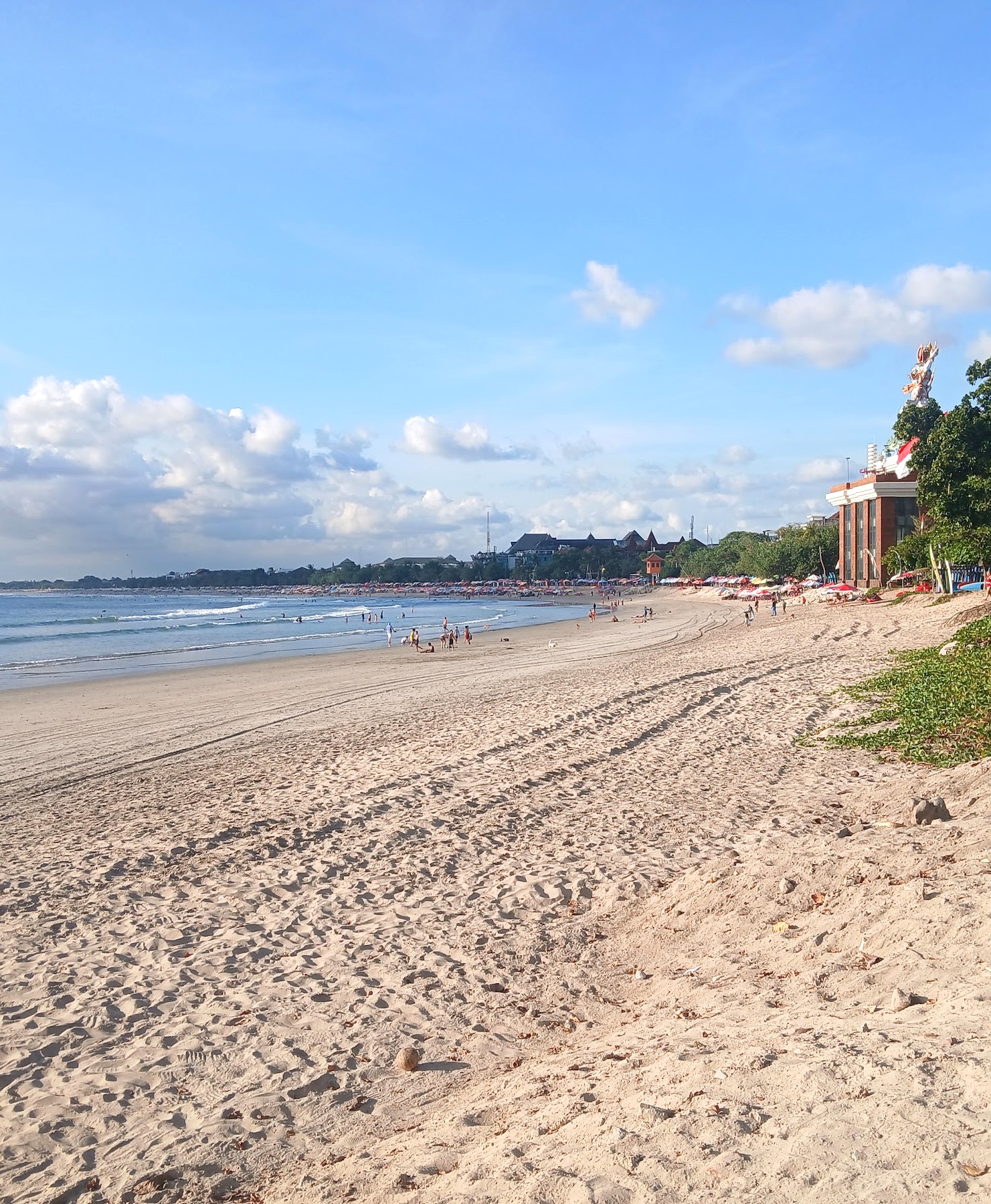
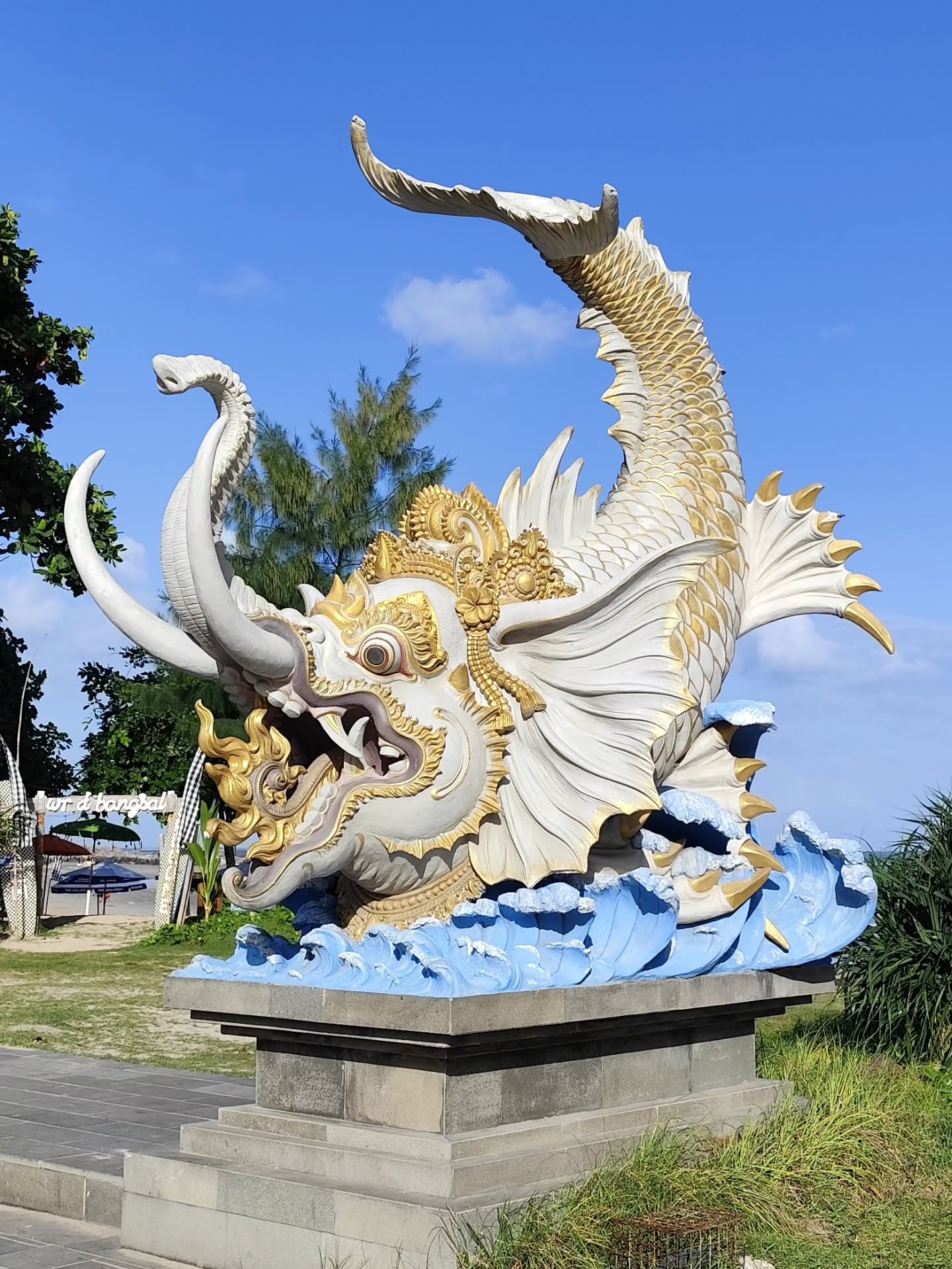
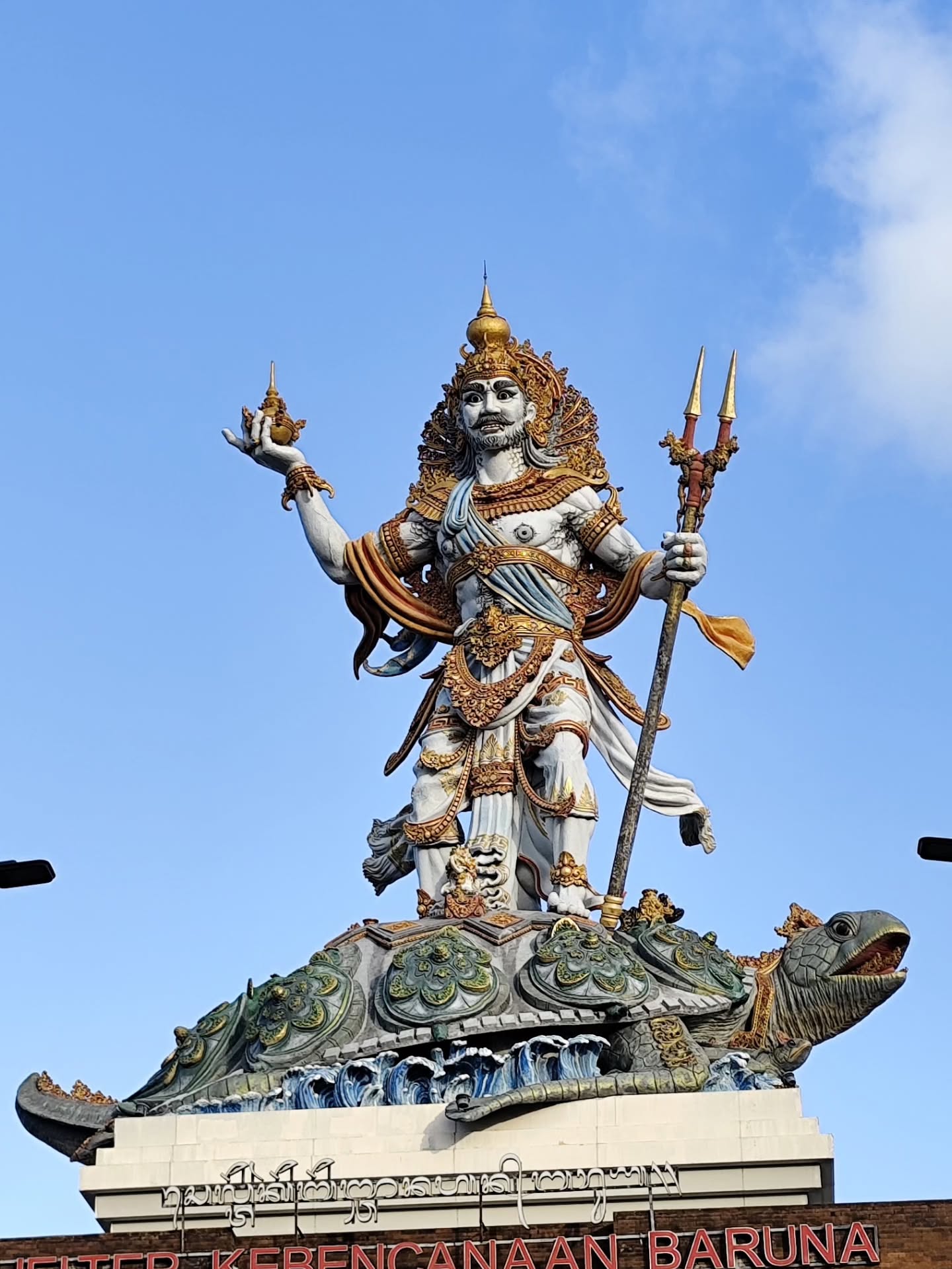
Top Things to Do:
- Take a beginner surf lesson or rent a board
- Enjoy a massage or manicure right on the sand
- Parasail or try a banana boat ride for a thrill
- Shop for souvenirs, jewelry, and local crafts at the market stalls
- Watch the sunset with a cold drink at a beachside café
| Activity/Service | Price (IDR) | USD (approx) | EUR (approx) |
|---|---|---|---|
| Surf Lesson (1 hour) | 250,000–350,000 | $16–$23 | €15–€21 |
| Sun Lounger Rental | 100,000–200,000 | $6.50–$13 | €6–€12 |
| Massage on the Sand | 100,000+ | $6.50+ | €6+ |
| Parasailing | 250,000–400,000 | $16–$26 | €15–€24 |
| Banana Boat Ride | 100,000–200,000 | $6.50–$13 | €6–€12 |
⭐️ Best Activities
- Private Beginner 1 on 1 Surf Lesson at Kuta – Learn to ride the waves with a patient instructor at Kuta’s famous shoreline. This two-hour private lesson includes all equipment, hotel pickup (in main areas), and plenty of encouragement — perfect for first-timers and those looking to boost their skills. Highly rated for fun, safety, and good vibes, with photos included to capture your progress!
19. Atlas Beach Club
Epic Scale and Setting. Atlas Beach Club in Canggu claims the title of the world’s largest beach club, stretching over 2.9 hectares on Berawa’s pristine coastline. My first steps inside revealed a sleek, contemporary design with infinity pools, exclusive loungers, and private cabanas all facing the Indian Ocean. The club’s size is staggering — there’s room for everyone, from couples seeking romance to families with kids, and groups ready to party. The vibe shifts from laid-back by day to electric after sunset, with the sky turning gold and the music picking up.
Relaxation and Family Fun. During the day, Atlas is all about chilling out and soaking up the sun. I lounged by the infinity pool, cocktail in hand, and watched families splash in the kids’ area, which features supervised pools and slides. There’s a dedicated Kids’ Zone with activities, floaties, and even a kids’ food menu — making it a hit for younger travelers. For adults, the club’s wellness facilities include a state-of-the-art gym and spa treatments, plus yoga and creative workshops like painting and perfume-making.
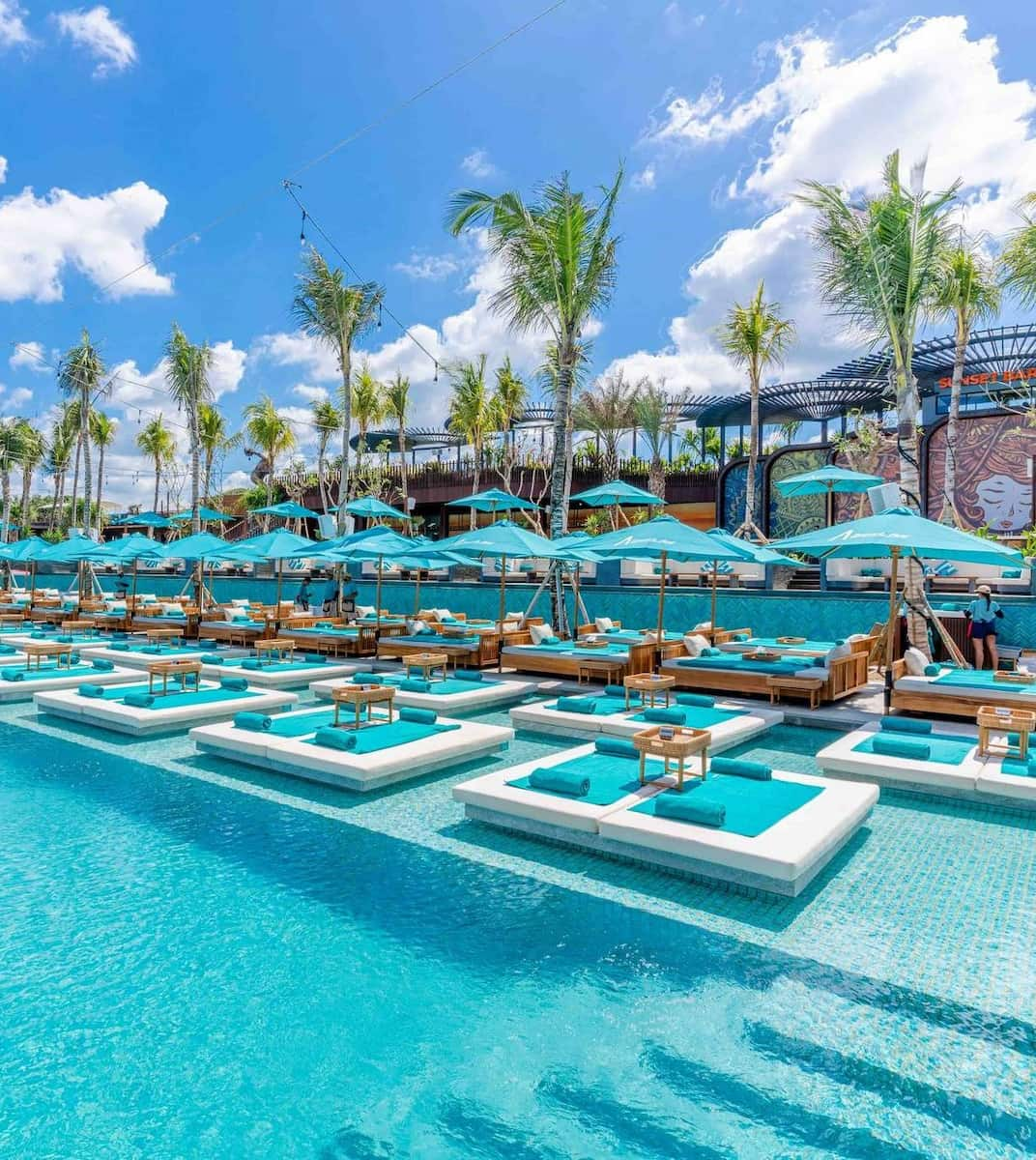
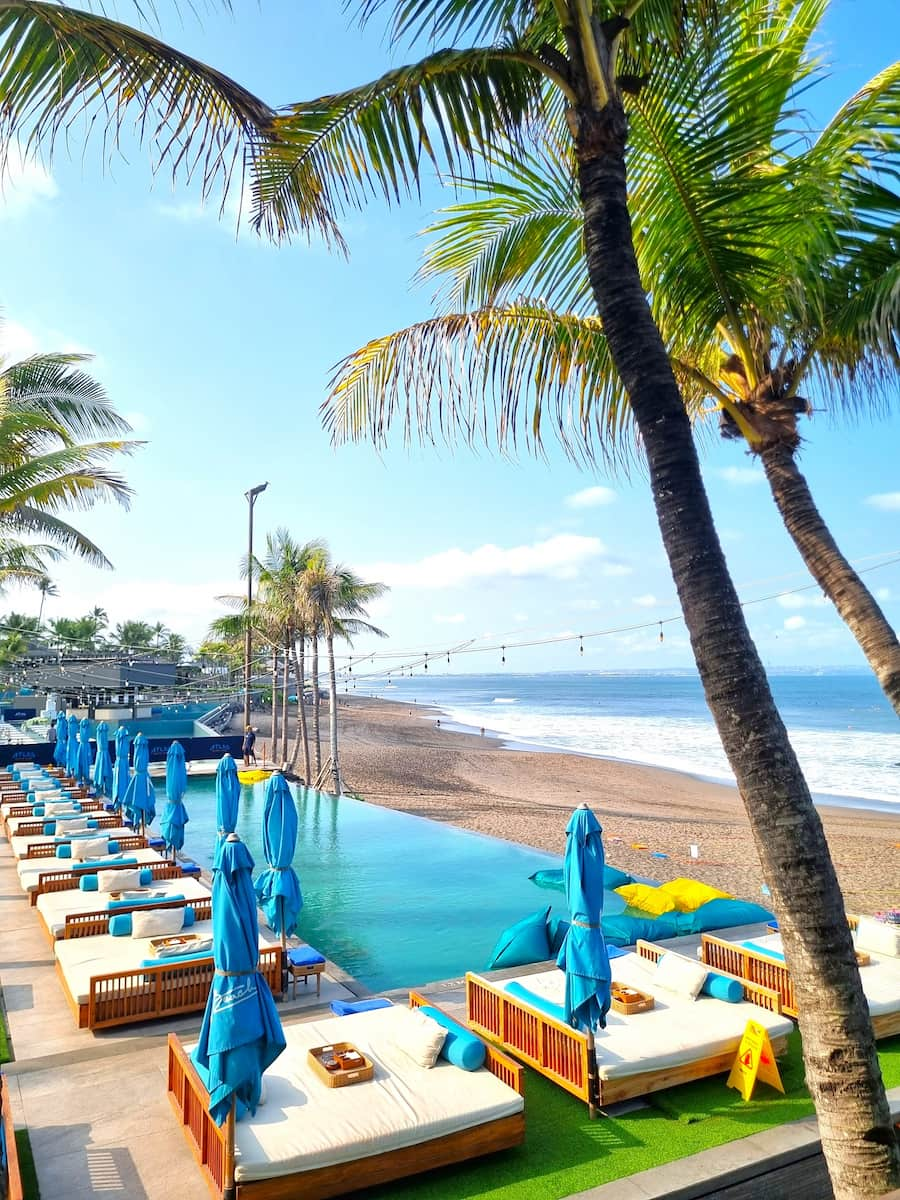
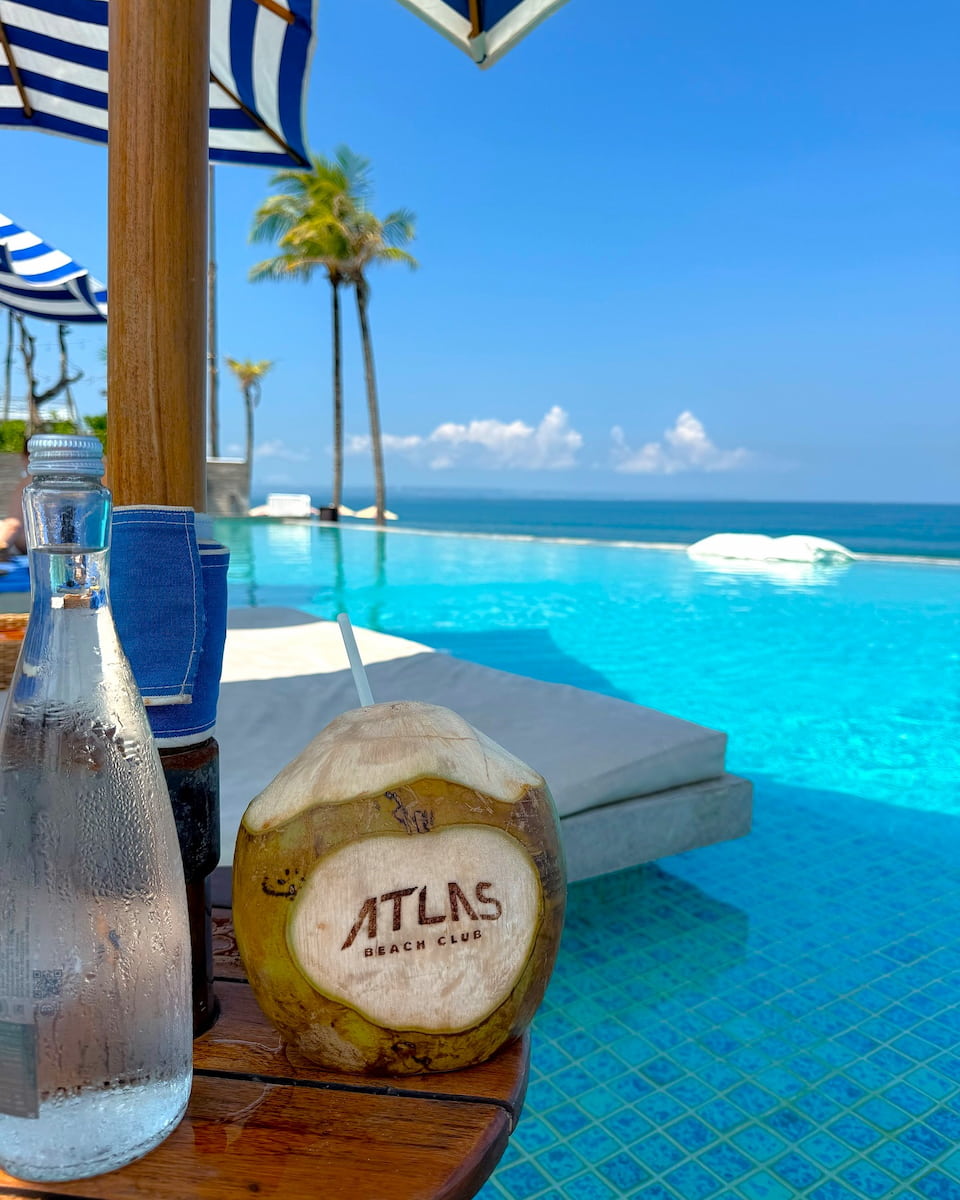
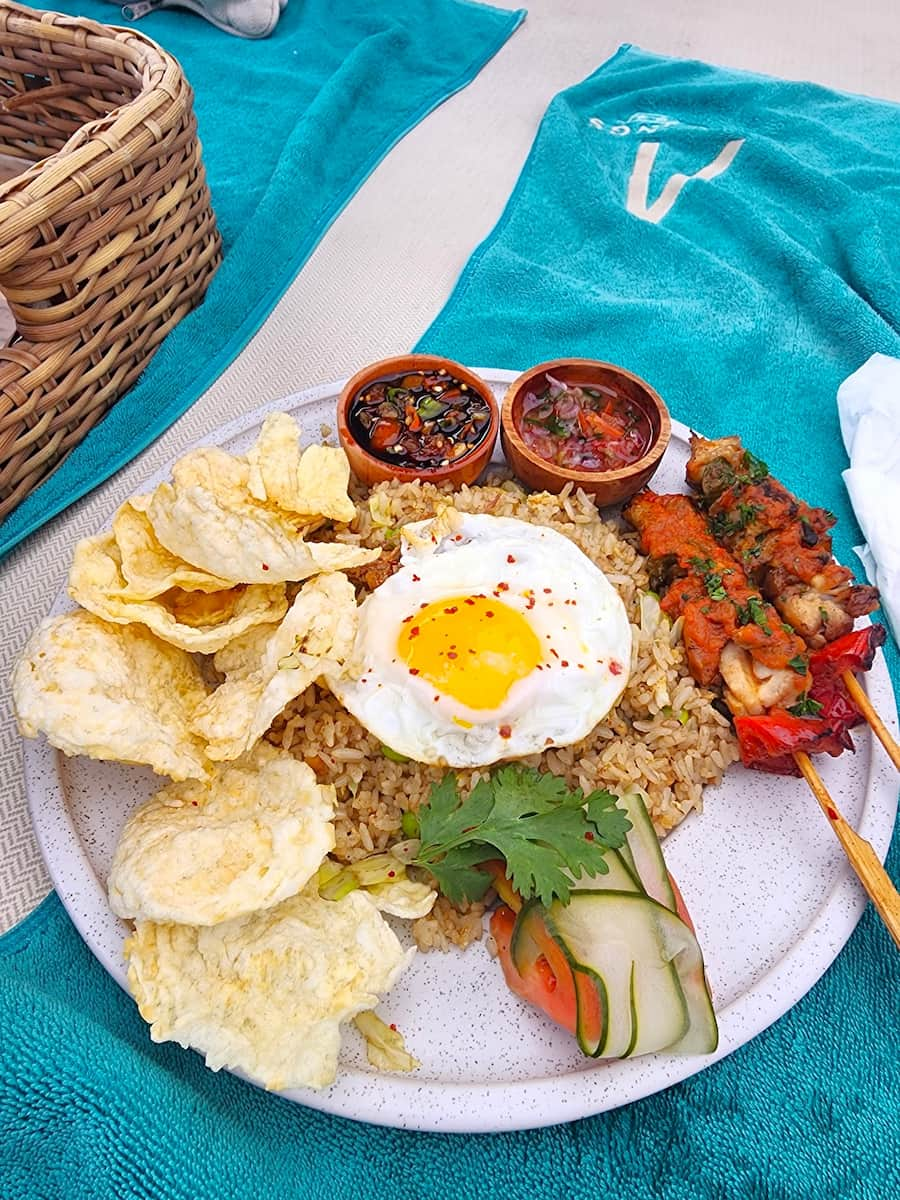
Entertainment and Nightlife. As the sun sets, Atlas transforms into a party hotspot. Live DJs, themed parties, and fire shows light up the main stage every night. I joined a crowd dancing under the stars, with stilt walkers and magicians weaving through the crowd. Traditional performances, like the Kecak dance and glow-in-the-dark shows, add a local twist to the entertainment lineup. The club’s superclub area is massive, with a separate entrance and its own DJ sets for those who want to dance until late.
Top Experiences at Atlas:
- Lounging by the infinity pool or in a private cabana
- Joining a yoga or creative workshop
- Watching live music, DJ sets, and fire shows
- Shopping for unique souvenirs at Madame H Street
- Letting kids enjoy the supervised play areas
Dining, Shopping, and Amenities. Foodies are in for a treat — Atlas offers multiple restaurants and bars, from beachfront grills to fine dining pavilions. I sampled a seafood platter and sipped a signature cocktail at the Sunset Bar, all while taking in panoramic ocean views. There’s also a lively shopping street (Madame H Street) with market stalls, boutiques, and pop-up shops selling everything from swimwear to souvenirs. Free Wi-Fi, towel service, lockers, and valet parking make the experience seamless.
| Ticket/Service | Price (IDR) | USD (approx) | EUR (approx) |
|---|---|---|---|
| One Day Pass + 1 Drink | 127,500–150,000 | $8–$10 | €7–€9 |
| Daybed (4–6 people, weekday) | 2,100,000+ | $137+ | €127+ |
| Daybed (4–6 people, weekend) | 2,650,000+ | $173+ | €160+ |
| Food & Beverage Voucher (2 pax) | 570,000 | $37 | €34 |
| Food & Beverage Voucher (4 pax) | 1,140,000 | $74 | €67 |
⭐️ Best Activities
- Atlas Beach Club: Entry Ticket & Entertainment – Dive into the world’s largest beach club on Berawa’s iconic sands. Enjoy a huge infinity pool, Asia’s longest beach bar, live DJ sets, and nonstop entertainment — think fire shows, stilt walkers, traditional dances, and even paramotorists overhead. Facilities include restaurants, a spa, gym, private villas, and a department store. Open daily 10am–midnight, perfect for families, party lovers, and anyone craving a luxury day with a festival vibe. Entry includes a welcome drink and access to all the fun.
20. Bajra Sandhi Monument
Striking Symbol and Location. Bajra Sandhi Monument rises from the heart of Denpasar, set within the green expanse of Renon Square (Puputan Renon). Its unique design, inspired by the sacred Hindu priest’s bell (bajra), immediately caught my eye — tall, elegant, and filled with symbolism. The monument is easy to find, just 15 minutes by car from Sanur or about 30 minutes from Seminyak. The grounds are popular with locals, especially on weekends and during “car-free” Sundays, when joggers and families fill the lawns.
Architecture and Philosophy. The structure follows Tri Mandala principles, dividing the space into three zones: the central Utama Mandala (main building), the surrounding Madya Mandala (inner courtyard), and the Nista Mandala (outer area). The monument stands 45 meters tall and features 17 stairs, 8 pillars, and a 45-meter height — numbers that echo Indonesia’s independence day, August 17, 1945. At the top, a large bell symbolizes the union of masculine and feminine forces in Hindu philosophy, while the base is adorned with mythological figures like the Basuki Dragon and Bedawang Akupa.

Journey Through History. Inside, the Bajra Sandhi Monument is a living museum. The ground floor houses a library, exhibition hall, and a souvenir store, while the first floor is home to 33 dioramas. These dioramas trace the story of Bali from prehistoric times, through the development of Subak irrigation, the Majapahit era, and the fierce resistance against Dutch colonialism, all the way to Indonesian independence. I found the dioramas both moving and educational — they bring to life the Puputan Wars, the arrival of Hinduism, and the resilience of the Balinese people.
Visitor Info and Prices:
- Entrance: 30,000–50,000 IDR for adults ($2–$3.20/€1.80–€3), 15,000–25,000 IDR for children ($1–$1.60/€0.90–€1.50)
- Parking: 5,000 IDR for cars, 2,000 IDR for scooters
- Opening hours: Monday–Friday 08:30–16:30; Saturday & Sunday 10:00–16:30; open daily except government holidays and Nyepi
| Ticket Type | Price (IDR) | USD | EUR |
|---|---|---|---|
| Adult | 30,000–50,000 | $2–$3.20 | €1.80–€3 |
| Child | 15,000–25,000 | $1–$1.60 | €0.90–€1.50 |
| Car Parking | 5,000 | $0.33 | €0.30 |
| Scooter Parking | 2,000 | $0.13 | €0.12 |
⭐️ Best Activities
- Private Museum & Bajra Sandhi Monument Historical Tour – Dive into local history with a private tour of the island’s main museum and the iconic Bajra Sandhi Monument in Denpasar. Custom hotel pickup is available from all main areas, making it easy to explore the region’s culture and heritage. Perfect for history buffs and curious travelers wanting a deeper look at local stories and art.
Bali Entertainment for Families and Children
1. Waterbom Bali
Adventures for All Ages. Waterbom Bali in Kuta is a paradise for families, packed with excitement and relaxation across five lush hectares. The park features 26 world-class slides and attractions, ranging from adrenaline-pumping rides to gentle play zones for little ones. I’ve watched my own kids light up as they explored the new 1-hectare Kids Area, bursting with five slides, climbing decks, water jets, and splash bowls — plus a giant dump bucket that soaks everyone with laughter. For those seeking thrills, the Climax and Boomerang slides offer heart-racing drops, while the Lazy River and Funtopia play area provide a gentler pace.
Kid-Friendly Zones. The new Kids Area is three times bigger than before, with over 40 interactive features and special play spaces for toddlers. Seven viewing domes let parents keep an eye on the action while relaxing in shaded chill-out zones nearby. I love that Waterbom has thought of everything: lockers, clean showers, changing rooms, and even a mini first aid center for peace of mind. The park follows strict international safety standards, with clear height and weight limits for each ride to keep everyone safe.
Top Family Attractions:
- Kids Area: Slides, splash zones, and a giant dump bucket
- Lazy River: A gentle float through tropical gardens
- Funtastic: Mini slides and water jets for toddlers
- Python, Constrictor, Twister: Thrilling slides for older kids and teens
- Private gazebos and grassy picnic spots for family downtime
Dining and Facilities. Food is a highlight here, with a wide variety of options to suit every taste. From Italian pizzas and Japanese sushi to Indonesian classics and fresh salads, I always find something for even the pickiest eaters. The open-air family restaurant in the Kids Area is built from eco-friendly bamboo and offers plenty of seating. For treats, we grab gelato or ice cream at one of the specialty stalls. Payment is easy with a wristband system — just top up at the start and leave your wallet in the locker.
| Ticket Type | Price (IDR) | USD | EUR |
|---|---|---|---|
| Single Day Pass (Intl) | 493,000 | $32 | €29 |
| Family Day Pass (Intl, 2+2) | 1,581,000 | $102 | €93 |
| Gazebo Rental | 350,000+ | $23+ | €21+ |
| Locker Rental | 35,000+ | $2.30+ | €2.10+ |
| Meal (average) | 60,000–120,000 | $4–$8 | €3.60–€7.20 |
⭐️ Best Activities
- Waterbom Park: Entry Ticket & All Slides – Dive into 3.8 hectares of tropical gardens packed with thrilling slides, a lazy river, kids’ splash zones, and relaxing pools. Enjoy award-winning rides like The Climax and Boomerang, cashless wristbands for easy purchases, and plenty of dining options with fresh daily food. Wheelchair accessible, with private cabanas, spa services, and free cancellation up to 24 hours before your visit. Perfect for families, thrill-seekers, and anyone craving a fun-filled day in the sun.
2. Bali Zoo
Wildlife Encounters. Bali Zoo in Gianyar is a paradise for animal lovers and families, offering a day packed with adventure, learning, and close-up animal experiences. Spread across 12 hectares, the zoo is home to over 350 rare and exotic species, from majestic Sumatran tigers and African lions to playful orangutans, giraffes, and tropical birds. I was amazed by how close you can get to the animals — feeding giraffes, meeting curious orangutans, and even snapping a photo with a friendly parrot perched on your arm. The zoo’s focus on conservation and education means every visit is as meaningful as it is fun.
Interactive Activities. Bali Zoo is designed with families in mind. The Jungle Splash Waterplay area is a lifesaver on hot days — kids can cool off on slides, splash pads, and water jets after exploring the animal exhibits. The petting zoo is a highlight for younger children, letting them feed and cuddle bunnies, goats, and deer in a safe, supervised space. My kids loved the pony rides, which are available for children under 30 kg. There’s also a mini-zoo for hands-on encounters and a playground for when little legs need a break.
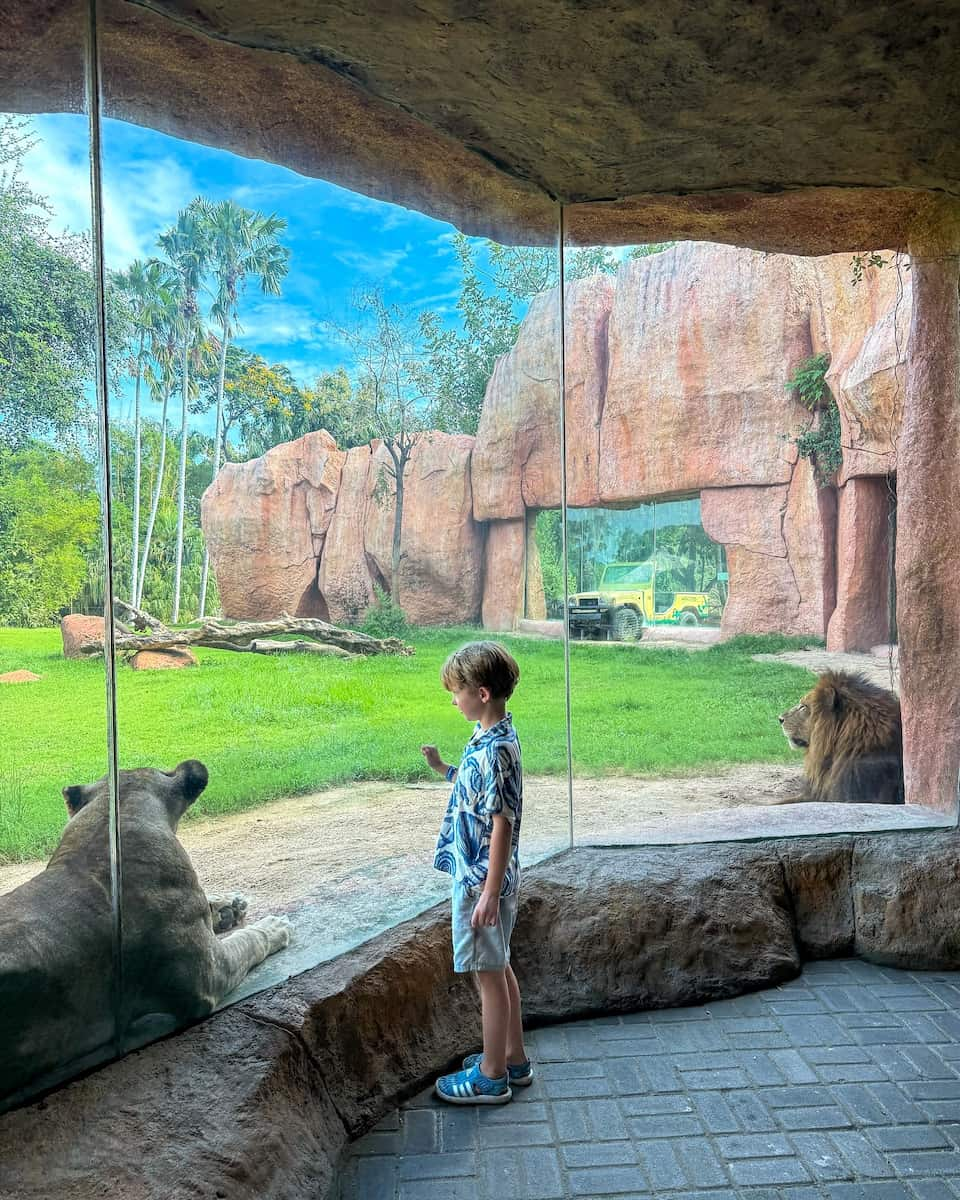
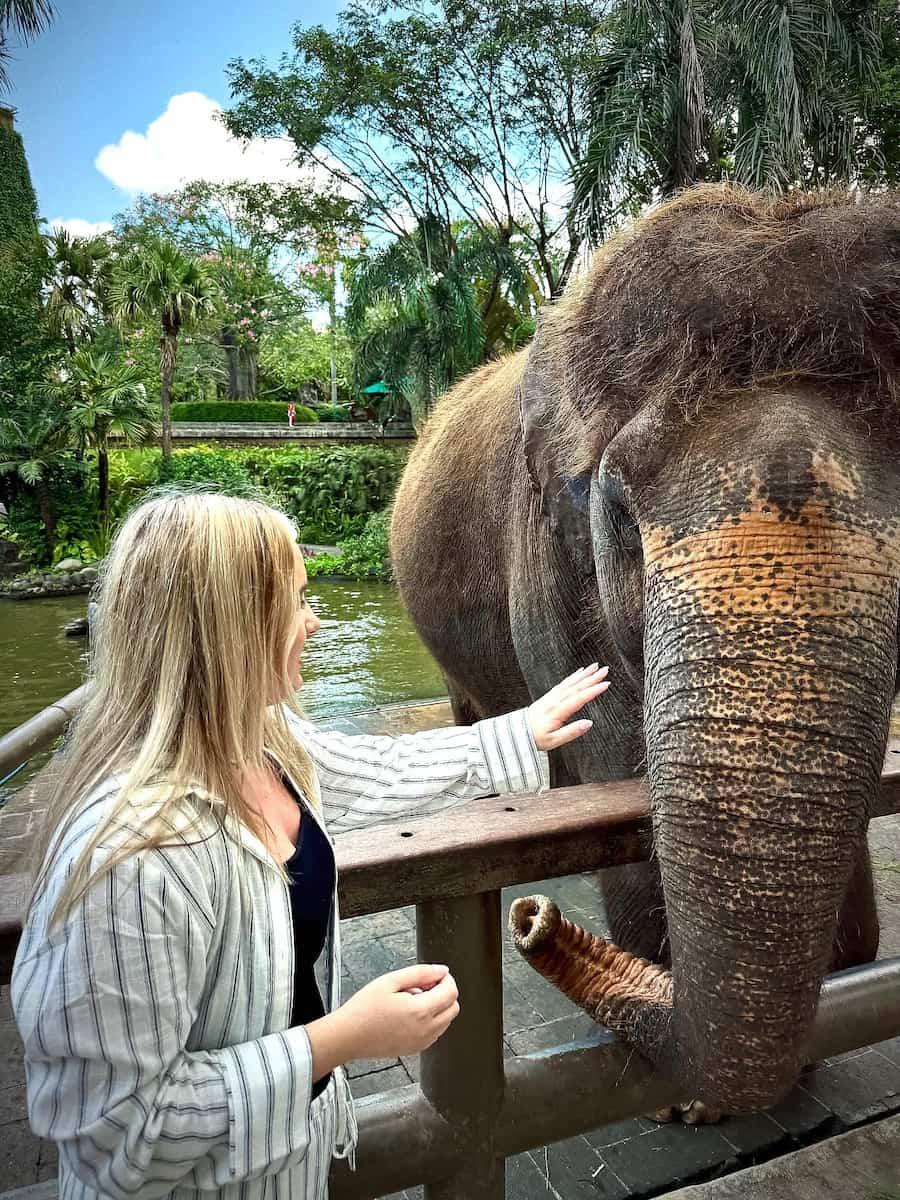
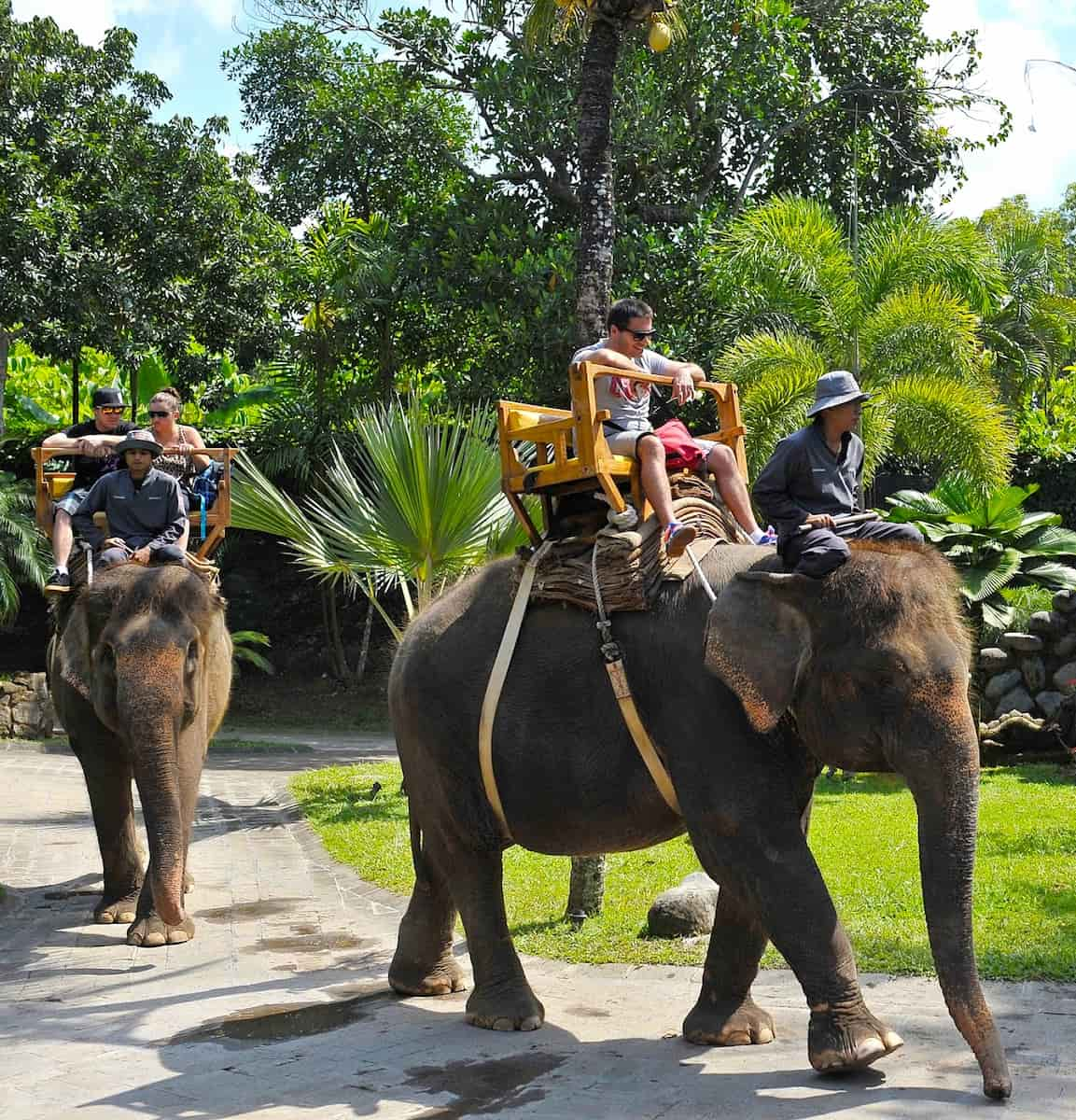
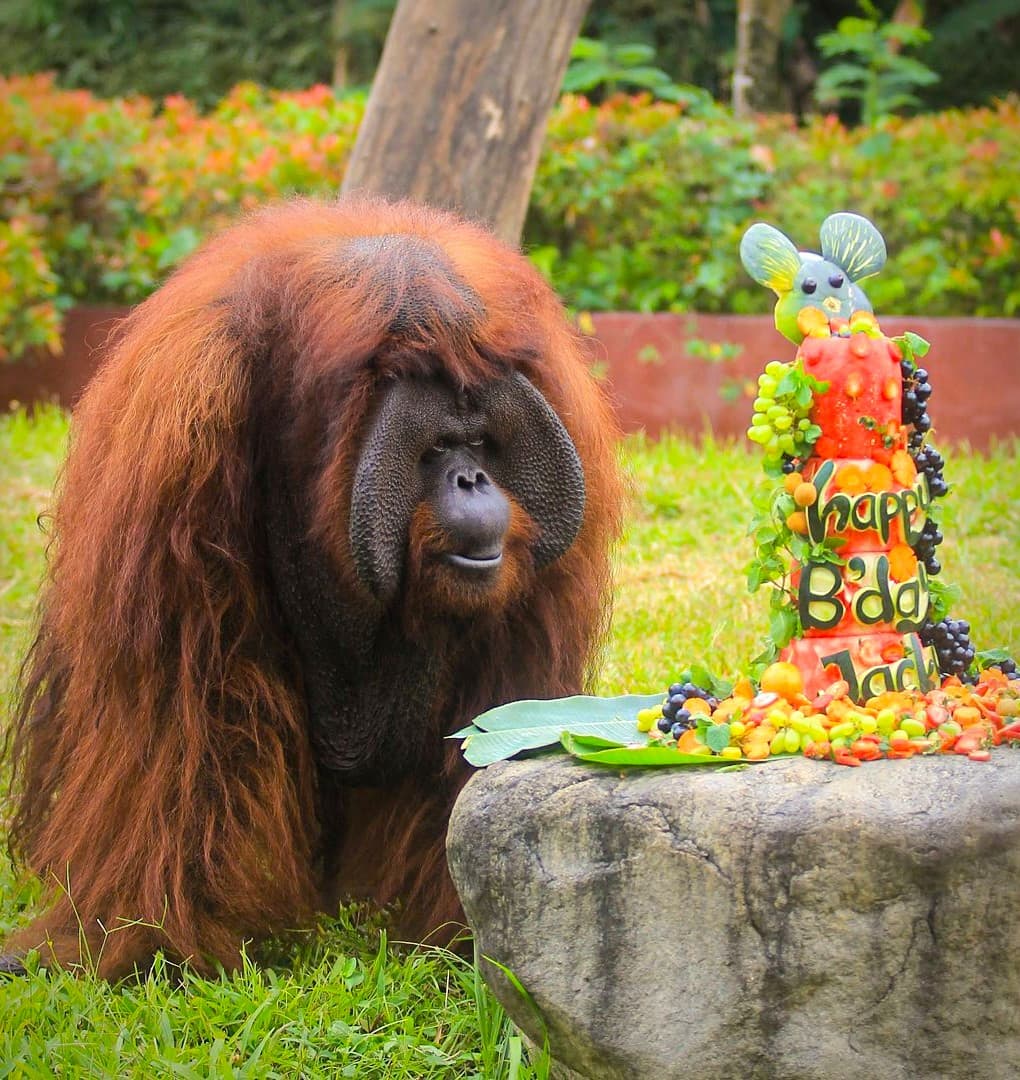
Unique Experiences at Zoo:
- Breakfast with Orangutans: Enjoy a meal while orangutans swing nearby
- Elephant Mud Fun: Bathe, feed, and bond with gentle Sumatran elephants
- Elephant Expedition: Ride atop an elephant through lush landscapes
- Jungle Splash Waterplay: Slides and splash zones for kids
- Animal Encounters: Feed giraffes, meet birds, and snap photos with reptiles
| Ticket Type | Price (IDR) | USD (approx) | EUR (approx) |
|---|---|---|---|
| General Admission (Intl) | 395,500 | $25 | €23 |
| Breakfast with Orangutans | 775,000+ | $49+ | €45+ |
| Elephant Expedition | 975,000+ | $62+ | €57+ |
| Elephant Mud Fun | 1,210,000+ | $77+ | €71+ |
| Family Day Pass (2 adults + 2 kids) | 1,581,000 | $102 | €93 |
| Pony Ride | Included | Included | Included |
Shows and Facilities. The zoo offers several restaurants and snack bars, with options ranging from Indonesian classics to kid-friendly pizza and ice cream. I recommend the WANA Restaurant, where you can dine with views of lions and other wildlife. Don’t miss the animal shows — bird performances, elephant encounters, and interactive feeding times are scheduled throughout the day. Facilities include lockers, changing rooms, free shuttle buses to the African Savannah area, and a souvenir shop for animal-themed gifts.
⭐️ Best Activities
- Bali Zoo: Entry Ticket & Interactive Wildlife Experience – Step into a lush sanctuary home to over 500 animals, including Sumatran tigers, elephants, orangutans, sun bears, and rare birds. Enjoy hands-on encounters like feeding elephants, breakfast with orangutans, and a family-friendly petting zoo. The zoo features a reptile house, tropical aviary, and even a Night Safari for after-dark adventures. With restaurants, shaded rest areas, and a splash water play zone for kids, it’s a top pick for families and animal lovers seeking a fun, educational, and ethical wildlife experience. Wheelchair accessible and open daily from 9 AM to 5 PM.
3. The Amazing Taman Safari Bali
Wildlife Adventure. The Amazing Taman Safari Bali, located in Gianyar, is a must-visit for families looking to combine fun, education, and close encounters with rare animals. The park is home to over a thousand creatures, including endangered species like Sumatran tigers, white rhinos, elephants, and lions. I was blown away by the open, natural habitats — here, animals roam spacious enclosures, and you can see them up close from the comfort of a safari tram or a private 4×4 jeep. The “Jungle Hopper” package is the most popular, offering unlimited safari journeys, animal shows, and a welcome drink.
Interactive Experiences and Shows. Taman Safari Bali is packed with hands-on activities for children and adults. My kids loved the Petting Zoo, where they fed rabbits, goats, and guinea pigs under the watchful eye of friendly keepers. The Water Play Zone was a hit on hot days, offering splash pads, slides, and a safe kids’ pool. Throughout the park, you’ll find scheduled animal shows — watch elephants paint, see tigers leap, or enjoy the Bali Agung cultural performance in the state-of-the-art theater. The highlight for us was the chance to feed giraffes and snap a photo with a colorful macaw perched on my shoulder.
Top Family Activities:
- Safari Journey by tram, jeep, or elephant-back
- Petting Zoo with rabbits, goats, and guinea pigs
- Water Play & Fun Zone for cooling off
- Night Safari for seeing nocturnal animals in action
- Animal feeding and photo sessions (giraffes, birds, reptiles)
- Educational animal shows and the Bali Agung performance
| Ticket Type | Price (IDR) | USD (approx) | EUR (approx) |
|---|---|---|---|
| Jungle Hopper (adult) | 600,000 | $39 | €36 |
| Jungle Hopper (child, 3–12) | 480,000 | $31 | €29 |
| Night Safari | 1,200,000 | $78 | €72 |
| Elephant Safari | 1,400,000+ | $91+ | €84+ |
| Water Play Zone | Included | Included | Included |
| Parking (car/scooter) | 5,000–10,000 | $0.33–$0.65 | €0.30–€0.60 |
4. Bali Bird Park
Colorful Encounters. Bali Bird Park in Gianyar is a paradise for families and anyone curious about the world of birds. Spread across five hectares, this sanctuary is home to over 1,300 birds from 250 species, including rare and endangered ones like the Bali Starling and the world’s largest collection of Papuan Paradise birds. As I wandered through the lush, beautifully landscaped grounds, I was amazed by the themed zones — each one designed to mimic the natural habitat of birds from places like Sumatra, Java, Papua, South Africa, and South America. The experience is immersive, with indigenous plants, waterfalls, and even a mini rainforest.
Interactive Shows. The park’s daily schedule is packed with interactive shows and feeding sessions that keep kids engaged and adults entertained. My favorite was the Bali Rainforest Free Flight Bird Show, where parrots, storks, and hornbills swoop overhead in a dazzling display. The Basic Instinct Birds of Prey show is another highlight, featuring eagles and owls demonstrating their hunting skills. Children can join pelican and lory feeding sessions, or visit the Guyu Guyu Corner to meet parrots and cockatoos up close. There’s even a 4D cinema for a fun, educational break from the sun.

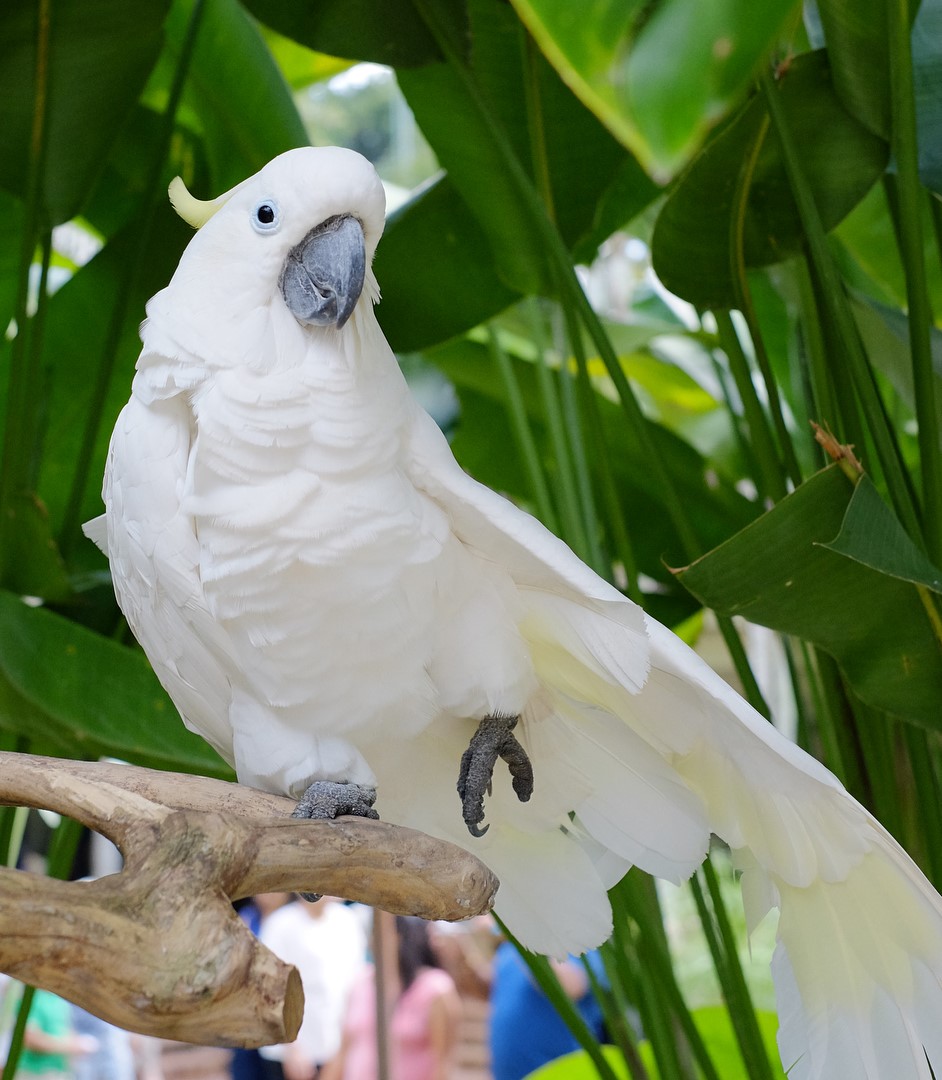
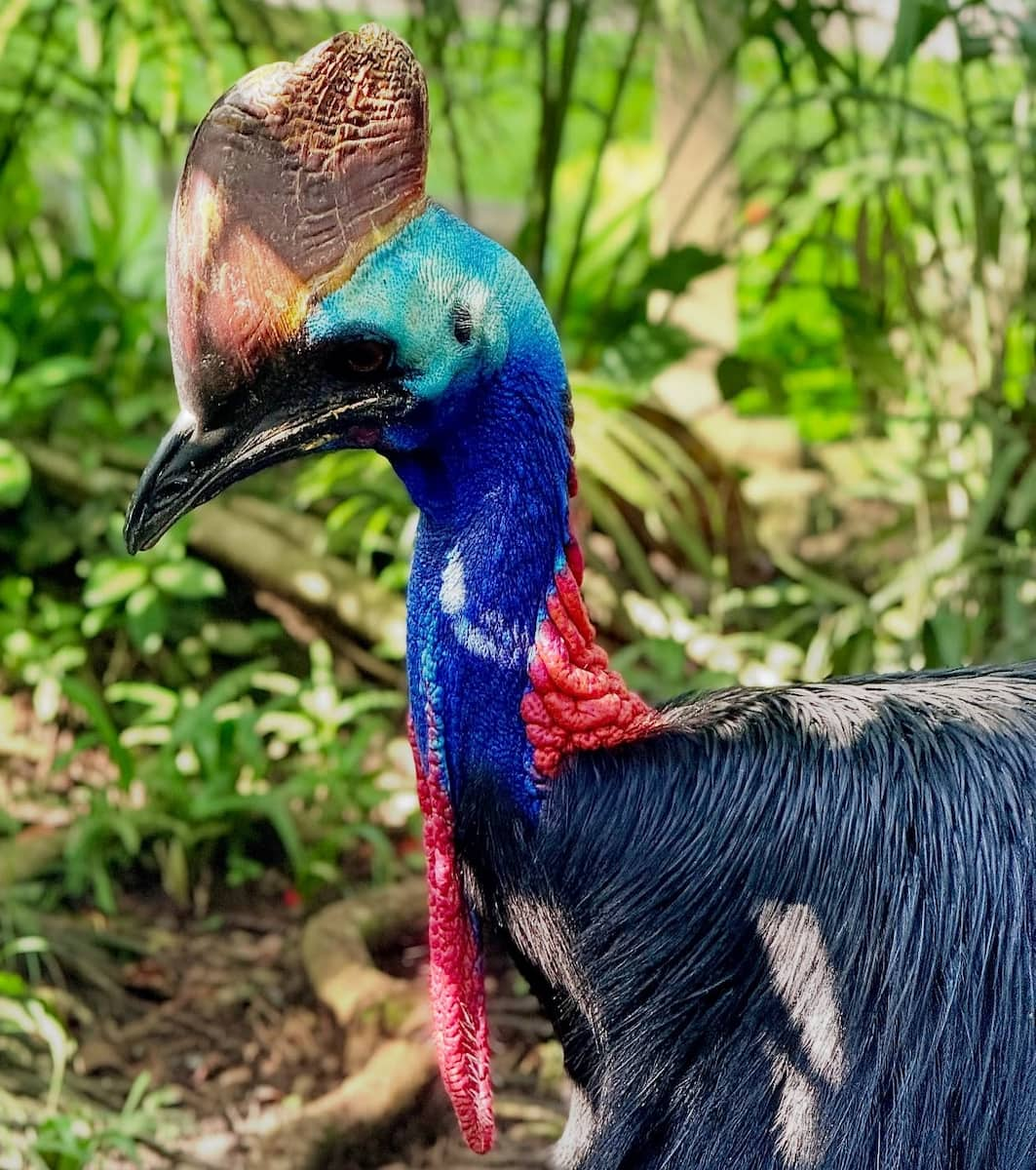
Family Experiences:
- Bali Rainforest Free Flight Bird Show (10:30am & 4pm)
- Basic Instinct Birds of Prey Show (11:30am & 3pm)
- Pelican and lory feeding sessions
- Photo ops with macaws, hornbills, and parrots
- 4D cinema with wildlife films
- Explore seven themed habitats from across the globe
Dining and Practical Tips. The park is well-equipped for families: there are rest areas, clean bathrooms, a bird nursery, and a playground for younger kids. The on-site restaurant serves both local and international dishes, making it easy to refuel between shows. Payment is straightforward — tickets can be booked online for convenience, and there’s no extra fee for bringing your camera. The park is open daily from 9am to 5:30pm, and a visit typically takes 3–4 hours.
| Ticket Type | Price (IDR) | USD (approx) | EUR (approx) |
|---|---|---|---|
| Adult | 385,000 | $26 | €24 |
| Child (2–12 years) | 192,500 | $13 | €12 |
| Family Package (2+2) | 1,970,000 | $133 | €122 |
⭐️ Best Activities
- Bali Bird Park: Entry Ticket – Explore a lush paradise filled with more than 250 bird species, from exotic parrots to majestic eagles. Enjoy interactive sessions, stroll through themed aviaries, and soak up vibrant colors and songs in a setting perfect for all ages. Wheelchair accessible, with free cancellation and rescheduling up to 24 hours before your visit.
Free Entertainment in Bali
1. Campuhan Ridge Walk
Scenic Escape in Ubud. Campuhan Ridge Walk is one of Ubud’s most iconic free attractions, offering a peaceful escape just minutes from the center of town. The trail starts near Pura Gunung Lebah on Jalan Raya Ubud, with a small sign pointing the way. As I set off, I passed the temple and climbed onto the ridge, greeted by panoramic views of lush valleys, rolling hills, and endless greenery. The path is about 2 kilometers one way and mostly flat, though there are a few gentle inclines and some uneven sections.
Nature, Views, and Tranquility. Walking along the ridge, I was surrounded by tall grasses, coconut palms, and the sound of birds and distant rivers. The scenery changes with the seasons — during the rainy months, everything is a vibrant green, while the dry season brings golden grasses and clear skies. Photographers and nature lovers will find plenty of inspiration here, especially at sunrise or sunset when the light casts a magical glow over the landscape.
Highlights Along the Trail:
- Panoramic views of Ubud’s valleys and rice paddies
- Tall grasses, coconut trees, and tropical plants
- Occasional encounters with local farmers and artists
- Karsa Cafe at the halfway point — perfect for a cold drink or snack
- Small swing over the ridge (if staff are present, about 100,000 IDR)
Practical Tips and Facilities. The walk is suitable for most ages and fitness levels, but it’s not stroller-friendly and can be slippery after rain. I recommend wearing comfortable shoes with good grip and bringing water, as there are few places to buy refreshments along the way. The trail is always open and completely free — no entrance fee required. For families, kids who enjoy walking will love the adventure, but keep an eye on little ones near the edges, as there are no railings in some spots.
| Item | Price (IDR) | USD (approx) | EUR (approx) |
|---|---|---|---|
| Entrance Fee | Free | Free | Free |
| Parking (scooter/car) | 5,000 | $0.33 | €0.30 |
| Swing (if available) | 100,000 | $6.50 | €6 |
2. Sanur Beach
Sunrise Walks. Sanur’s coastline is my favorite spot for a peaceful start to the day. The long promenade, lined with brightly painted outrigger boats and shaded by palms, is perfect for a sunrise stroll or morning jog. There’s a gentle buzz as locals and visitors walk, cycle, or simply sit and watch the sky turn gold over the calm sea. The water is protected by a reef, so you’ll find safe, shallow lagoons ideal for swimming, paddleboarding, or even trying a Sea Walker helmet dive. On clear days, Mount Agung rises in the distance, making every photo more dramatic.
Family-Friendly Vibe. Sanur is ideal for families thanks to its soft sand, gentle waves, and shaded areas under tropical trees. Kids can build sandcastles, hunt for shells at low tide, or splash safely in the shallow water. The paved path along the shore is stroller- and wheelchair-friendly, with benches and rest areas for breaks. If you’re feeling active, rent a bike or kayak, or just relax on a sunbed with a cold drink from a local café. The whole area feels laid-back and safe, a world away from the crowds of Kuta or Seminyak.
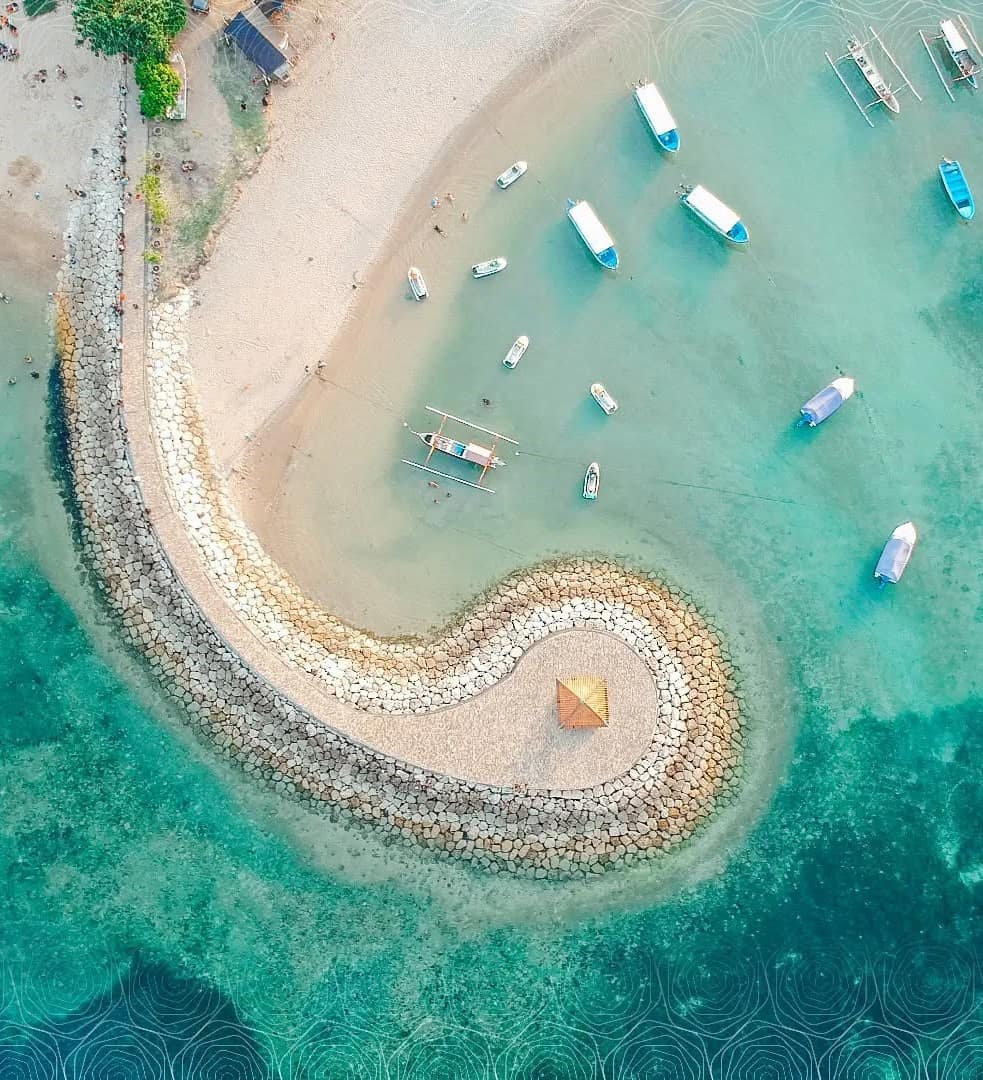
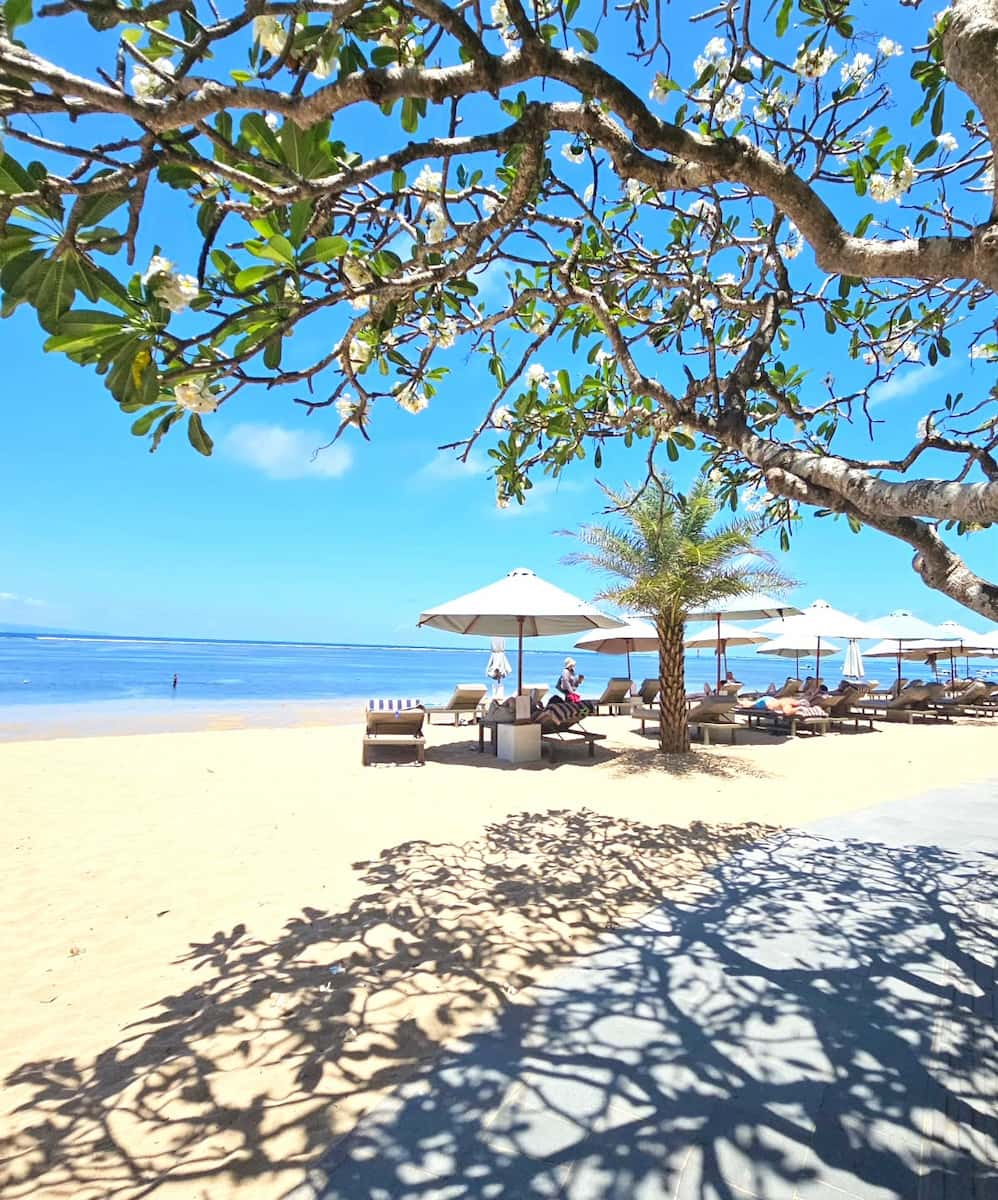
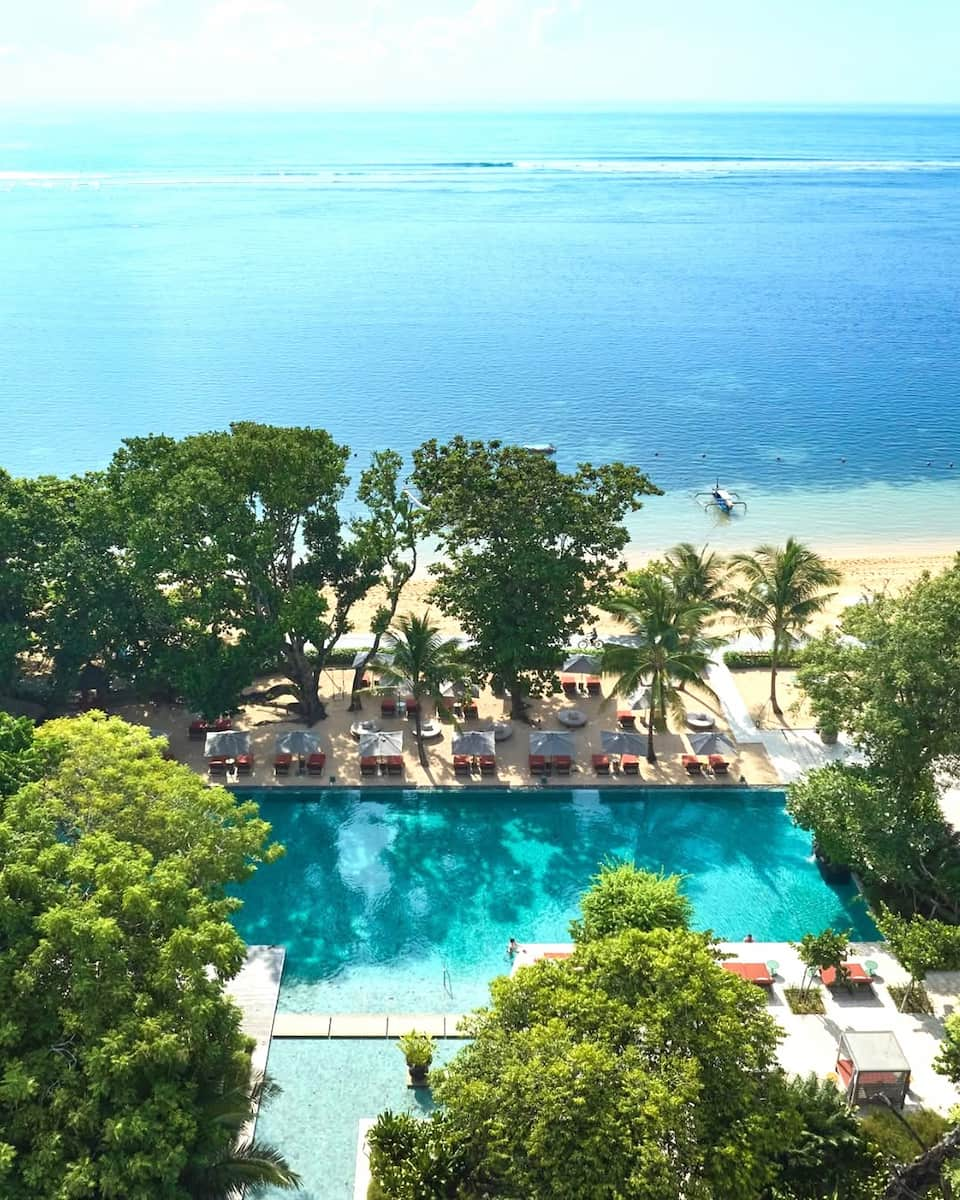
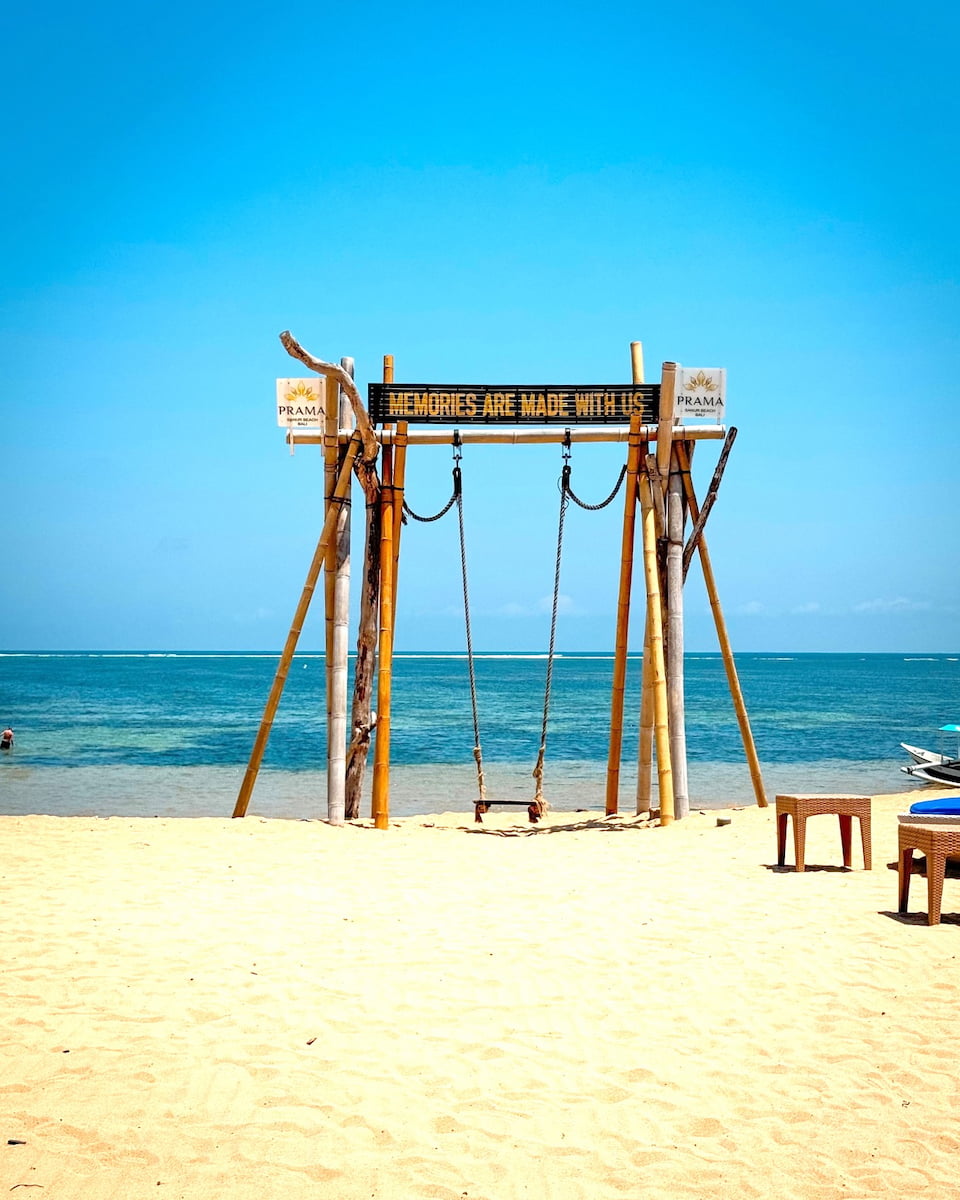
Markets, Culture, and Festivals. A walk in Sanur isn’t just about the sea. The area is dotted with lively markets and cultural spots, and you’ll often see locals bringing offerings and praying by the water. If you visit in July, don’t miss the Bali Kite Festival — a colorful spectacle of giant kites soaring above the sand.
Sanur Highlights:
- Sunrise walks or cycling along the promenade
- Shell hunting and sandcastle building with kids
- Watching fishermen bring in their morning catch
- Exploring the Sanur Night Market for snacks and souvenirs
- Visiting the Turtle Conservation and Education Centre
Getting There. Sanur is easy to reach — about 20 minutes from Ngurah Rai International Airport or a short drive from Denpasar. Parking is available but fills up quickly on weekends, so consider using ride-hailing apps or arriving early. The promenade is lined with cafes, restaurants, and shops, so you’re never far from a snack or a cool drink. Sunbed rentals cost around 50,000–100,000 IDR ($3–$6.50/€2.80–€6), but access to the shoreline and promenade is always free.
| Activity/Service | Price (IDR) | USD (approx) | EUR (approx) |
|---|---|---|---|
| Sunbed Rental | 50,000–100,000 | $3–$6.50 | €2.80–€6 |
| Paddleboard/Kayak Rental | 200,000/hour | $13 | €12 |
| Sea Walker Experience | 550,000+ | $36+ | €33+ |
| Parking (car/scooter) | 5,000–10,000 | $0.33–$0.65 | €0.30–€0.60 |
| Entrance | Free | Free | Free |
3. Lapangan Niti Mandala Renon
Green Heart of Denpasar. Lapangan Niti Mandala Renon is Denpasar’s answer to Central Park — a vast, open space right in the city’s center, perfect for anyone wanting a break from Bali’s busier scenes. The park is surrounded by wide, tree-lined paths and grassy lawns, with the impressive Bajra Sandhi Monument rising at its core. I love coming here early in the morning or late afternoon, when the air is cool and locals gather for jogging, tai chi, or group aerobics. The vibe is friendly and community-focused, and you’ll see everyone from students to grandparents enjoying the fresh air.
Active Mornings and Afternoons. This is the place where Denpasar comes alive. On Sundays, the park is car-free, and the paths fill with joggers, cyclists, and families out for a stroll. There’s a dedicated running track, outdoor gym equipment, and plenty of space for yoga or a casual football match. I often see groups practicing traditional dances or martial arts under the trees — sometimes you can even join in! The lawns are perfect for a picnic, and street vendors sell snacks like bakso (meatball soup), fresh fruit, and iced tea.
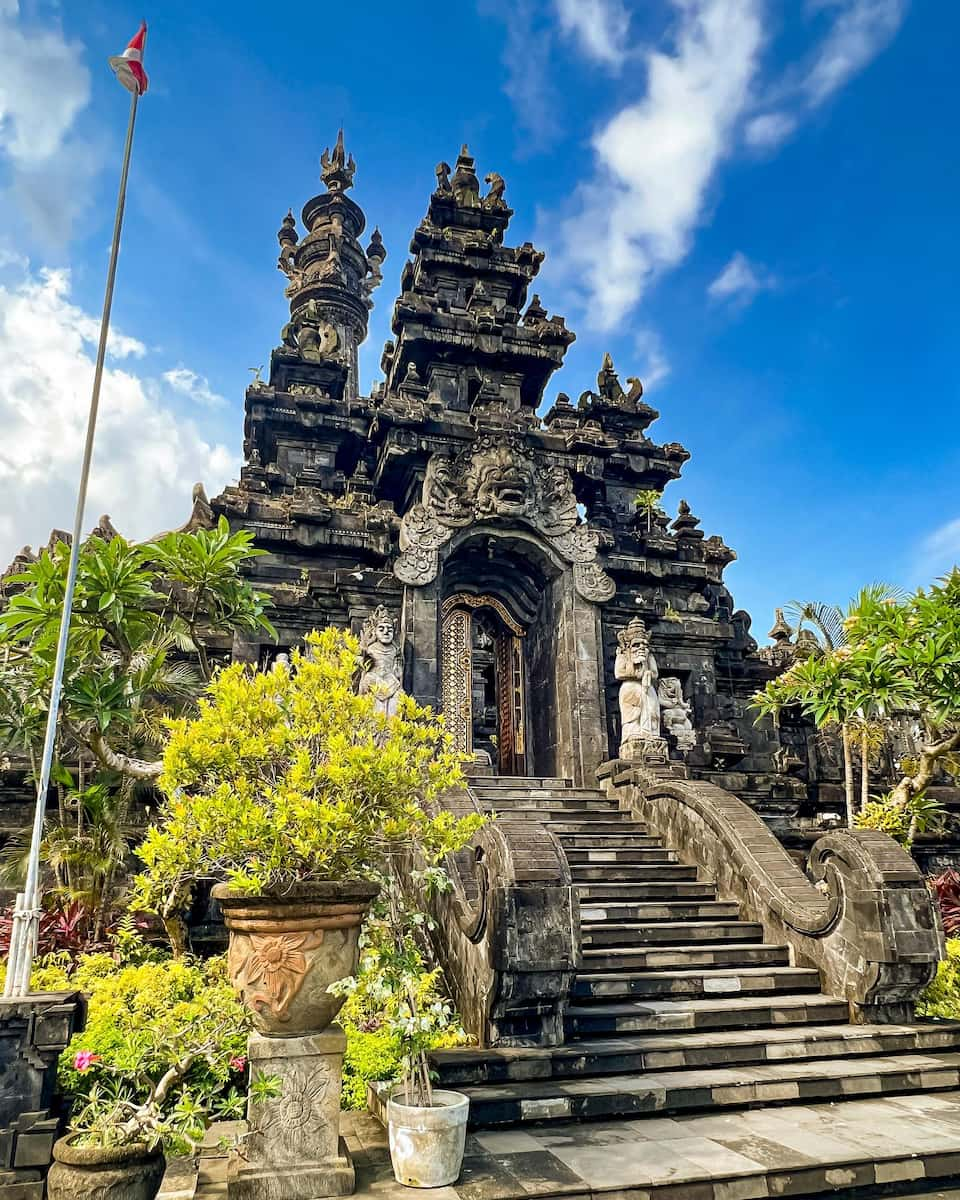
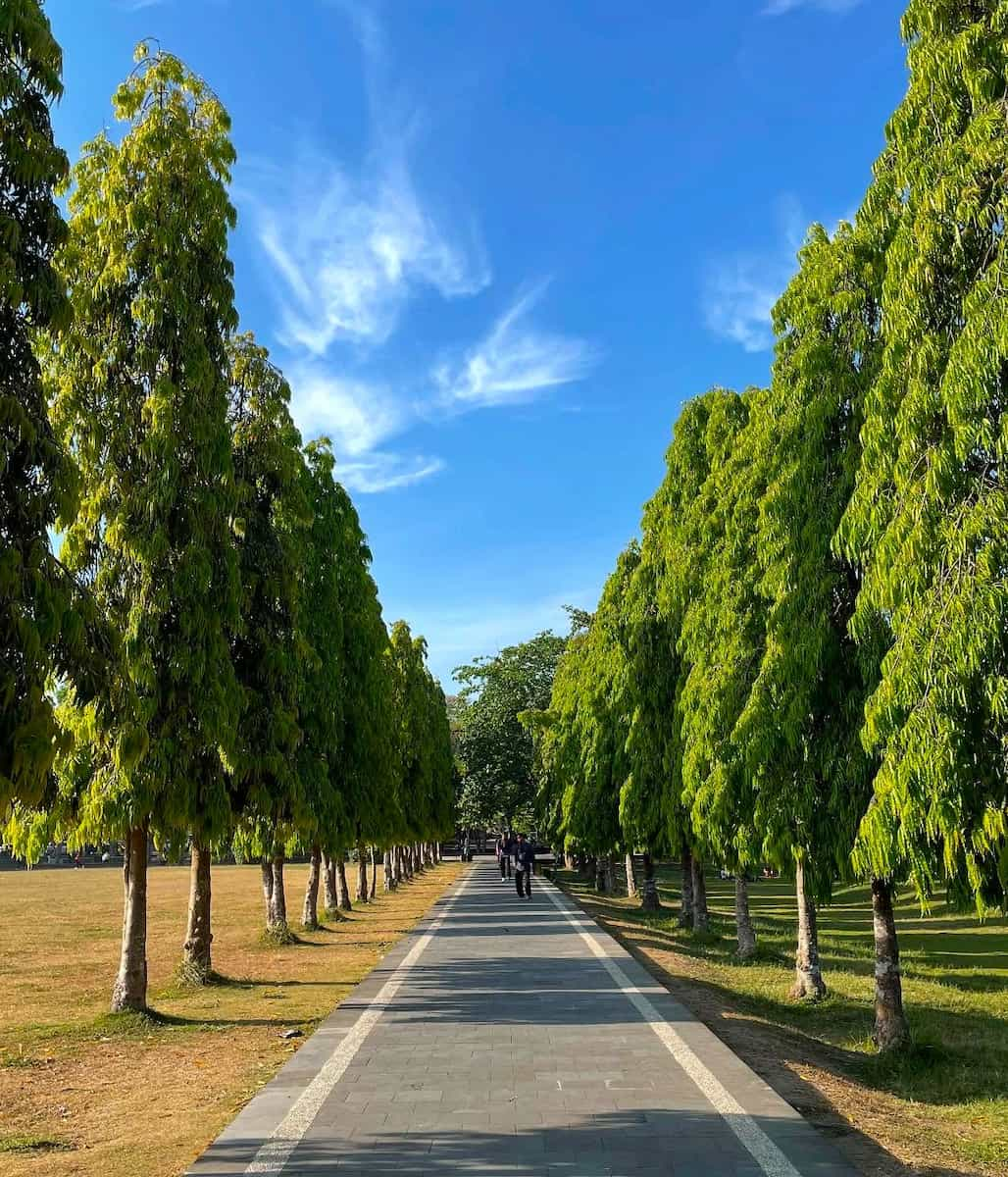
Best Highlights:
- Jogging and cycling tracks
- Outdoor gym and fitness classes
- Family picnics and playgrounds
- Street food vendors and local snacks
- Cultural performances and weekend events
- Bajra Sandhi Monument for history and panoramic views
Prices and Getting There. The park is free to enter and open all day, with public toilets, shaded benches, and parking for cars and scooters (5,000–10,000 IDR/$0.33–$0.65/€0.30–€0.60). It’s easy to reach by taxi or ride-hailing app from anywhere in Denpasar or Sanur. The area is safe and well-lit, making it a great spot for an evening walk or a casual meet-up with friends.
| Service/Facility | Price (IDR) | USD (approx) | EUR (approx) |
|---|---|---|---|
| Entry | Free | Free | Free |
| Parking (car/scooter) | 5,000–10,000 | $0.33–$0.65 | €0.30–€0.60 |
| Fitness Classes | Free–50,000 | Free–$3.20 | Free–€3 |
| Street Food | 10,000–30,000 | $0.65–$2 | €0.60–€1.80 |
4. Penglipuran Village
Traditions and Tranquil Paths. Penglipuran Village in Bangli is often called one of the cleanest and most beautiful traditional villages in Bali. From the moment I arrived, I felt a peaceful, calm atmosphere — orderly rows of houses, friendly locals, and a sense of pride in every detail. The village is famous for its neat stone-paved street, lined with identical gates and lush gardens. Each home follows ancient architectural rules, and the community works together to preserve customs that go back centuries.
Cultural and Outdoor Strolls. As I wandered the main street (outside only), I saw visitors taking photos, chatting with residents, and exploring small shops selling snacks, crafts, and drinks. Renting traditional clothes is a fun way to feel like a local and snap memorable pictures. The village is lively but never chaotic — there’s always a gentle buzz from people enjoying the scenery and learning about daily rituals, ceremonies, and craftsmanship. You can peek at artisans weaving bamboo or carving wood, and sometimes catch a music or dance workshop in progress.
Highlights of Penglipuran Village:
- Admire the identical gates and well-kept gardens
- Rent traditional clothes for photos
- Watch local artisans at work (weaving, carving)
- Sample Loloh Cemcem (a local herbal drink)
- Visit the bamboo forest just outside the village for a peaceful nature walk
Practical Info. Penglipuran is open daily from 8:15 a.m. to 6:30 p.m. The entrance fee is 50,000 IDR for adults and 30,000 IDR for children, with parking costing 5,000 IDR for cars or 2,000 IDR for scooters. No guide is required, but locals are happy to share stories for a small tip. There are plenty of places to buy souvenirs, snacks, and drinks, and a cozy coffee shop at the end of the main street. The bamboo forest nearby is a must for anyone wanting a quiet escape or a unique photo spot.
| Type | Price (IDR) | USD (approx) | EUR (approx) |
|---|---|---|---|
| Adult Entry | 50,000 | $3.20 | €3 |
| Child Entry | 30,000 | $1.90 | €1.70 |
| Parking (car/scooter) | 5,000/2,000 | $0.33/$0.13 | €0.30/€0.12 |
Seasonal Events in Bali
Spring: Nyepi
The Most Unusual Day. Nyepi, the “Day of Silence,” is Bali’s most extraordinary event and the highlight of spring on the island. Every March or April, the entire island enters a 24-hour period of stillness and introspection. Streets empty, the airport closes, and even the internet and TV may go dark. From 6 a.m. to 6 a.m. the next day, everyone — locals and visitors alike — must remain indoors, keep lights dimmed, and avoid noise or entertainment. It’s a powerful pause, rooted in the Saka lunar calendar, marking the Balinese New Year and a spiritual reset for the whole community.
Rituals and Wild Parades. The days leading up to Nyepi are a whirlwind of color and sound. The Melasti ceremony sees villagers in white clothing carrying sacred objects to the sea for purification. The night before Nyepi, the Ogoh-Ogoh parade takes over: huge, monstrous statues representing evil spirits are marched through towns, accompanied by gamelan music and the banging of pots and pans. In some villages, these effigies are burned in a dramatic ritual to drive away negativity and cleanse the island for the year ahead.
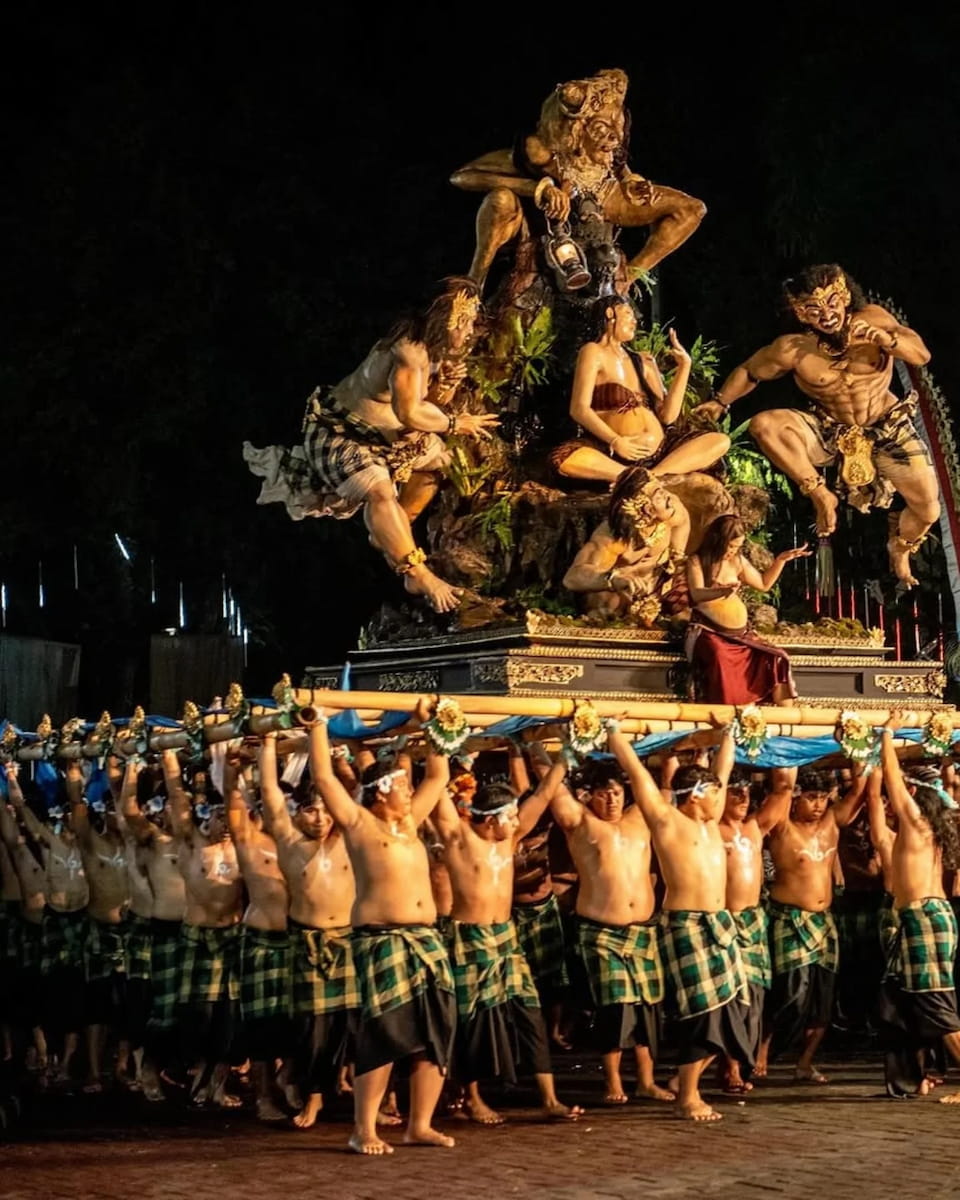
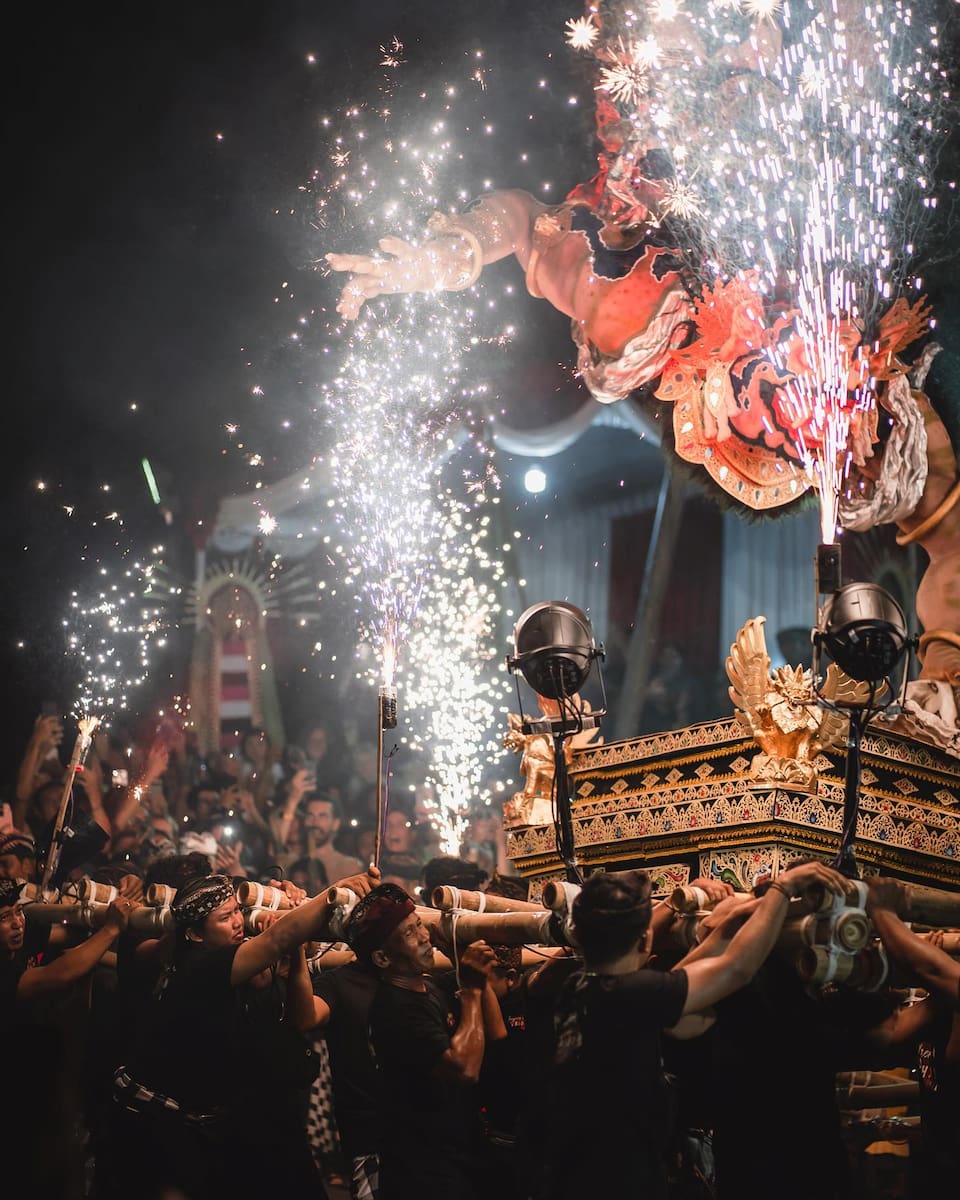
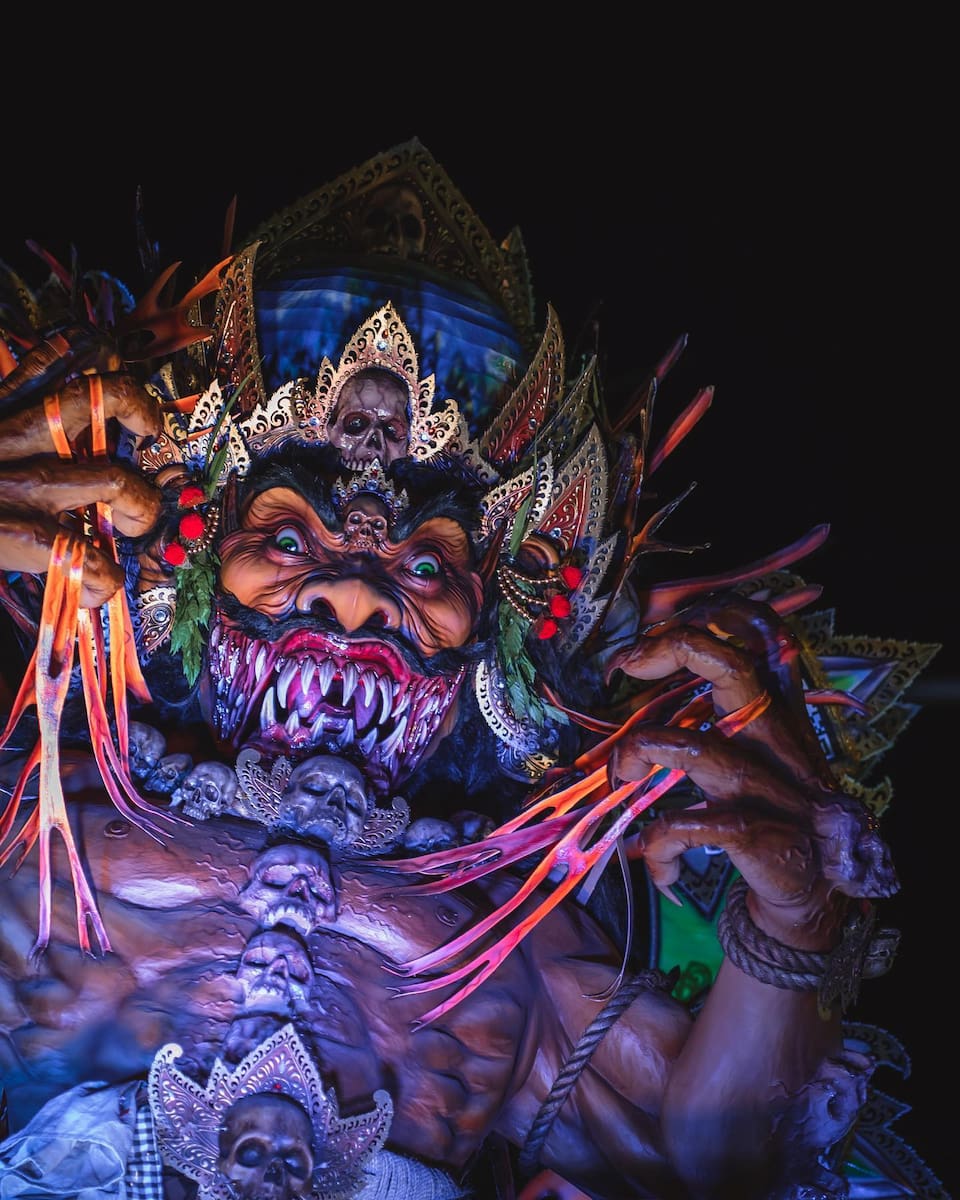
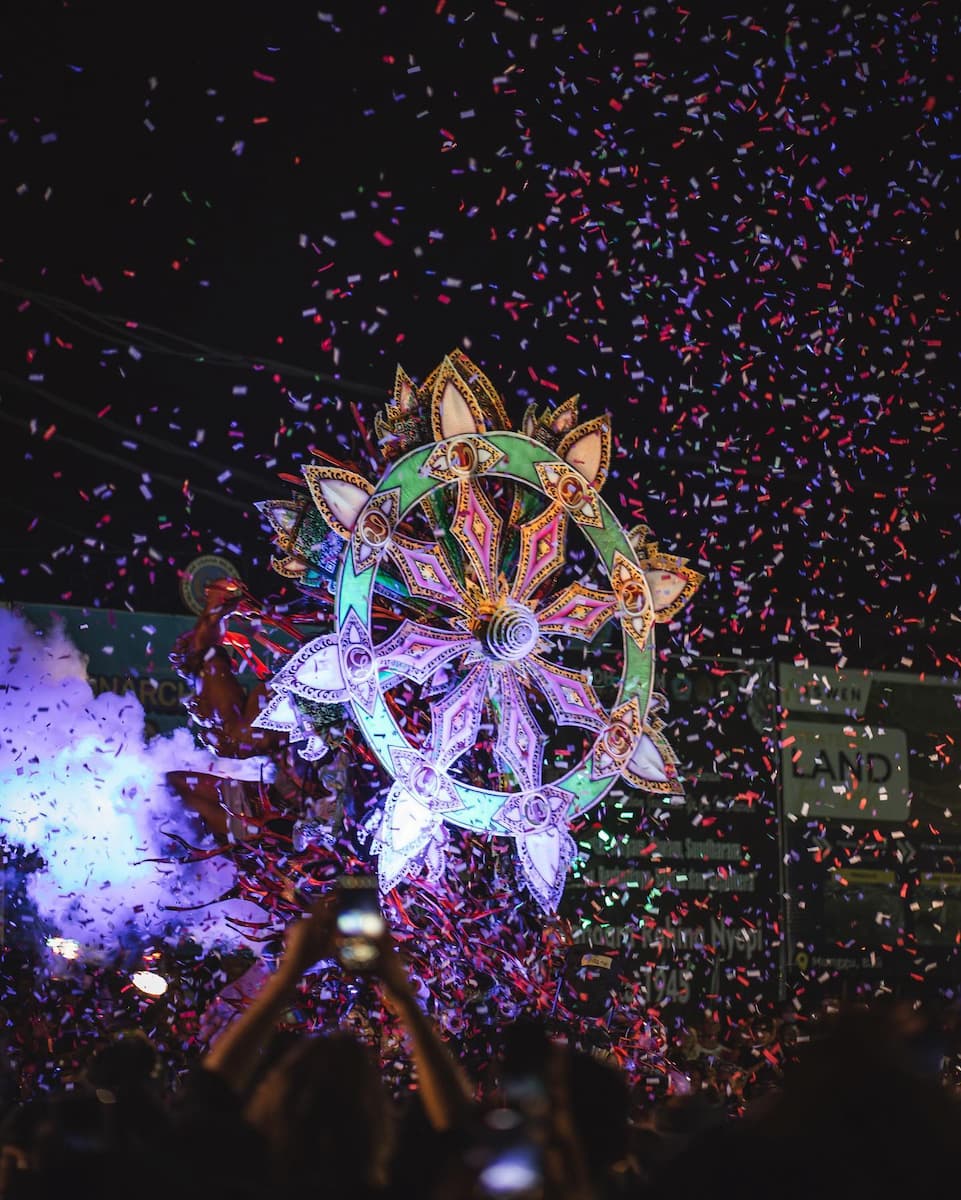
Day Rules for Everyone. On Nyepi itself, Bali enforces four main restrictions, known as Catur Brata Penyepian:
- No travel: Everyone stays inside their accommodation — no walking, driving, or outdoor activity.
- No lights: Lights must be kept off or dimmed, with curtains drawn.
- No work: All businesses, shops, and restaurants are closed.
- No noise or entertainment: The island embraces complete silence and reflection.
How to Prepare. If you’re in Bali for Nyepi, plan ahead! Stock up on food, water, and essentials before the silence begins, as all shops and restaurants will close. Choose accommodation with good amenities, as you’ll be there for the full 24 hours. Most hotels offer special packages, quiet activities, and in-room dining. Bookings require at least a two-night stay, and check-ins or check-outs are not allowed during Nyepi. Keep your lights low, avoid loud conversations, and embrace the rare chance to disconnect and reflect.
| Essential Prep for Nyepi | Price (IDR) | USD (approx) | EUR (approx) |
|---|---|---|---|
| Entry/Participation | Free | Free | Free |
| Food & Supplies | Varies | Varies | Varies |
| Accommodation (per night) | 500,000+ | $32+ | €29+ |
Summer: Bali Arts Festival
Month of Culture and Color. Every summer, the Bali Arts Festival transforms Denpasar into the island’s creative heart. For a whole month — this year from June 15 to July 13 — the Taman Werdhi Budaya Art Centre bursts with music, dance, and visual arts. I always feel a buzz in the air as artists, musicians, and dancers from every corner of Bali gather to share their traditions and new creations. The festival’s goal is to preserve and celebrate Balinese heritage, and after more than four decades, it’s still the island’s most important cultural event.
Parades and Daily Performances. The opening parade (Peed Aya) is a highlight — imagine a river of color and sound flowing past the Bajra Sandhi Monument, with troupes in dazzling costumes, gamelan orchestras, and giant puppets representing Bali’s regencies. Each day, the Art Centre’s stages host everything from the hypnotic Kecak fire dance to graceful Legong and Barong performances, plus shadow puppetry, music competitions, and art exhibitions. I love wandering between open-air pavilions, catching impromptu dance battles and listening to the deep, metallic tones of gamelan music drifting through the gardens.
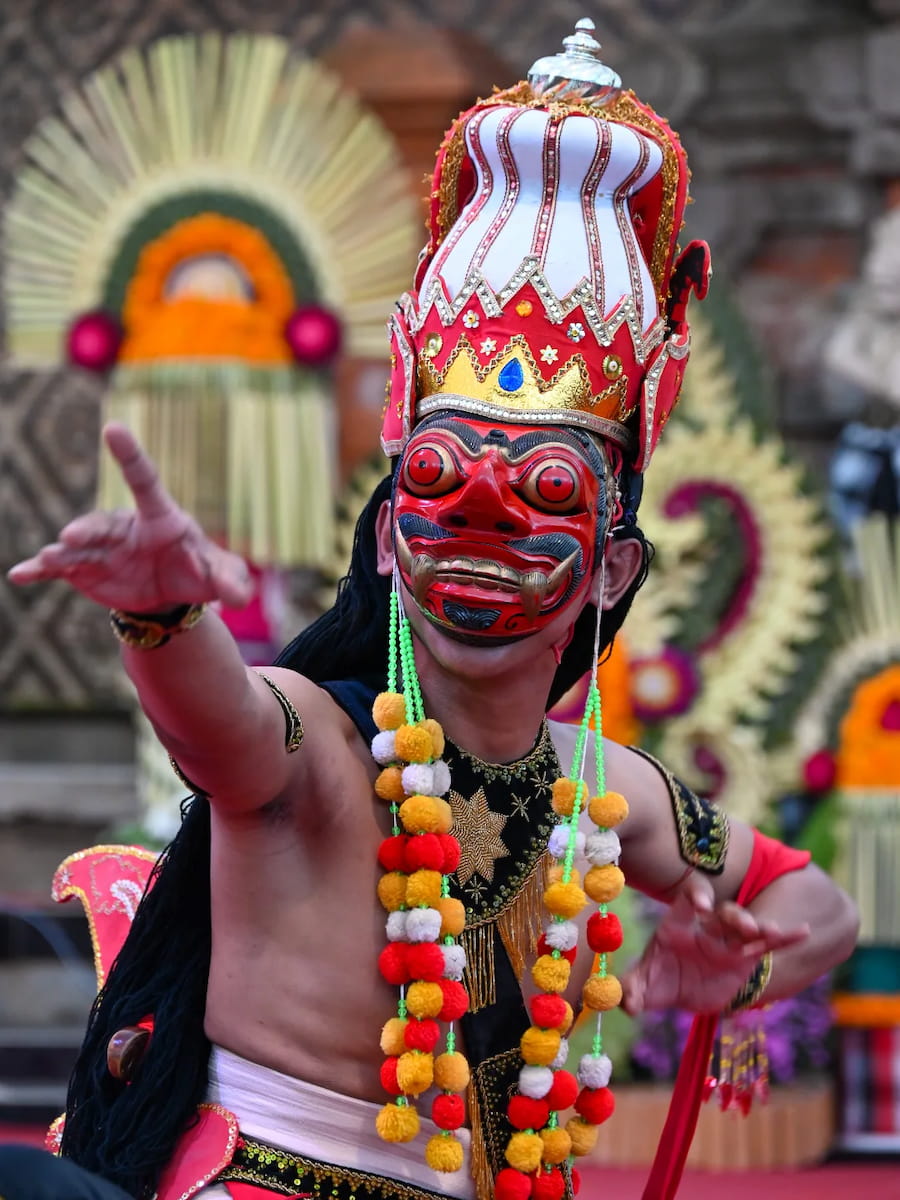
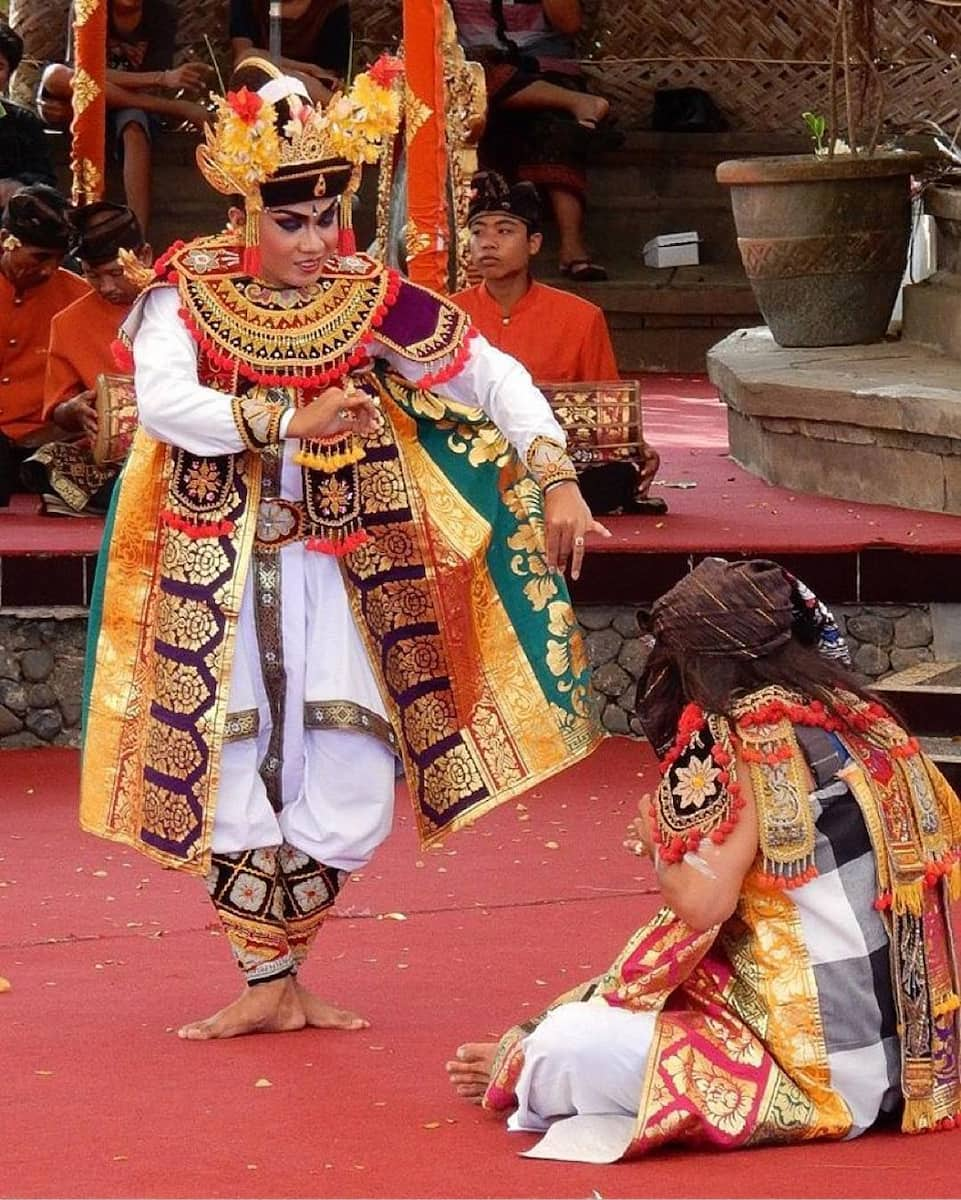
Festival Highlights for Visitors:
- Grand opening parade at Bajra Sandhi Monument
- Daily traditional dances (Legong, Barong, Kecak, Topeng)
- Art exhibitions: painting, wood carving, textile crafts
- Interactive workshops: batik, mask-making, gamelan
- Culinary stalls with Babi Guling, Satay Lilit, and Lawar
- Closing ceremony with a dramatic Sendratari ballet
Free Entry. Here’s the best part: almost everything is free — no tickets needed for performances, workshops, or exhibitions. Just show up early, especially for popular shows or the grand parade, as seats fill up fast. The Art Centre is easy to reach by taxi, ride-hailing apps, or bus (KOR. 4B stops nearby). Parking is available but limited, so I recommend arriving by public transport if possible. Food stalls and markets on site mean you can sample local snacks and buy handmade souvenirs without leaving the festival grounds.
| Experience | Price (IDR) | USD (approx) | EUR (approx) |
|---|---|---|---|
| Entry/Performances | Free | Free | Free |
| Workshop Participation | Free | Free | Free |
| Food Stalls (per meal) | 30,000–80,000 | $2–$5.20 | €1.80–€4.80 |
| Parking | 5,000–10,000 | $0.33–$0.65 | €0.30–€0.60 |
Fall: Rice Harvest Festival
Abundance and Gratitude. Every fall, Bali’s countryside comes alive with the Rice Harvest Festival, a vibrant celebration rooted in Hindu tradition and the island’s agricultural cycle. From May through June, villages across Bali honor Dewi Sri, the rice goddess, with colorful rituals, music, and feasting. The timing follows the New Year, and the festival is a way for communities to give thanks for a successful harvest and pray for future abundance. You’ll spot fields dotted with effigies of Dewi Sri, bamboo shrines, and flags fluttering in the breeze — a true feast for the senses.
Rituals, Offerings, and Community. The festival isn’t just about the rice — it’s about the people, too. Throughout the harvest, farmers and their families gather for ceremonies at small shrines in the rice fields, offering flowers, fruit, and colorful rice cakes to Dewi Sri. The “first fruits ritual” is particularly special: rice dolls called Cili are crafted from the first stalks and placed in granaries or homes to ensure prosperity. The upstream corner of each rice field is considered sacred, and offerings are made here to bless the land. The whole process is deeply communal, with neighbors working side by side and sharing meals after the day’s work.

Festival Highlights:
- Villages decorated with flags and bamboo shrines
- Effigies and rice dolls honoring Dewi Sri
- Traditional bull races (Negara Bull Races) in Perancak
- Shadow puppet plays and live music performances
- Food stalls serving jaja (colorful rice cakes), satay, and local specialties
Where to Experience. Some of the best places to witness the Rice Harvest Festival are the lush fields of Jatiluwih, Tirta Gangga, Sidemen, and the UNESCO-listed Jatiluwih Rice Terraces. During the festival, these areas host art performances, agricultural demonstrations, and competitions for all ages. At Jatiluwih, for example, you can join in the celebrations for free after paying the standard entry fee (IDR 50,000 for adults, IDR 40,000 for children). The festivities often spill into the evening, with music, dance, and food stalls open until late.
| Experience/Service | Price (IDR) | USD | EUR |
|---|---|---|---|
| Jatiluwih Entry (adult/child) | 50,000/40,000 | $3.20/$2.60 | €3/€2.40 |
| Negara Bull Race (spectator) | Free | Free | Free |
| Local Food Stalls (per meal) | 20,000–60,000 | $1.30–$4 | €1.20–€3.60 |
Winter: Christmas & New Year’s Beach Parties
Tropical Festivities. Christmas and New Year’s in Bali are legendary — imagine palm trees wrapped in fairy lights, fireworks bursting over the ocean, and the island’s best spots buzzing with celebration. From the moment December arrives, Bali transforms into a festive playground. Whether you’re planning a trip to Bali for the holidays or just want to tick off a bucket list experience, the year-end season is the perfect time to explore Bali’s best attractions, join epic parties, and soak up the tropical cheer.
Christmas Cheer, Island Style. Christmas Day in Bali is a unique blend of tradition and tropical fun. Resorts and restaurants across central Bali, east Bali, and north Bali host festive brunches, live music, and even visits from Santa for the kids. Atlas Beach Club, Finns, Potato Head, and Ku De Ta are just a few of the best spots for Christmas Eve dinners, sunset cocktails, and themed events with ocean views. Many places in Bali also offer Christmas Masses and family-friendly activities, from treasure hunts to crafts. Don’t be surprised to see fireworks lighting up the sky after dinner, or to find yourself dancing barefoot to live bands at one of the island’s popular attractions in Bali.

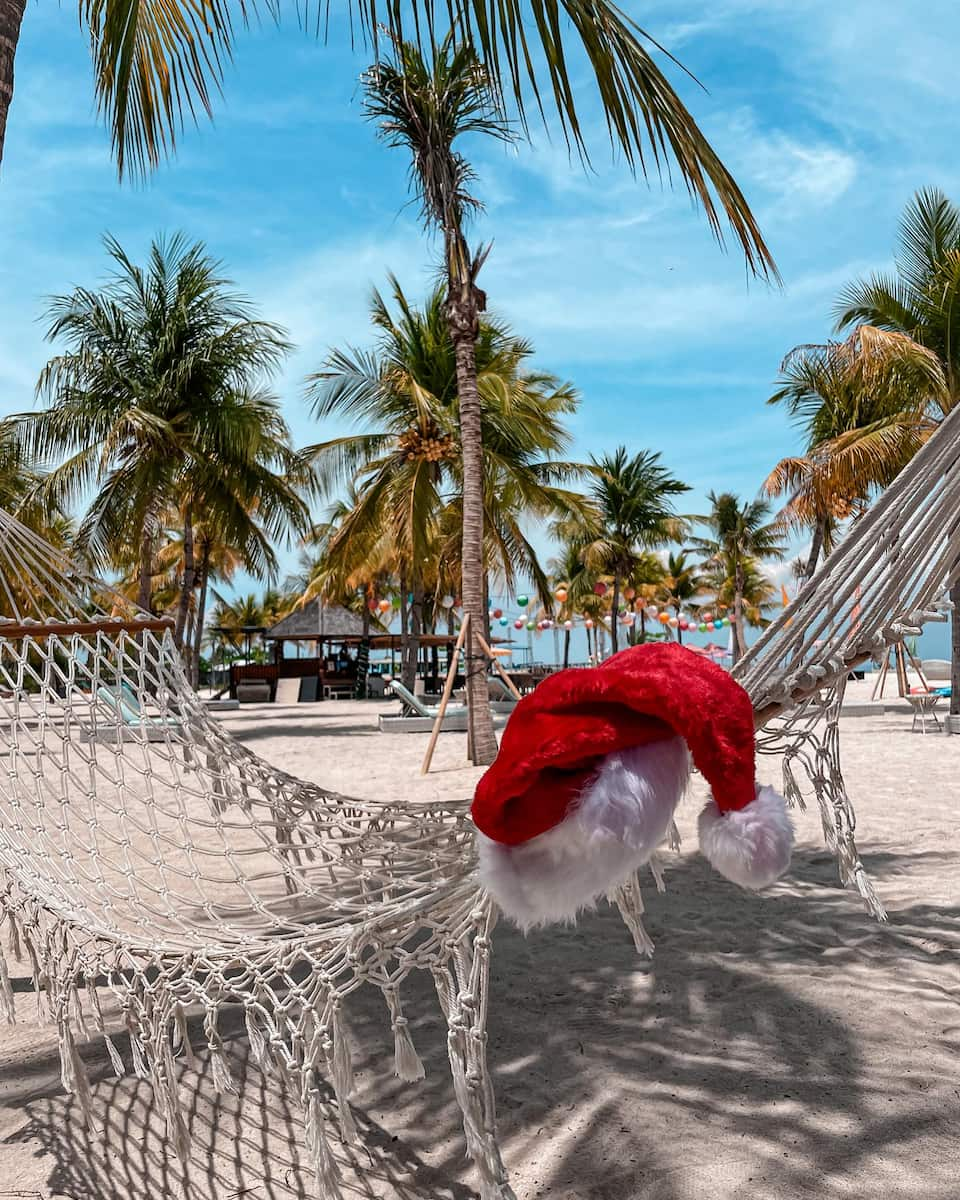
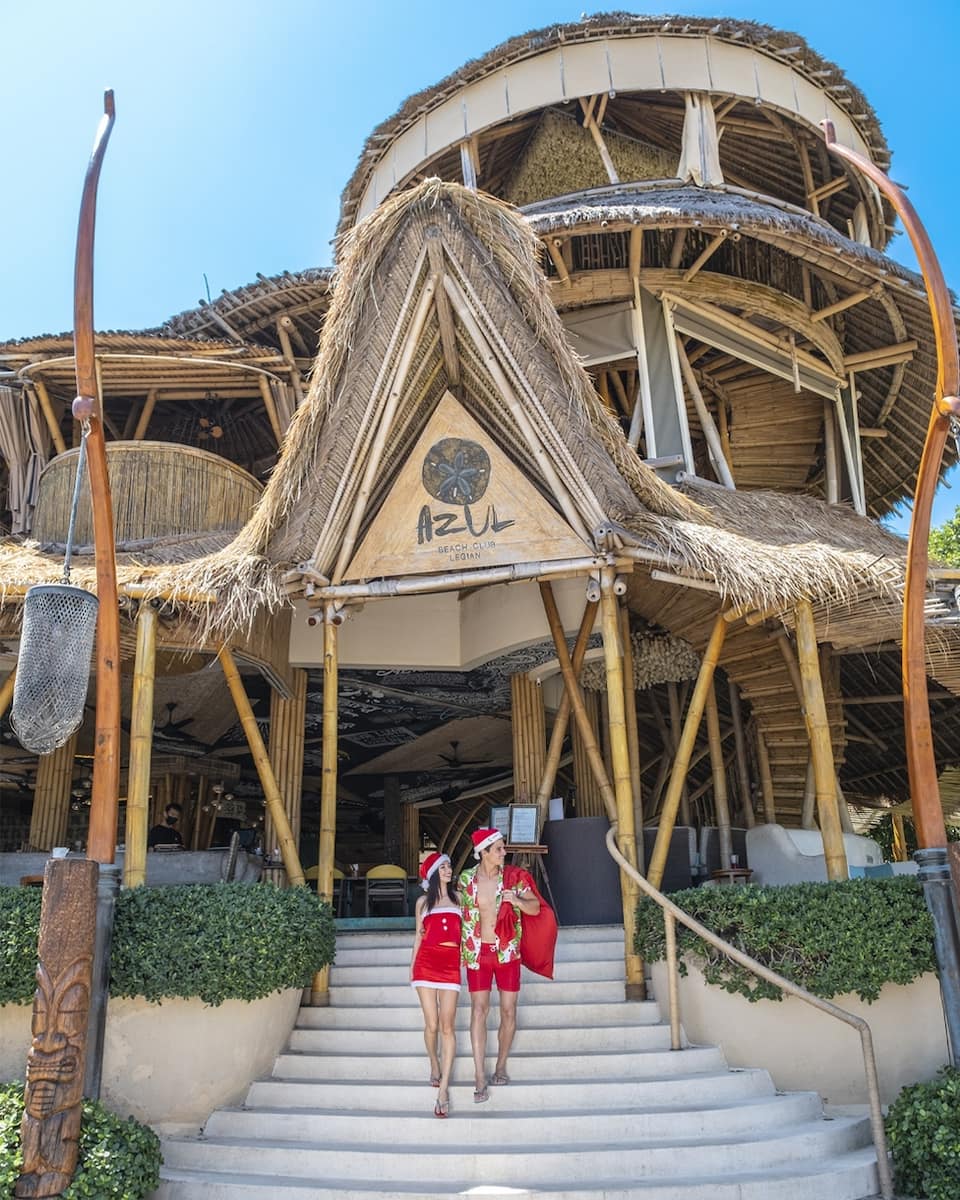
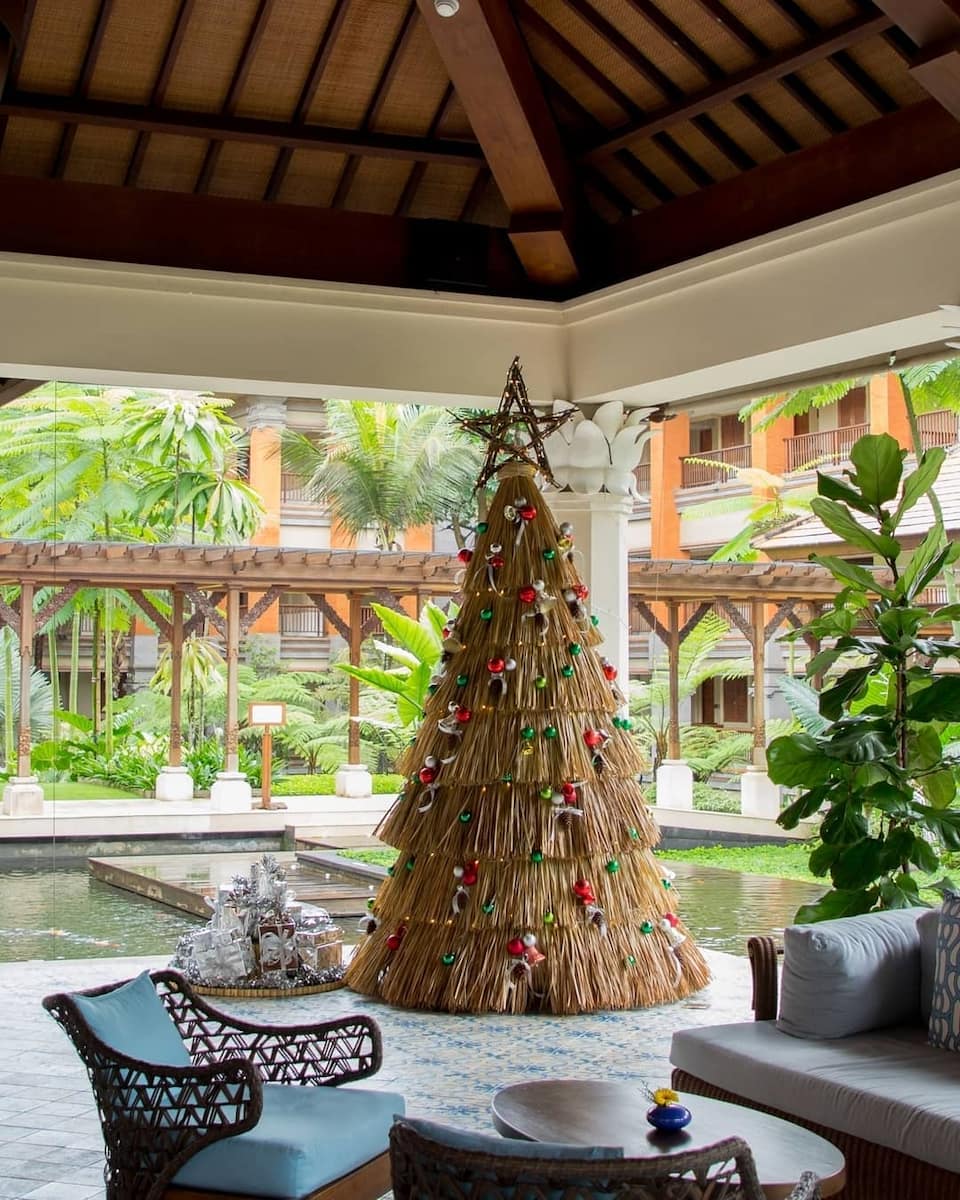
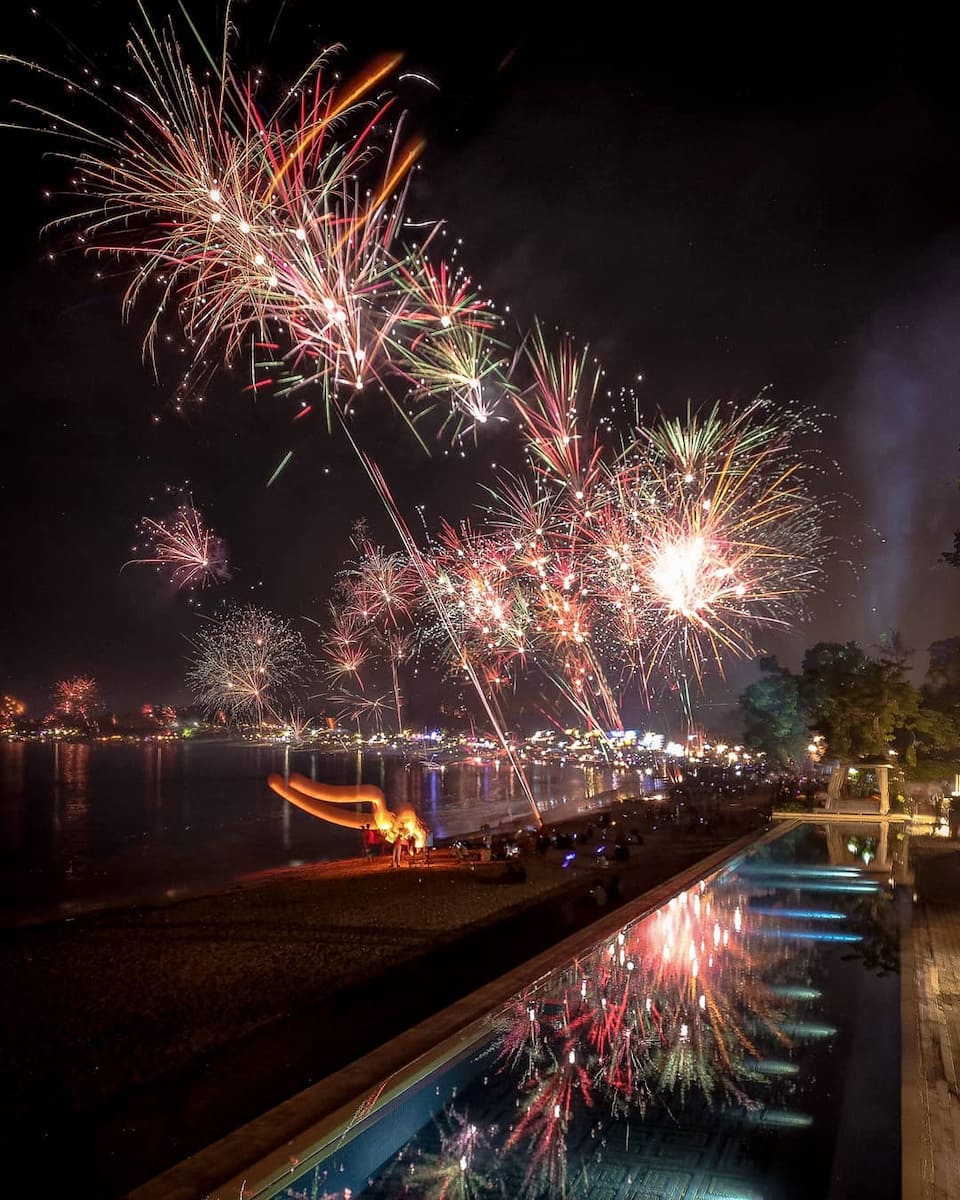
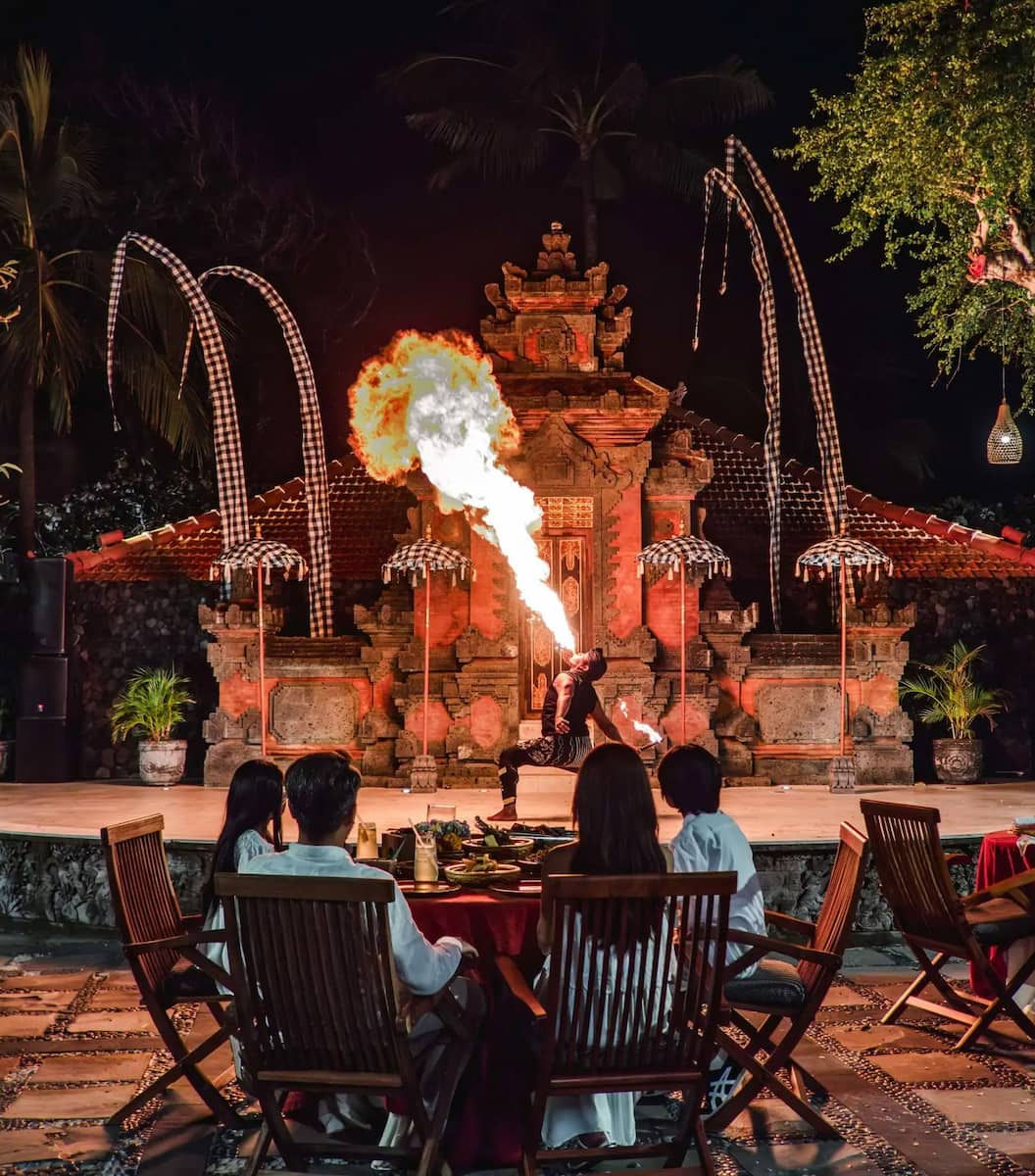
New Year’s Eve. When it comes to ringing in the New Year, Bali’s best beach clubs and hotels pull out all the stops. The countdown is marked by world-class DJs, live bands, and jaw-dropping fireworks displays at iconic venues like Atlas Beach Club, Potato Head, Finns, Mari, and Savaya. Each club has its own flavor — Canggu is trendy and energetic, Seminyak is upscale, and Uluwatu offers dramatic cliffside views. For a more relaxed vibe, family-friendly parties and cultural performances can be found at Sundays, The Lawn, and beachfront resorts in Nusa Dua. Book tickets early — many events sell out weeks in advance, and prices can range from IDR 150,000 for a pool party to over IDR 3,000,000 for gala dinners and VIP experiences.
Highlights of Bali’s Christmas & New Year’s Season:
- Christmas brunches and dinners at top hotels (from IDR 395,000–1,750,000 per person)
- Fireworks and DJ sets at Finns, Atlas, Potato Head, and Savaya (entry from IDR 150,000–3,000,000)
- Family-friendly events: Santa visits, treasure hunts, and craft workshops
- Iconic sunset countdowns and after-parties across central and west Bali
- Cultural performances and live music at resorts and clubs
| Event/Experience | Price (IDR) | USD (approx) | EUR (approx) |
|---|---|---|---|
| Christmas Buffet (adult/child) | 395,000–1,750,000 | $26–$115 | €24–€110 |
| NYE Party Entry (club) | 150,000–3,000,000 | $10–$195 | €9–€180 |
| Gala Dinner (NYE) | 1,200,000–4,600,000 | $78–$300 | €72–€290 |
Day Trips from Bali
1. Nusa Lembongan
Island Escape. Nusa Lembongan is a dreamy island in Indonesia, just a 40-minute ferry ride from Sanur or Benoa in Bali. As soon as I arrived, I felt the difference — no traffic jams, no crowds, just a laid-back vibe and friendly locals. The island is small enough to explore by scooter, bike, or even on foot. One of my favorite travel tips is to rent a scooter for about 75,000–100,000 IDR ($5–$7/€4.50–€6.50) per day and cruise along the quiet roads, stopping at hidden coves and local warungs for fresh seafood or nasi campur.
Snorkeling and Marine Life. If snorkeling is on your Bali adventure list, Lembongan Island is a must. The waters here are some of the clearest I’ve seen, with vibrant coral gardens and colorful fish at spots like Mangrove Point, Mushroom Bay, and Crystal Bay. Many tours include stops at Manta Bay, where you might spot giant manta rays gliding gracefully through the water. I joined a group trip (around 300,000–500,000 IDR/$20–$32/€18–€29) and was blown away by the marine life — parrotfish, turtles, and even the occasional sea snake. Most tours include equipment, a guide, and sometimes lunch or snacks.
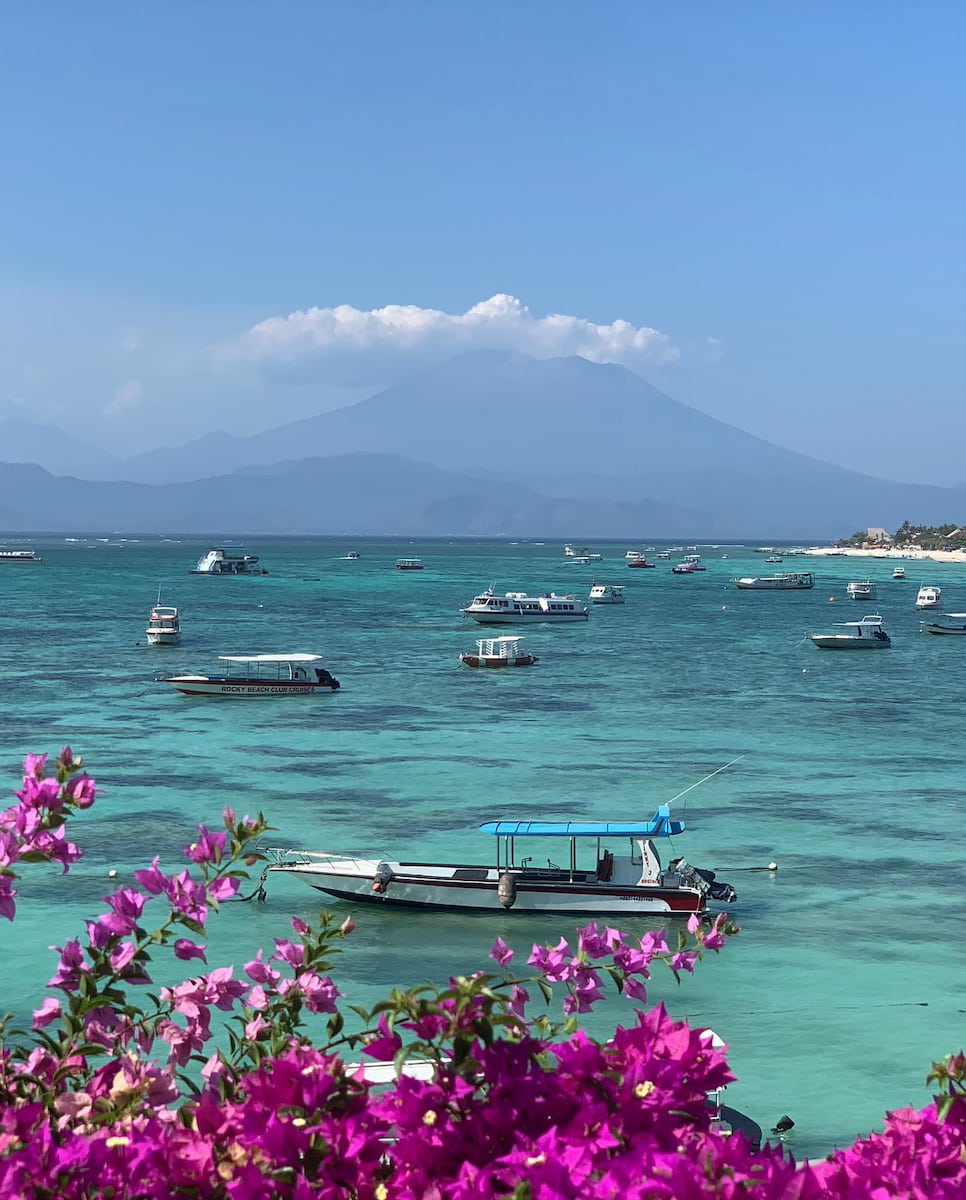
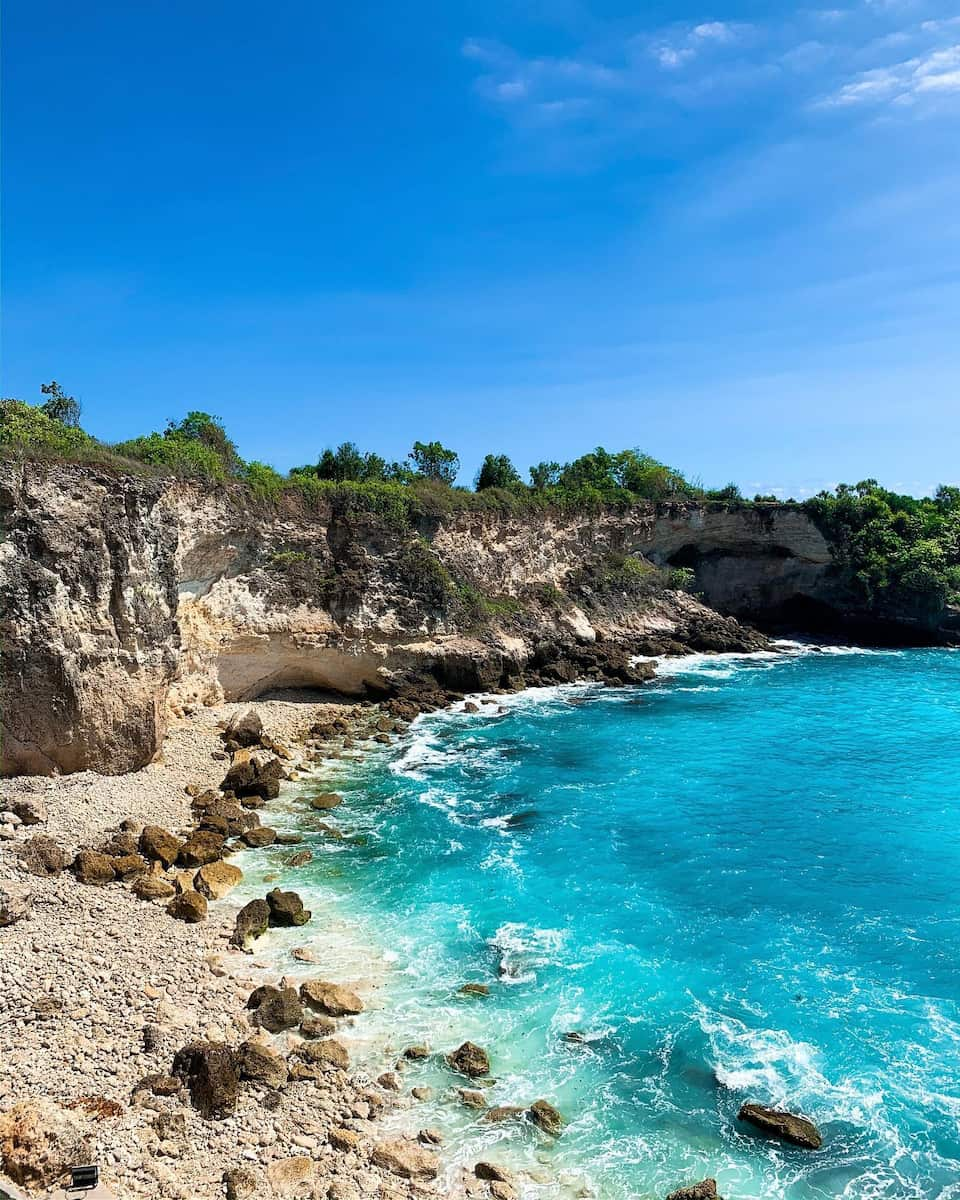
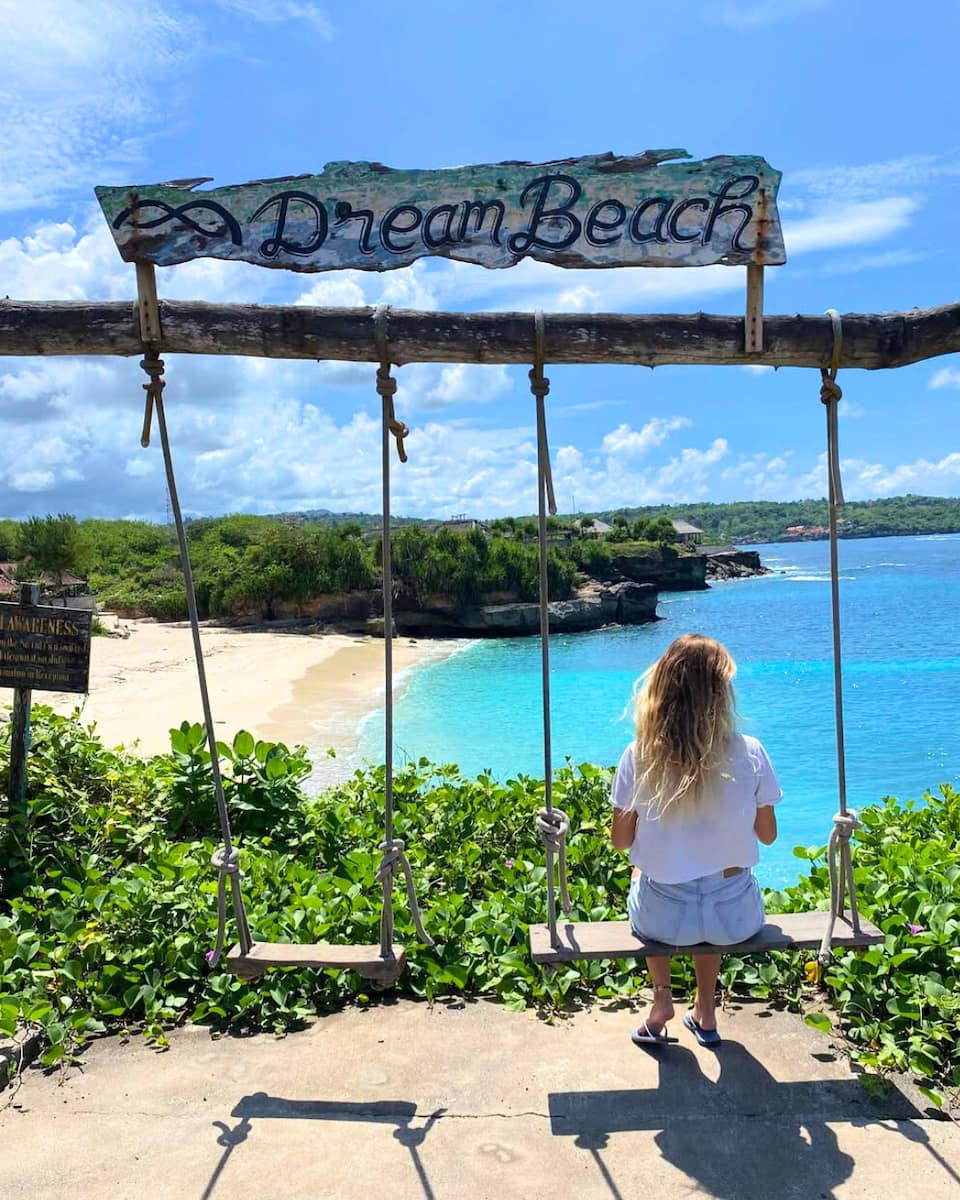
Island Highlights. Beyond the water, Nusa Lembongan is packed with unique spots in Bali. The iconic Yellow Bridge connects the island to tiny Nusa Ceningan — cross it by scooter or on foot for epic views and easy access to more hidden gems. Don’t miss Devil’s Tears, where waves crash dramatically against the cliffs, or Dream Beach and Mahagiri for sunbathing and swimming. The mangrove forest on the northeast coast is perfect for kayaking or stand-up paddleboarding, and the viewpoint above Jungutbatu offers some of the best views of Mount Agung on a clear day.
Activities for Your Bali Trip:
- Snorkeling at Mangrove Point, Mushroom Bay, and Manta Bay
- Crossing the Yellow Bridge to explore Nusa Ceningan
- Watching the sunset at Devil’s Tears
- Kayaking or SUP in the mangrove forest
- Visiting the seaweed farms and learning about local life
- Sampling fresh seafood at beachfront warungs
| Activity/Service | Price (IDR) | USD (approx) | EUR (approx) |
|---|---|---|---|
| Scooter Rental (per day) | 75,000–100,000 | $5–$7 | €4.50–€6.50 |
| Snorkeling Tour (half day) | 300,000–500,000 | $20–$32 | €18–€29 |
| Kayak/SUP Rental (per hour) | 75,000–150,000 | $5–$10 | €4.50–€9 |
| Ferry from Bali (return) | 500,000+ | $32+ | €29+ |
⭐️ Best Activities
- Snorkeling Adventure: Manta Point, Crystal Bay & Mangrove – Dive into a 3.5-hour guided trip exploring three famous sites: swim with gentle manta rays at Manta Point, marvel at the clear waters of Crystal Bay, and discover the vibrant marine life at Mangrove Point. Includes hotel pickup from Lembongan, snorkeling gear, and a welcome drink. Perfect for nature lovers and underwater explorers — expect stunning views, expert guides, and a chance to see some of the ocean’s most majestic creatures up close.
2. Jatiluwih Rice Terraces
UNESCO Heritage. Jatiluwih Rice Terraces are a must for any Bali adventure list, and every bali travel guide will tell you why. Located in central Bali near the foot of Mount Batukaru, this spot in Bali is famous for its sweeping, emerald-green landscapes and intricate terraces that stretch over 600 hectares. The terraces are a living example of the ancient subak irrigation system, a UNESCO World Heritage marvel that embodies harmony between people, nature, and the spiritual world. Walking here, I felt like I’d stepped into a painting — every curve and layer crafted by generations of local farmers.
Culture and Subak System. The subak system isn’t just a way to water crops — it’s a philosophy and a way of life. Developed over a thousand years ago, this network of canals, dams, and tunnels distributes water fairly across the terraces, supporting both agriculture and community. Local farmers still follow these traditions, and you can see them tending the fields with the same care their ancestors did. For anyone wanting to explore Bali’s heart, Jatiluwih is a cultural sanctuary and a living classroom.
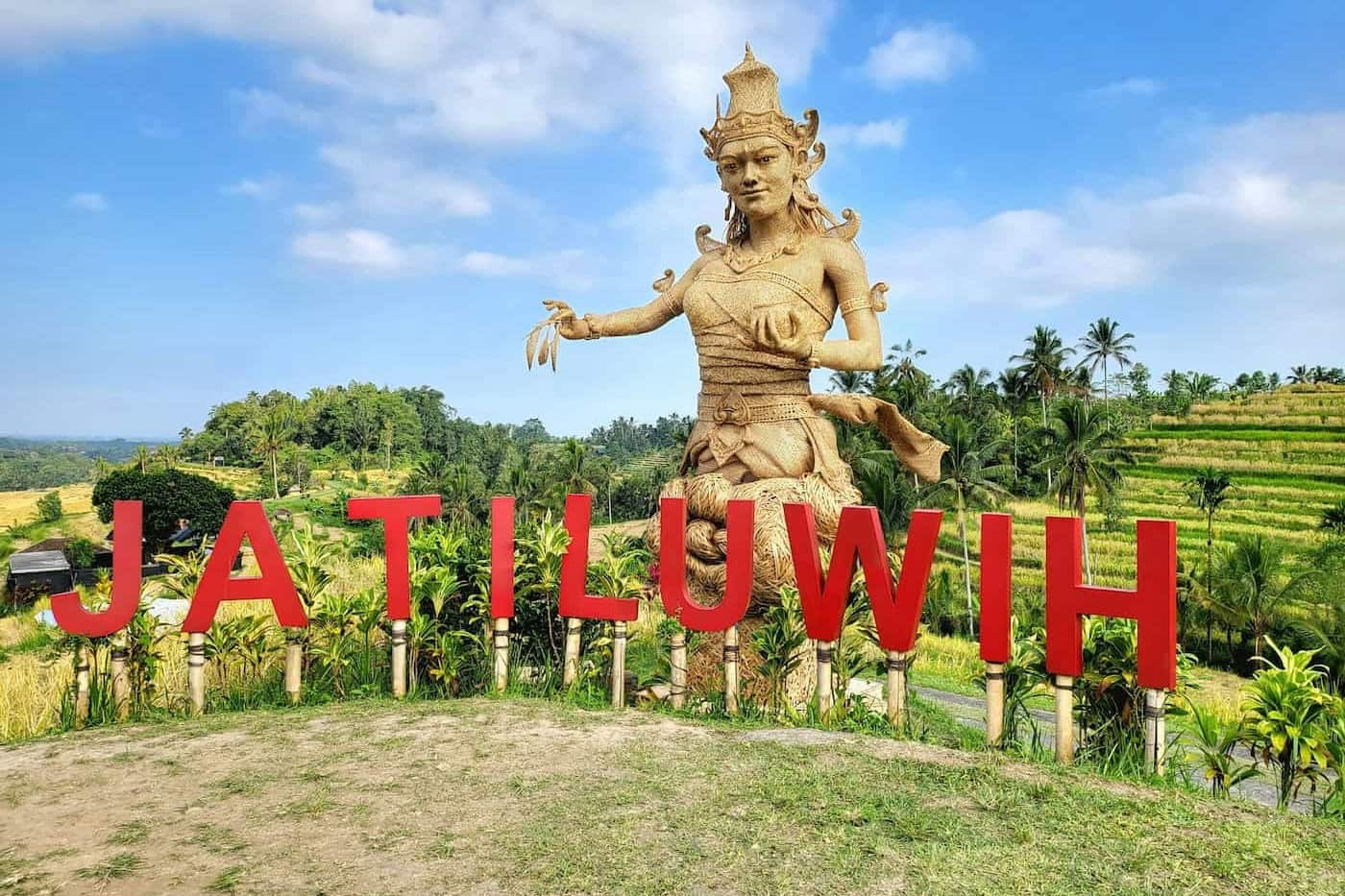
Activities and Best Views. Jatiluwih is more than just a photo stop. There are well-marked trails for hiking and cycling, with routes ranging from 1.5 km to 7 km loops. I recommend starting early — between 8 and 10 a.m. — when the terraces are bathed in golden light and the air is cool. Along the way, you’ll pass bamboo groves, small shrines, and maybe even spot a farmer leading a duck parade. For the best views, head to the main lookout or the new Jatiluwih Eco Farm, where you can learn about rice cultivation, taste local produce, and even try your hand at planting.
Nearby Spots:
- Combine your visit with Taman Ayun or Ulun Danu Beratan, two of the most beautiful temples in Bali.
- Don’t miss the small warungs serving nasi campur and sweet rice desserts — rice here tastes better than anywhere else!
- Bring sunscreen, a hat, and a rain poncho — weather can change quickly at this altitude.
- Entry fee: 40,000–50,000 IDR for adults, 15,000–40,000 IDR for children ($2.60–$3.20/€2.40–€3).
- Opening hours: 8:00 AM–6:00 PM daily.
| Experience/Service | Price (IDR) | USD (approx) | EUR (approx) |
|---|---|---|---|
| Entrance (adult/child) | 40,000–50,000/15,000–40,000 | $2.60–$3.20/$1–$2.60 | €2.40–€3/€0.90–€2.40 |
| Guided Trekking | 150,000+ | $10+ | €9+ |
| Bike Rental | 100,000–150,000 | $6.50–$10 | €6–€9 |
⭐️ Best Activities
- Private Full-Day Tour: Ulun Danu Beratan, Jatiluwih & Tanah Lot – Discover three of the region’s most stunning shrines, stroll through the lush Jatiluwih rice terraces, and learn about coffee farming and beekeeping. Enjoy a flexible, private experience with hotel pickup, a knowledgeable English-speaking driver, and a tasty local lunch. Travelers rave about the scenic variety, friendly guides, and the chance to capture magical sunset moments at Tanah Lot. Highly recommended for those who want a day packed with culture, nature, and unforgettable photo ops.
3. Mount Batur Sunrise Trek
Epic Volcano Adventure. The Mount Batur Sunrise Trek is one of those Bali bucket list experiences you’ll find in every bali travel guide. This active volcano rises 1,717 meters above sea level and sits in the heart of the island in Indonesia, not far from Ubud. The journey starts long before dawn — a typical bali trip means a wake-up call at 1:30 or 2:00 a.m., followed by a drive to the trailhead. As I joined a line of headlamps weaving up the mountain, the excitement and camaraderie were electric. The trek itself takes about 2 to 2.5 hours, climbing over dirt tracks, lava fields, and rocky paths. It’s a steady, sometimes steep ascent, but the anticipation of sunrise keeps everyone moving.
Summit Views and Sunrises. Reaching the summit before dawn is a reward in itself. As you wait for the sun to rise, the sky shifts from deep purple to gold, revealing breathtaking views of Mount Abang, Mount Rinjani, and the shimmering waters of Lake Batur. On clear days, you might even spot Lombok Island in the distance. The summit is often busy, but there’s a sense of celebration as everyone gathers for photos, hot tea, and a simple breakfast — usually bread and eggs cooked in the volcano’s steam. For the best views, I recommend wandering a little further along the rim for a quieter spot and a 360-degree panorama.
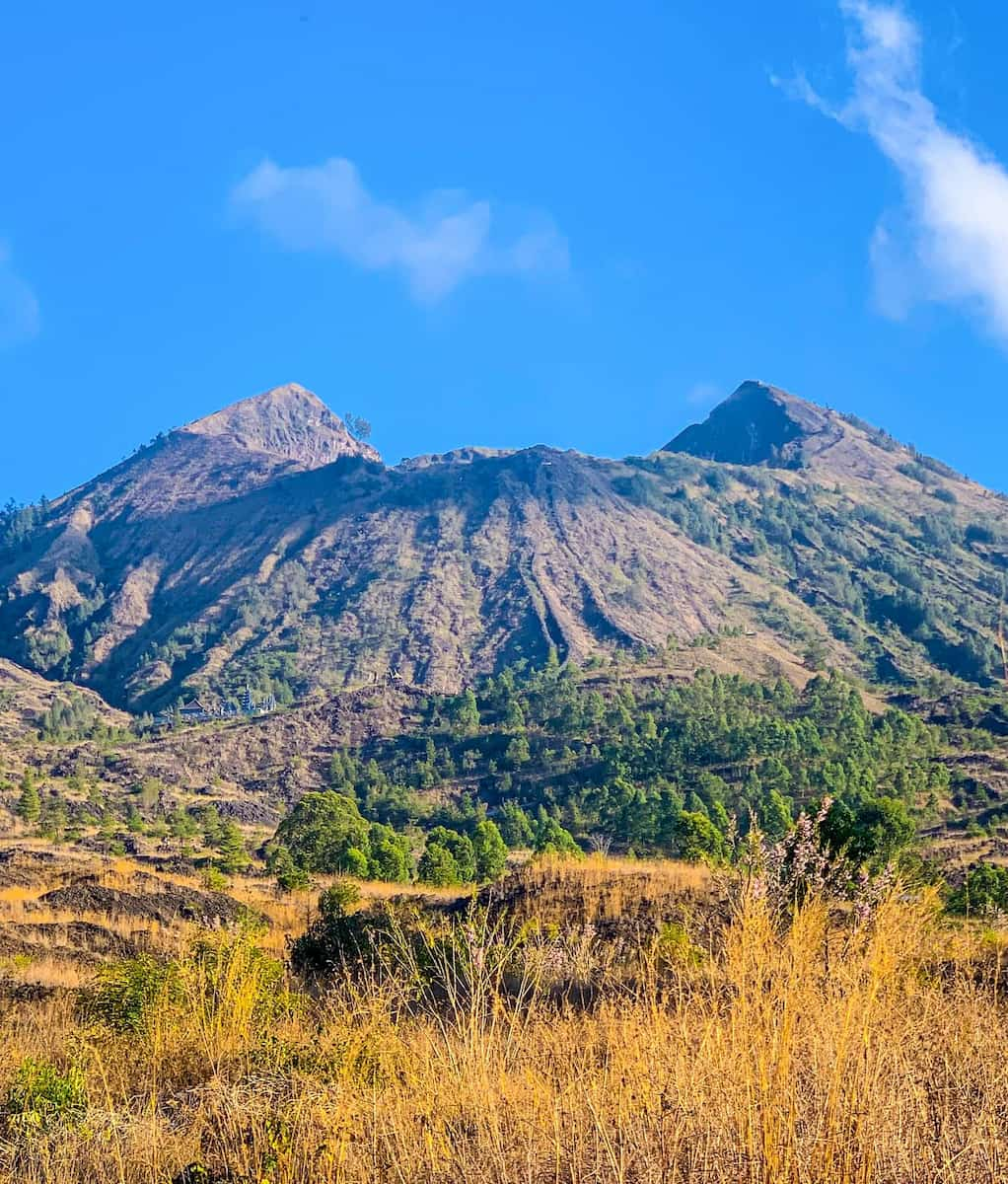
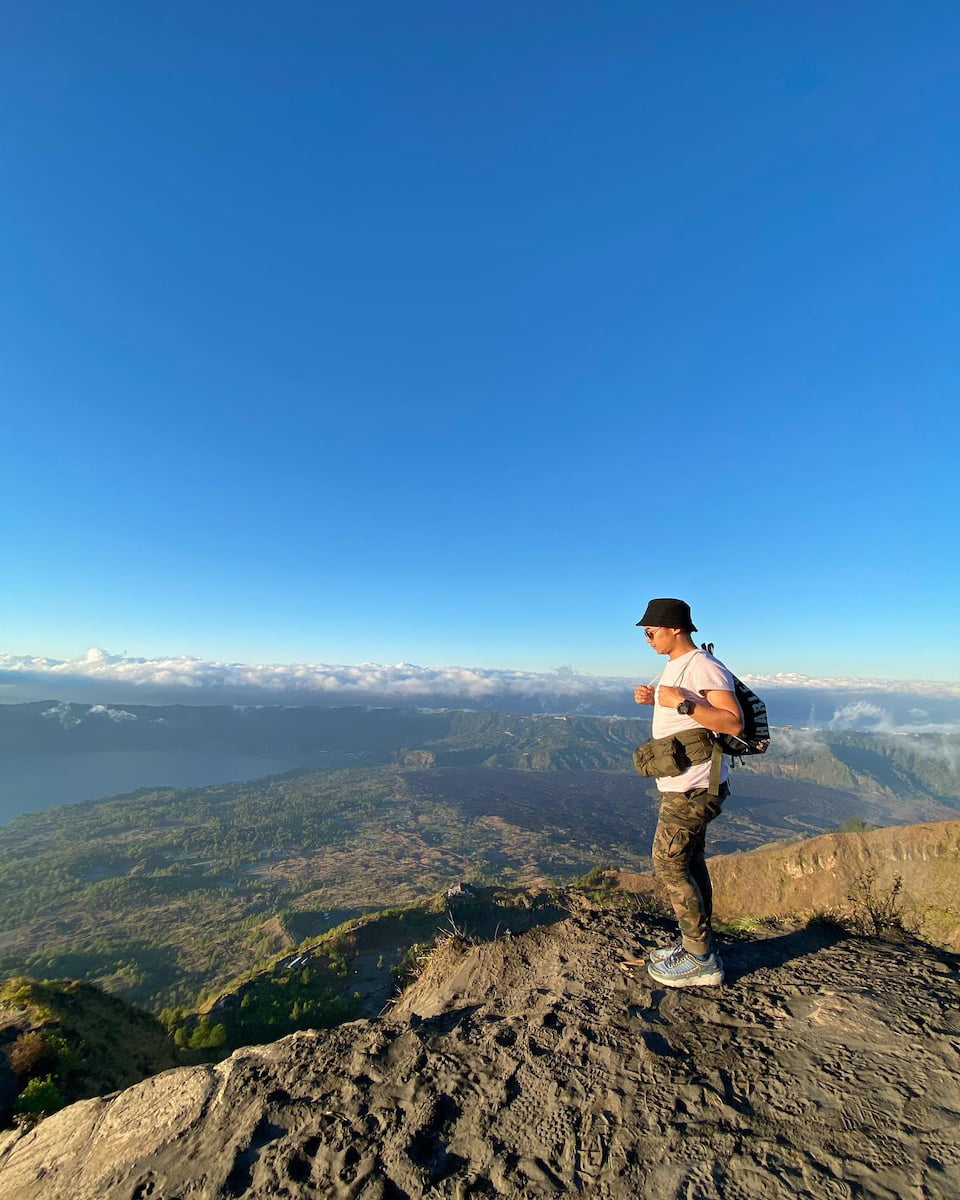
Highlights of the Trek:
- Early morning hike under the stars
- Spectacular sunrise over the caldera and surrounding peaks
- Steaming volcanic vents and playful monkeys at the summit
- Optional walk around the crater rim for more dramatic views
- Relaxing soak at Batur Natural Hot Springs after your descent
Prices. The trek is rated moderate to hard — expect to get your heart pumping, especially if you’re not used to hiking. Good shoes are a must, as the trail is rocky and can be slippery. Bring a light jacket for the chilly summit, and a headlamp or torch (most tours provide these). Guided tours are highly recommended for safety and local insight, and prices range from 300,000–600,000 IDR ($20–$40/€18–€36) per person, often including hotel pickup, a guide, and breakfast.
| Service/Activity | Price (IDR) | USD (approx) | EUR (approx) |
|---|---|---|---|
| Guided Trek (per person) | 300,000–600,000 | $20–$40 | €18–€36 |
| Hot Spring Entry | 150,000–200,000 | $10–$13 | €9–€12 |
| Hiking Pole Rental | 50,000 | $3.20 | €3 |
⭐️ Best Activities
- Mount Batur Sunrise Trekking & Breakfast – Hike under a sky full of stars to the crater rim of Mount Batur (1,717 meters), then watch the sunrise with a hot drink and a simple breakfast at the top. Friendly guides, hotel pickup, and all fees included. Expect a moderately challenging trek, amazing views, and a chance to soak in the scenery (with optional hot springs and coffee tasting). Highly rated for its magical atmosphere, helpful guides, and unforgettable sunrise moments — even in the rain! (5.0/5, based on 535 reviews).
4. Ulun Danu Beratan Temple
Floating Wonder. Ulun Danu Beratan is one of those spots in Bali that lives up to every photo and travel tip you’ve read. Set on the serene shores of Lake Beratan in Bedugul, this iconic site is often called the “floating temple” for its dreamy silhouette reflected in the water, especially when the lake is high. Surrounded by misty mountains and lush flower gardens, the complex sits 1,200 meters above sea level, making it a cool, refreshing escape from the island’s hotter lowlands. The air is crisp, the scenery is stunning, and the peaceful vibe is a welcome break from busier attractions in Bali.
Spiritual Heart and Marvel. Built in the 17th century, Ulun Danu Beratan is dedicated to Dewi Danu, the water goddess who sustains Bali’s legendary subak irrigation system. The complex features several multi-tiered meru towers, with the tallest — an 11-tiered pagoda — rising from a tiny island just offshore. Each structure honors different Hindu deities, and the site is still used for ceremonies and offerings, especially those asking for good harvests and abundant water. As you wander the grounds, you’ll also spot a Buddhist stupa and even a small mosque nearby, reflecting the island in Indonesia’s spirit of religious harmony.
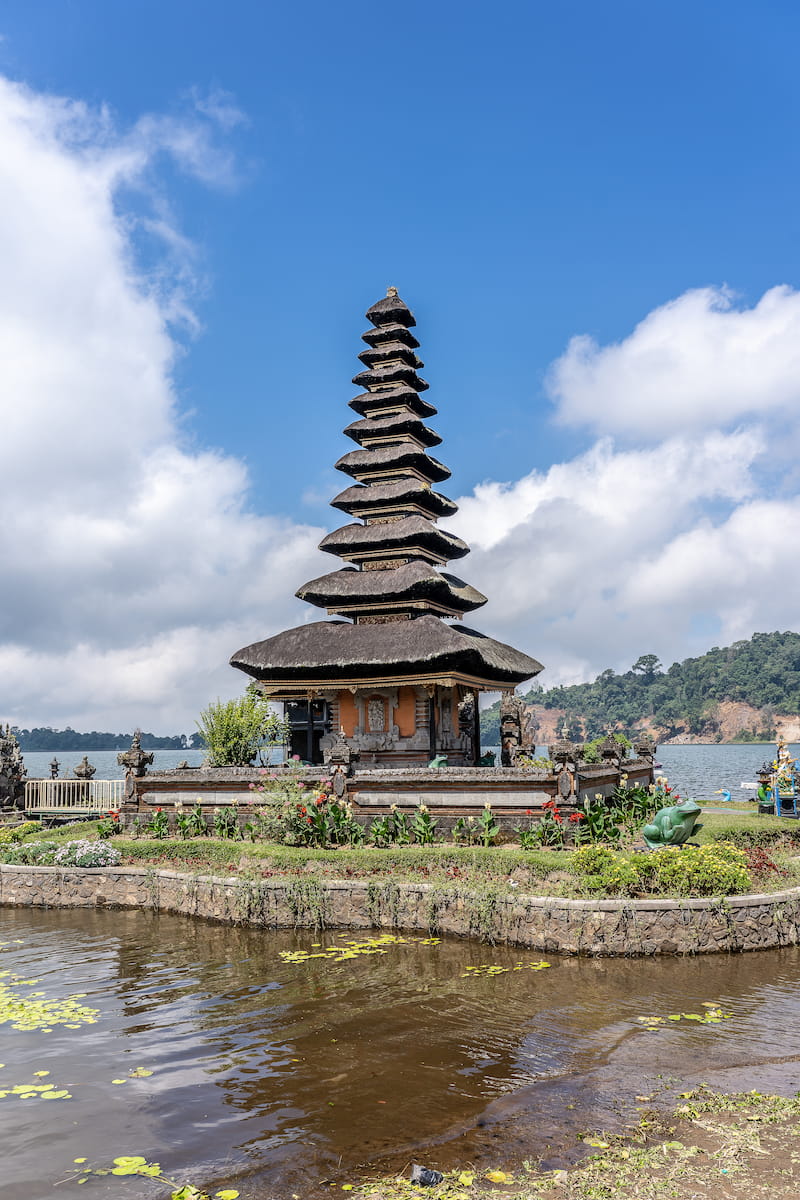
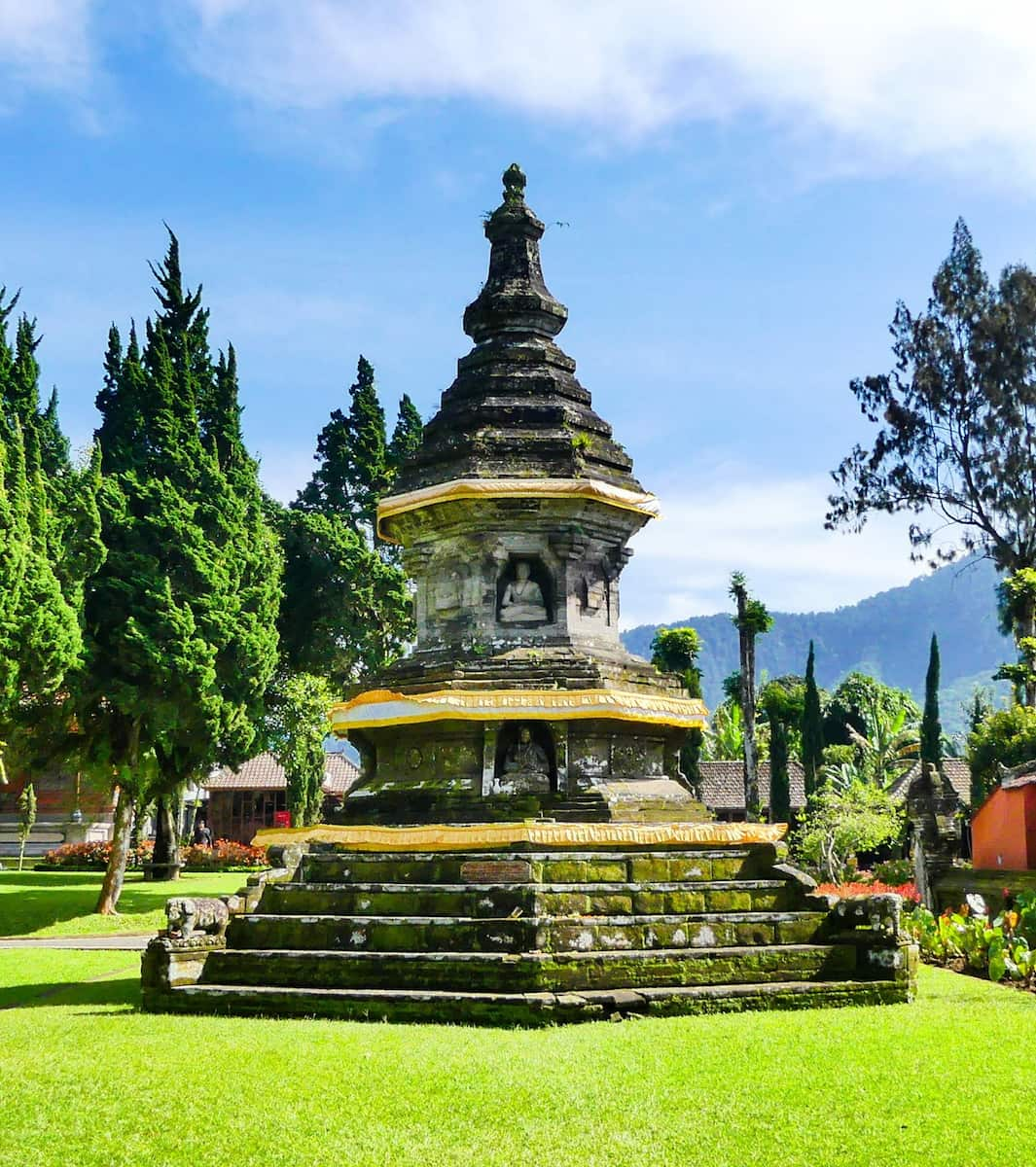
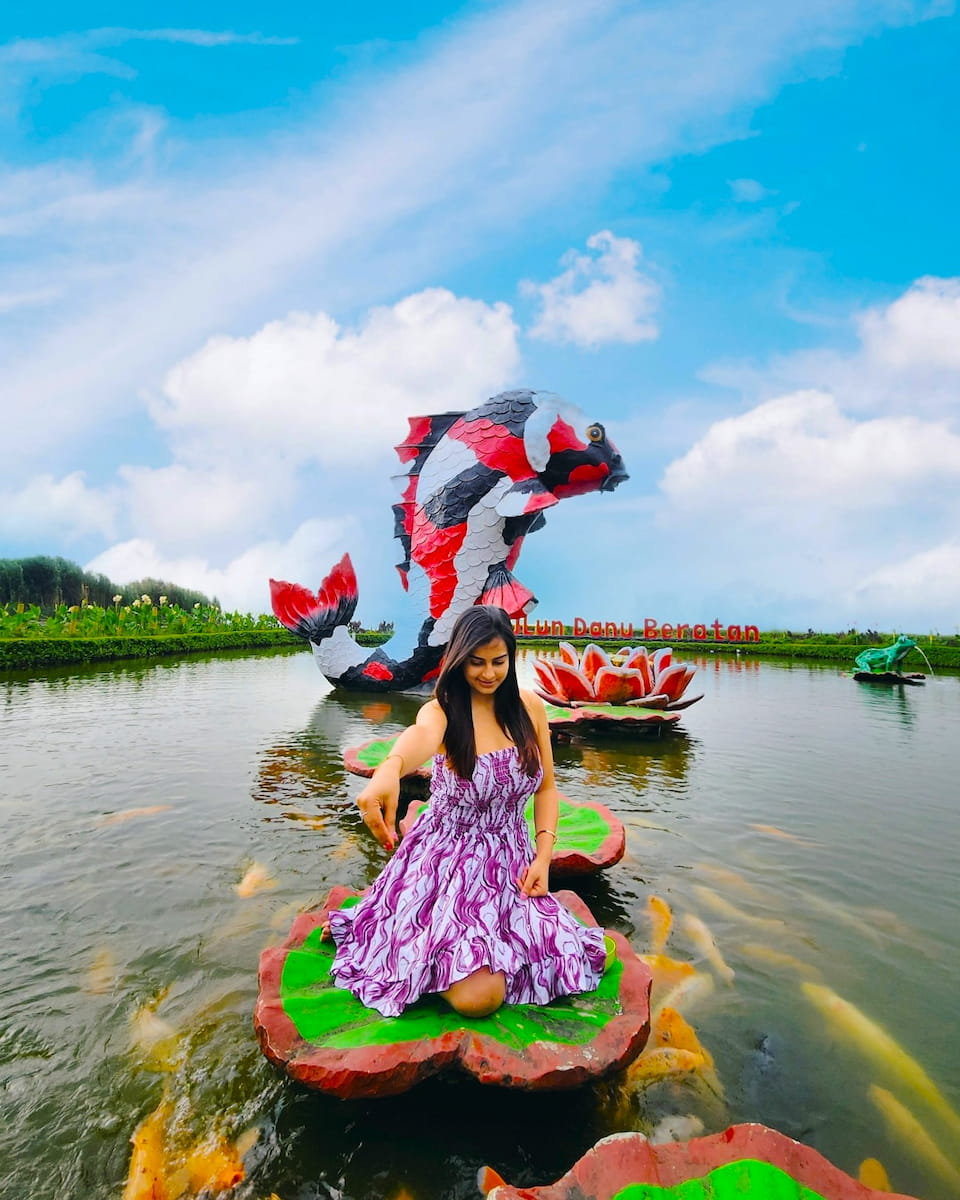
Gardens, Lakes, and Photo. Strolling through the manicured gardens, I was struck by the vibrant marigolds, hydrangeas, and the occasional banyan tree. The lake’s calm waters create a perfect mirror for the temple’s silhouette, especially in the early morning mist or late afternoon glow. For the amazing views and photos, arrive just after sunrise or before sunset, when the crowds thin and the light is soft. You can even rent a small boat to glide across the lake for a different angle, or simply sit by the shore and watch the clouds drift over the mountains.
| Experience/Service | Price (IDR) | USD (approx) | EUR (approx) |
|---|---|---|---|
| Entrance (adult/child) | 75,000/50,000 | $4.80/$3.20 | €4.40/€3 |
| Parking (car/scooter) | 5,000/3,000 | $0.33/$0.20 | €0.30/€0.18 |
| Boat Rental (per trip) | 100,000+ | $6.50+ | €6+ |
⭐️ Best Activities
- Private Tour: Ulun Danu Beratan, Taman Ayun & Tanah Lot – Visit three of the region’s most magnificent shrines in one seamless day: stroll the royal gardens at Taman Ayun, admire the lakeside setting of Ulun Danu Beratan, and catch a magical sunset at Tanah Lot. Enjoy the comfort of a private car, hotel pickup from most main areas, and the insights of a friendly English-speaking guide. Perfect for travelers seeking culture, scenery, and plenty of photo stops, all with hassle-free transfers and flexible pacing.
FAQs about Visiting Bali
1. What’s the best time to visit Bali?
The ideal time to visit Bali is during the dry season from April to October, when the weather is sunny and perfect for outdoor activities, diving, and exploring. For fewer crowds and better prices, consider the shoulder months of May, June, or September.
2. How do I get around Bali?
Getting around Bali can be done by scooter, car hire with driver, taxis, or ride-hailing apps like Grab and Gojek. Public buses and minibuses (bemo) are available but can be slow and unreliable; for most travelers, hiring a scooter or using tourist shuttle buses is the most convenient option.
3. Is Bali safe for solo travelers?
Yes, Bali is generally safe for solo travelers, including women. As with any destination, stay alert, keep your belongings secure, and use reputable transport — especially at night or in unfamiliar areas.
4. What should I wear when visiting temples?
When visiting temples in Bali, you should dress modestly: cover your shoulders and knees, and wear a sarong or shawl if required. Most temples provide sarongs for visitors, but bringing your own is always a good idea.
5. Where should I stay in Bali for first-timers?
Popular areas for first-timers include Canggu (for cafes and relaxed vibes), Uluwatu (for dramatic cliffs), Sanur (family-friendly), Nusa Lembongan (island escape), and Ubud (culture and nature). Choose your base depending on your interests — each area offers unique attractions and easy access to Bali’s best spots.
